Allison Collection Photos
October, 1943
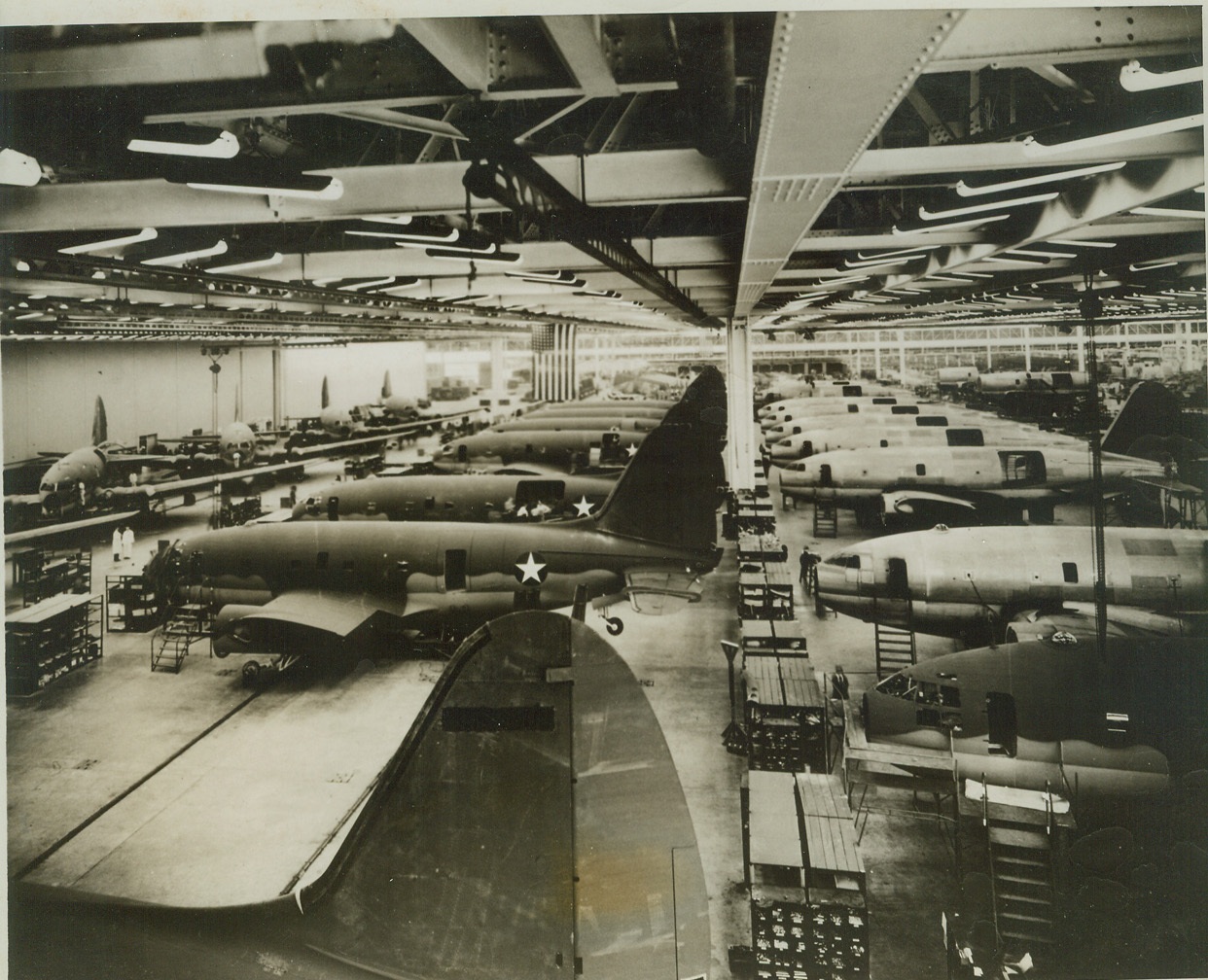
Mass Production For Air Giants, 10/15/1943. Buffalo, N.Y. – The giant Curtiss (C-46) Commando, largest twin-engine cargo aircraft type in the world, will go into mass production on the largest scale ever projected in peace or in war or a transport plane. This photo, taken in one of the two Buffalo plants of Curtiss-Wright Corporation, show the huge twin-engined cargo planes in various stages. When the aircraft in the line at right reach a certain stage in construction, they are transferred to the center line, and finally to the line at the left where they are completed. Credit: (ACME);
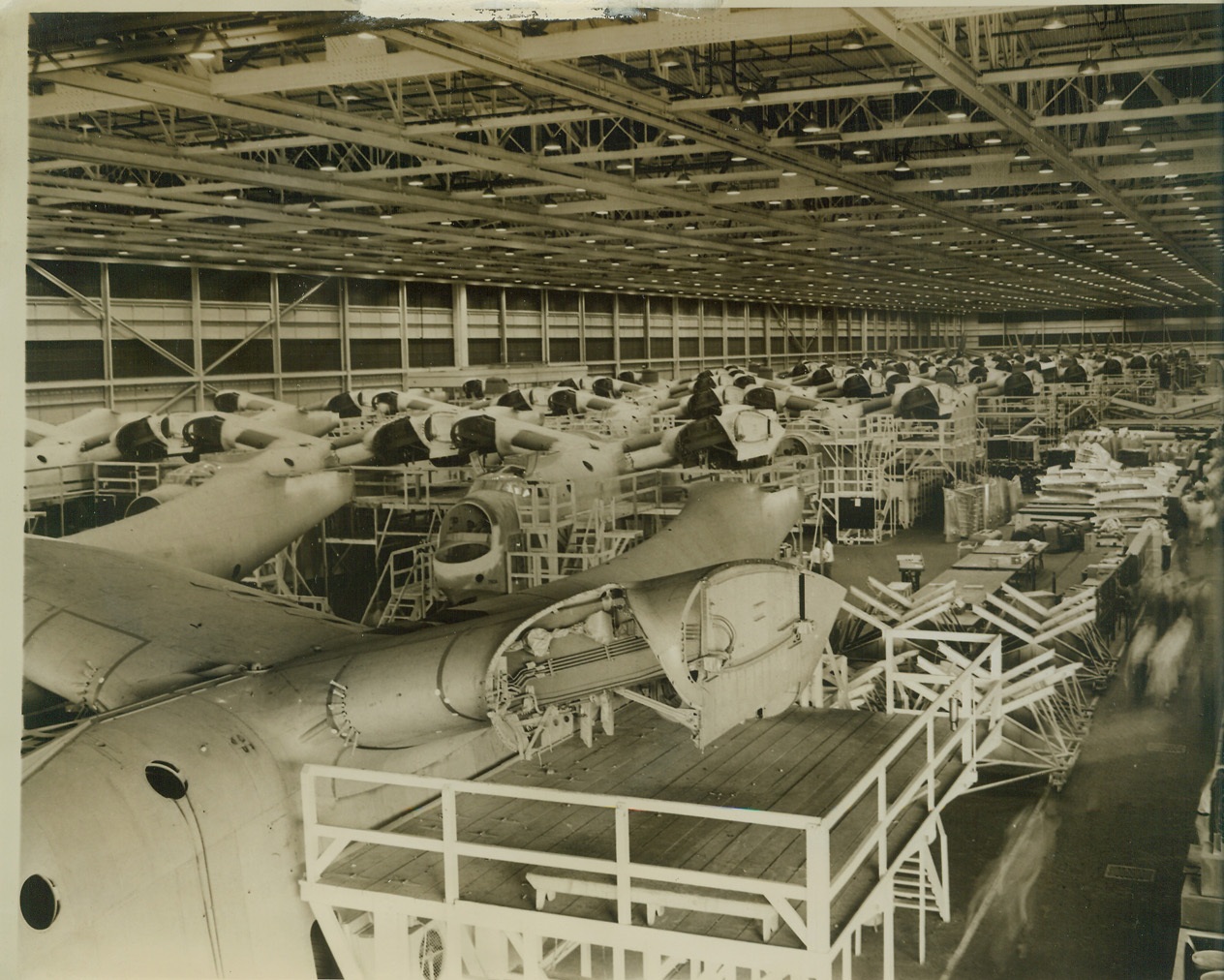
Where Mariner Patrol Bombers are Built, 10/4/1943. Baltimore, MD. – A view of the final assembly line of the Glenn L. Martin plant in Baltimore, where huge Martin PBM-3 Mariner patrol bombers are shown in the final stages of completion. Credit: (ACME);
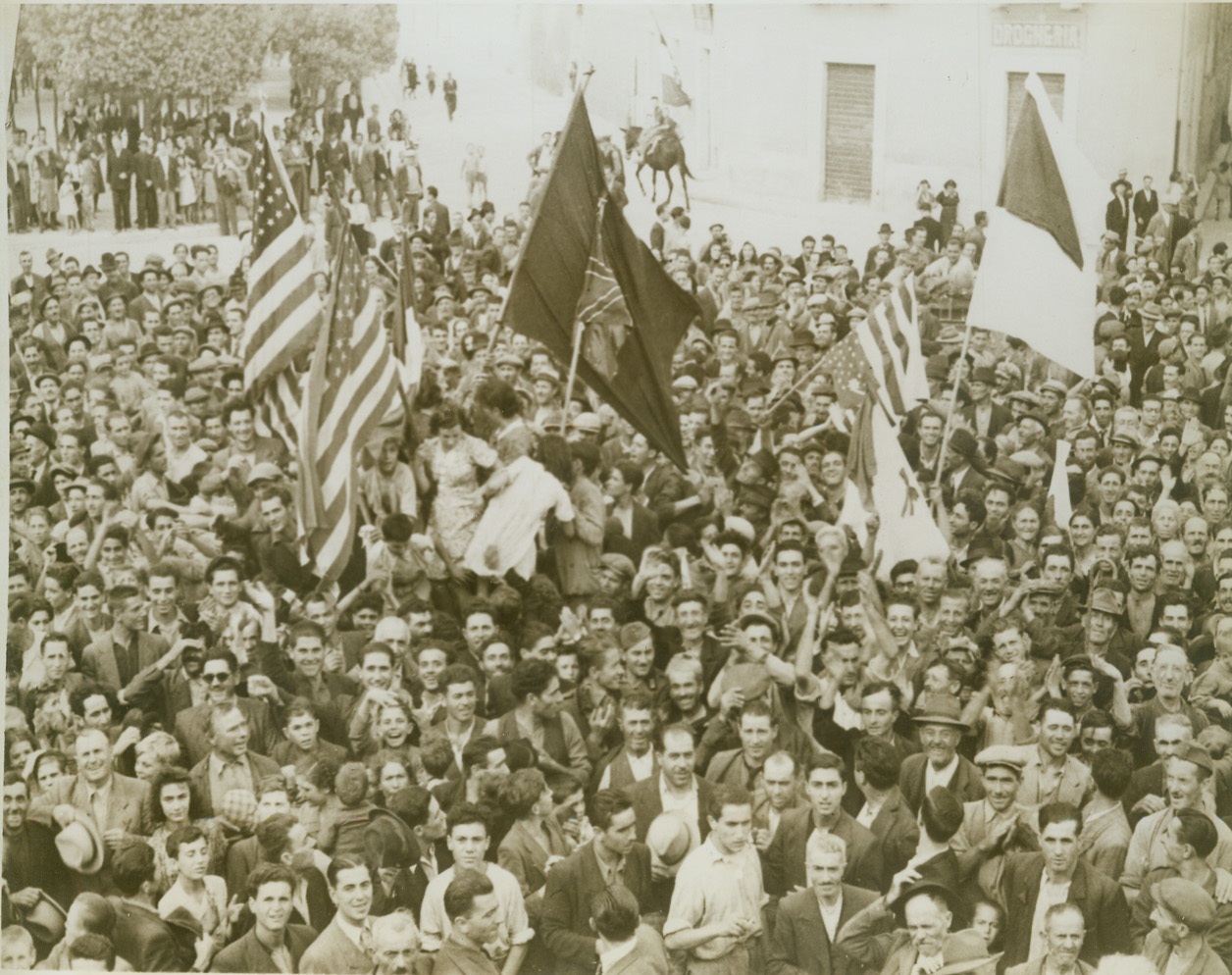
Welcome – Italian Style, 10/29/1943. Italy – American, British and Italian flags were held aloft by this crowd of Italians in the village square, welcomed Canadians to Gravina. Men of a Western Canada reconnaissance unit, first into Gravina, received a tremendous welcome. Credit: (ACME);
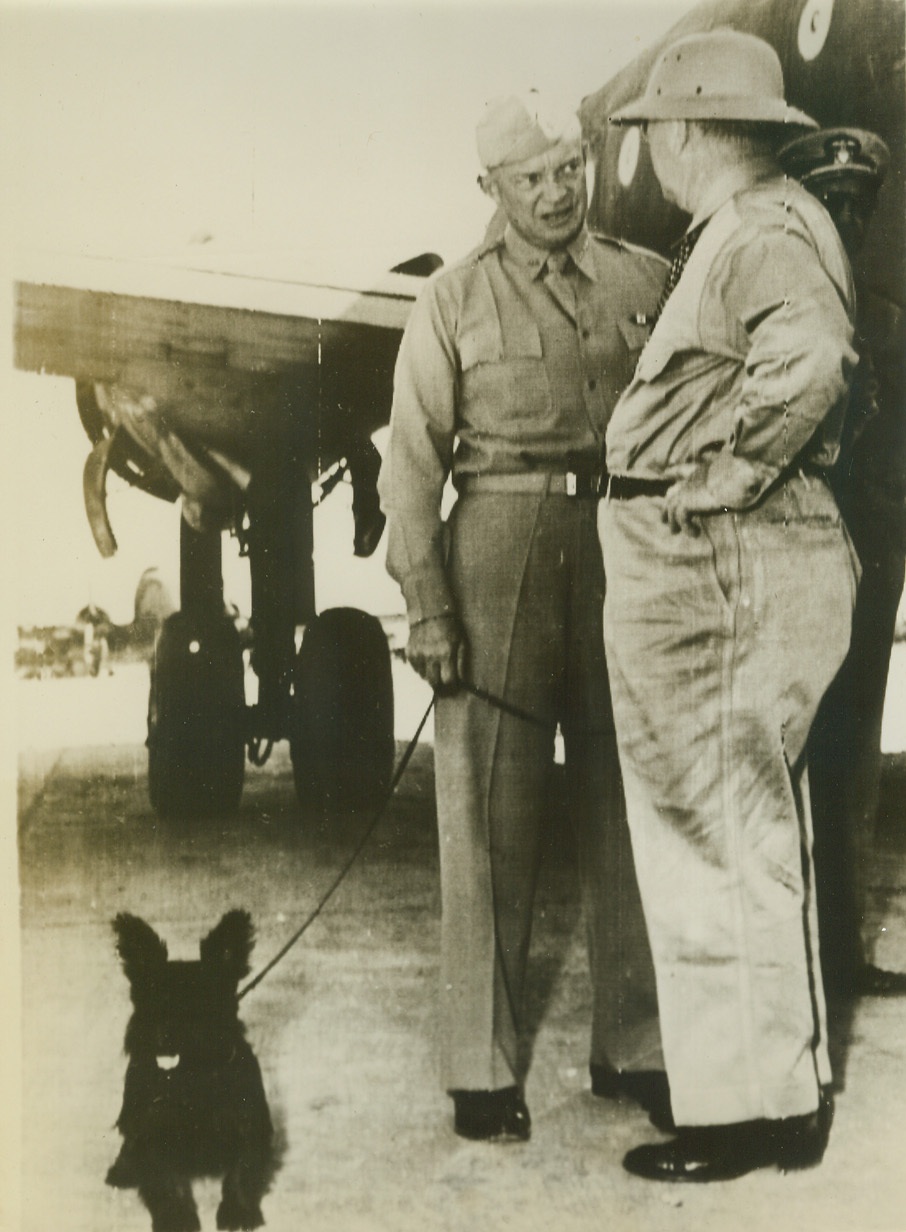
SECRETARY KNOX TOURS ITALIAN FRONT, 10/4/1943. This photo, flashed to the U.S. today by radiotelephoto shows Col. Frank Knox, Secretary of the Navy, (right), as he conferred with Gen. Dwight D. Eisenhower, Allied Commander in the North African Theatre, after the Secretary’s arrival at an airport for a tour of the Italian Front. With them is Gen. Eisenhower’s dog Telex. Credit: U.S. Navy photo via OWI Radiophoto from ACME;
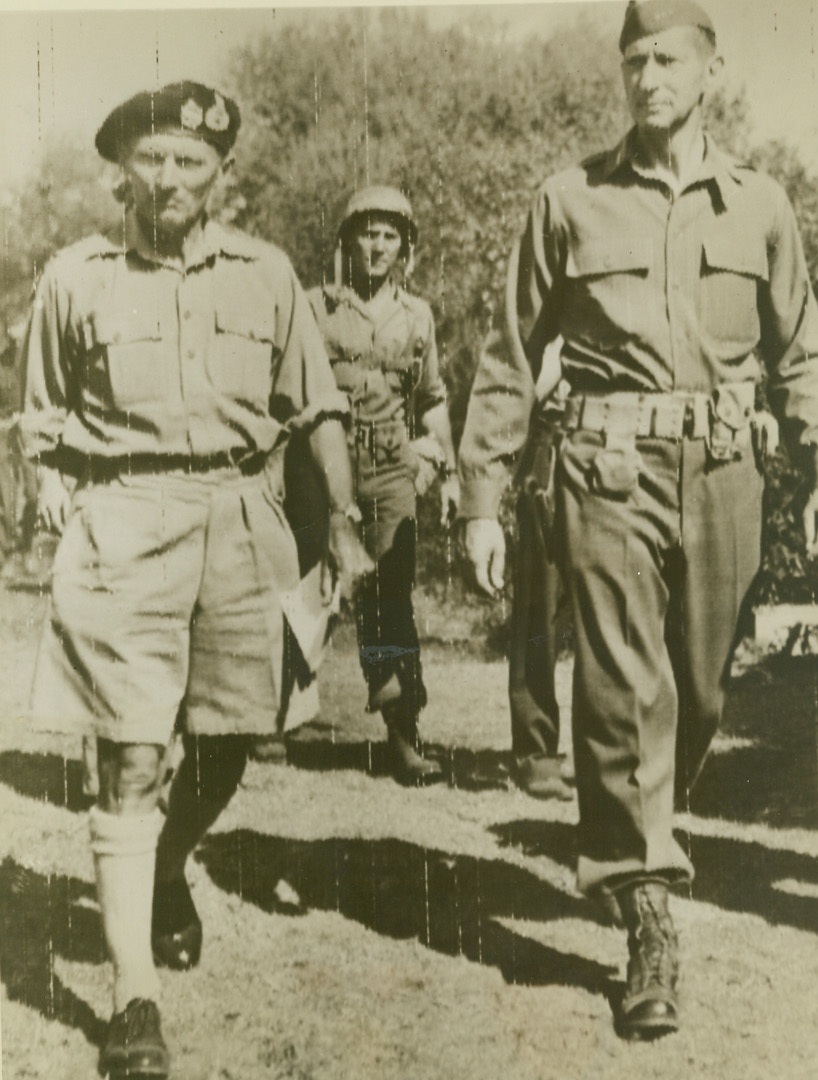
INSPECTING TROOPS AT ITALIAN FRONT, 10/2/1943. General Bernard L. Montgomery, Commanding General of the British Eighth Army (left), and Lt. Gen. Mark W. Clark, Commanding General of the American Fifth Army, are shown inspecting troops at the Italian Front. Credit: Signal Corps photo via OWI Radiophoto from ACME;
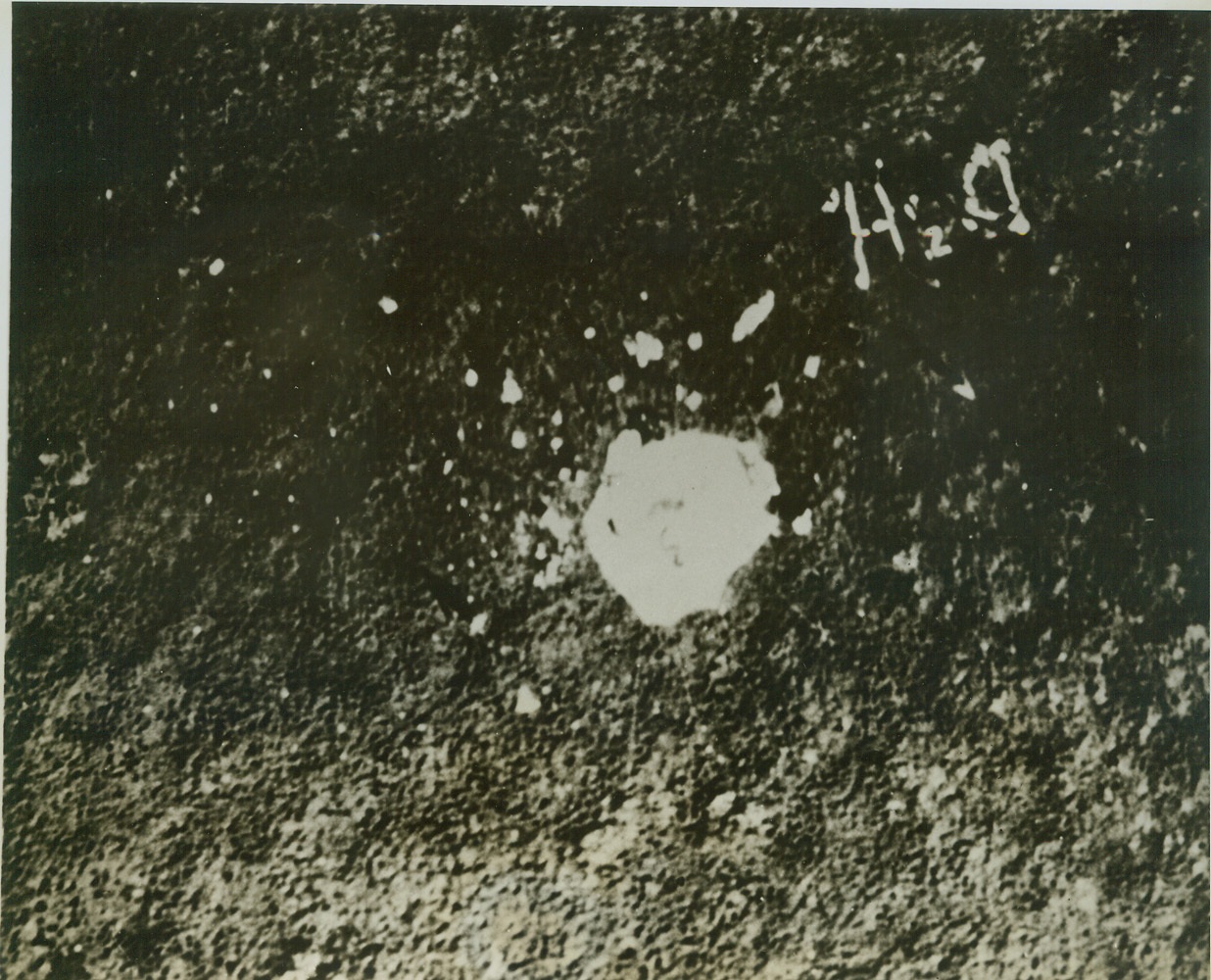
STRANDED FLIERS SIGNAL FOR WATER, 10/27/1943. AUSTRALIA – The crew of a U.S. Army Air Forces bomber which crashed in the bush in Australia, used strips torn from their parachutes as panels to make this sign, (upper right in photo). It reads “H2O”, signifying that the crew of the crashed Liberator needs water. When planes spotted the sign, they dropped food and water and then directed rescue parties to the scene. One member of the crew can be seen in the left center of the white spot, (center of photo). Credit: U.S. Army Air Forces Photo via OWI Radiophoto from ACME;
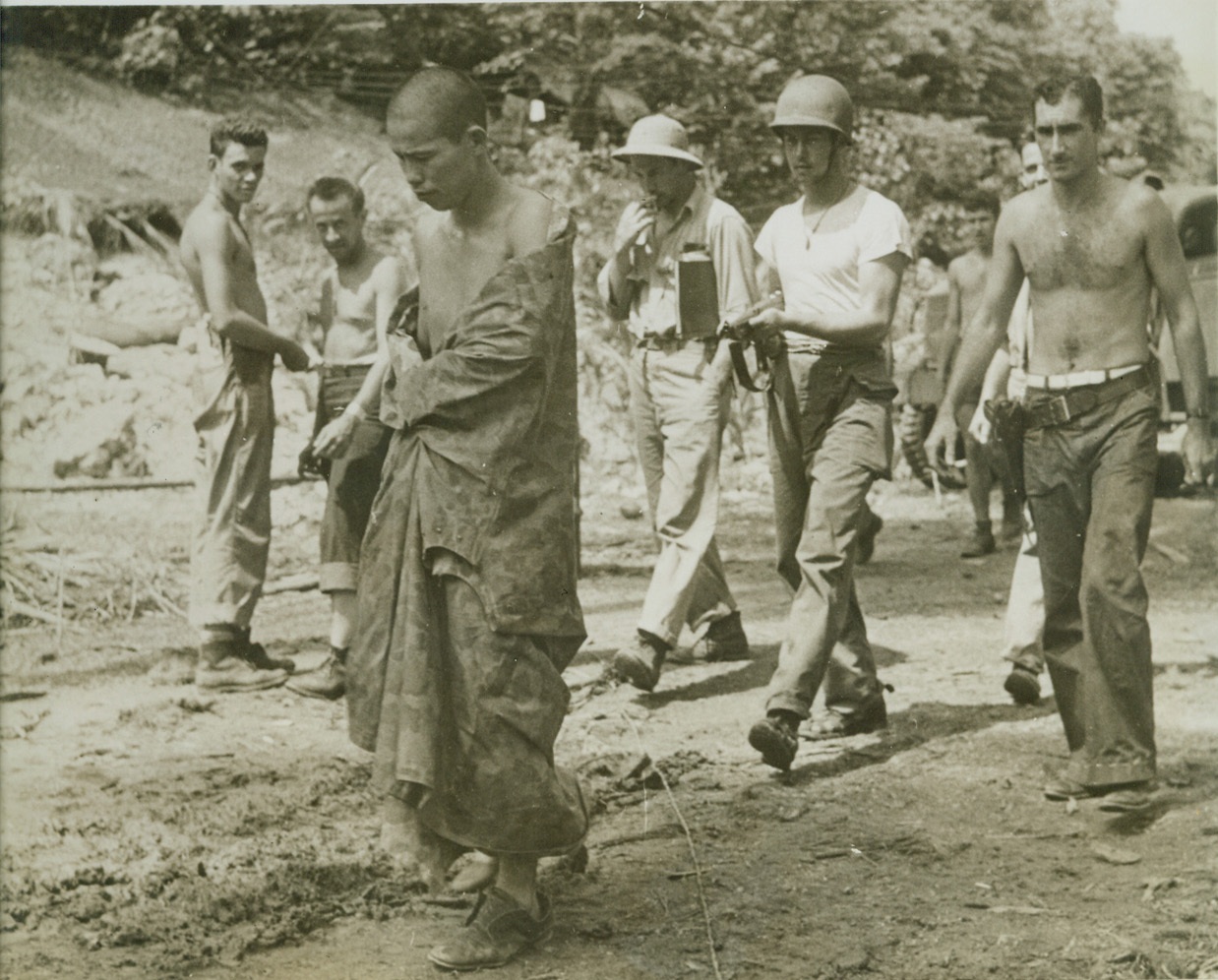
CAUGHT WITH HIS PANTS DOWN, 10/30/1943. SOMEWHERE IN THE SOUTH PACIFIC – This Jap pilot was fished out of the ocean sans clothing, after he was shot down by an American PT boat. The torpedo craft’s skipper loaned him this poncho which he wears as he is ushered to U.S. Navy Headquarters by some tough U.S. fighters. Credit: OWI Radiophoto from ACME;
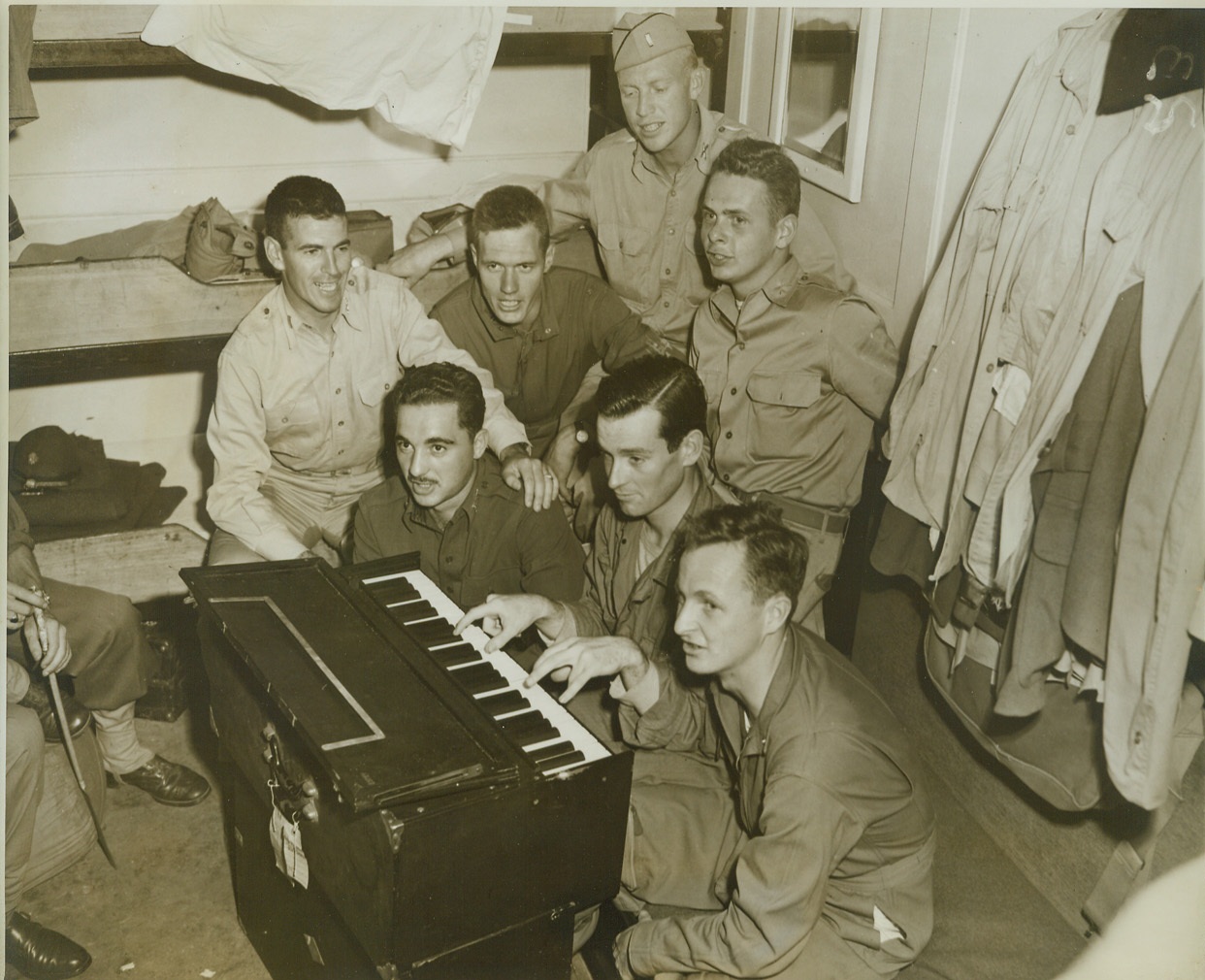
HARMONY BELOW DECKS, 10/27/1943. AT SEA – The boys are giving their version of Pistol Packin’s Mama aboard a troop transport bound for a South Pacific port. Left to right, standing: Lieutenants J. R. Ryan, Los Angeles, Calif.; N. W. Alexander, Dallas, Tex.; C. H. Parks, Oklahoma City, Okla.; W. E. O’Donovan, Baltimore, MD. Front Row: A. G. Tsimpides, Birmingham, Ala.; J. L. McHenry, Boston, Mass.; and P. L. Gressman, Buffalo, N. Y. Credit: OWI Radiophoto by Thomas Shafer from ACME;
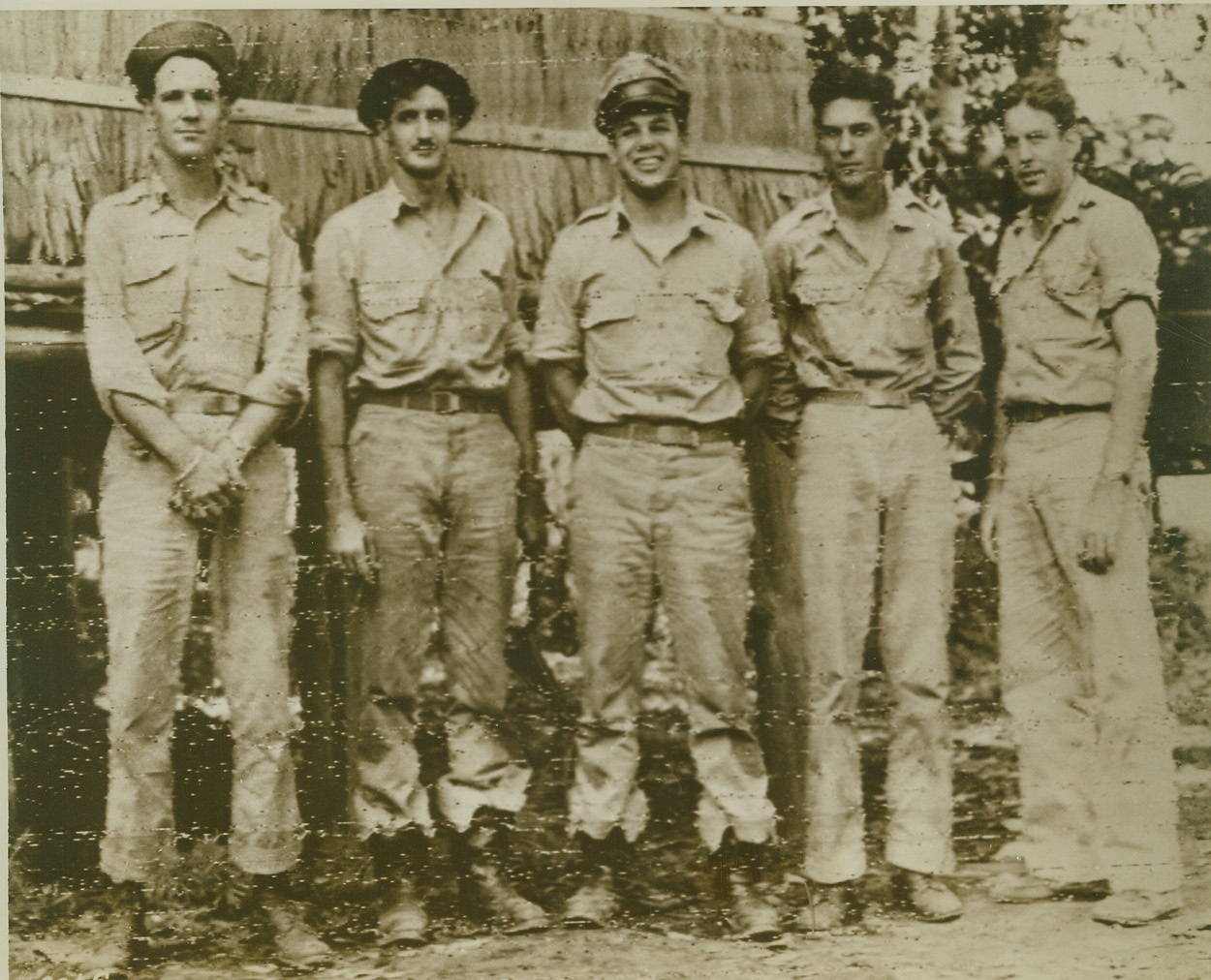
HELPED WIPE OUT JAP PLANES, 10/14/1943. These five U.S. pilots helped knock 177 Jap planes out of action at Raboul when every available plane in General MacArthur’s aerial arsenal dropped 350 tons of bombs on the base in New Britain. They are (left to right) Lt. Charles E. Moorfield, Arlington, VA.; Lt. Clifford P. Taylor, Woodhaven, L. I. N. Y.; Lt. Gilbert S. Stiles, Welty, Okla.; and Lt. Donald T. Lees, Rock Island, Ill. The pilot at right is unidentified. Credit: U.S. Army Signal Corps photo via OWI Radiophoto from ACME;
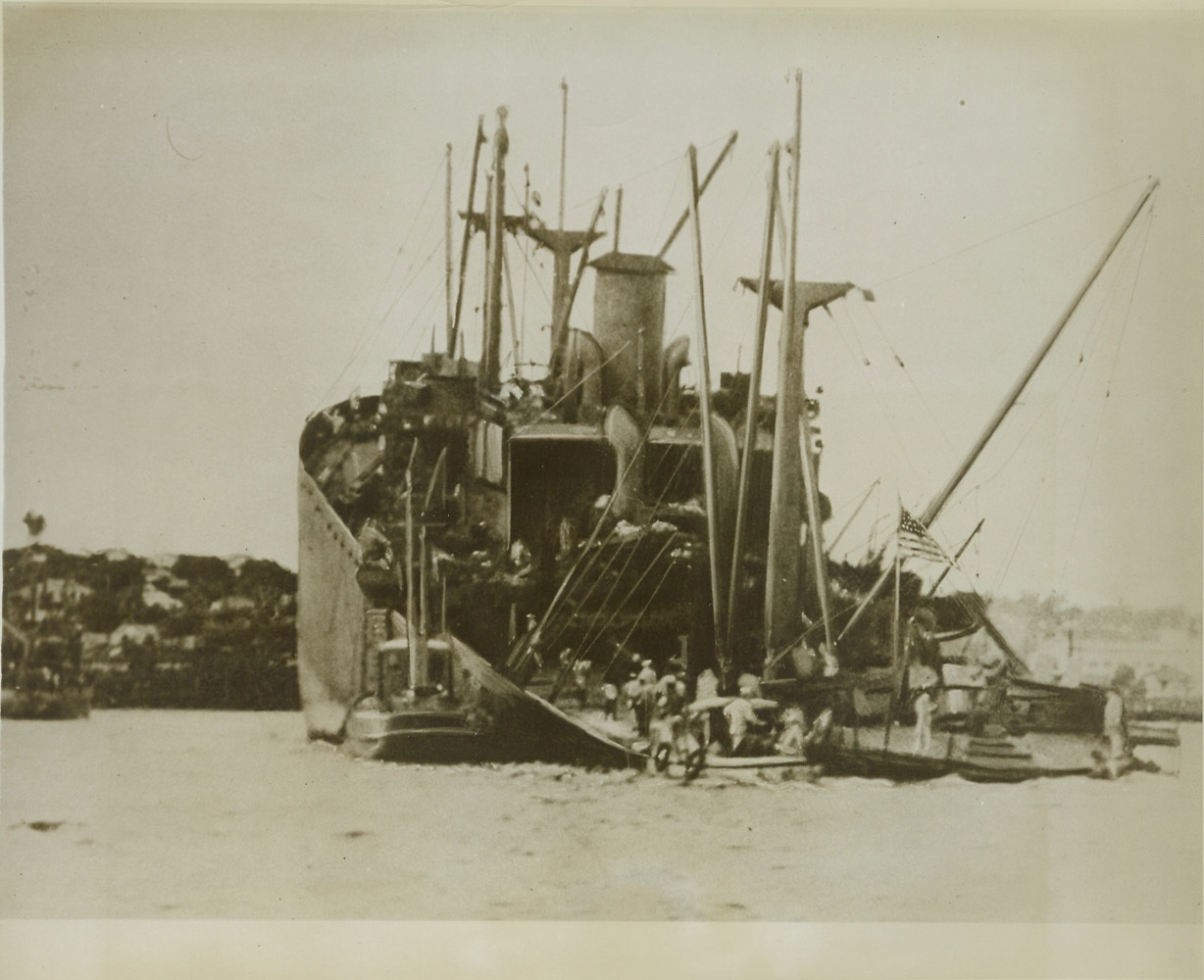
THE SHIP THAT WOULDN’T SINK, 10/28/1943. Decks awash, steering gear out of commission, and with an enemy torpedo ripped through two bulkheads this Liberty ship arrived at a South Pacific port under half speed, with the aid of another ship. She was carrying war material to U.S. Forces in the South Pacific when the torpedo made a direct hit in her side disabling her steering gear. Capt. M. Freeman held part of the crew aboard to fight fire and protect cargo while the remainder took to boats to insure against loss of life. Seventy-two hours after being hit she began the voyage to port which was made in eleven hours. No loss of life occurred. Credit: U.S. Navy photo via OWI Radiophoto from ACME;
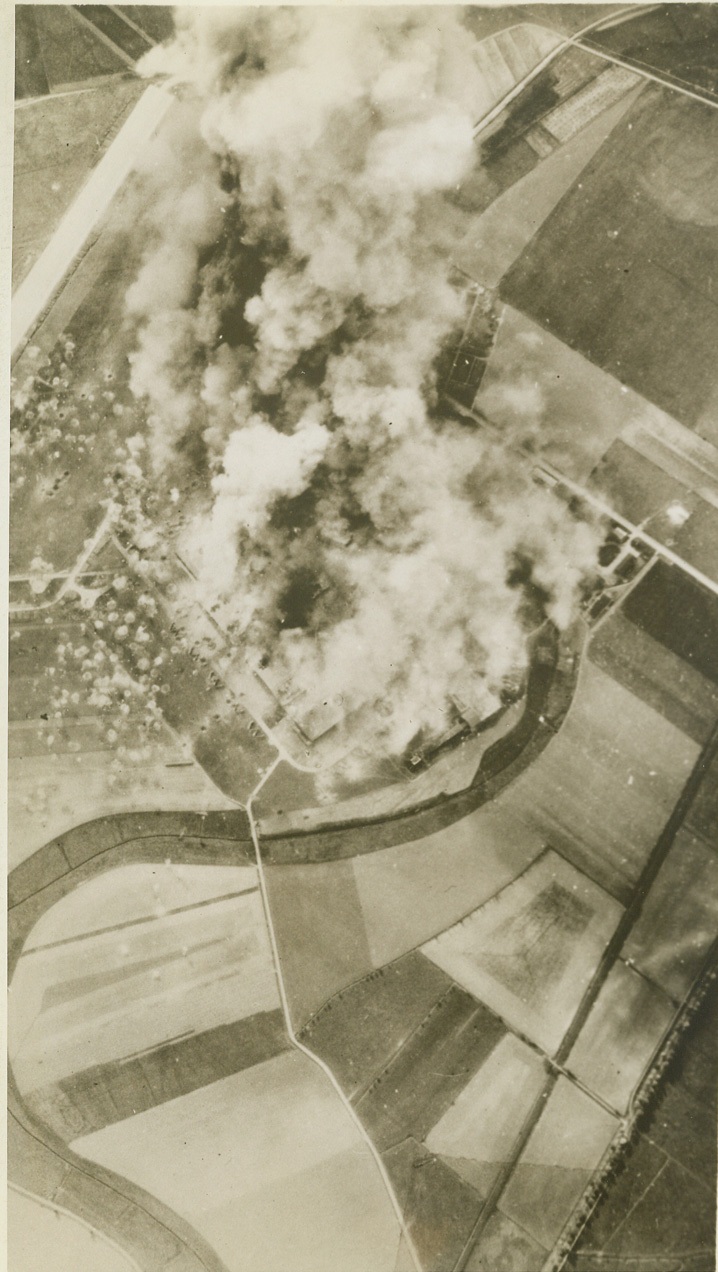
YANK BOMBERS BLAST MARIENBURG, 10/20/1943. WASHINGTON, D.C. – This photo, released in Washington today shows smoke from bomb bursts and fires almost completely obscuring the Focke-Wulf 190 Fighter Plane factory at Marienburg, East Prussia, during one of four raids made by strong formations of Flying Fortresses and Liberators last Oct. 9th. Called the finest example of daylight precision bombing by Gen. Henry H. Arnold, Chief of the U.S. Army Air Forces, this raid was the deepest penetration yet by the U.S. 8th Air Force. Credit: U.S. Army Air Forces photo via OWI Radiophoto from ACME;
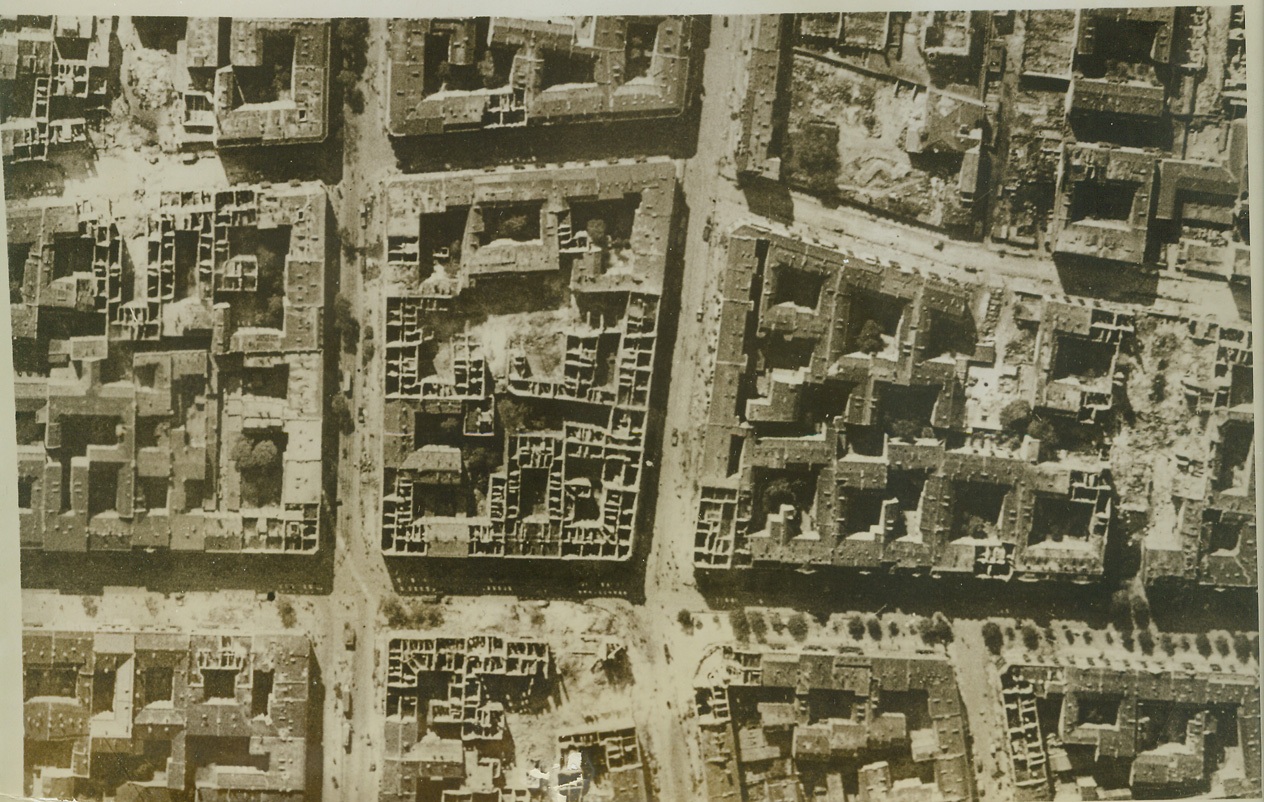
RAF Bombers Hit Berlin, 10/14/1943. Her industrial centers heavily hit during raids by the RAF Bomber Command, Berlin has suffered considerably from Allied air attack. This aerial view of the Moabit District, northwest of Tiergarten, shows how badly buildings in the area have been hit. Points where heavy bombs exploded with devastating effect can be clearly seen. Credit: (ACME);
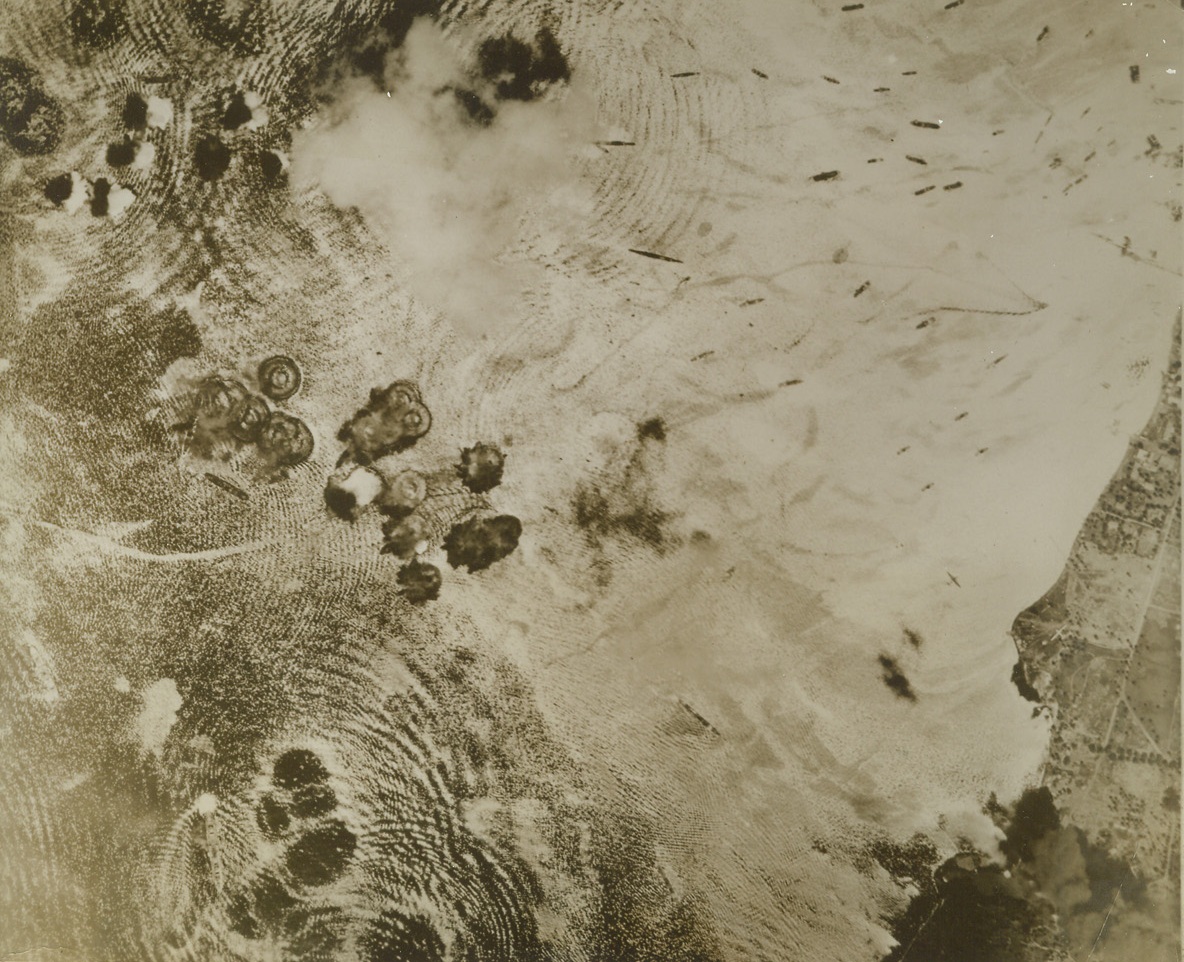
ALLIES BAG 177 NIP PLANES IN RABAUL RAID, 10/26/1943. The Japanese lost 177 planes and more than 50 vessels when Allied Air Forces attacked their base at Rabaul, New Britain, last Oct. 12th. This photo, one of the originals to reach the U.S., shows a string of bombs falling across the stern of a 5,800 ton Jap merchant ship in Rabaul during the attack. This was the biggest air attack of the war in the Southwest Pacific. Credit: U.S. Army Air Forces photo from ACME;
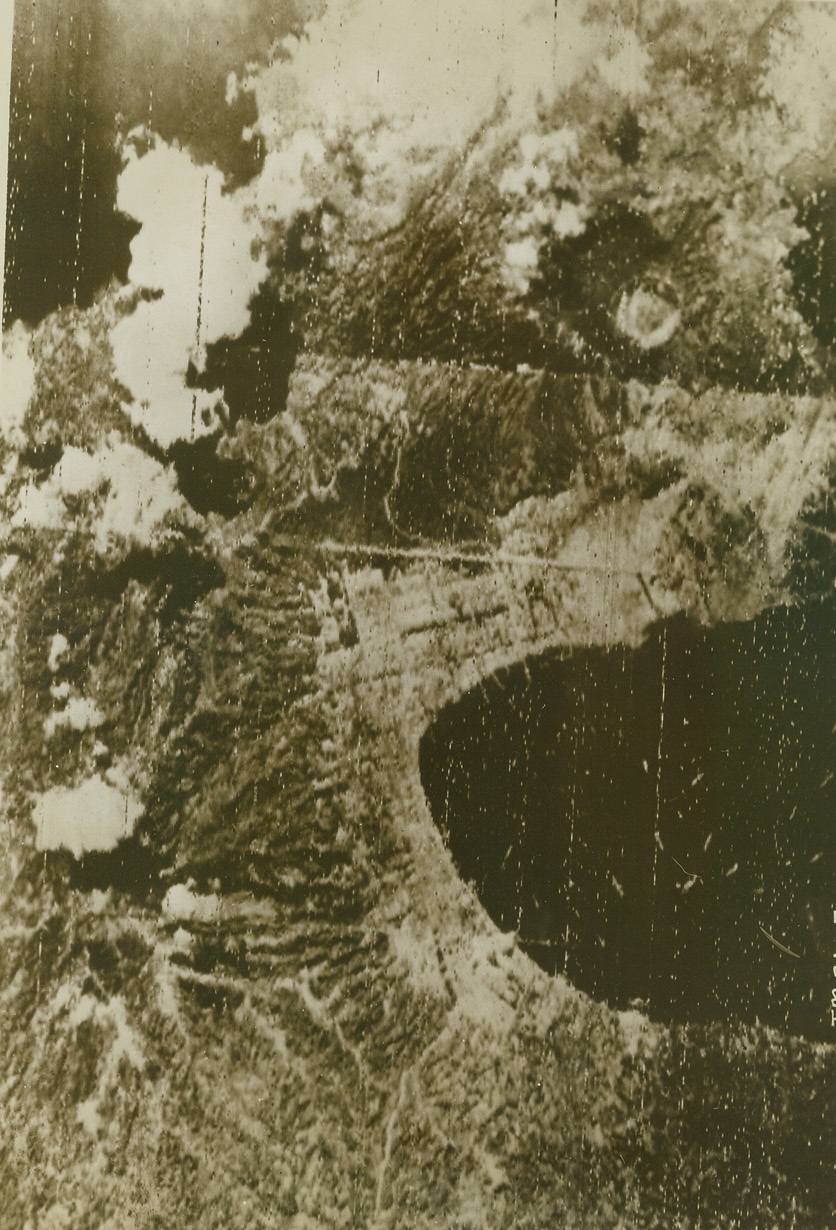
WE SMASH RABOUL, 10/14/1943. AMERICAN BOMBS ROCK RABOUL, JAP BASE ON NEW BRITAIN ISLAND The dark patch in the lower part of the photo is the harbor of the base, where the enemy lost 119 vessels and 177 planes, according to a communiqué from Allied Headquarters in the South Pacific. Credit: U.S. Army Signal Corps photo via OWI Radiophoto from ACME;
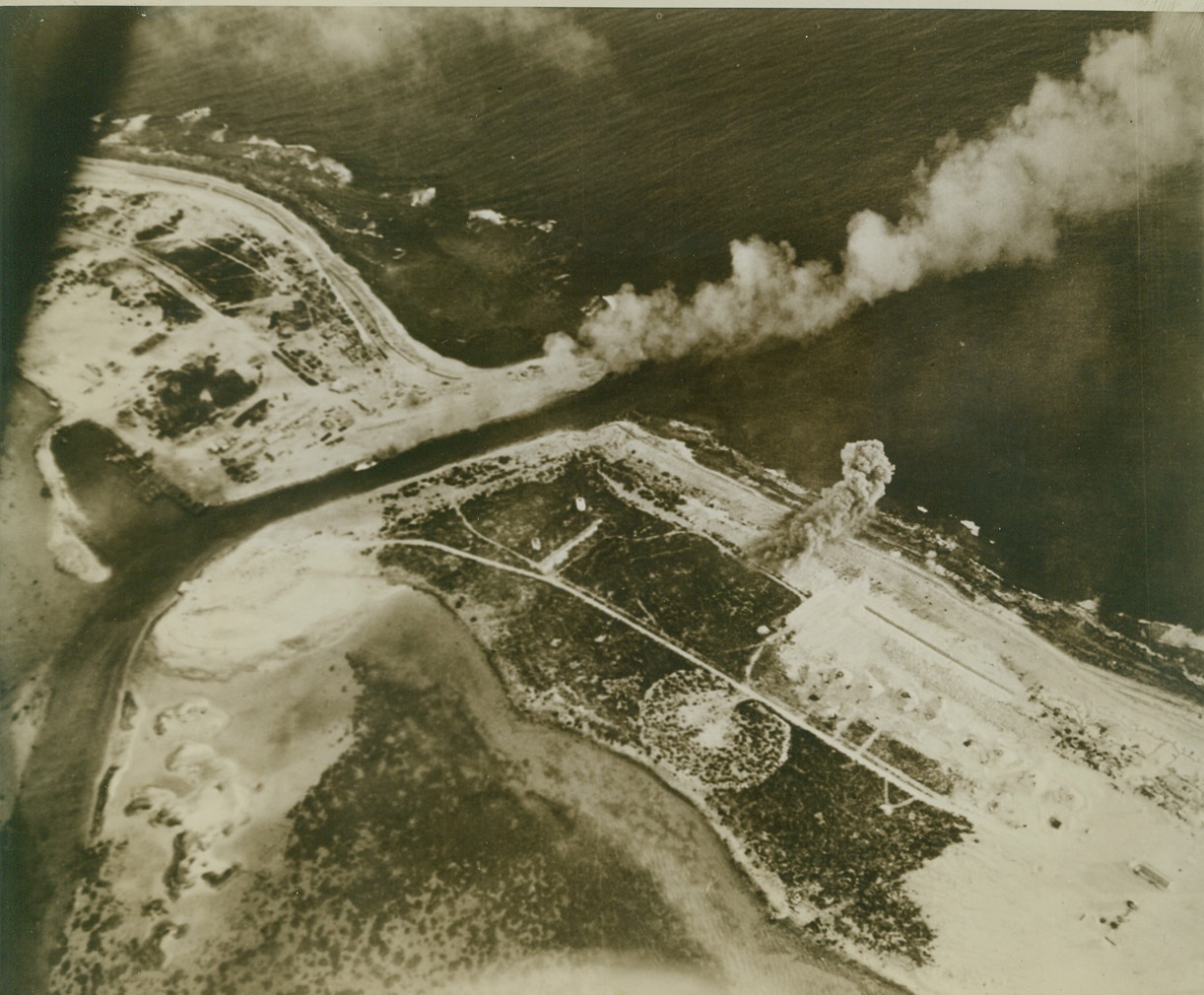
TANKER BURNS AS WAKE IS RAIDED, 10/13/1943. A small Jap tanker burns in the channel between enemy-held Wake Island (Left) and Wilkes Island (Right) as bombers of the U.S. Navy Task Force that raided the 3-island Wake Group pass over. Storage tanks have just been hit near the coast of Wilkes. Three hundred and twenty tons of bombs fell on Wake during the 2-day raid. Credit: U.S. Navy photo via OWI Radiophoto from ACME;
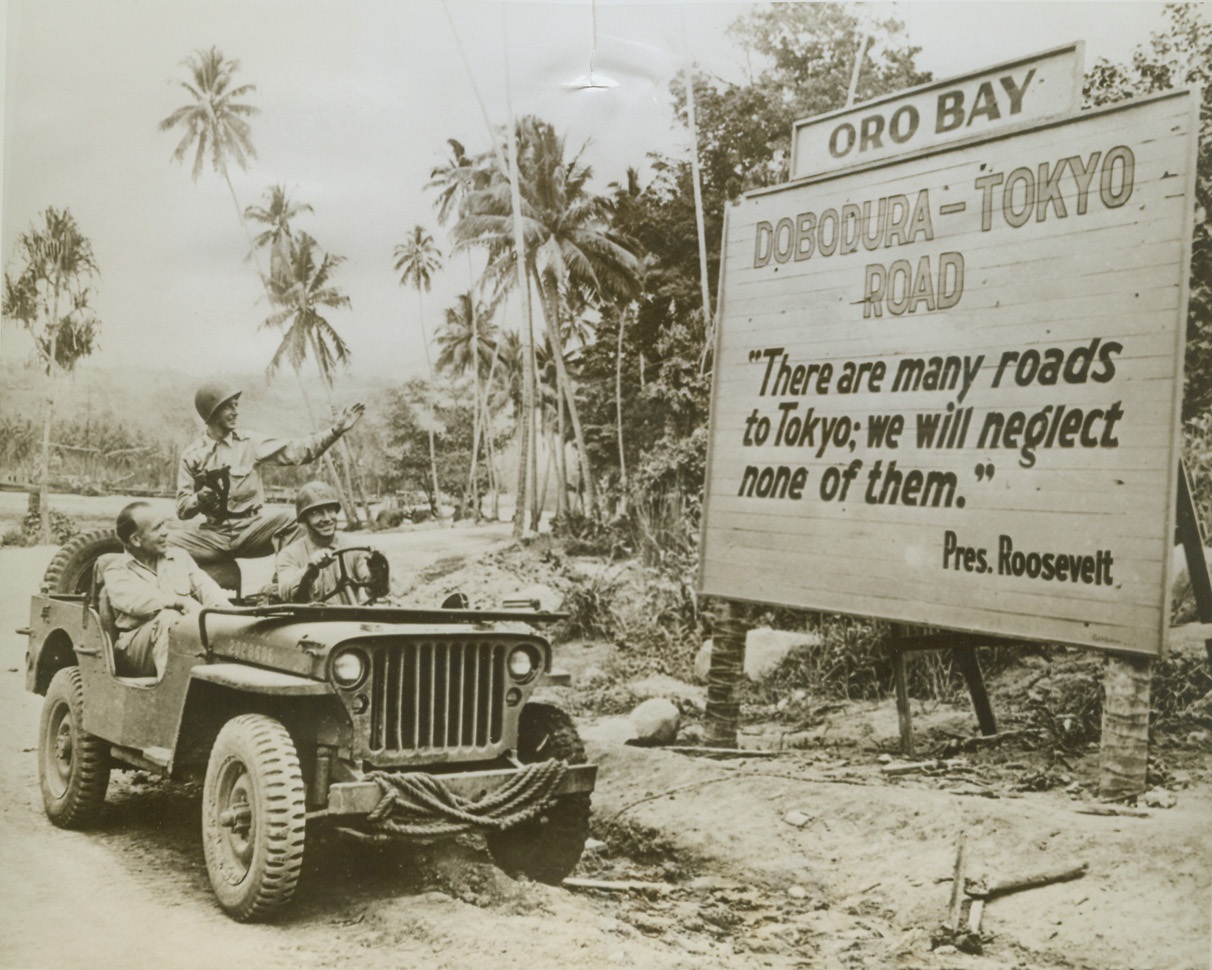
ONE ROAD TO TOKYO, 10/27/1943. ORO BAY, NEW GUINEA – This sign erected at Oro Bay, is a constant reminder to Allied troops there, that their goal is Tokyo. Left to right, are: “Little” Jack Little and Ray Bolger, stars who have been entertaining troops in the Southwest Pacific; and Col. C.S. Meyers, USA, who is driving the two around on a jeep sightseeing tour. Credit: U.S. Army photo via OWI Radiophoto from ACME;
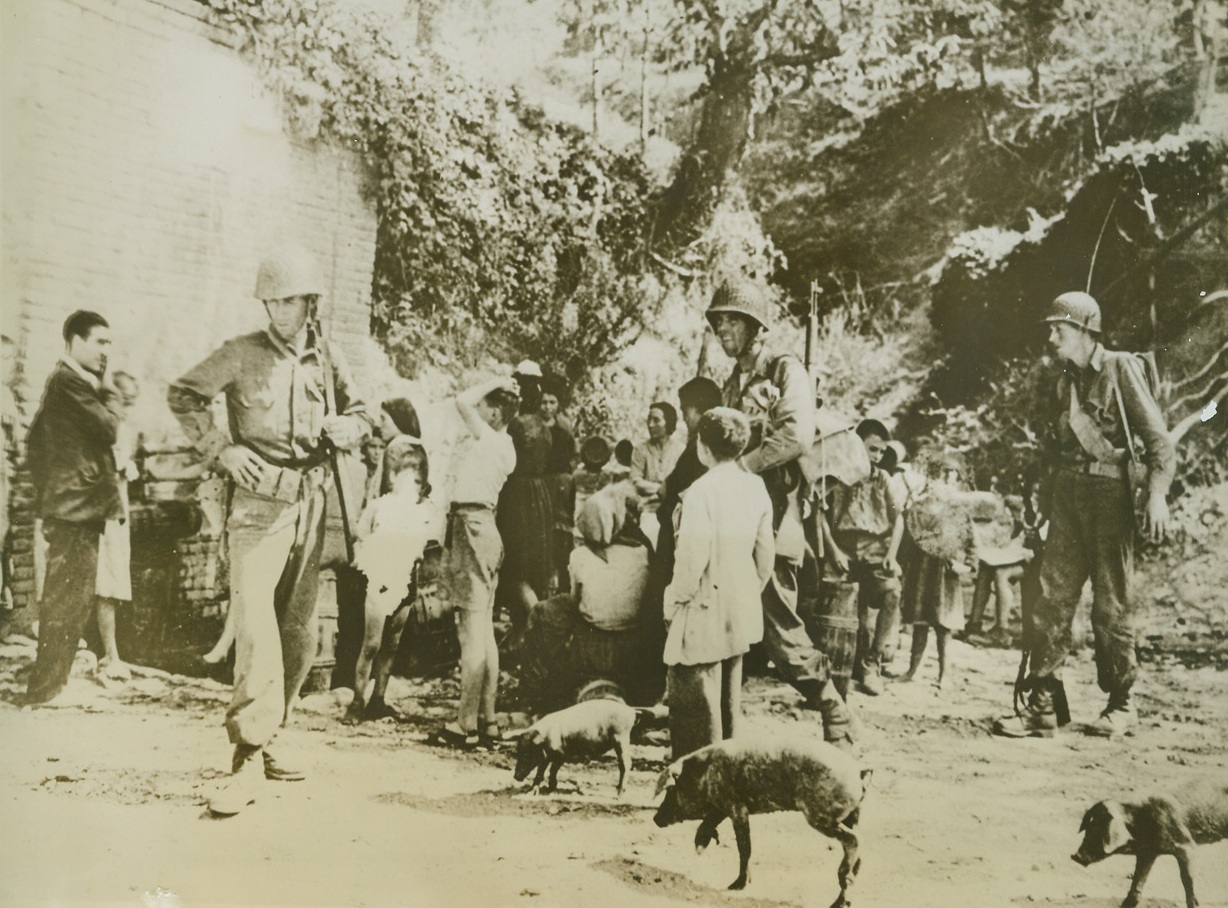
Pigs In The Streets, 10/14/1943. ALTAVILLA, ITALY—Walking through the streets of liberated Altavilla, Fifth army warriors have to be careful not to trip over porkers that wander about. Coming out of hiding after allied troops took the town, liberated Italians gather in background to read posters put up by the allied military government. Credit: ACME;
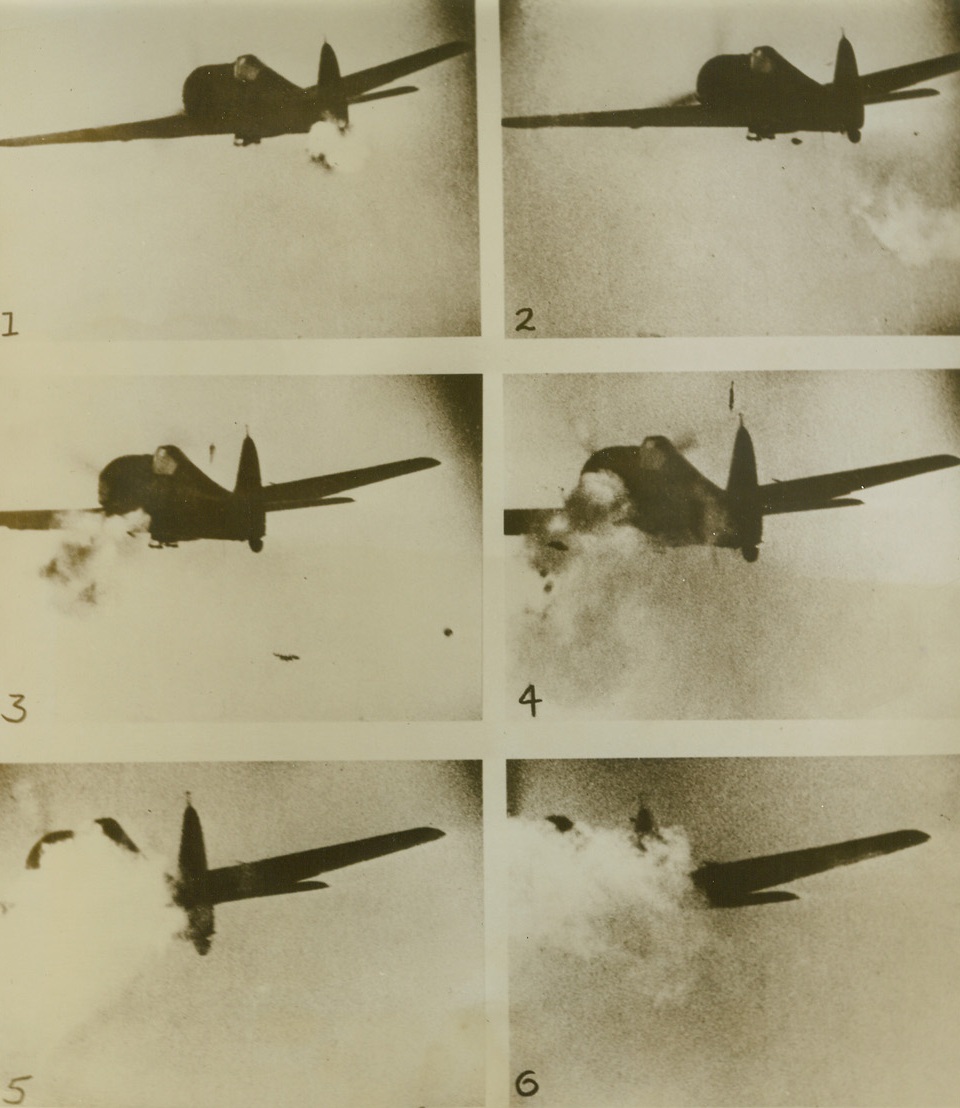
The end of a Foke –WULF 190, 10/14/1943. It’s minutes were numbered when this German Foke-Wulf 190 got inside the sights of a gunner aboard a Royal Air Force Fighter Command squadron’s Typhoon. This series of photos shows the split-second disintegration of the enemy plane as it blew up under a stream of fire from the Typhoon. In Photo #1 the gunner scores his first hit, on the plane tail. In subsequent photos, parts of the enemy fighter begin to fall, until, in one photo the Fouke-Wulf190 blows up completely.Credit: ACME;
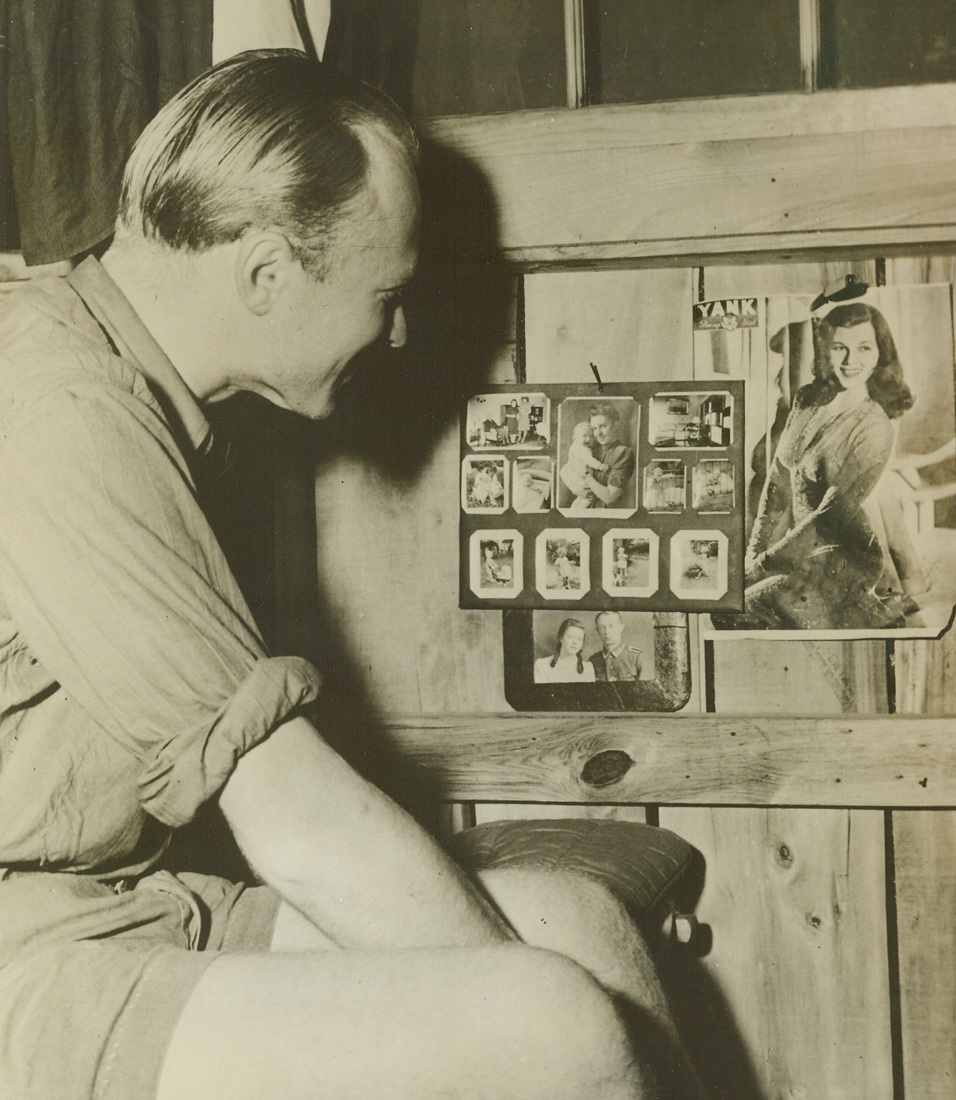
Life At The Largest Nazi Prisoner Of War Camp, 10/4/1943. Aliceville, Ala. – Thousands of German prisoners now occupy miles and miles of guarded territory at Aliceville, Alabama, at the country’s largest internment camp for captured Nazis. Tennis courts, badminton and various ball game facilities are available between the barracks within each compound that contains 1,000 prisoners. A contest in landscaping resulted in beautifully kept green lawns, sculptured animals and patterned flower gardens, while the opportunity to build exercise aids led to the erection of horizontal bars, broad-jump pits and shot-put courses. Very few Nazis have tried to escape, and not one has succeeded. These photos show a few typical scenes at the Aliceville internment camp. Pin-up girl photos are not confined to the barracks of Allied soldiers. Here a Nazi prisoner of war admires a glamour girl, and his pictures from home. The Germans receive frequent mail and packages from home. Credit: US Army Signal corps photo from ACME;
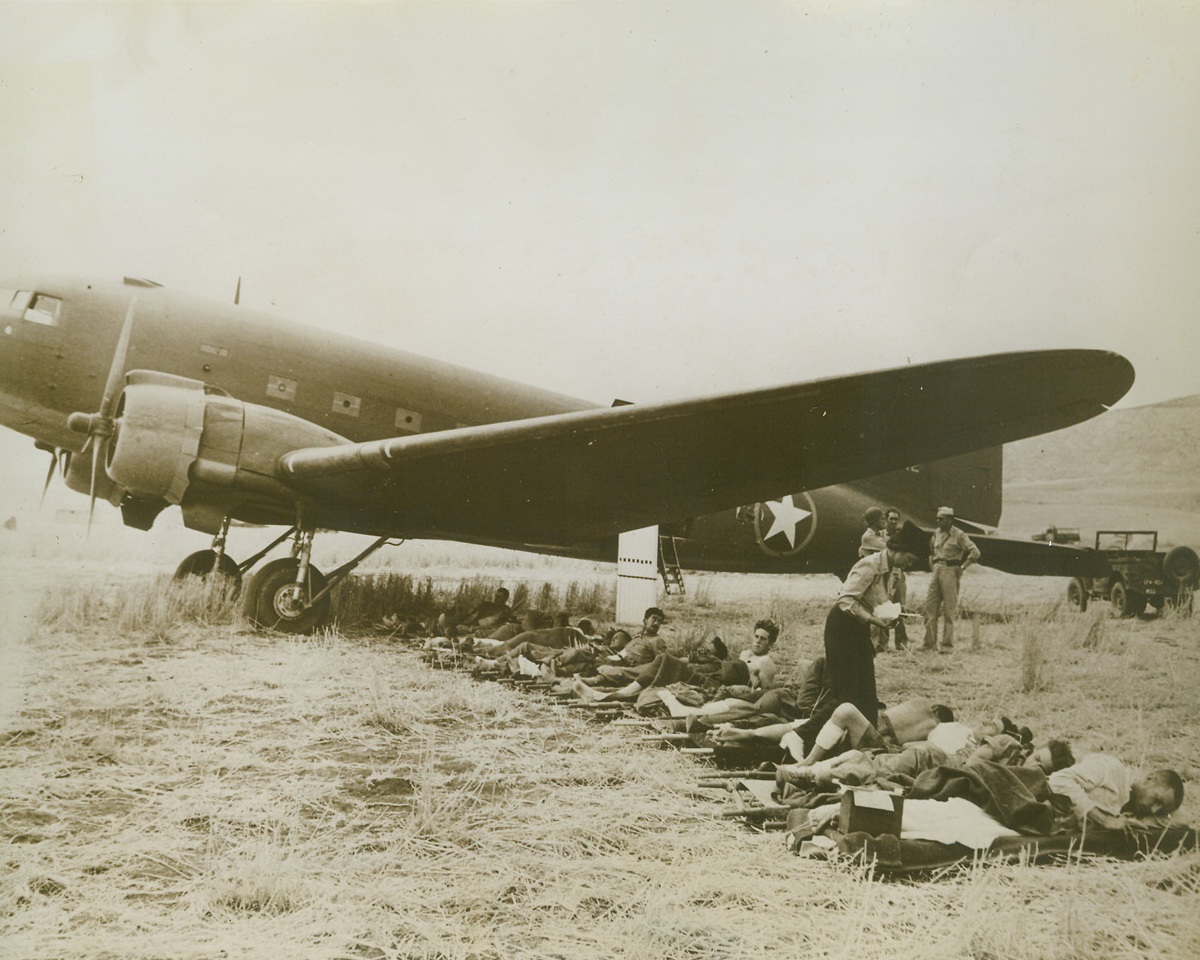
Ready For Air Hop to Hospital, 10/6/1943. Shaded from the burning sun, wounded Italian and Allied Soldiers wait to be put aboard this Douglas C-47 Sky Train transport plane and flown to a hospital in Africa. A nurse tends to their needs as they rest beneath the plane’s broad wing.Credit: U. S. Signal Corps Photo from OWL NY DJH for #12 #17 AEP CEP CAN;
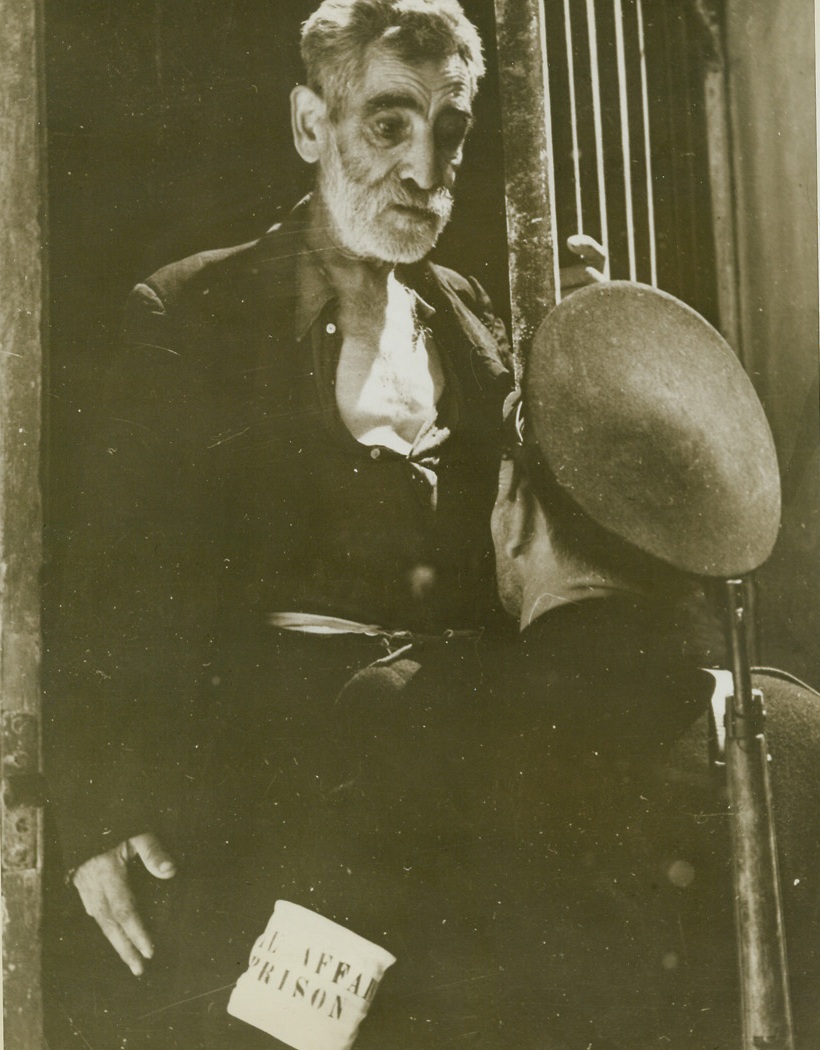
He Fought Facism, 10/13/1943. FAVIGNANA – An aged anti-Facist, who bitterly resisted the government of Mussolini and his gang, prepares to leave, forever, his cell on Favignana Island. Political prisoners were released when the Allied Military Government took control of the island, which lies off the west coast of Sicily, near Trapni.Credit: Official U. S. Army photo from ACME;
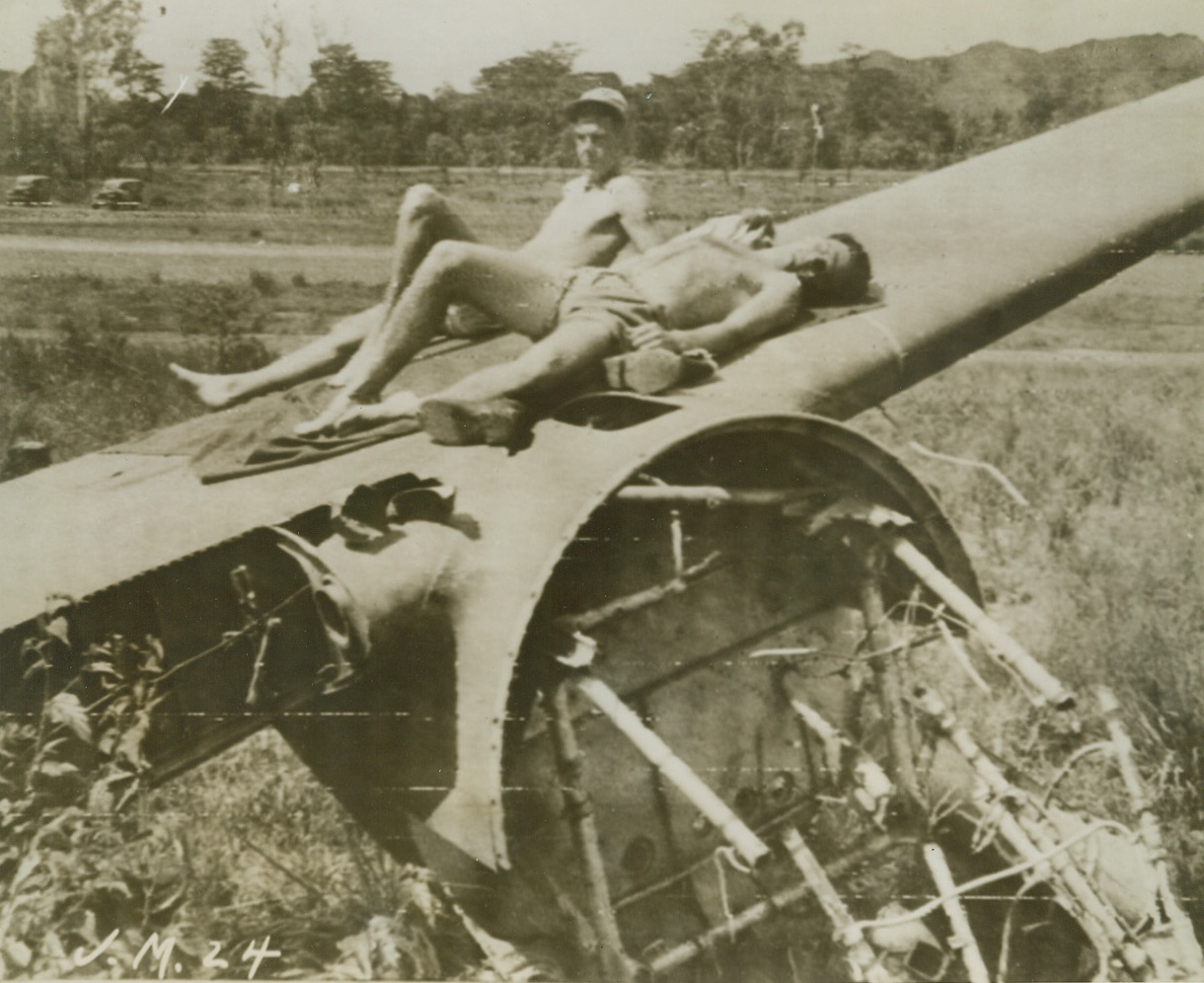
New Guinea Sundeck, 10/19/1943.NEW GUINEA – Between air attacks on Jap bases in the Southwest Pacific area, American Air Force Officers catch up on their sunbathing, stretched out on a crashed bomber on the edge of the jungle. Left is 1st LT. William Fairbanks, of Glendale, California; Right Capt. Alex Guerry of Sewanee, Tenn.Credit (ACME Photo by Frank Prist for the War Picture Pool Via ARMY RADIOTELEPHOTO.);
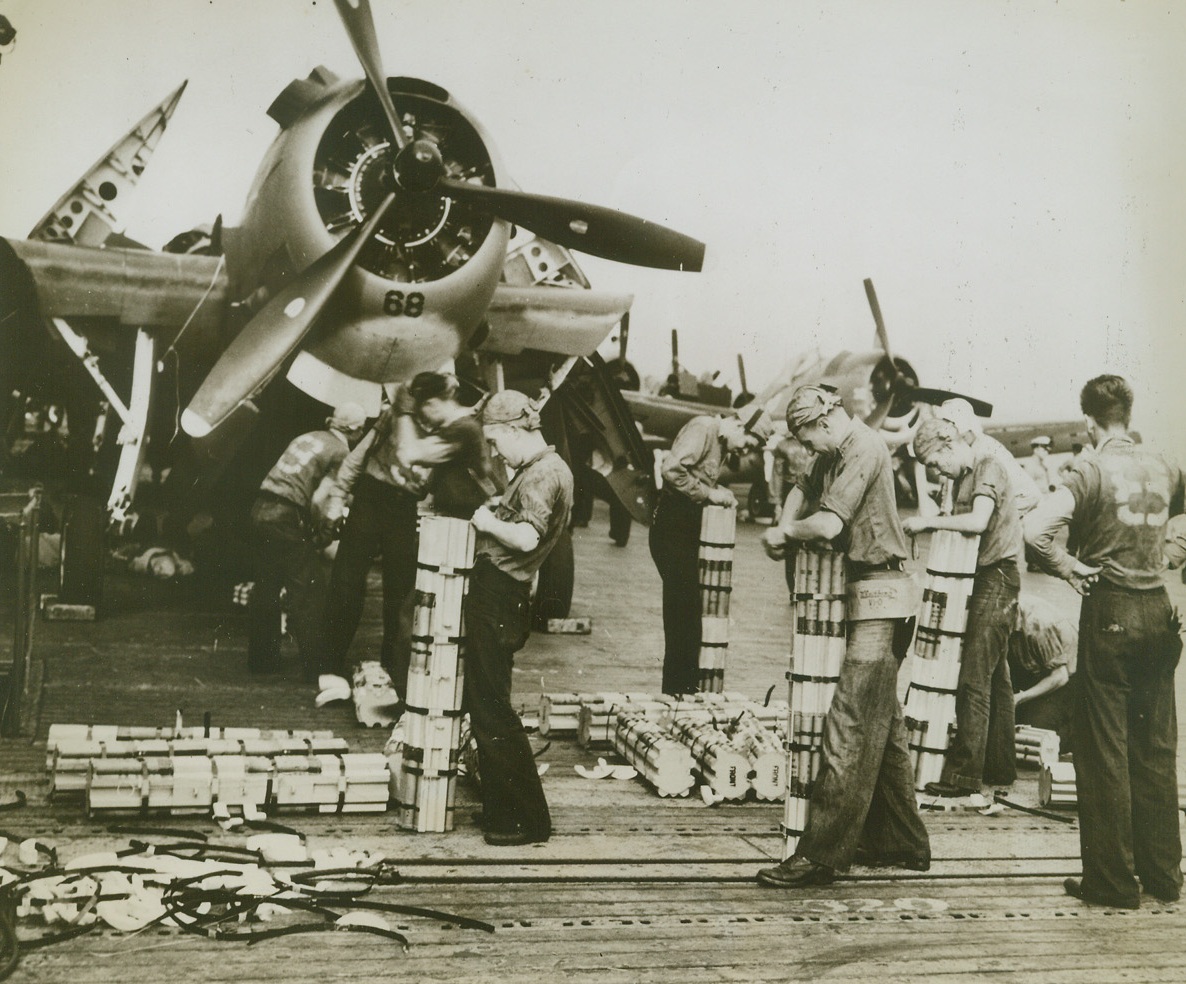
Firebugs, 10/16/1943. AT SEA – Crewmen aboard a Navy flat-top are shown preparing a rain of fire for the Jap defenders of Tarawa in the Gilbert Islands. They’re loading incendiary bombs on the planes in between the many raids of Sept. 18 and 19. “Zero hour” is at hand and the men are working together in perfect coordination.Credit Line (Official US Navy Photo from ACME);
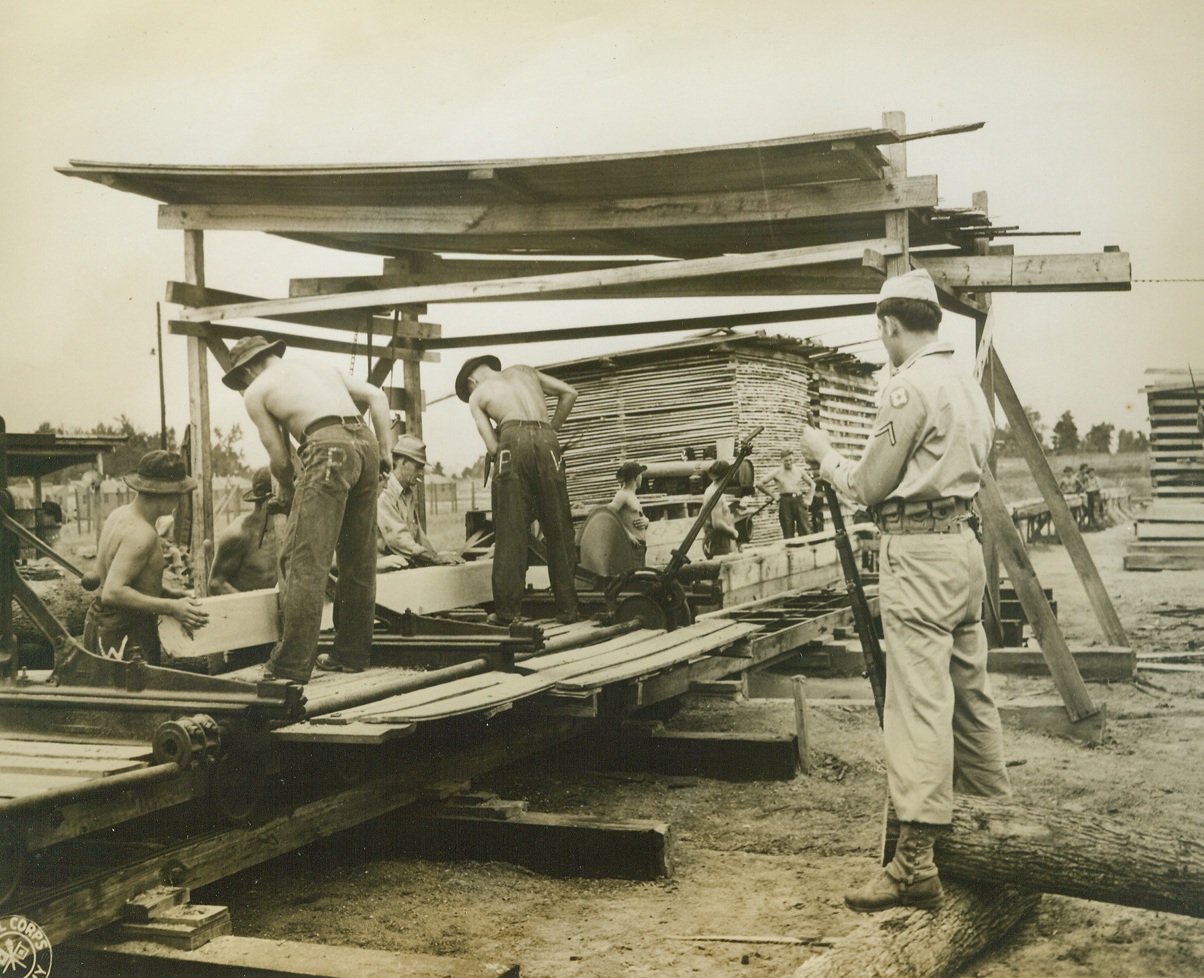
LIFE AT THE LARGEST NAZI PRISONER OF WAR CAMP, 10/4/1943. ALICEVILLE, ALA.—Thousands of German prisoners now occupy miles and miles of guarded territory at Aliceville, Alabama, at the country’s largest internment camp for captured Nazis. Tennis courts, badminton and various ball game facilities are available between the barracks within each compound that contains 1,000 prisoners. A contest in landscaping resulted in beautifully kept green lawns, sculptured animals and patterned flower gardens, while the opportunity to build exercise aids led to the erection of horizontal bars, broad-jump pits and shot-put courses. Very few Nazis have tried to escape, and not one has succeeded. These photos whow a few typical scenes at the Aliceville internment camp. With as many as 1,500 prisoners of war out working at one time, the Germans seem especially fitted for saw-mill jobs. A U.S. soldier guards this group of “lumberers” who receive 80 cents apiece for canteen credits out of the $2.50 a day paid the government.Credit: U.S. Army Signal Corps photo from Acme;
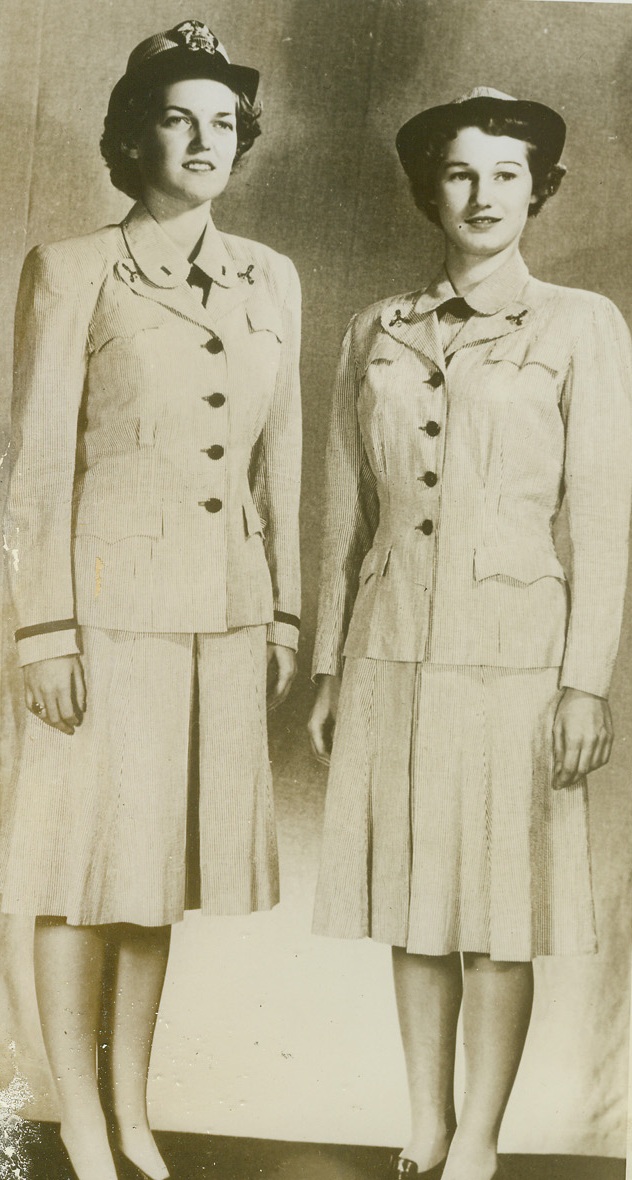
NEW SUMMER UNIFORM FOR WAVES, 10/1/1943. WASHINGTON, D.C.—Ensign Mary C. Broughton (left) of Washington, D.C., and Yeoman second class Marion Pearson of Cleveland, Ohio, both of whom are stationed in the Navy Dept. in Washington, model the new summer uniforms to be worn by members of the U.S. Navy Women’s Reserve. Gray and white striped seersucker, chosen to conform with the slate gray summer uniforms of Navy men, replaces the Navy cotton suit WAVES wore this summer. The removable hat cover is also of gray and white striped seersucker/Credit: Official U.S….;
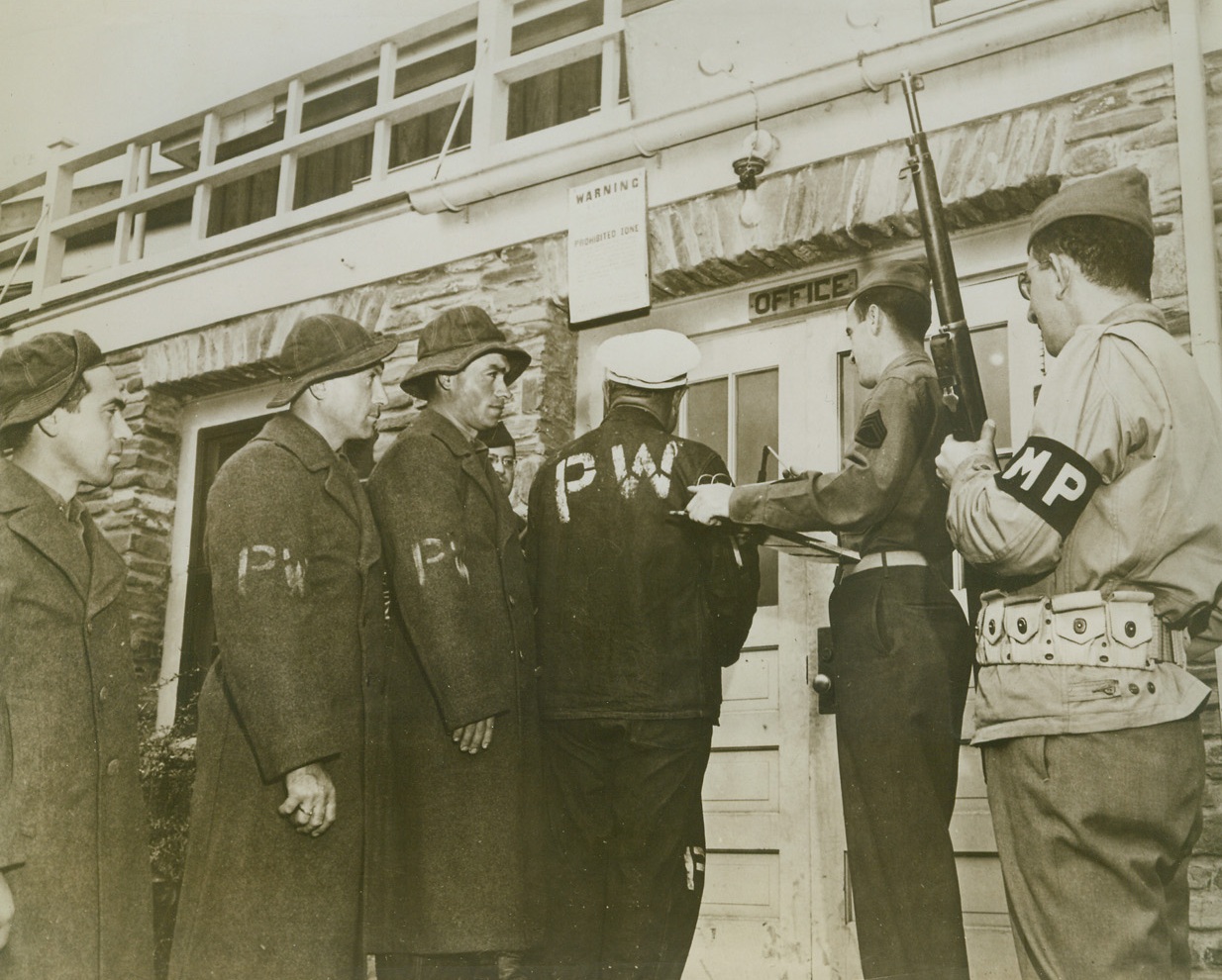
SHOWER AFTER A DAY’S WORK, 10/25/1943. LIVINGSTON COUNTY, N.Y.—After their day’s work in nearby fields or food processing plants, Italian war prisoners are checked back in Stony Brook Camp, Livingston County, N.Y. Throughout the day, they are under guard by U.S. military police who say they are model charges, wishing to create no trouble for the Americans. Instead, these former Italian soldiers want to fight the Germans for they feel that Hitler misused them.Credit: Acme;
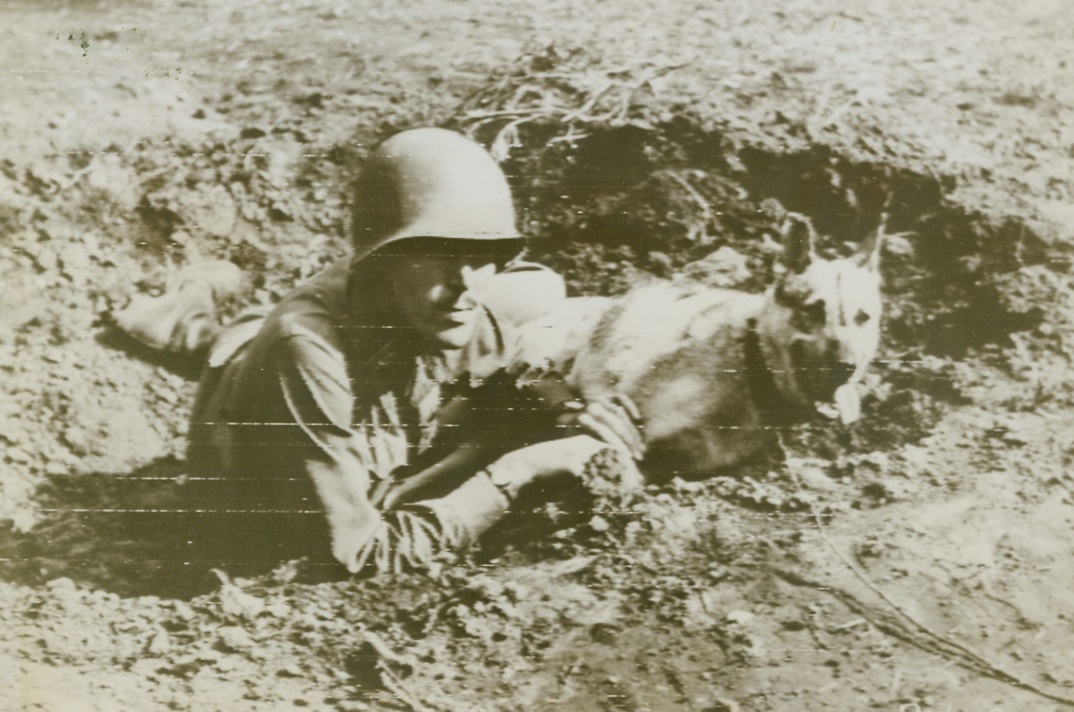
WAR-WISE POOCH, 10/30/1943. SOMEWHERE IN ITALY—“Il Duce”, who accompanies his master Lt. Eugene Phillips, of Royston, Ga., into battle, is a foxy fox-hole dweller these days, for he previously lost part of his ear in battle. The mascot knows enough to keep his head down and peer cautiously over the edge of the shelter, in Italy, as a result of the injury which has won him the recommendation of a Purple Heart award. “Il Duce” bears the honorary rank of Second Lieutenant for his sterling qualities of a soldier he possesses in spite of being found in a German-Italian legation in North Africa.Credit: Acme photo by Bert Brandt, War Pool Correspondent, via U.S. Army Signal Corps radiotelephoto;
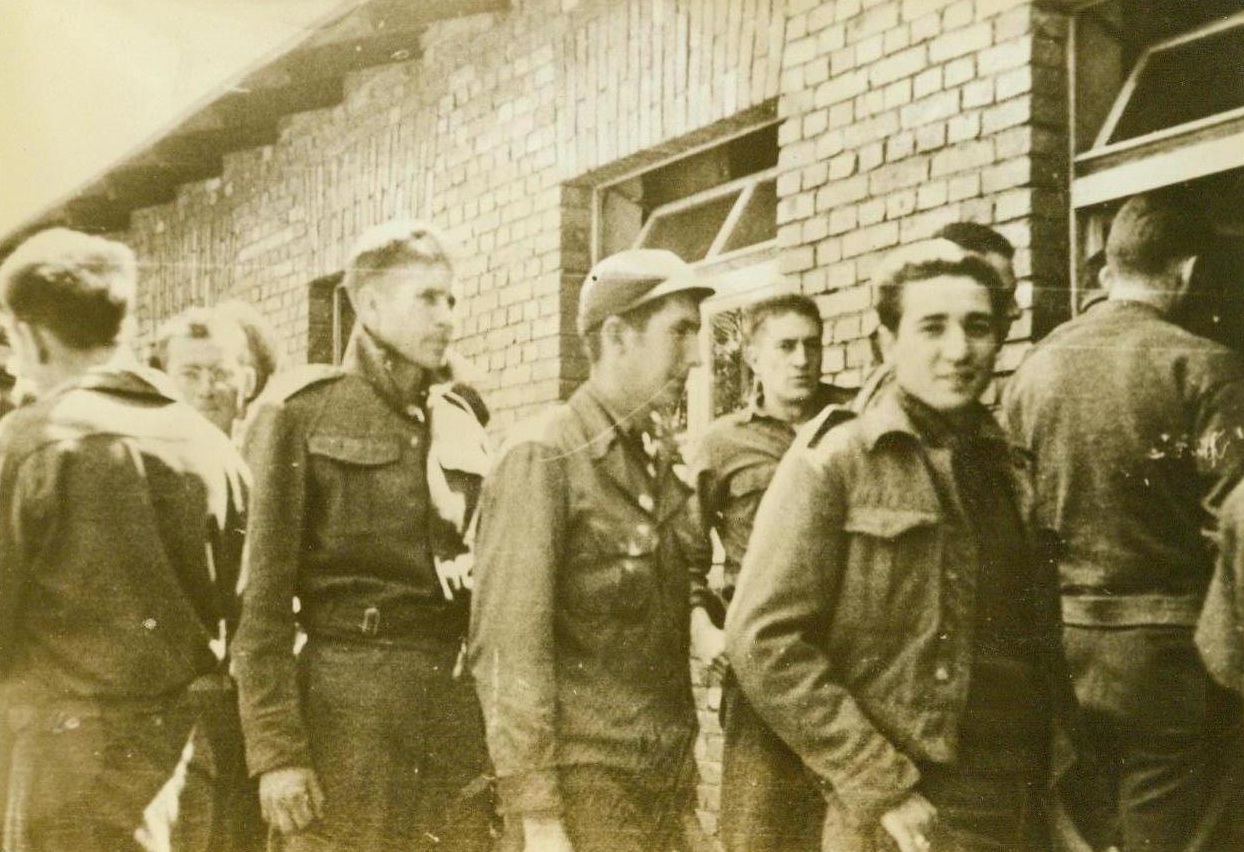
YANKS LINE UP FOR CHOW AT NAZI PRISON CAMP, 10/7/1943. This photo, sent to the United States by a Y.M.C.A. War Prisoners Aid delegate who visited the prison camp, shows American soldiers captured in the fighting in North Africa, as they lined up for chow at a mess hall at Stalag (Illegible), a camp southeast of Berlin. The delegate reported that the camp fare plus the weekly 11-pound food packages received from the American Red Cross, furnishes the interned Americans a better diet than that received by German civilians. In the photo, some of the men wear British uniforms as their own were probably damaged in battle. They will receive new U.S. uniforms soon. Credit Line (ACME);
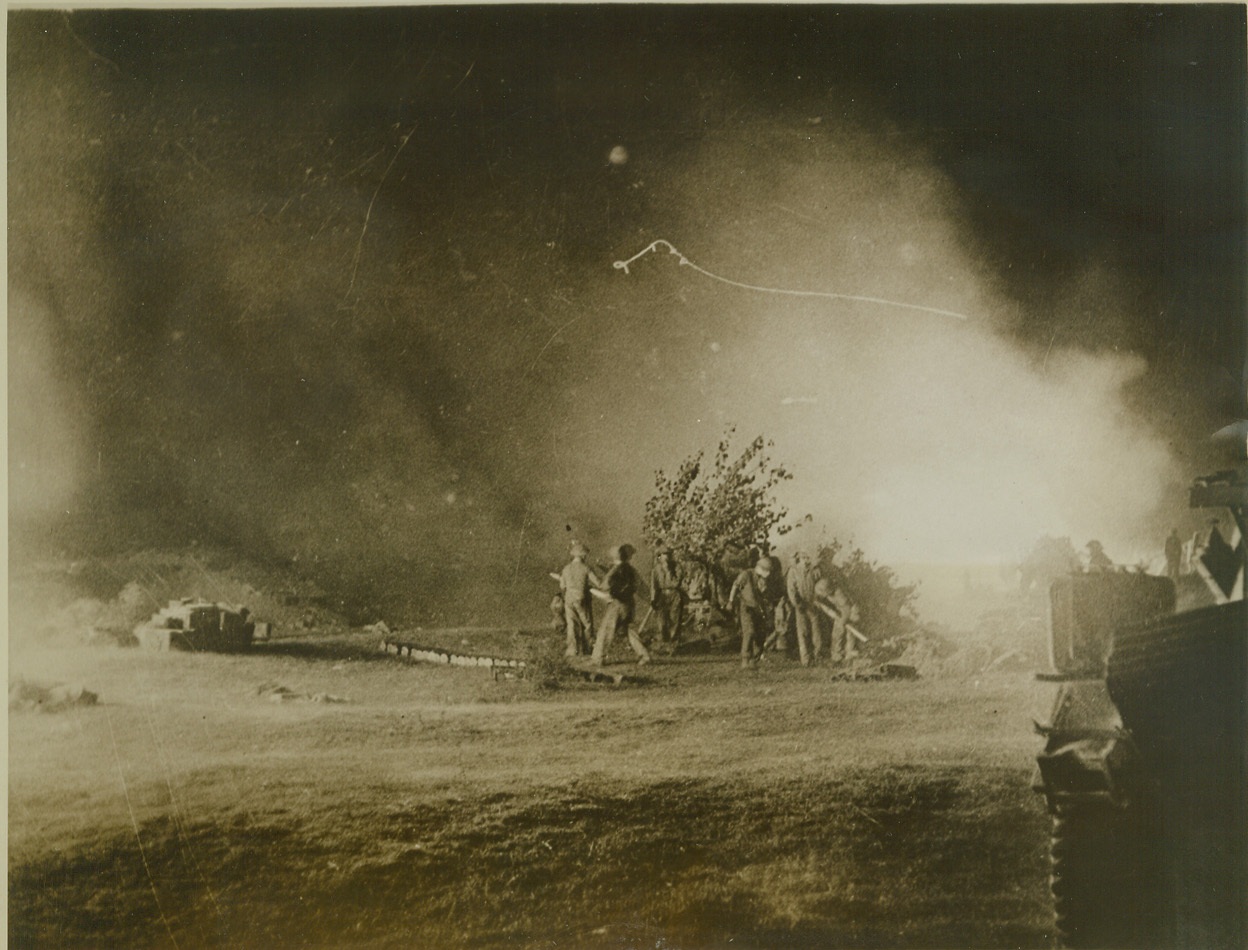
Anti-Aircraft Guns in Action, 10/14/1943. Naples, Italy – The skies around Naples are bright with the light of Allied gunfire as the Allied Fifth Army battles for possession of the important Italian city. Here, anti-aircraft gun crews send their arms into action at night, in the earlier stages of the fight for Naples. Credit: (ACME);
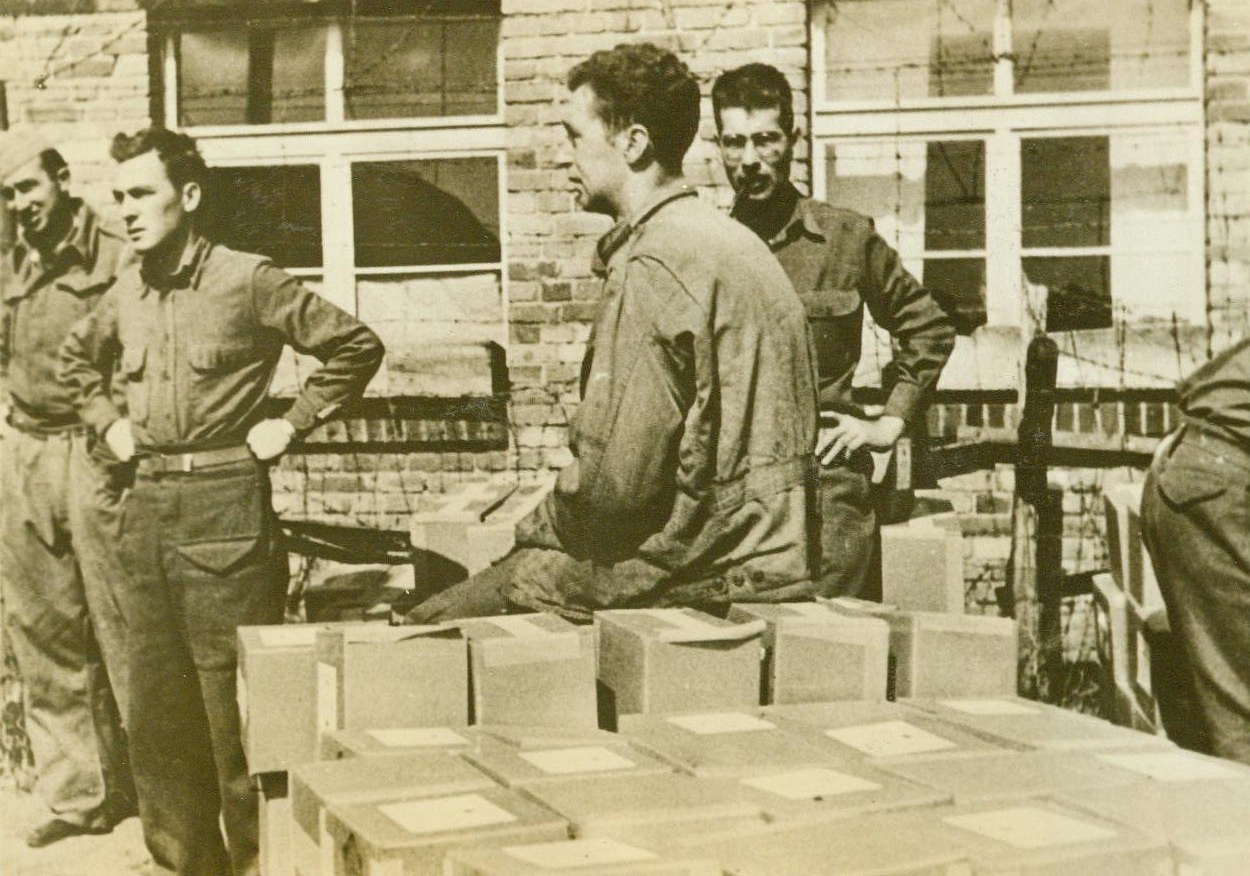
CAPTURED YANKS GET FOOD PARCELS, 10/7/1943. This photo, taken and sent to the U.S. by a Y.M.C.A. War Prisoners Aid delegate who visited the prison camp, shows American soldiers, captured in the fighting in North Africa, as they received 11-pound American Red Cross food packages at Stalag (illegible), a German prison camp southeast of Berlin. The delegate stated that the camp fare, plus the concentrated food in the Red Cross packages, gives the interned Americans a better diet than that of the German civilians. Credit Line (ACME);
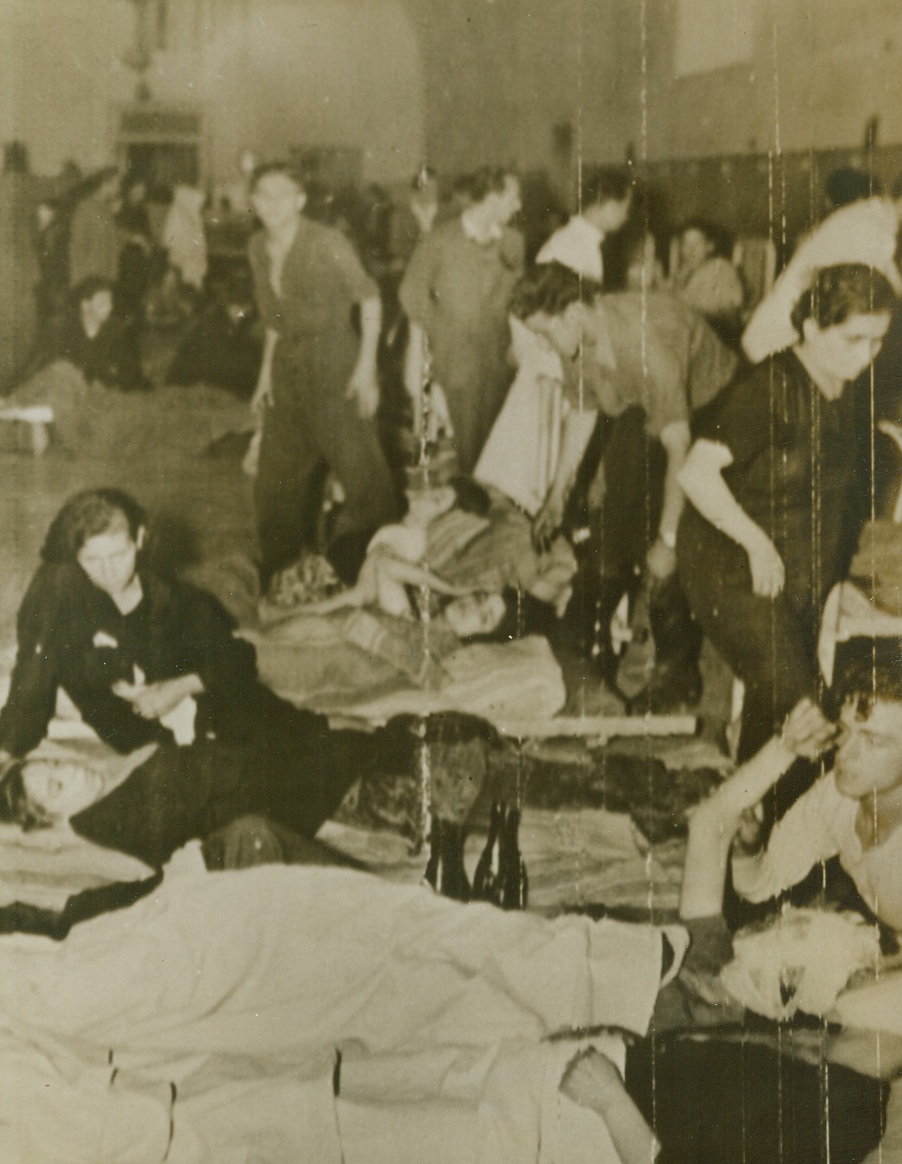
Injured Lie on the Floor, 10/3/1943. Naples, Italy—Prior to the entry of the allied forces into Naples, the Italian city’s hospitals were crowded far beyond their capacity. Here, those seriously injured as a result of the battle for their city, lie on the floor of the over-taxed hospital for incurables in Naples. Relatives and friends attend the patients, assist the overworked hospital staff. Credit: Photo by Charles Seawood, ACME photographer for War Pool, via U.S. Army Signal Corps radiotelephoto, from ACME.;
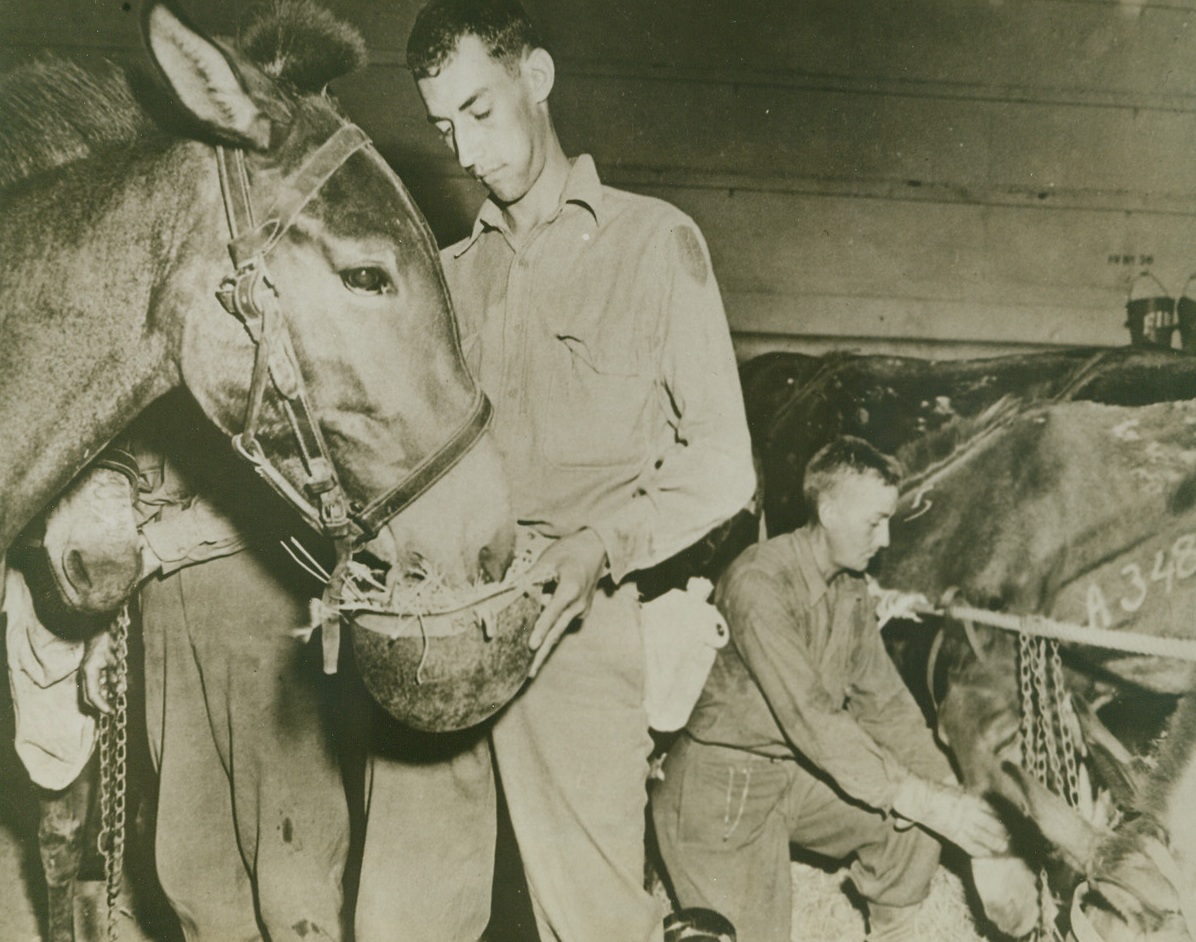
Necessity is the Mother of Invention, 10/27/1943. Sicily—Like the famed Jeep, the GI helmet is proving its versatility. During the loading of mules of an army unit onto LST boats at Palermo, Pvt. Harris feeds a mule from the helmet. Mules in background are being lined up and tied for shipping. Credit: Signal Corps photo from ACME.;
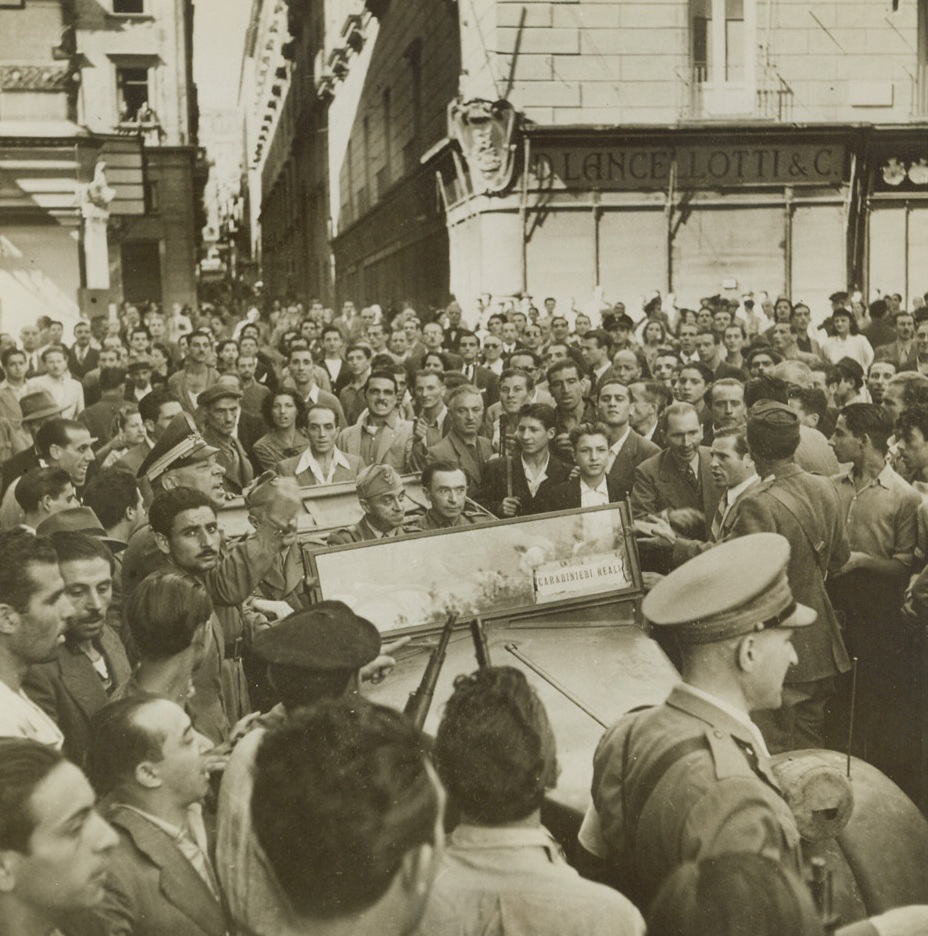
The Jig’s Up, 10/11/1943. NAPLES, ITALY—Three cringing fascist generals are faced with a revengeful mob who are out to kill them for the part they played in helping the Germans defend Naples against the Allies. The Generals—Radice, Carlino, Salla—are rescued by the Carabinieri and removed into the Municipio with great difficulty in this scene which represents the first open revolt of the people against their fascist leaders since our invasion of Sicily. The three Italian Generals were in charge of the defense of Naples. Credit: line (ACME);
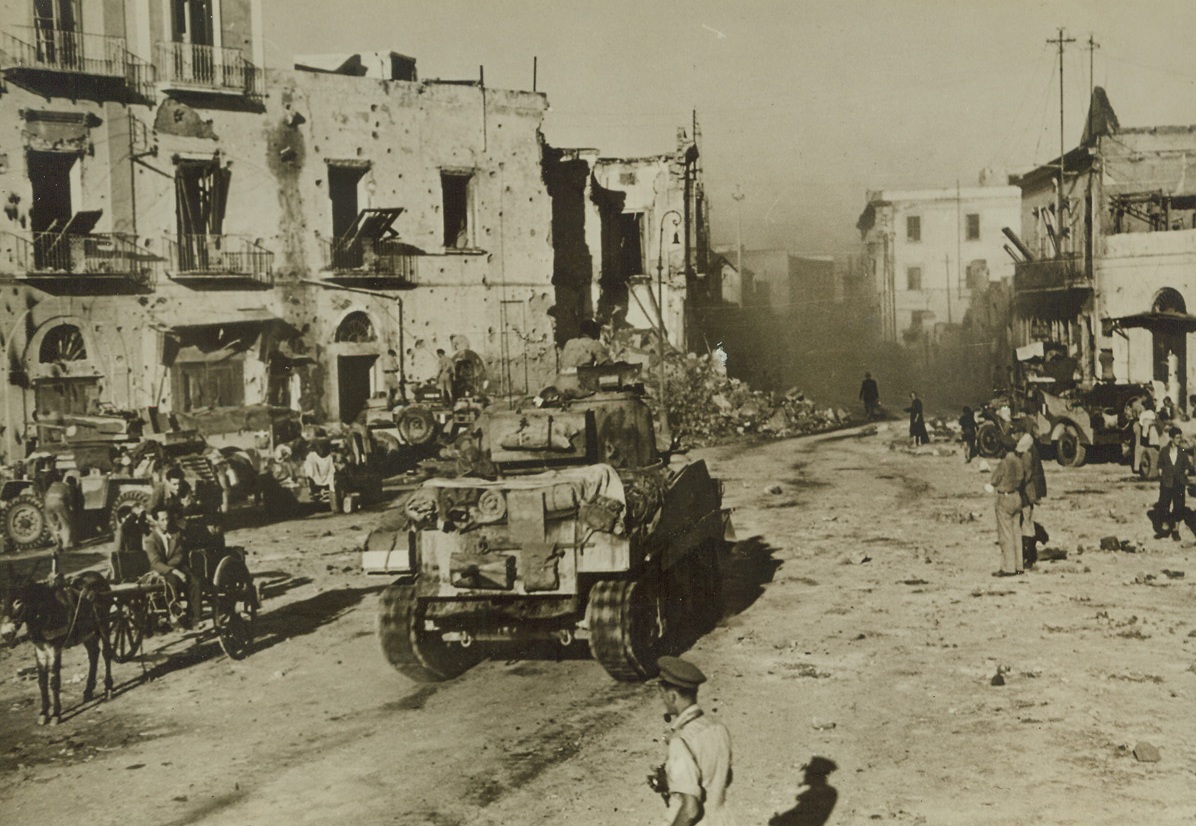
The Town’s Main Square, 10/11/1943. ITALY—Dust that was once buildings fills the air in the square of Torre Annunziata, passed through by British Tanks on their way to Naples. Two civilians who were in the midst of furious warfare stoically sit in their donkey cart surrounded by mechanized equipment. Credit: ACME.;
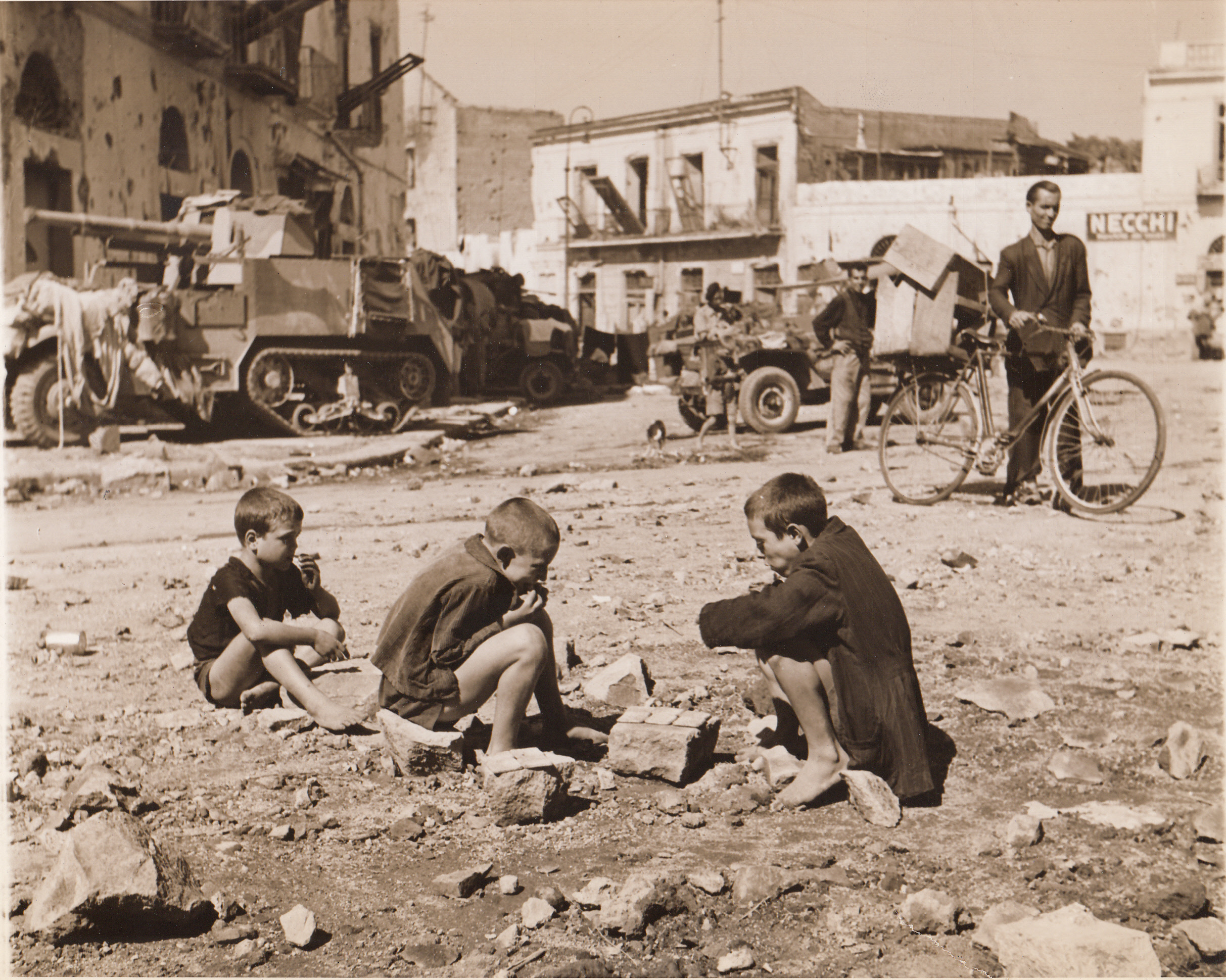
Hunger Appeased, 10/11/1943. ITALY—A far cry from an American outdoor picnic is this little group of Italian youngsters who cram biscuits in their mouths in the center of a war-torn street of Torre Annunziata. The barefoot kids huddle over the food, probably the first substantial bite they have had in a long time.;
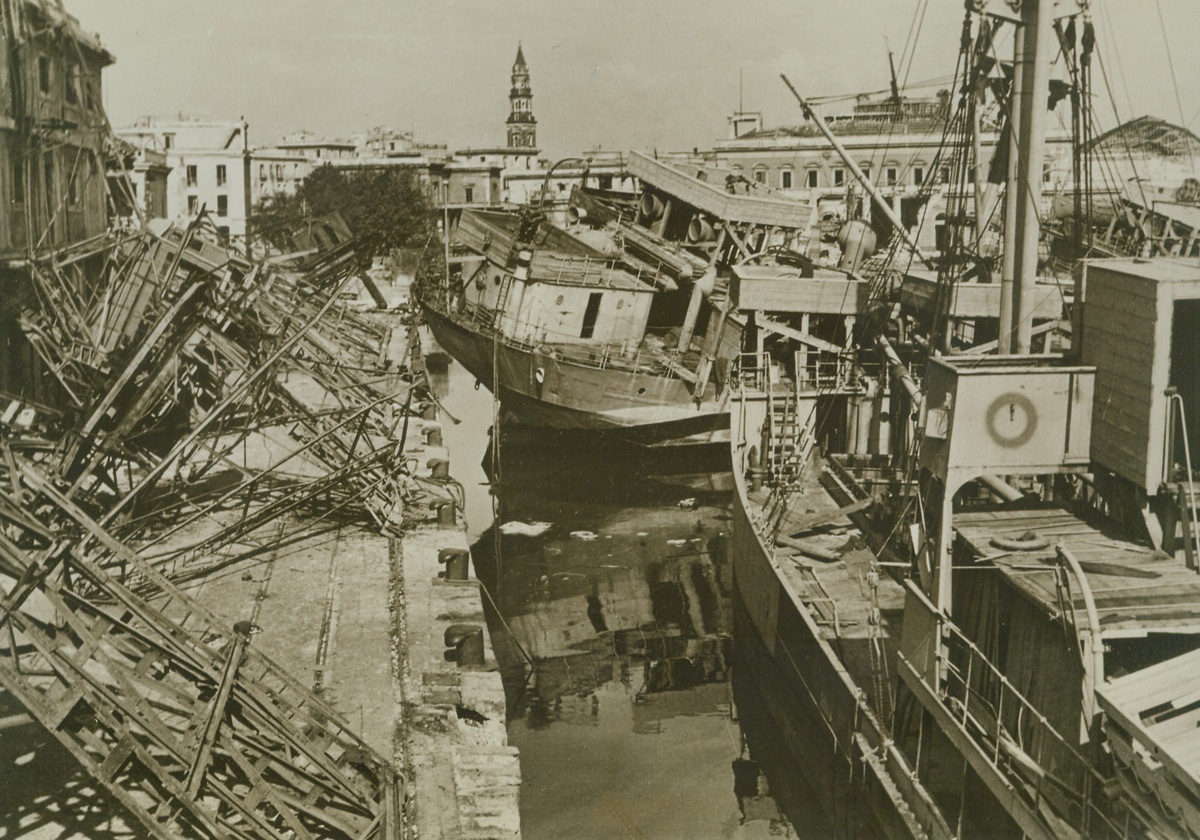
Naples Harbor Strewn with Wreckage, 10/11/1943. ITALY—The harbor of Naples is a mass of twisted steel and wood as the Allies take over the city. Allied bombs and Nazi demolition scrambled the big port, the goal of first drive after the invasion of Italy. Credit: ACME.;
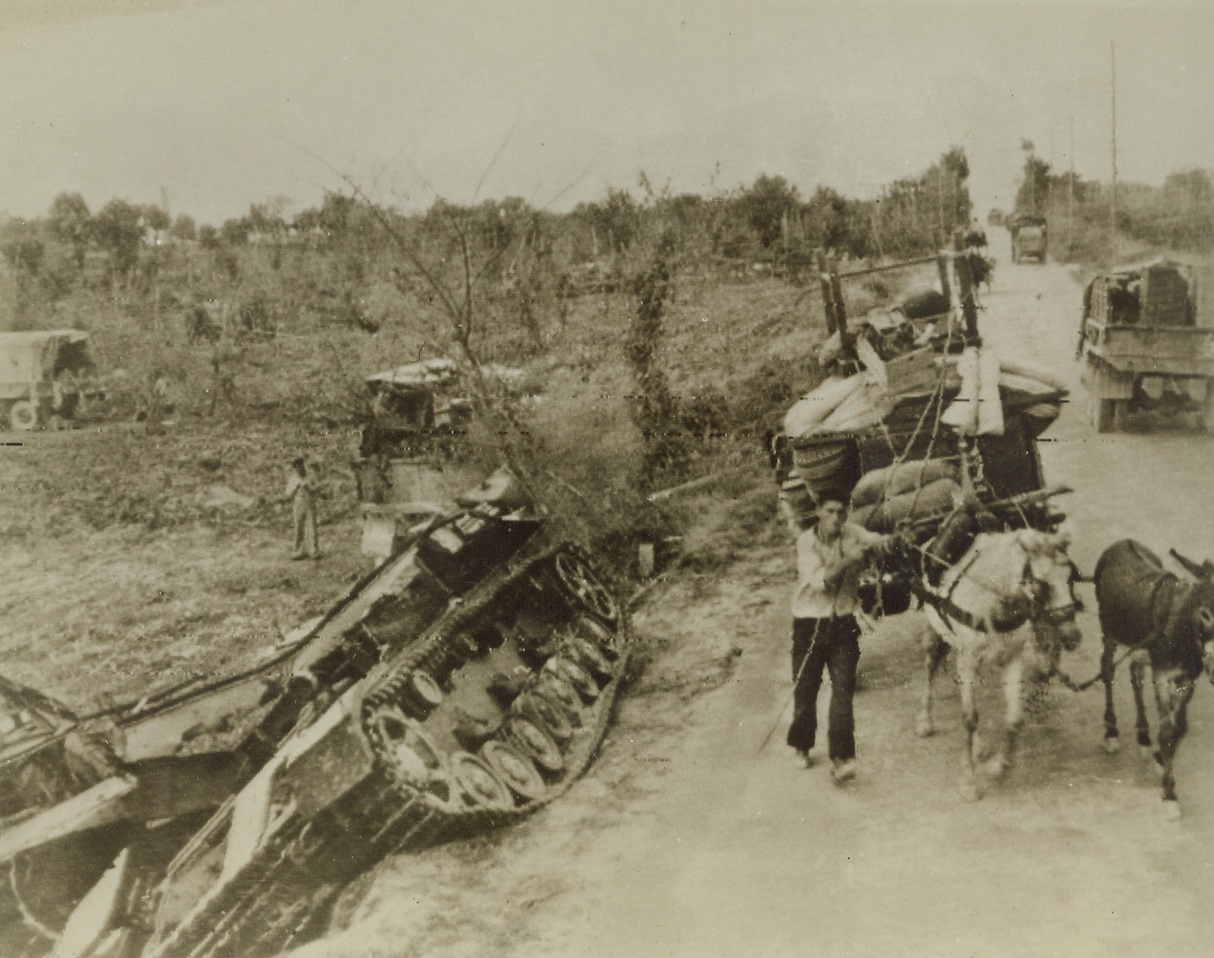
War Victims, 10/11/1943. NAPLES—Italian peasants are more interested in the problem presented by their household goods piled high on carts than they are the sight of a wrecked German tank on the road to Monte Corvine. These peasants have grown used to the sounds and violence of warfare and the problem of a new home are easily taken in stride. Credit: ACME RADIOPHOTO.;
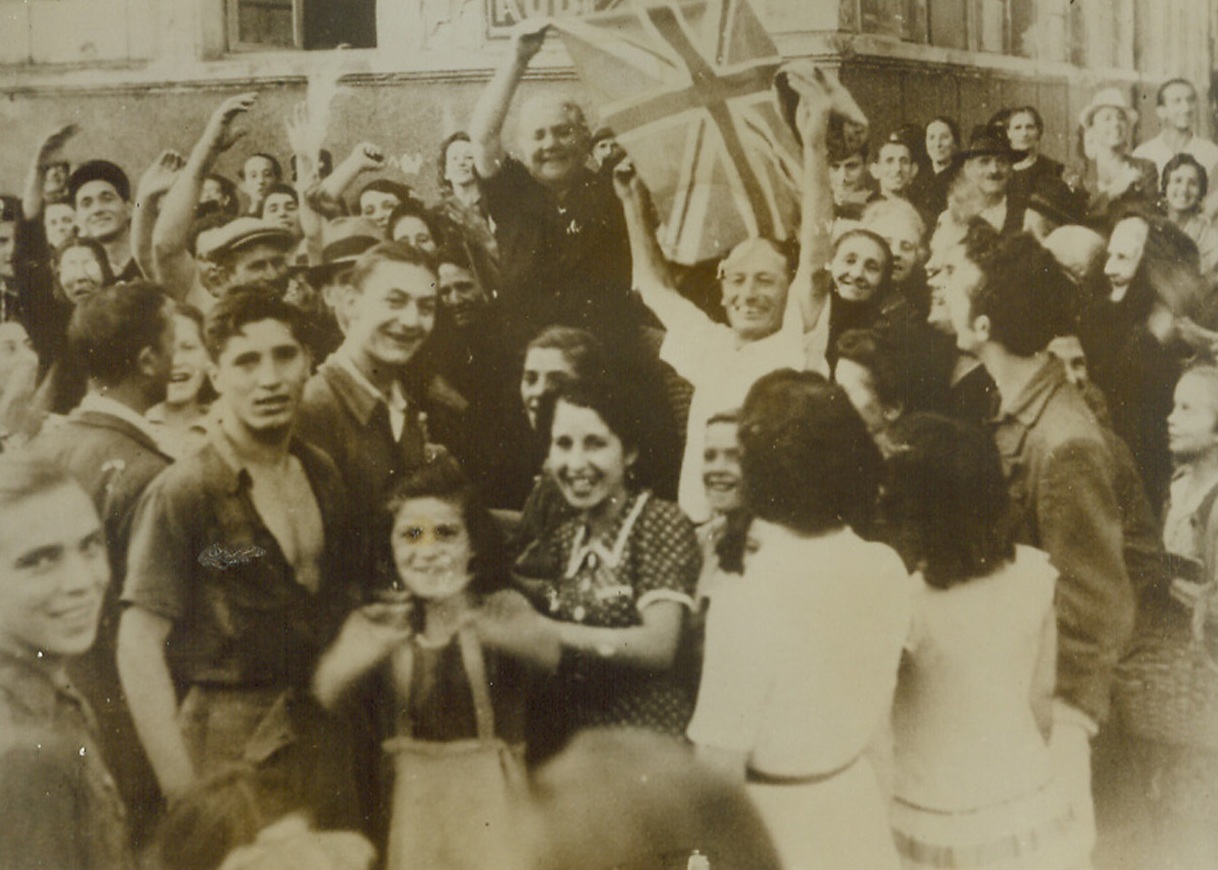
No More Swastikas, 10/11/1943. CORSICA—Two cheering and shouting elderly Corsicans wave the Union Jack which replaces the hated Nazi Swastika in their town of Ajaccio, the capital of the island now held by the Allies. The minute the town fell to Allied troops, the citizens turned out for riotous celebration. Credit: ACME.;
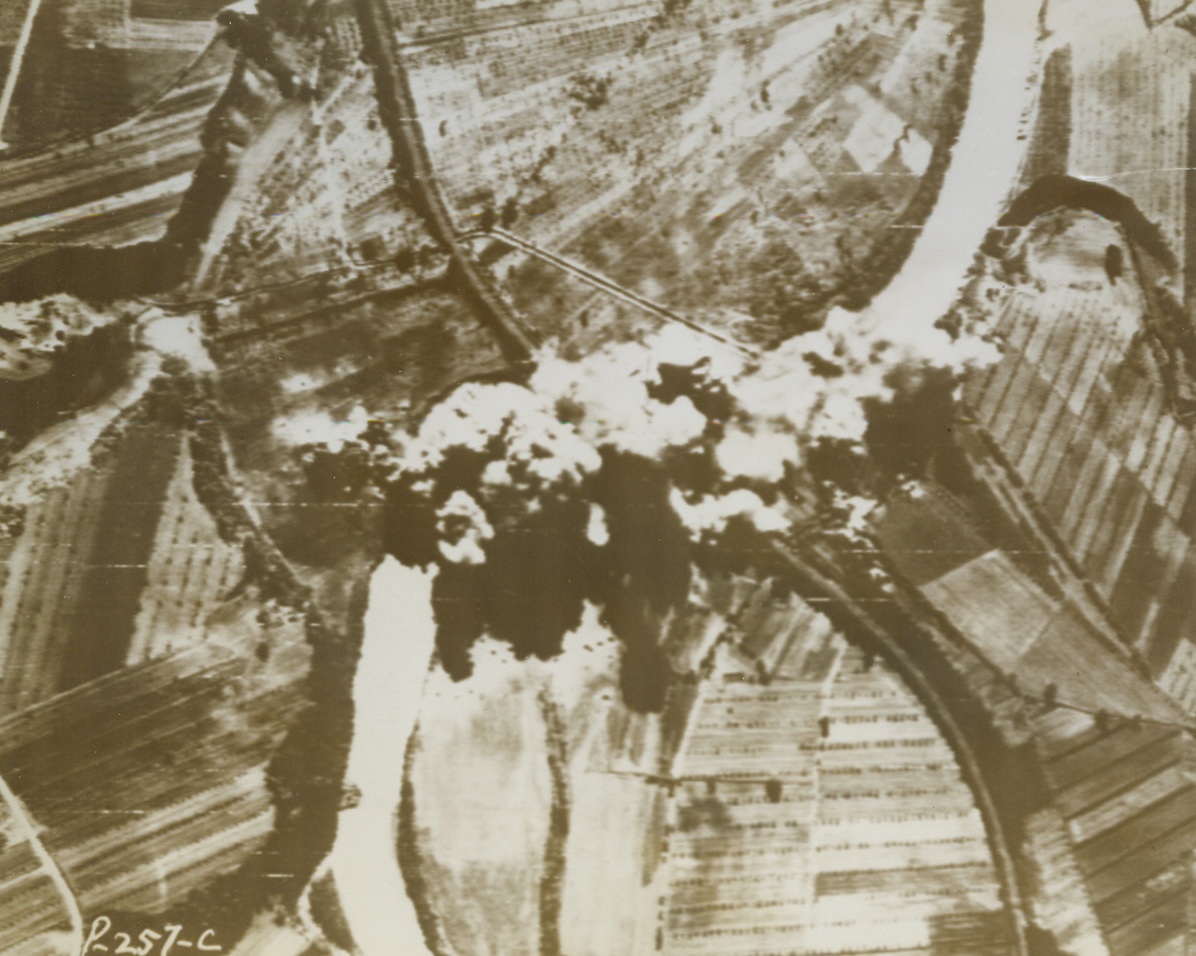
On the Button, 10/27/1943. An entire bomb load of bombs from Allied bombers, drops across this bridge in Italy, behind German lines, closing on Avenue of retreat and delaying supply columns, during a recent air attack. This is another splendid example of the accuracy of American and British bombardiers. Photo was flashed by radio to the United States. Credit: NORTH AFRICAN AIR FORCES PHOTO VIA ARMY SIGNAL CORPS RADIOTELEPHOTOFROM ACME.;
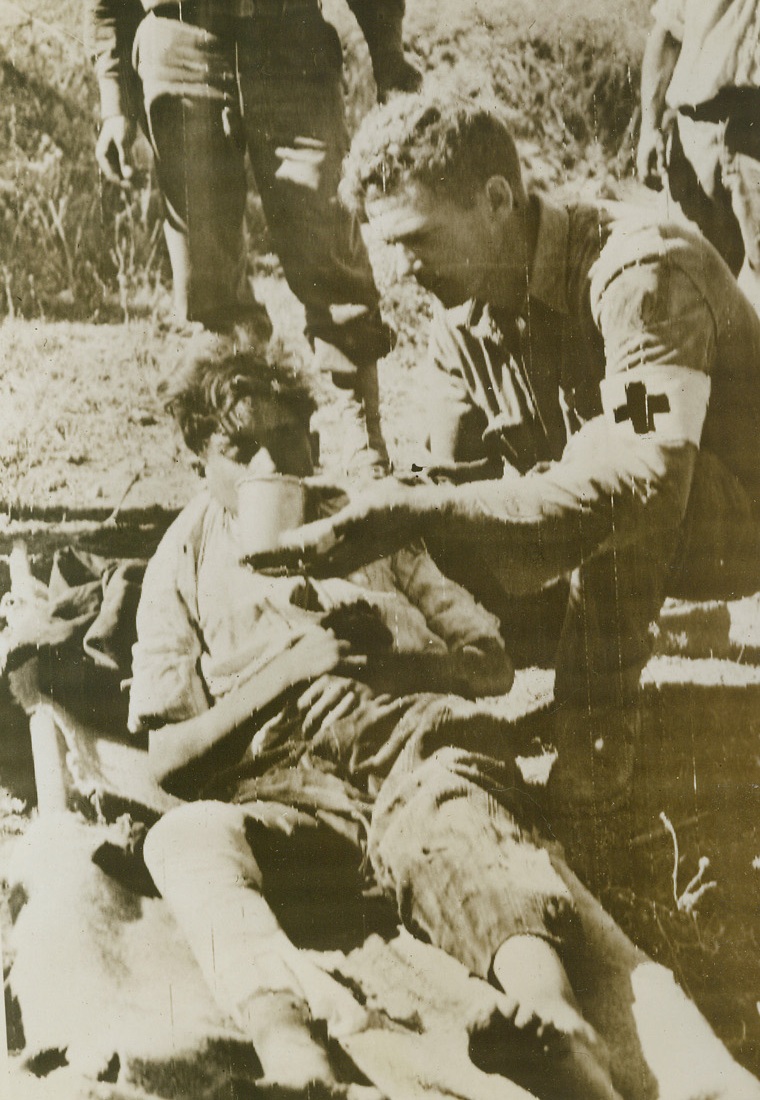
Water for Wounded Lad, 10/8/1943. ITALY -- Cpl. Charles Boss of Okmulgee, Okla., gives water to a wounded Italian youth who was seriously injured while plowing, when he struck a 90mm "dud" shell in the field. The medical corpsman administered first aid to the boy. Credit (U.S. Signal Corps Radiotelephoto - ACME);
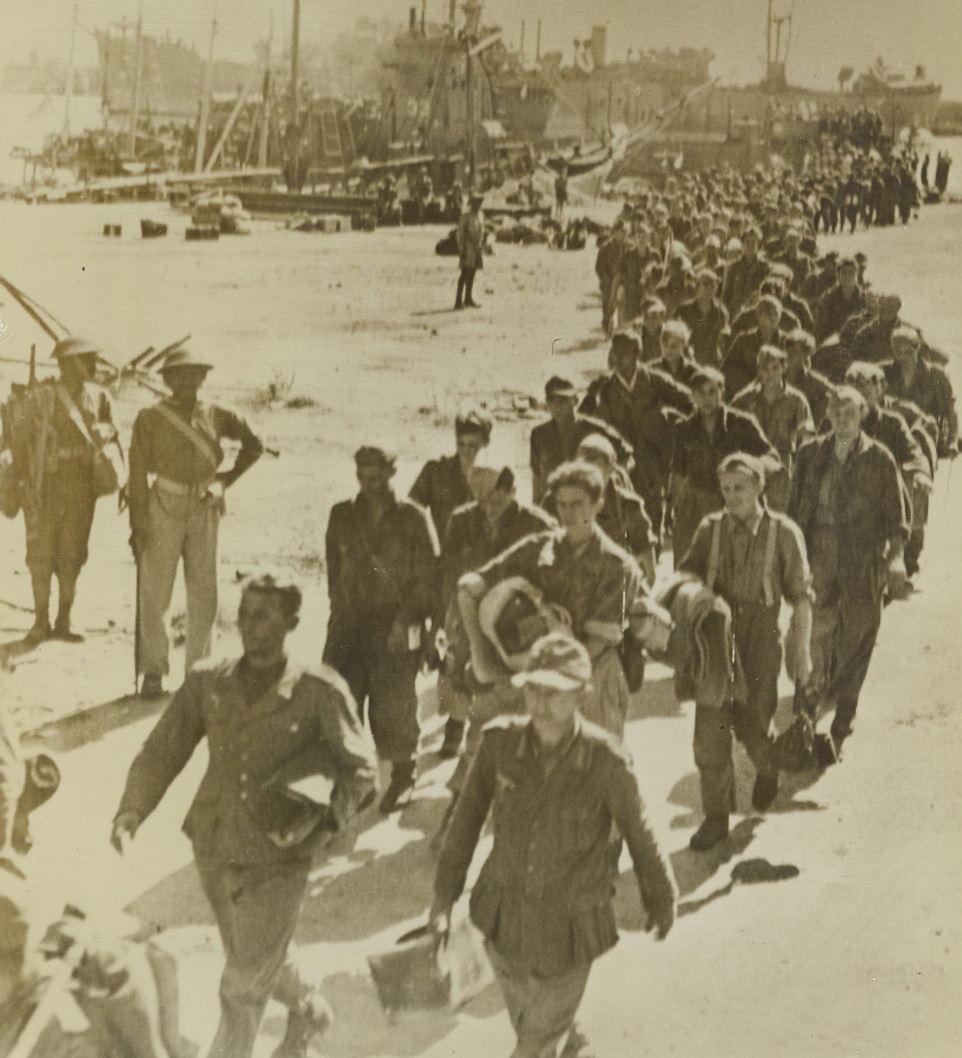
Captured by Americans in Italy, 10/4/1943. This photo, flashed to the U.S. by radiotelephoto today, shows a long line of Germans, captured by American troops in an Italian seacoast town, as they march off of lighters on their way to prison stockades “somewhere in Italy.” Secretary of the Navy Frank Knox, who was in Italy at the time, watched these prisoners march by. Credit: U.S. SIGNAL CORPS RADIOTELEPHOTO.;
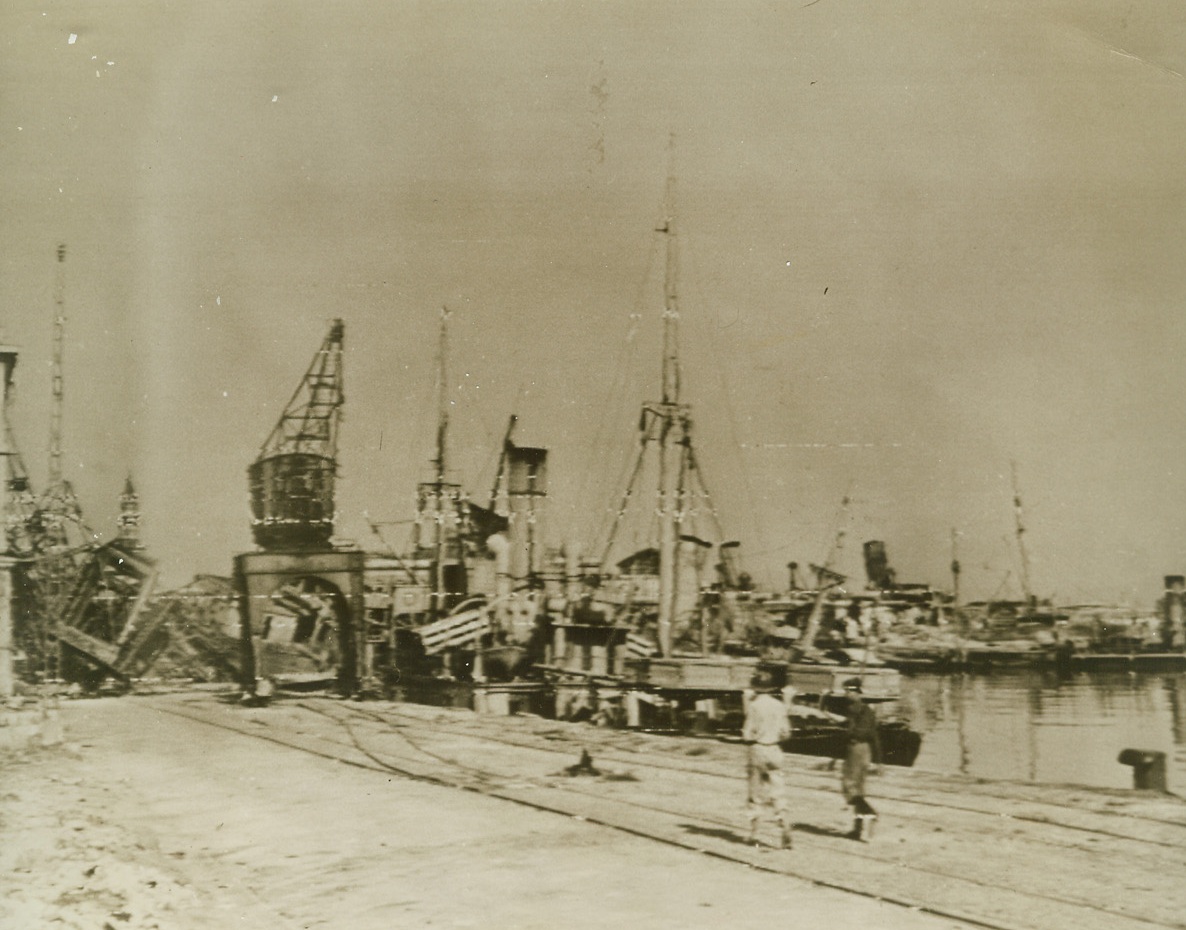
Wrecked Naples, 10/3/1943. NAPLES, ITALY—Accompanied by a Naples policeman, an American soldier sets out to examine ship wreckage in the Italian city’s once-proud and beautiful harbor. Fleeing Germans destroyed as many of the city’s harbor installations and ships docked where as they could, before they fled. Credit: Photo by Charles Corte, ACME PHOTOGRAPHER FOR WAR POOL, ACME.;
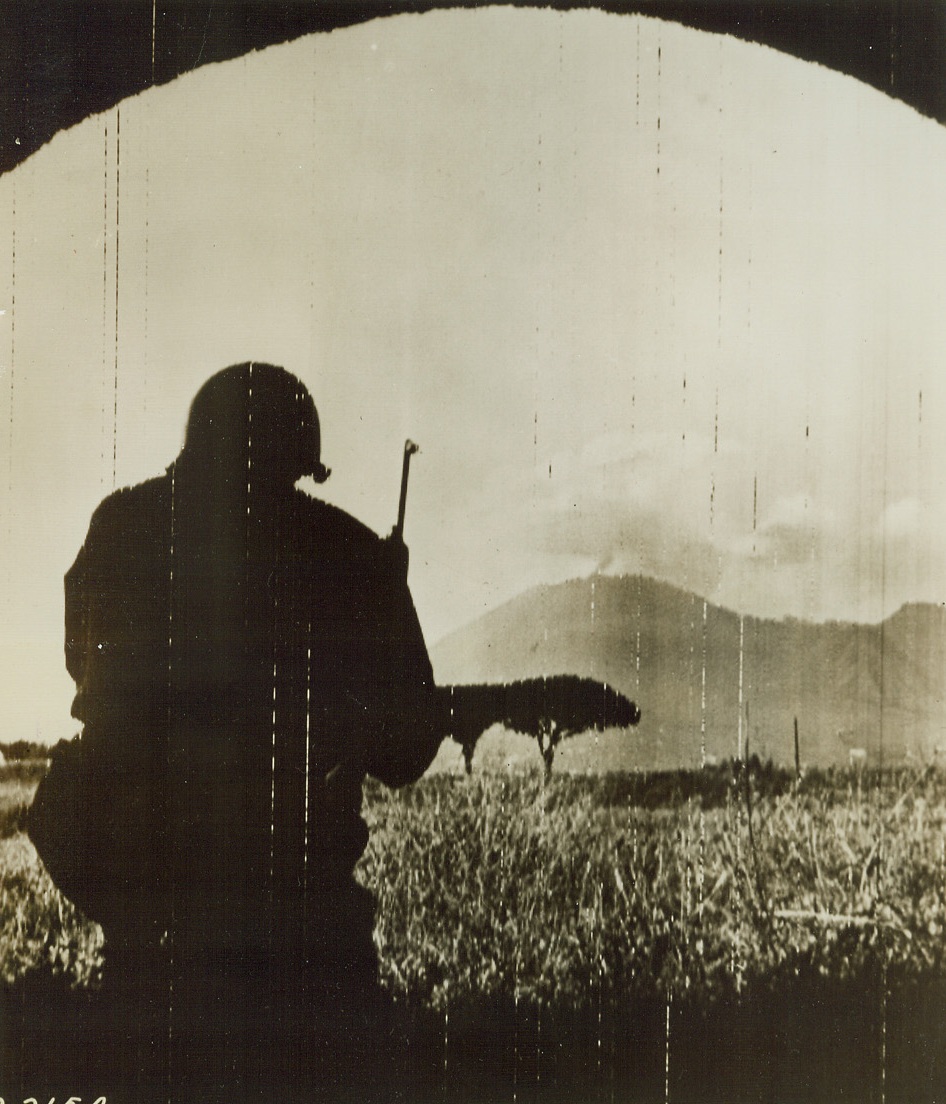
Yank Looks Toward Vesuvius, 10/3/1943. ITALY—Silhouetted in an ancient archway, among the ruins of Pompeii, an American soldier looks toward Mt. Vesuvius. Not far from his observation post, the famous old volcano spouts its eternal smoke. Credit: Photo by Charles Corte, ACME War Pool Photographer, via U.S. SIGNAL CORPS RADIOTELEPHOTO, FROM ACME.;
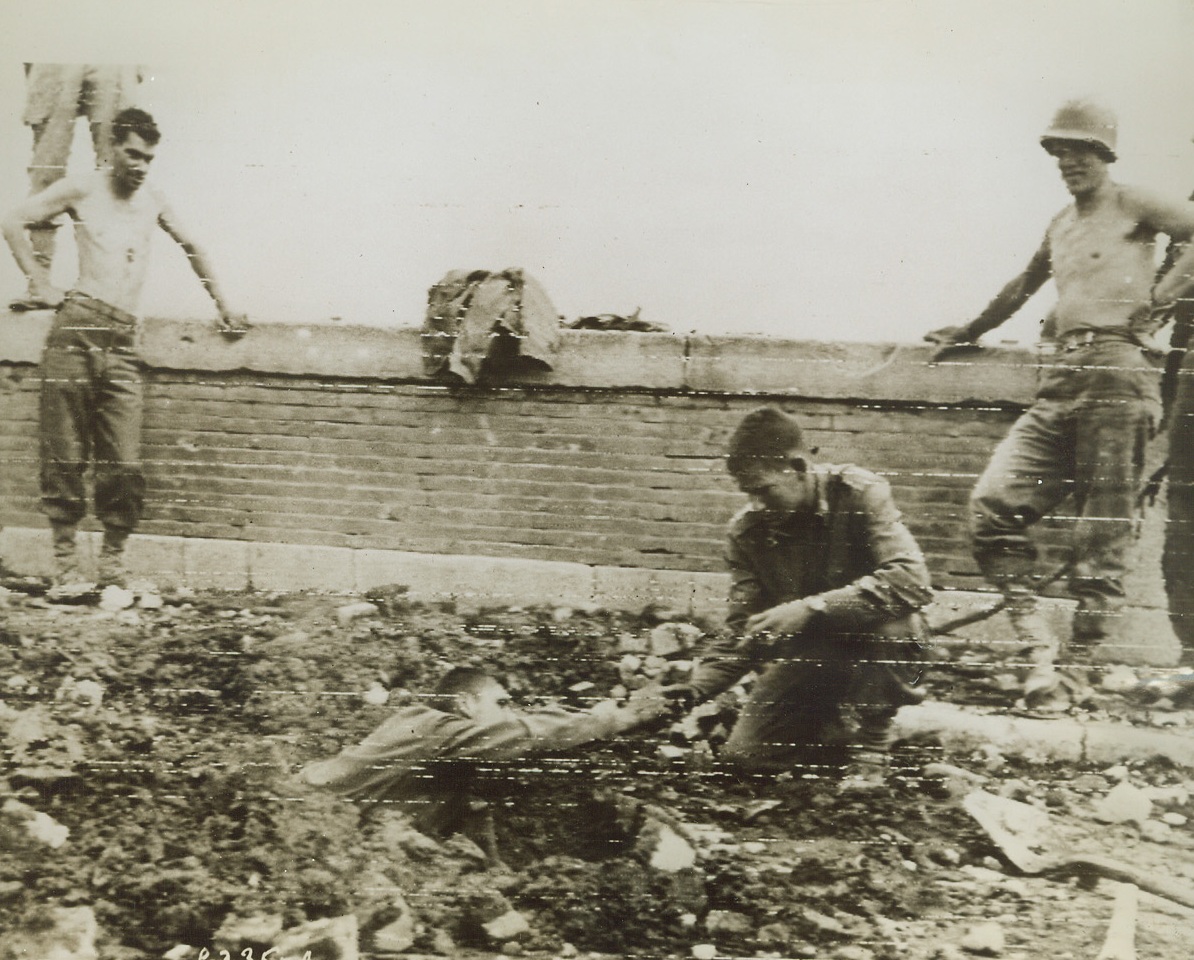
Lucky Break, 10/13/1943. ITALY—Pvt. James J. Edwards, of Jamaica, L.I. passes an unexploded charge of TNT to Lt. Keith G. Gladfelter, of Mt. Vernon, Washington. The Nazis planted the explosive to blow up the bridge, but fled the Benevento area before they could finish the job. Both are members of the U.S. engineering division. Credit: U.S. ARMY SIGNAL CORPS RADIOTELEPHOTO FROM ACME.;
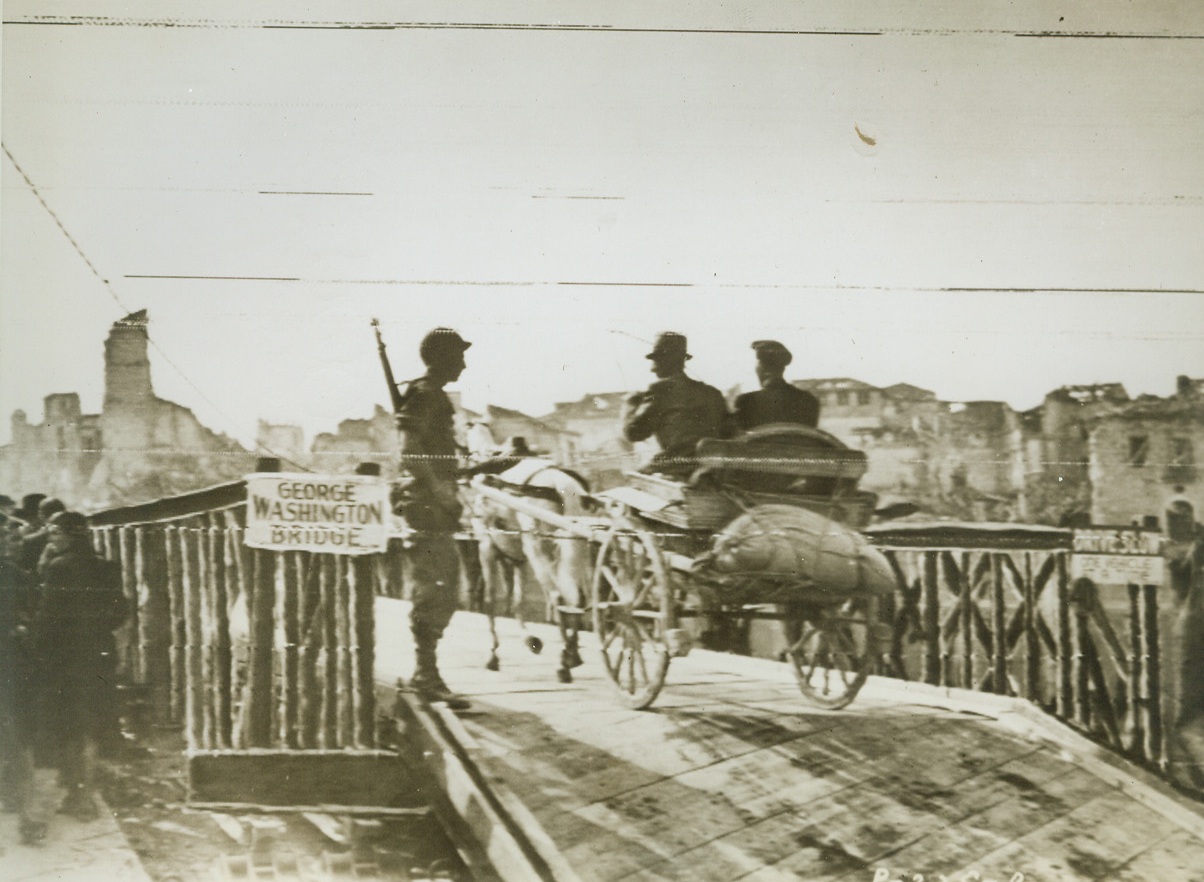
“George Washington Bridge” in Italy, 10/13/1943. BENEVENTO, ITALY—Pvt. Jerry of Santo Rosa, Calif., stands guard over the G.I. version of the George Washington Bridge in Italy. Engineers built the span, to replace one wrecked by retreating Nazis, across a river north of Benevento. Credit: U.S. SIGNAL CORPS RADIOTELEPHOTO-ACME;
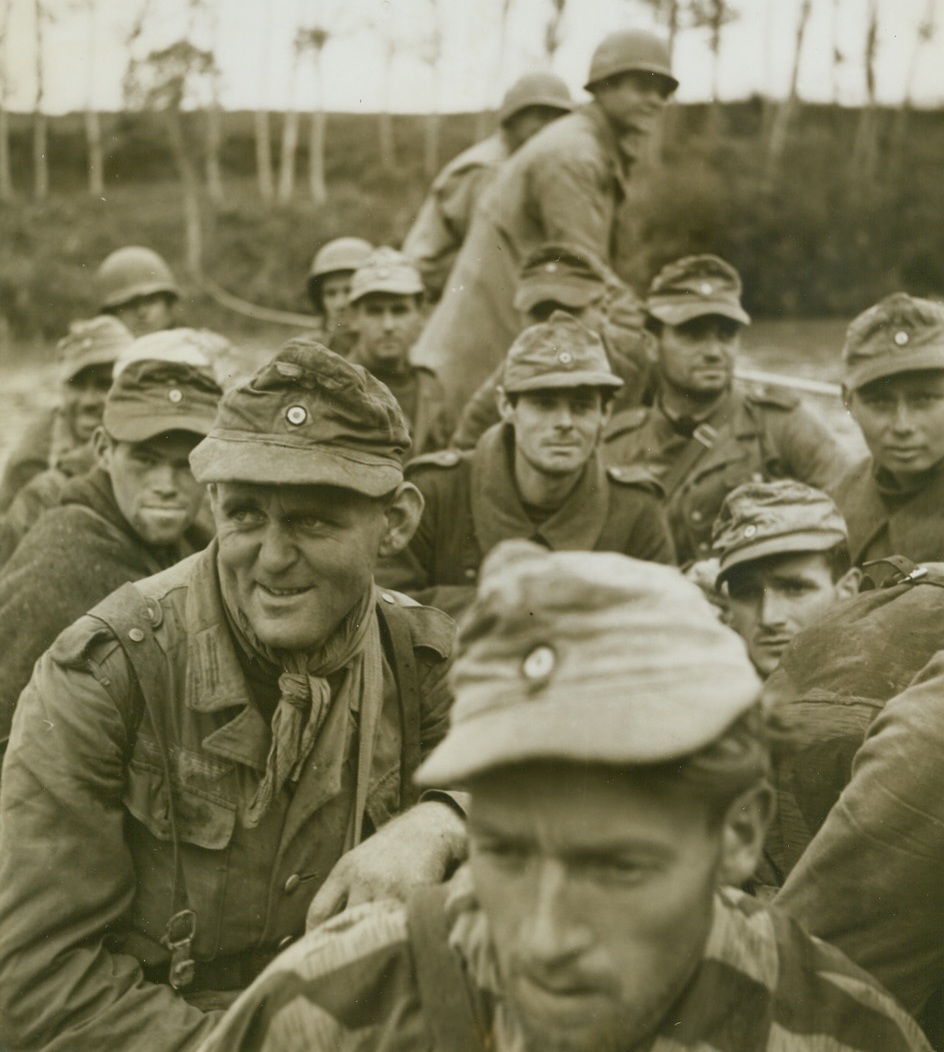
NO FERRYING CHARGE, 10/25/1943. ITALY—Some of these Nazi prisoners look as if they were crossing the River Styx instead of the Volturno, while others seem glad of the “ferry” ride which leads to internment. American soldiers guard the Nazis who are some of Herman Goering’s crack Panzer Grenadiers and the first prisoners taken by the Allies in the sector, being captured less than a mile from the Italian river.Credit: Acme photo by Bent Brandt, War Pool Correspondent;
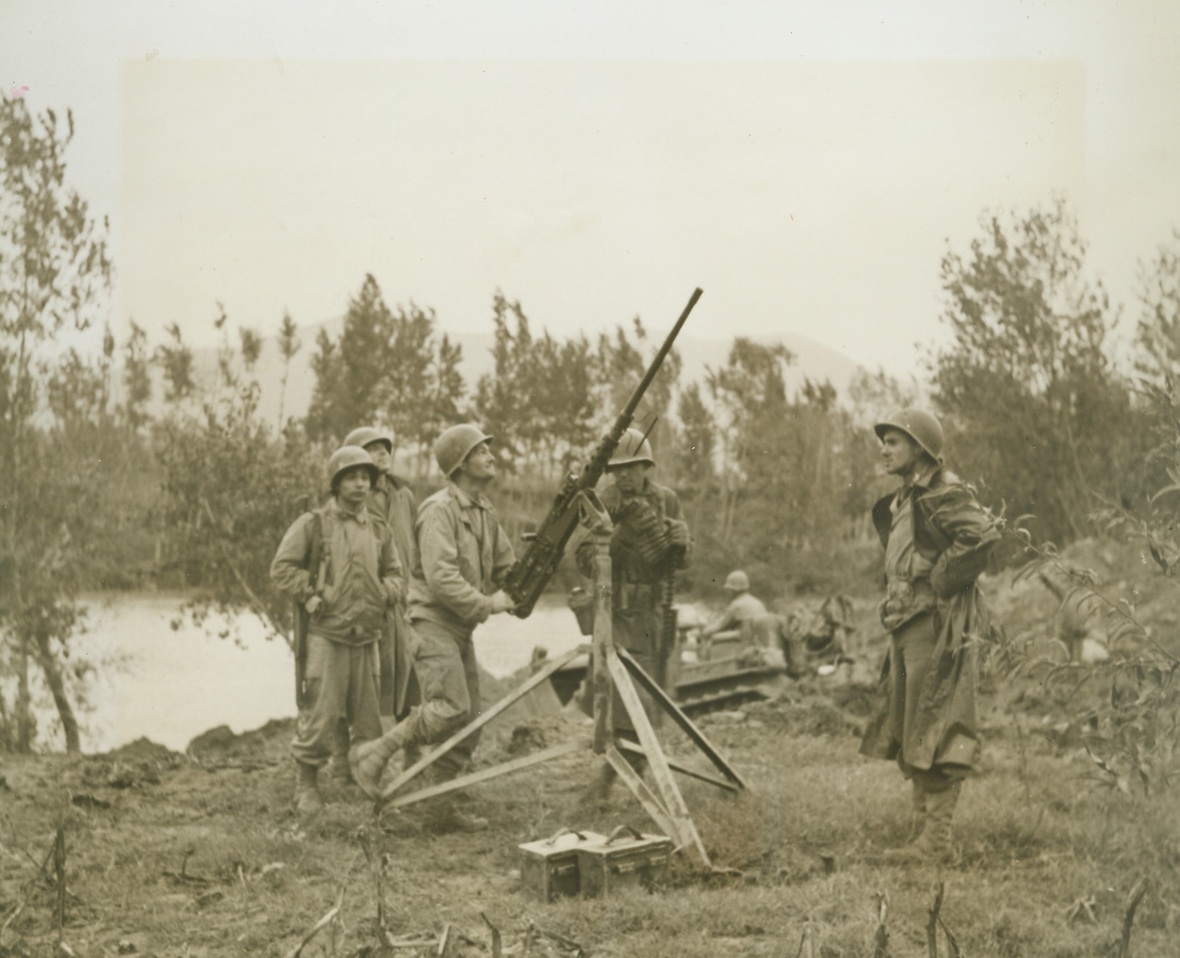
NAZI HOPES DROWNED IN THE VOLTURNO, 10/25/1943. . William George, Rensselaer, Ind. (behind gun); ITALY—When 5th Army troops splashed, paddled or swam across the Volturno, more than a river was lost to the Germans. The Nazis learned in blood that their natural barrier defense system wouldn’t work. To further consolidate this message of Axis defeat, crack American engineers immediately floated a pontoon bridge across the shallow river so that heavy Allied equipment could rumble on the heels of the advanced infantry forces who had begun the job of dislodging the enemy. These photos tell the story of that bridge which, in reality, may be called a road to victory in Italy for the Allies. NEW YORK BUREAU An anti-aircraft gun crew guards against enemy raiders as bulldozers (background) break ground for the bridge approach. Members of the gun crew are (left to right): Pvt. Manuel Ortga, Beeville, Tex., Sgt. John Tomalesky, Cleveland, Ohio; Pvt. James Mize, Reading, Ohio, holding ammunition, and Lt. James Bowman of St. Louis, Mo. Credit: Acme photo by Bert Brandt, War Pool Correspondent;
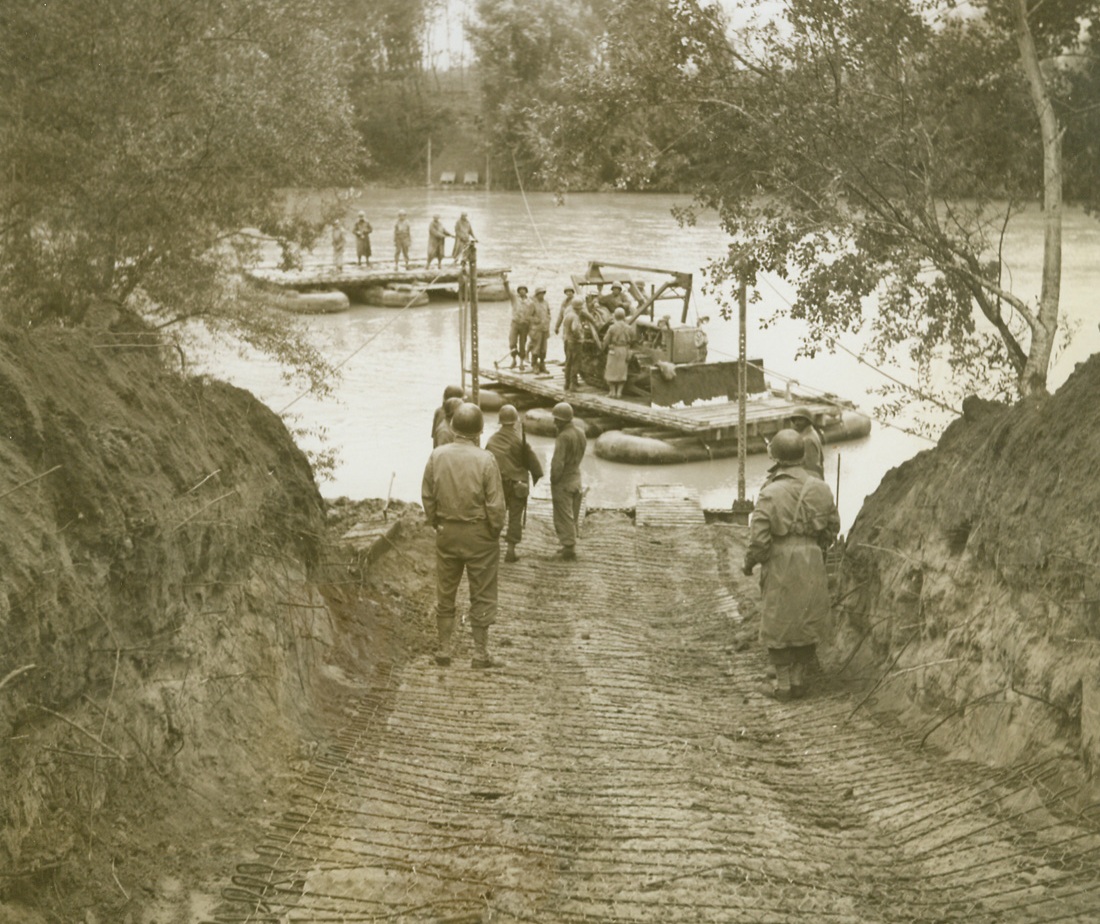
Nazi Hopes Drowned In The Volturno, 10/25/1943. ITALY—When 5th Army troops splashed, paddled or swam across the Volturno, more than a river was lost to the Germans. The Nazis learned in blood that their natural barrier defense system wouldn’t work. To further consolidate this message of Axis defeat, crack American engineers immediately floated a pontoon bridge across the shallow river so that heavy Allied equipment could rumble on the heels of the advanced infantry forces who had begun the job of dislodging the enemy. These photos tell the story of that bridge which, in reality, may be called a road to victory in Italy for the Allies. NEW YORK BUREAU A bulldozer (foreground) is ferried across the Volturno while (background) infantrymen of the 5th Army make the crossing via pontoon raft. The building of the bridge eliminated the necessity of the slow ferries for transporting heavy equipment. Credit: Acme photo by Bert Brandt, War Pool Corresponden;
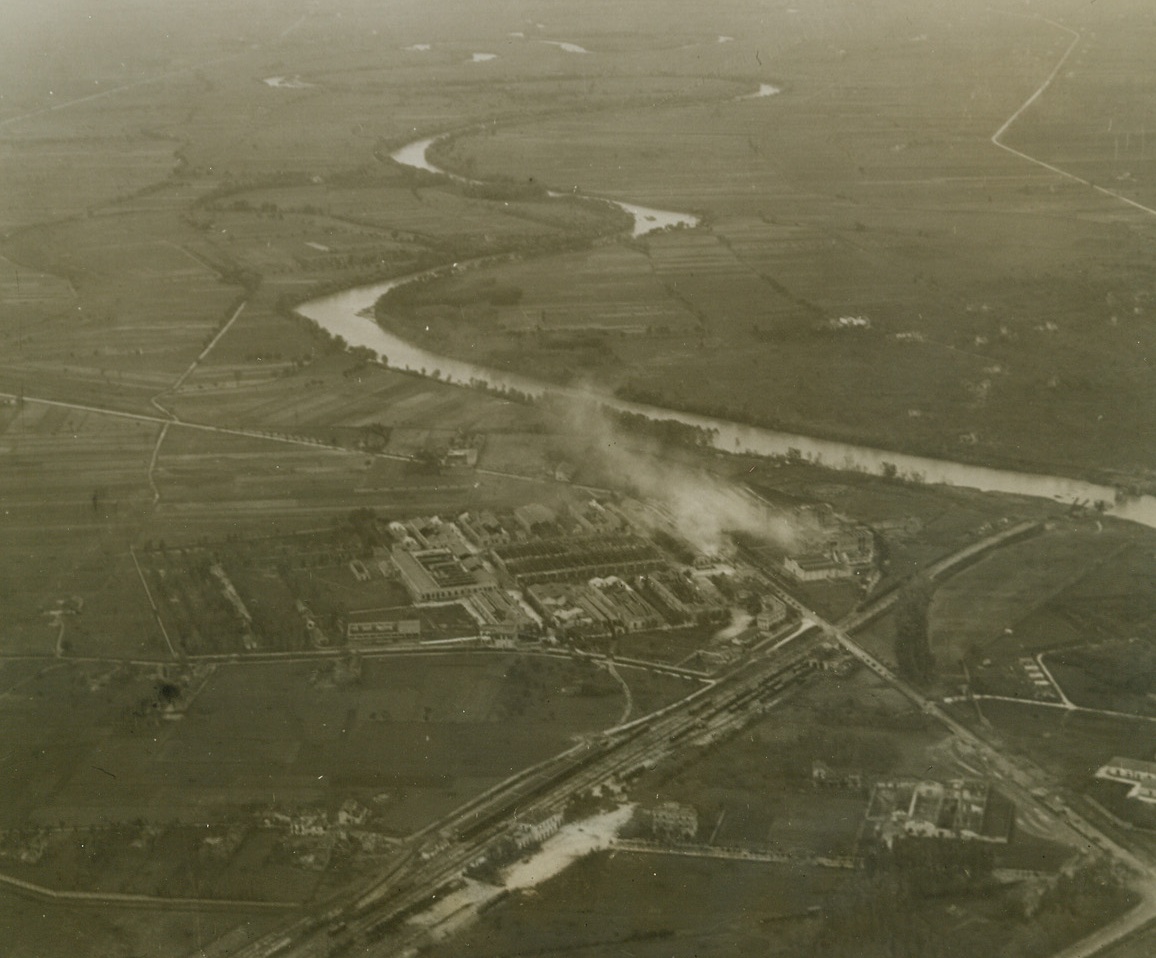
ARTILLERY DUEL ACROSS THE VOLTURNO, 10/25/1943. ITALY—White smoke marks an Axis hit on the British-held town of Capua, during the fierce battle for the Volturno. In the background, that river follows a corkscrew path which was once spanned by bridges destroyed by the Germans. This photo was made from an artillery reconnaissance Piper Cub flying between 2,000 and 3,000 feet over Axis and Allied lines. Credit: Acme photo by Charles Seawood, War Pool Correspondent;
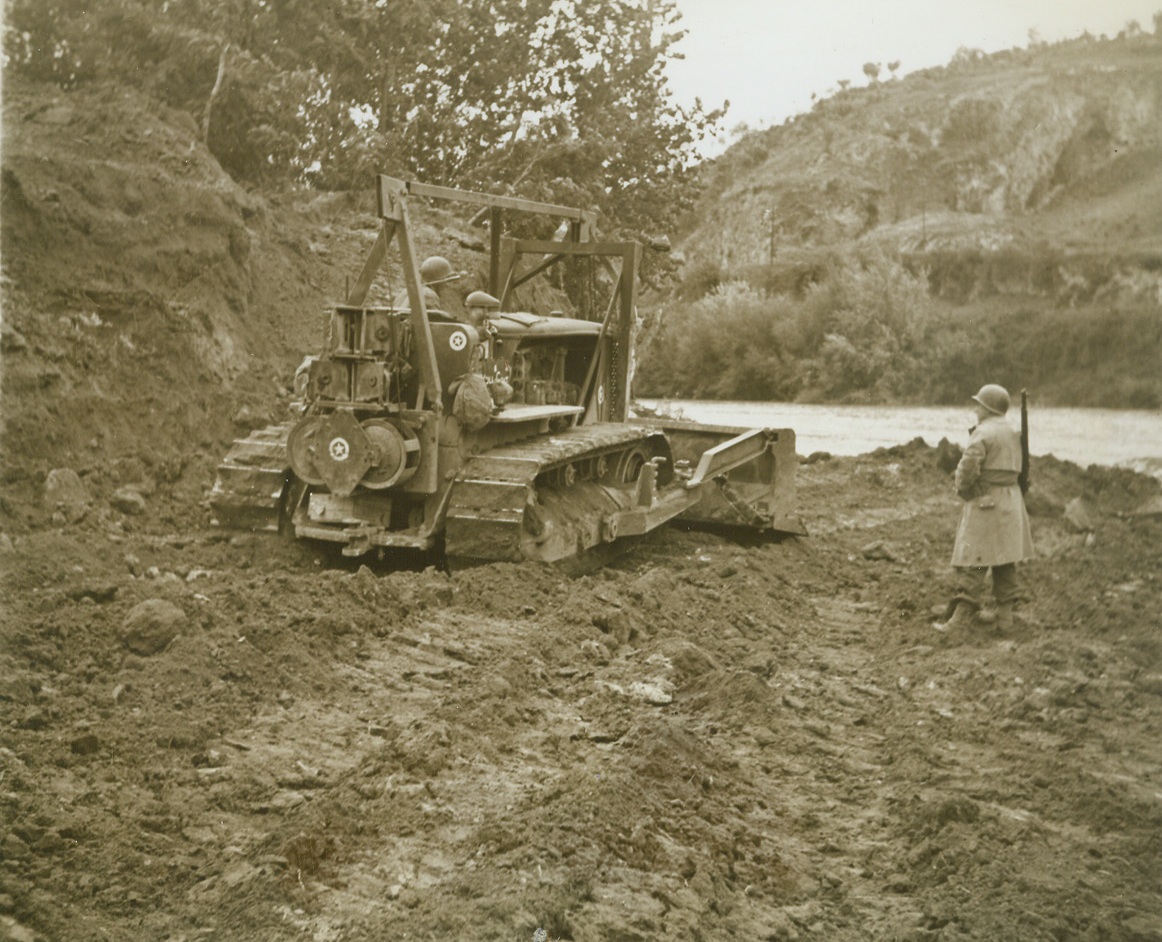
NAZI HOPES DROWNED IN THE VOLTURNO, 10/25/1943. ITALY—When 5th Army troops splashed, paddled or swam across the Volturno, more than a river was lost to the Germans. The Nazis learned in blood that their natural barrier defense system wouldn’t work. To further consolidate this message of Axis defeat, crack American engineers immediately floated a pontoon bridge across the shallow river so that heavy Allied equipment could rumble on the heels of the advanced infantry forces who had begun the job of dislodging the enemy. These photos tell the story of that bridge which, in reality, may be called a road to victory in Italy for the Allies. NEW YORK BUREAU A caterpillar tractor makes grade for tanks to the edge of the Volturno River (background). Credit: Acme photo by Bert Brandt, War Pool Corresponden;
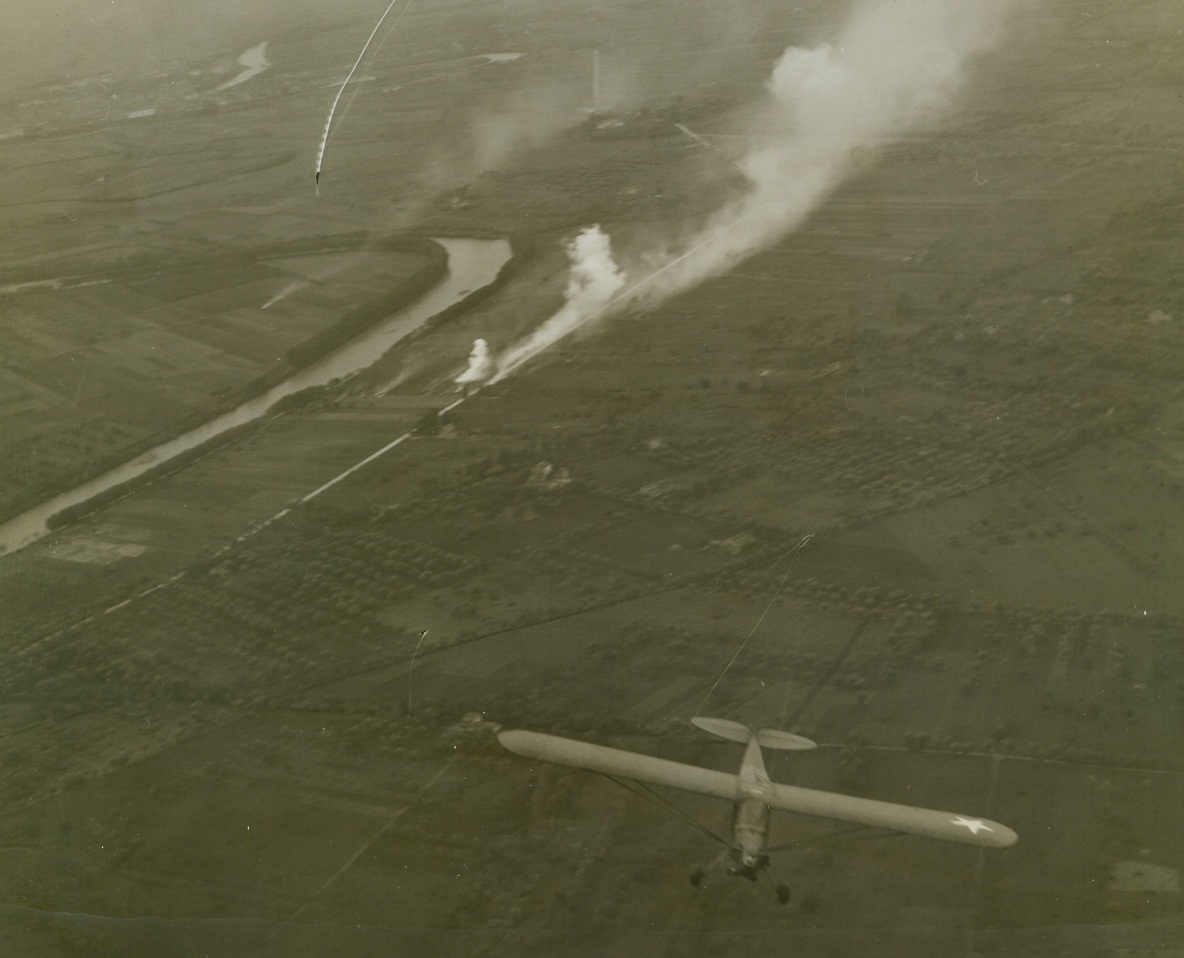
SMOKE CLOUDS THE VOLTURNO, 10/25/1943. ITALY—As artillery fire from American lines lays down a protective smoke screen to shroud coming troop movements (foreground), a different sort of smoke is visible on the Axis side of the Volturno as a result of Allied shelling. The Piper Cub is on artillery reconnaissance over German lines. Acme war photographer Charles Seawood made this aerial photo from another dub, flying between 2,000 and 3,000 feet. Credit: Acme photo by Charles Seawood, War Pool Photographer;
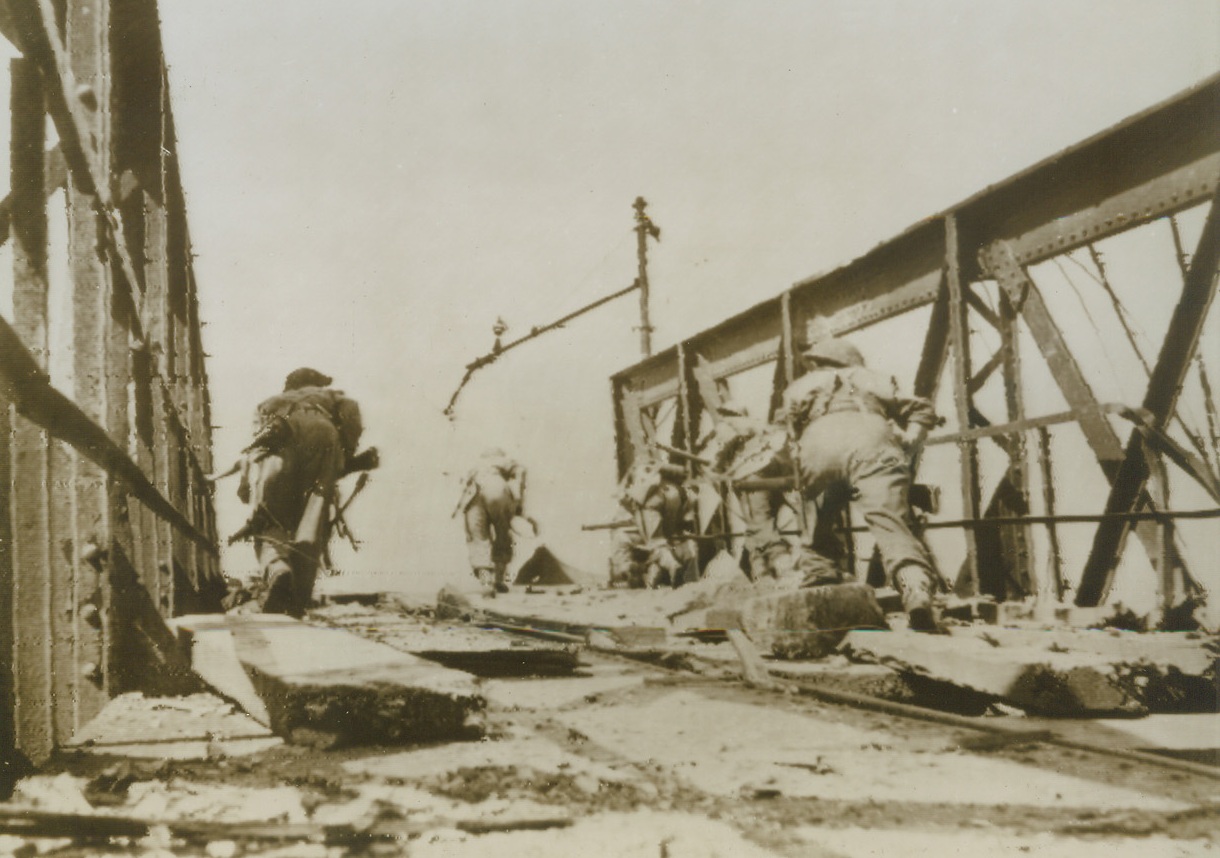
BRITISH WAVE CROSS THE VOLTURNO, 10/26/1943.CANCELLO, ITALY—Bending low and with their guns held ready for instant use, British infantrymen dash across the blasted railway bridge over the Volturno River to enter Cancello, in this photo flashed to New York by radio today. It was announced today that the Allied 5th and British 8th armies had advanced up to six miles and had taken 10 more towns. Credit: British Army via OWI Radiophoto from Acme;
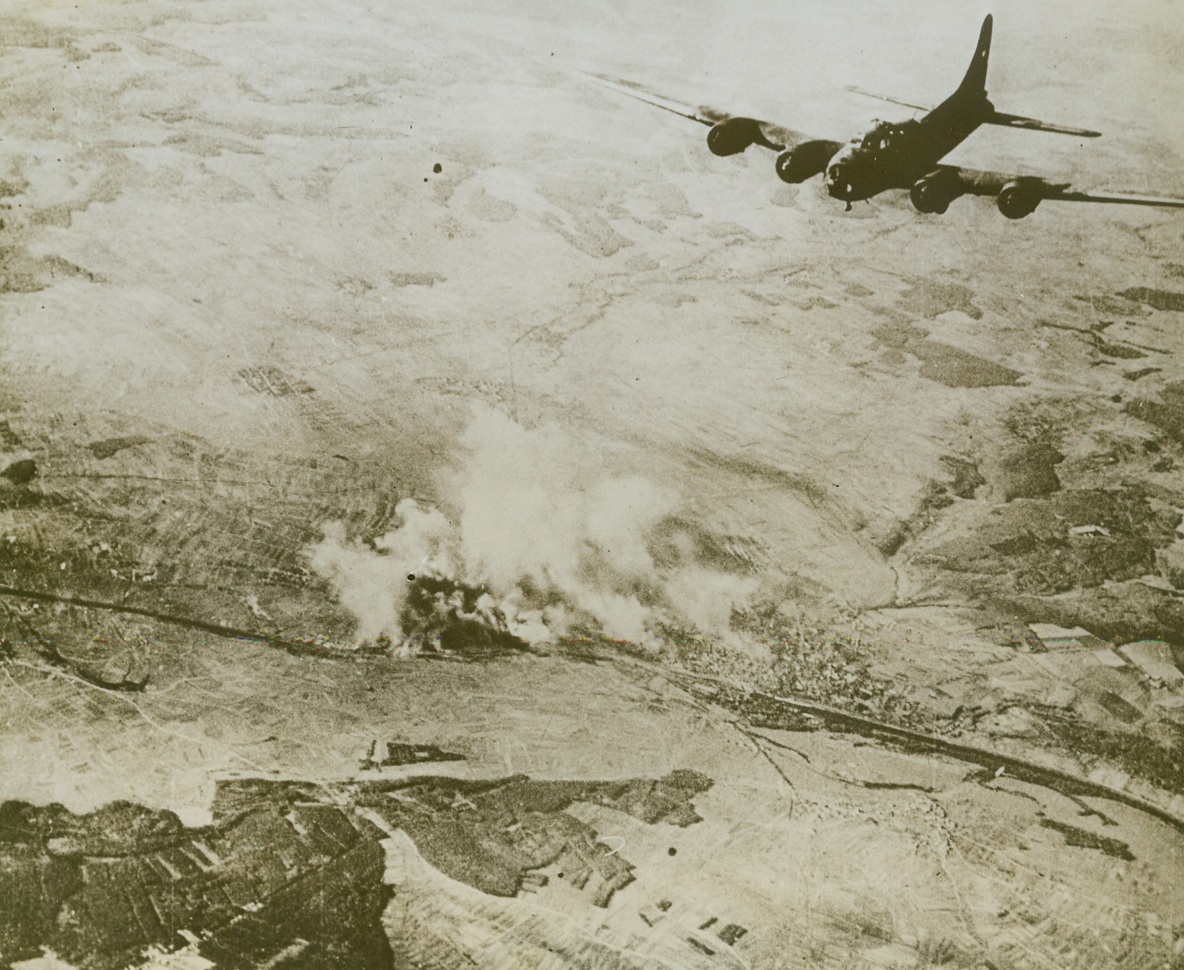
YANKS CRIPPLE ANOTHER NAZI INDUSTRY, 10/26/1943. This photo, just released in Washington, shows the important ball bearing producing city of Schweinfurt, Bavaria, in flames after a heavy raid last Oct. 14th by Flying Fortresses of the U.S. 8th Air Force. The factories, producing this most important part of Hitler’s war machine, were left in ruins. To indicate the size of the raiding force, 60 Fortresses were lost—only a fraction of the number of planes taking part. Yank gunners in the Forts and the P-47 Thunderbolts that accompanied them part of the way, shot down 99 enemy fighter planes, with 26 probables and 17 damaged. Credit: U.S. Army Air Forces photo from Acme;
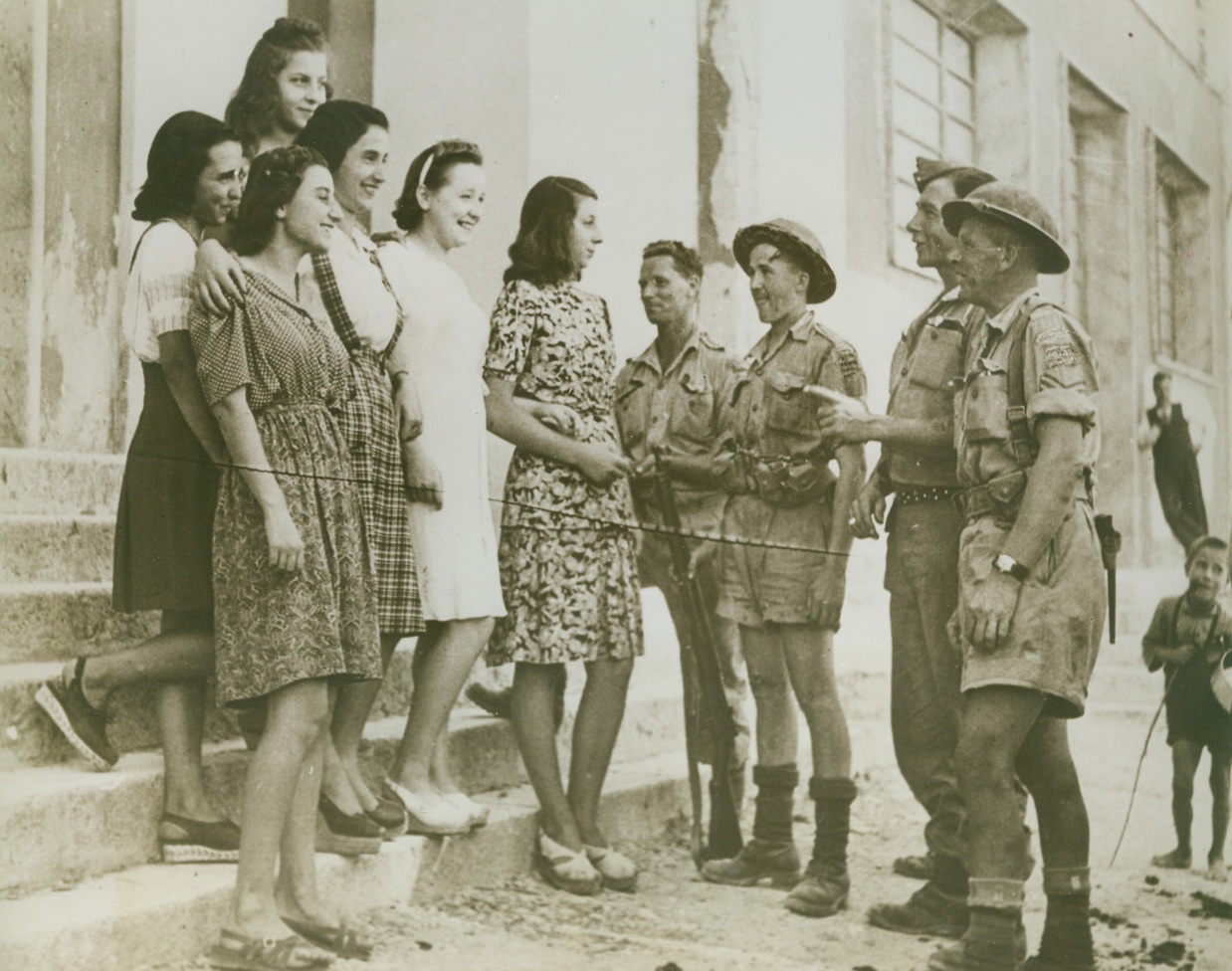
CANADIANS MEET SENORINAS, 10/29/1943. ITALY—Senorinas of the Italian town of Avigliano shine up to a Canadian street patrol. Canadians, left to right, are Pte. W. B. Campbell, Rolla, B.C.; Pte. C. E. White and Cpl. J. M. Frew, both of Edmonton. Fourth man is unidentified. Credit: Acme;
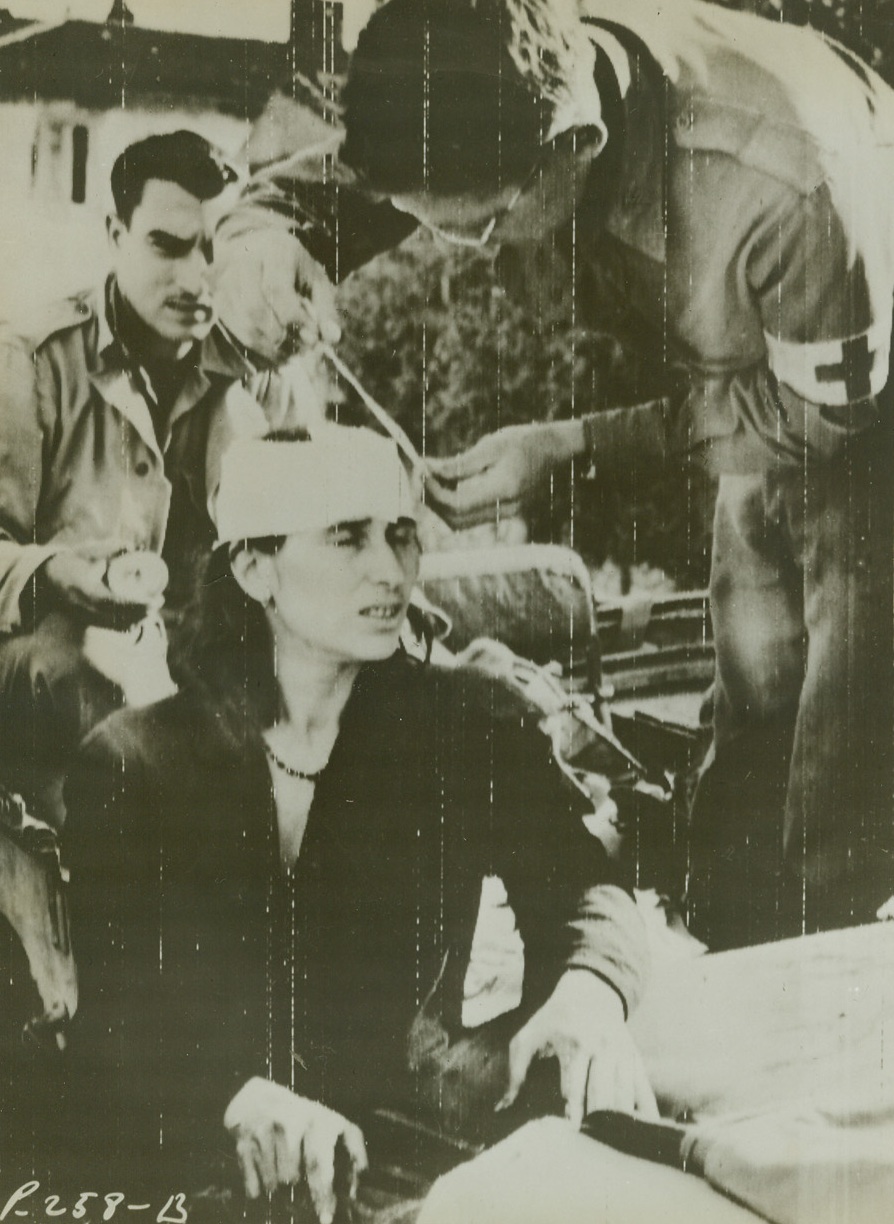
ITALIAN CIVILIAN CASUALTY TREATED, 10/28/1943. SOMEWHERE IN ITALY—Seated in a jeep, this suffering Italian woman is treated for a head injury by Capt. Dr. James F. Drye of Louisville, Ky. (R). Pvt. John De Grad of Newton, Iowa, (L) assists him. Credit: Official Signal Corps Radiotelephoto from Acme;
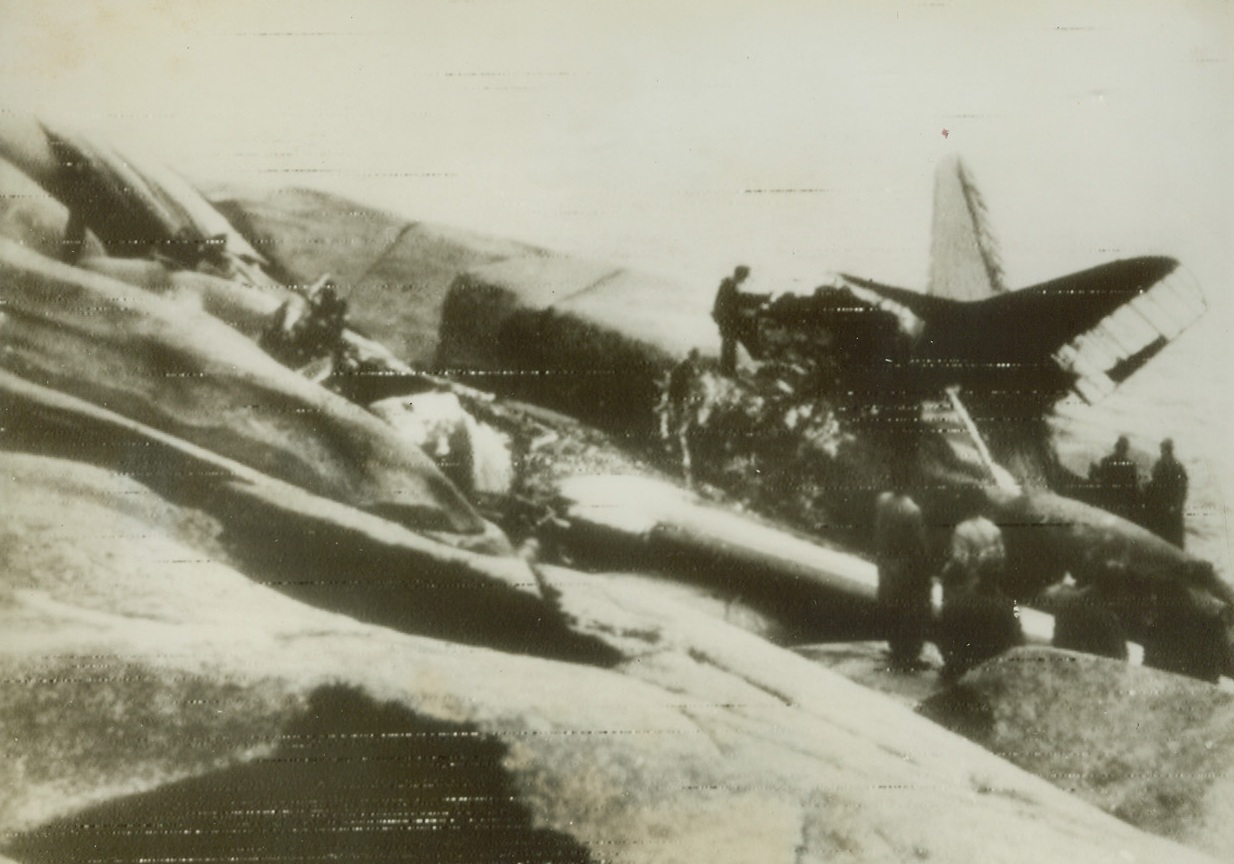
CHECK PLANE WRECKAGE, 10/27/1943. STOCKHOLM, SWEDEN—A special Swedish government commission carefully examines the wreckage of one of its airliners, the Gripen, which crashed in flames on the island of Haalloe recently. The commission is seeking to ascertain whether the plan was shot down by a German war bird. Credit: Acme;
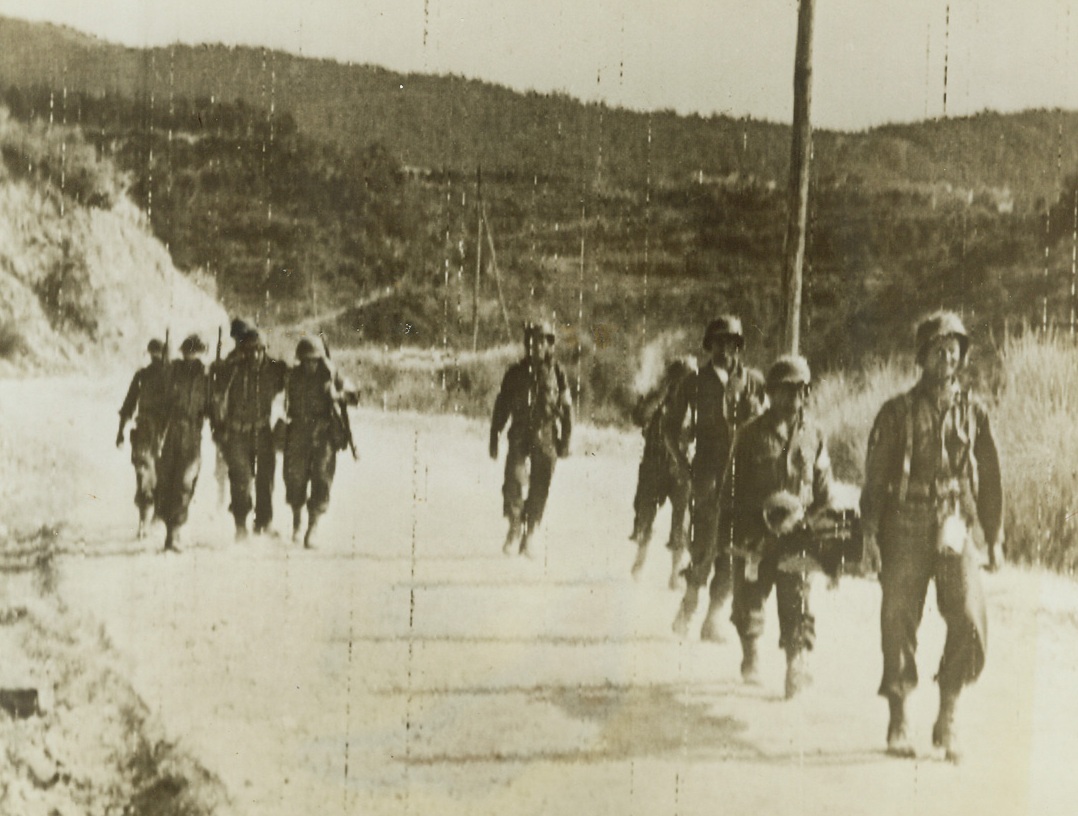
CASUALTIES OF ITALIAN CAMPAIGN, 10/2/1943. ITALY—Members of the U.S. Medical Corps assist and carry injure infantrymen on a two-mile trek to a hospital in Italy. Unavailability of ambulances seems to be the problem here. Credit: Signal Corps radiotelephoto from Acme;
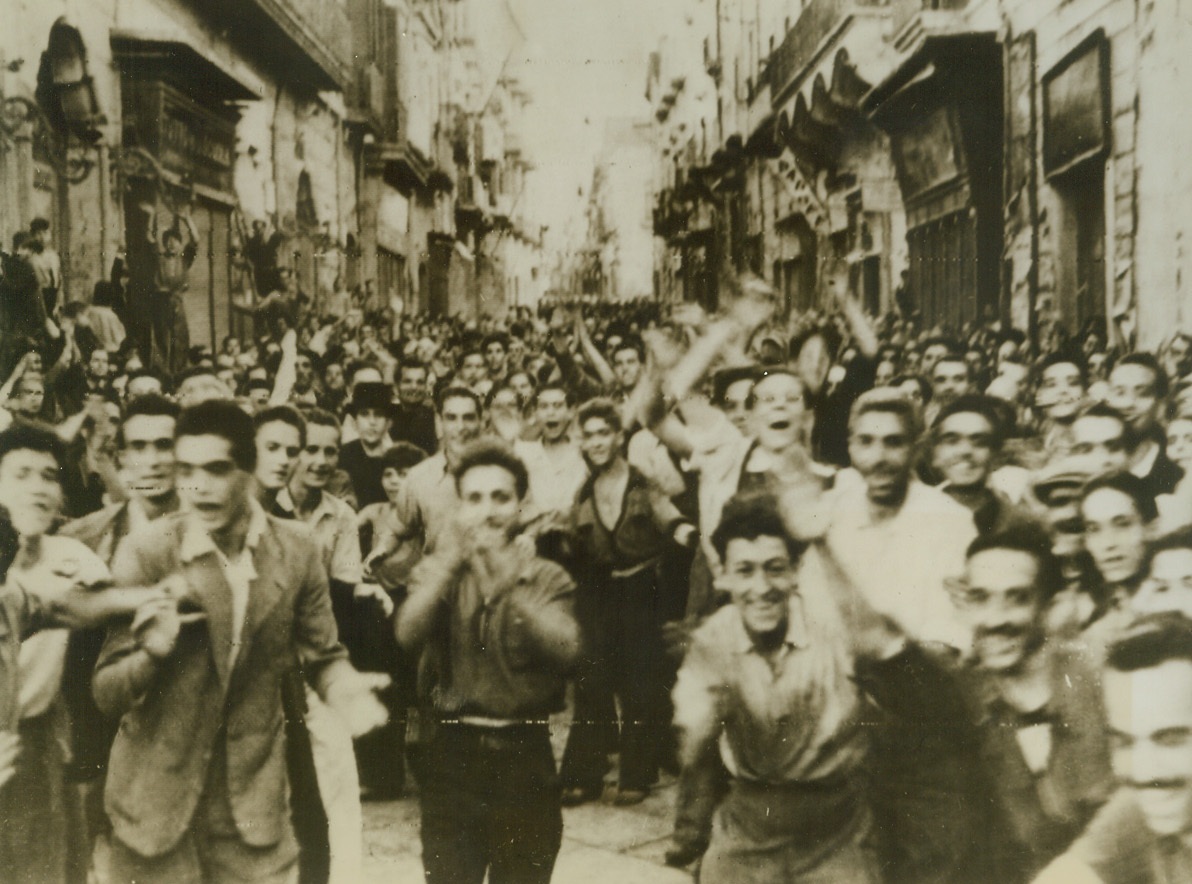
CHEER ALLIES, 10/2/1943. ITALY—This radiophoto just received tonight in New York shows cheering crowds as they greet Allied troops who are entering Torre D’Annunciata, near ancient Pompeii, on their way to Naples. Credit: OWI radiophoto from Acme;
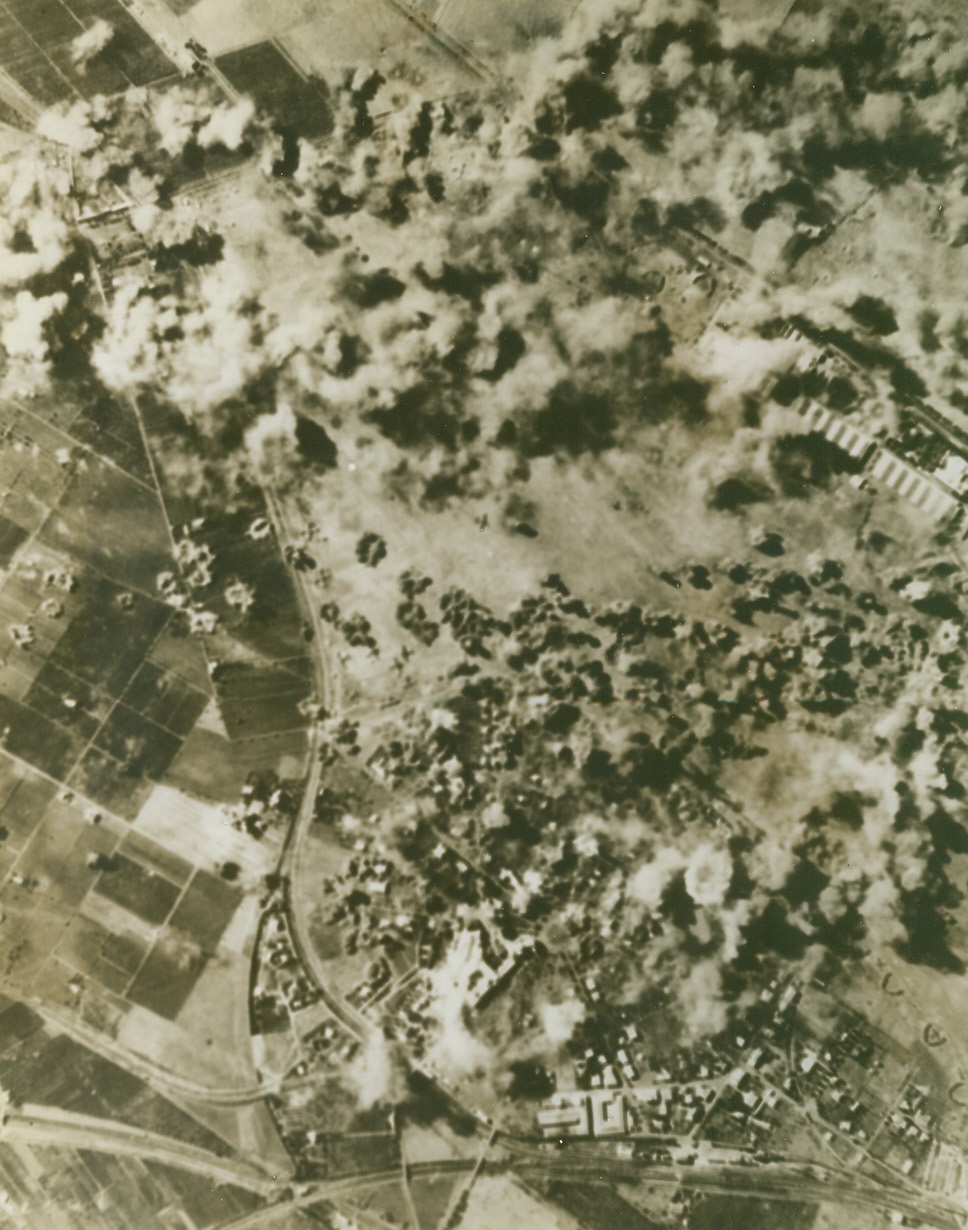
BOMBING AIRFIELD NEAR ROME, 10/2/1943. A surprise attack on Ciampino airfield, south of Rome, by U.S. Army Flying Fortresses of the Northwest African Air Force, caught a large number of Nazi aircraft on the field, and destroyed many of them. Here bomb bursts from the Army raiders cover the airfield. Credit: Army Air Forces photo from Acme;
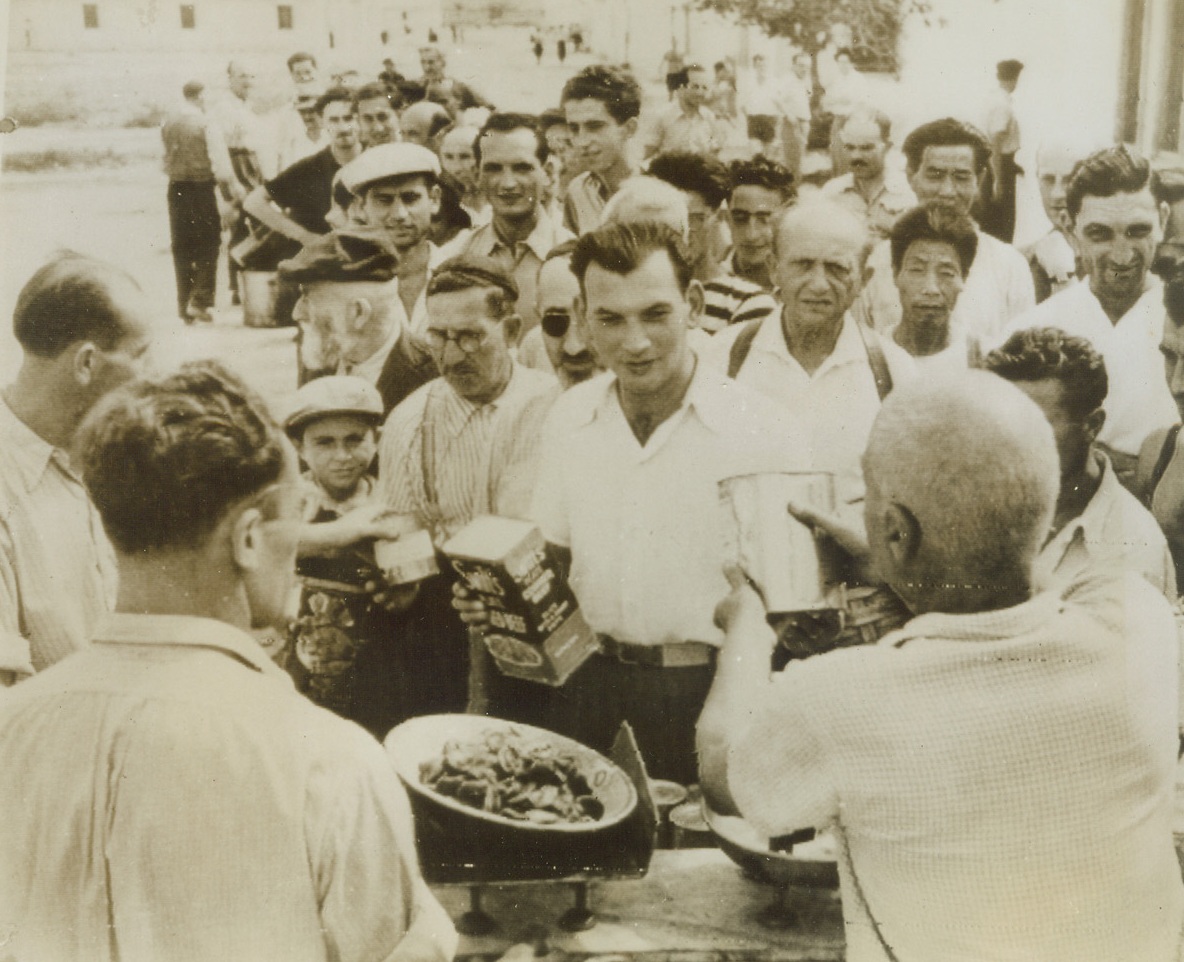
INTERNEES GET AMERICAN FOOD, 10/2/1943. ITALY—Over 1500 German Jews, Poles, Yugoslavs, French, Czechs and a few Chinese were held in barbed wire enclosures at a huge concentration camp near St. Di Barraccano until freed by Allied liberators. Here the internees are issued rations (note American labels) by British 8th Army personnel. Though the internees are freed, they as yet have no homeland to which they can return. Photo radioed tonight to New York. Credit: OWI radiophoto from Acme;
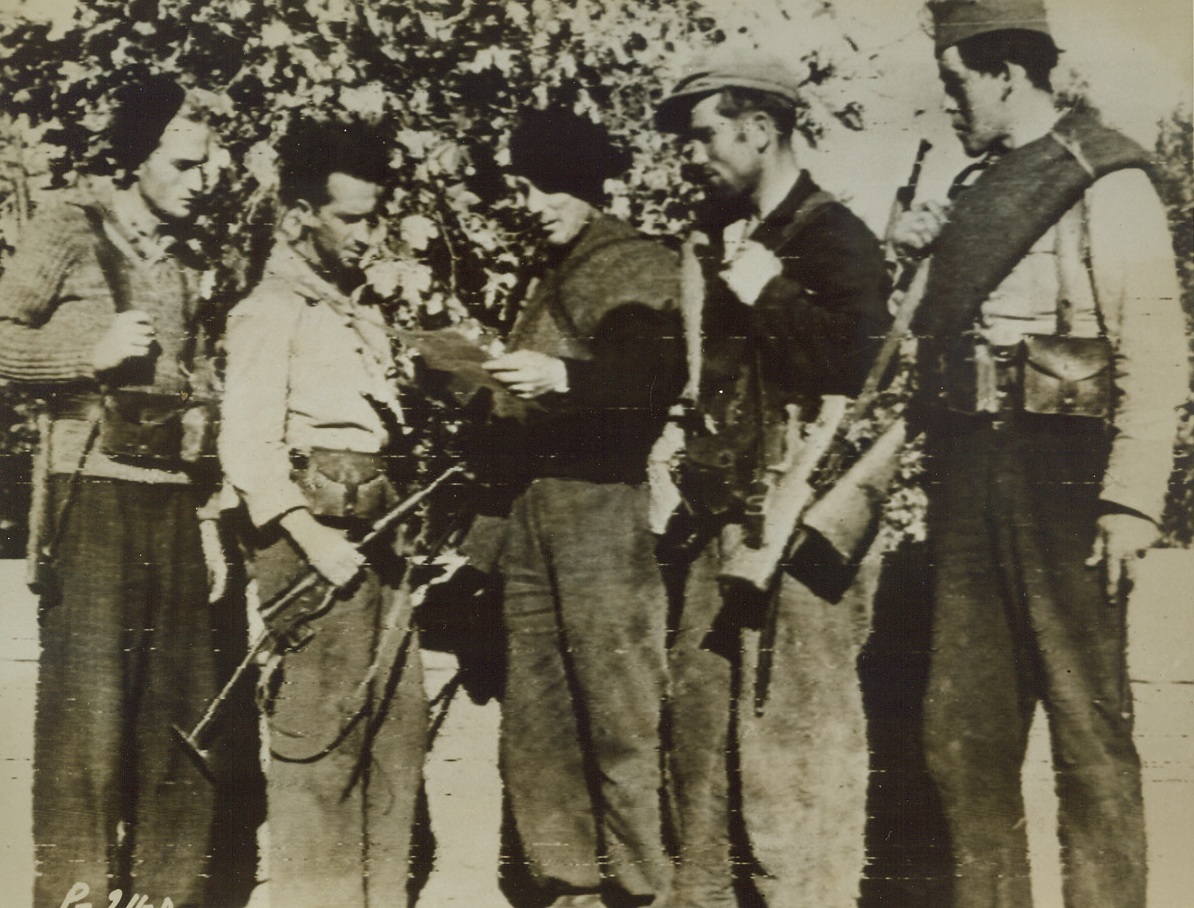
HELPED DRIVE GERMANS FROM CORSICA, 10/2/1943. WASHINGTON, D.C.—This is a group of typical French patriots who have been carrying on guerilla warfare against the Germans on the island of Corsica. They are shown discussing plans of battle. These warriors brought to the island in French ships and right under the noses of the enemy, are well trained and are well aware of the dangers that contront them. Credit: Signal Corps radiotelephoto form Acme;
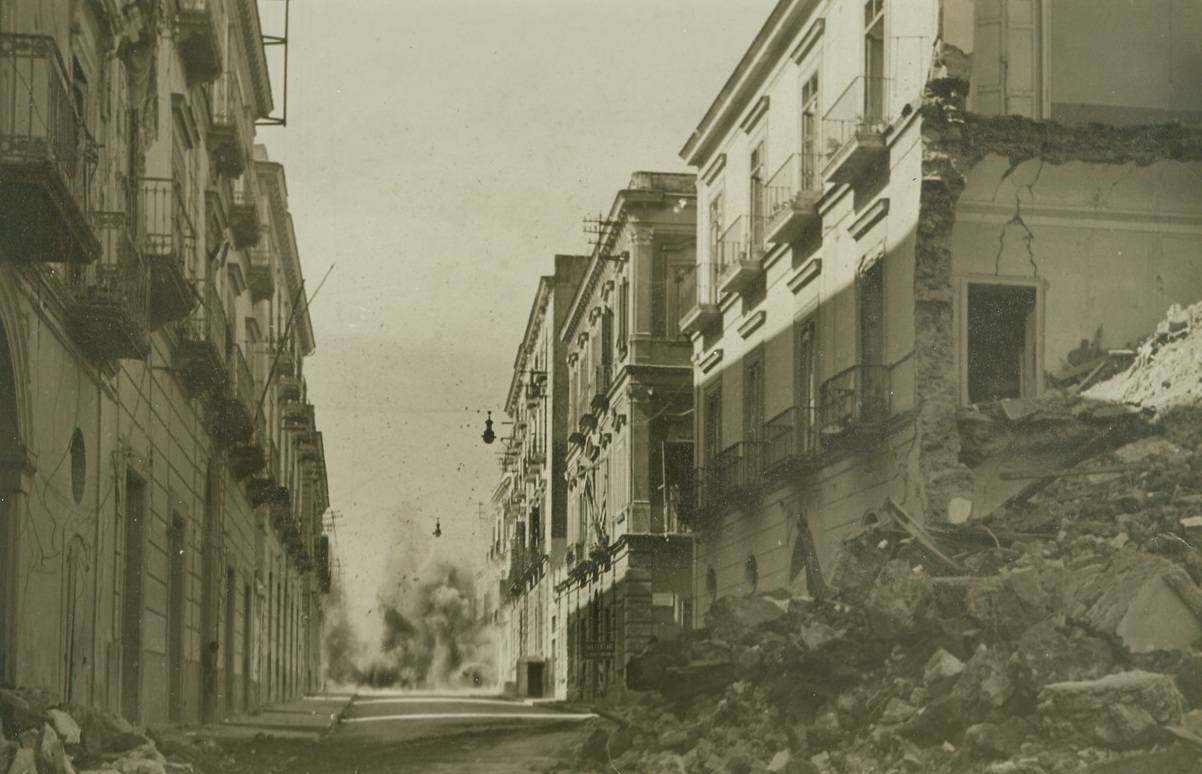
DEAD-END ROAD, 10/11/1943. ALY—A German shell bursts near the edge of Torre Annunziata at the end of a street already banked by war-wreckage. Barely visible, (left) a citizen pokes a cautious head from a doorway to see what “all the shooting is about.” Our advance on Naples was held up by such incidents as these, caused by enemy shelling, mortar bursts and snipers. Credit: Acme photo by Charles Corti, War Pool Photographer;
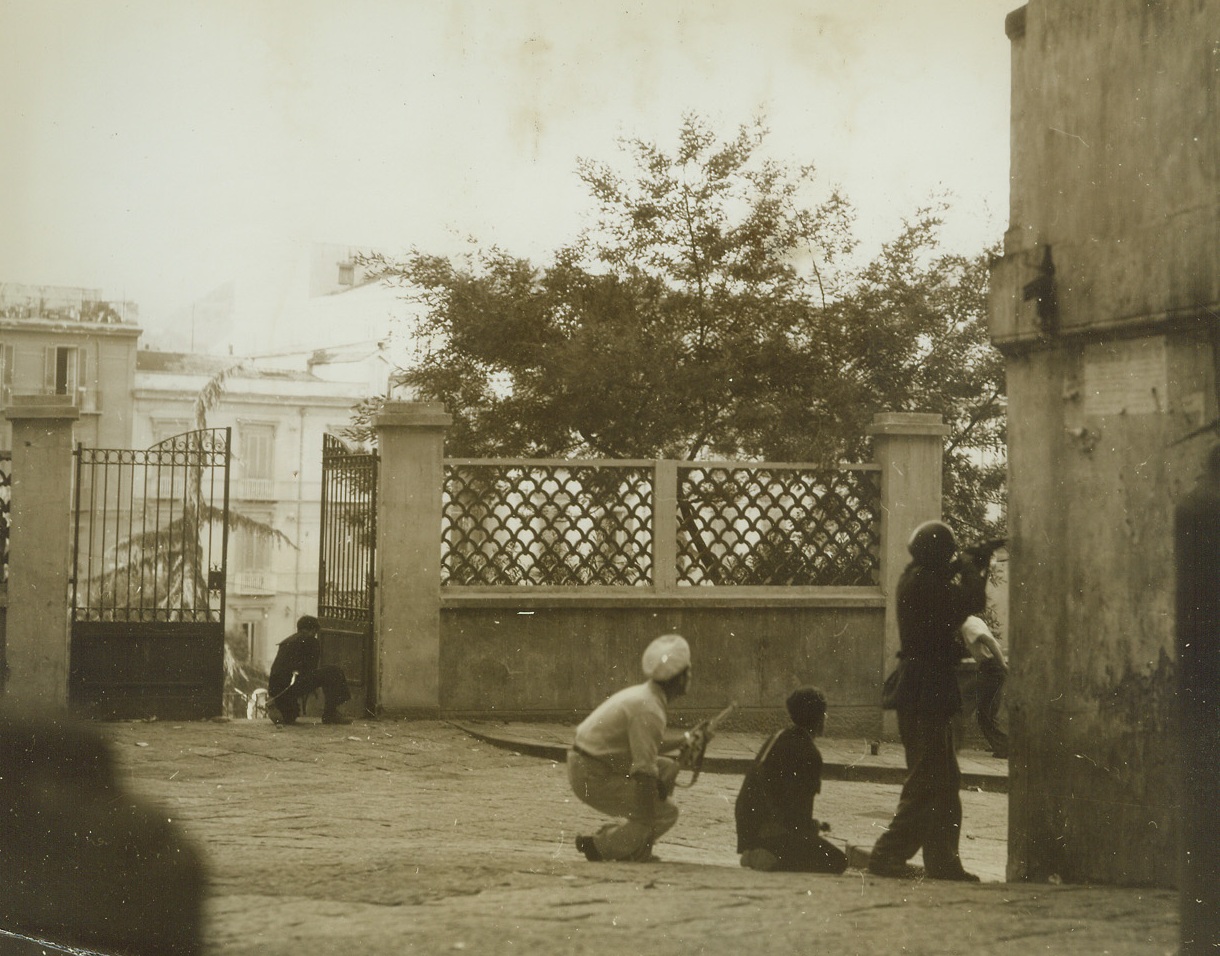
ITALIANS BATTLE NAZIS BEFORE YANKS ARRIVE, 10/9/1943. NAPLES, ITALY—Fearless young Italian guerillas battle Nazis and Fascists in the streets of Naples on October 1st, before the arrival of the American 5th Army. U.S. troops later disarmed the democratic youths who paid dearly for their uprising. Credit: Acme photo by Charles Seawood, War Pool Correspondent;
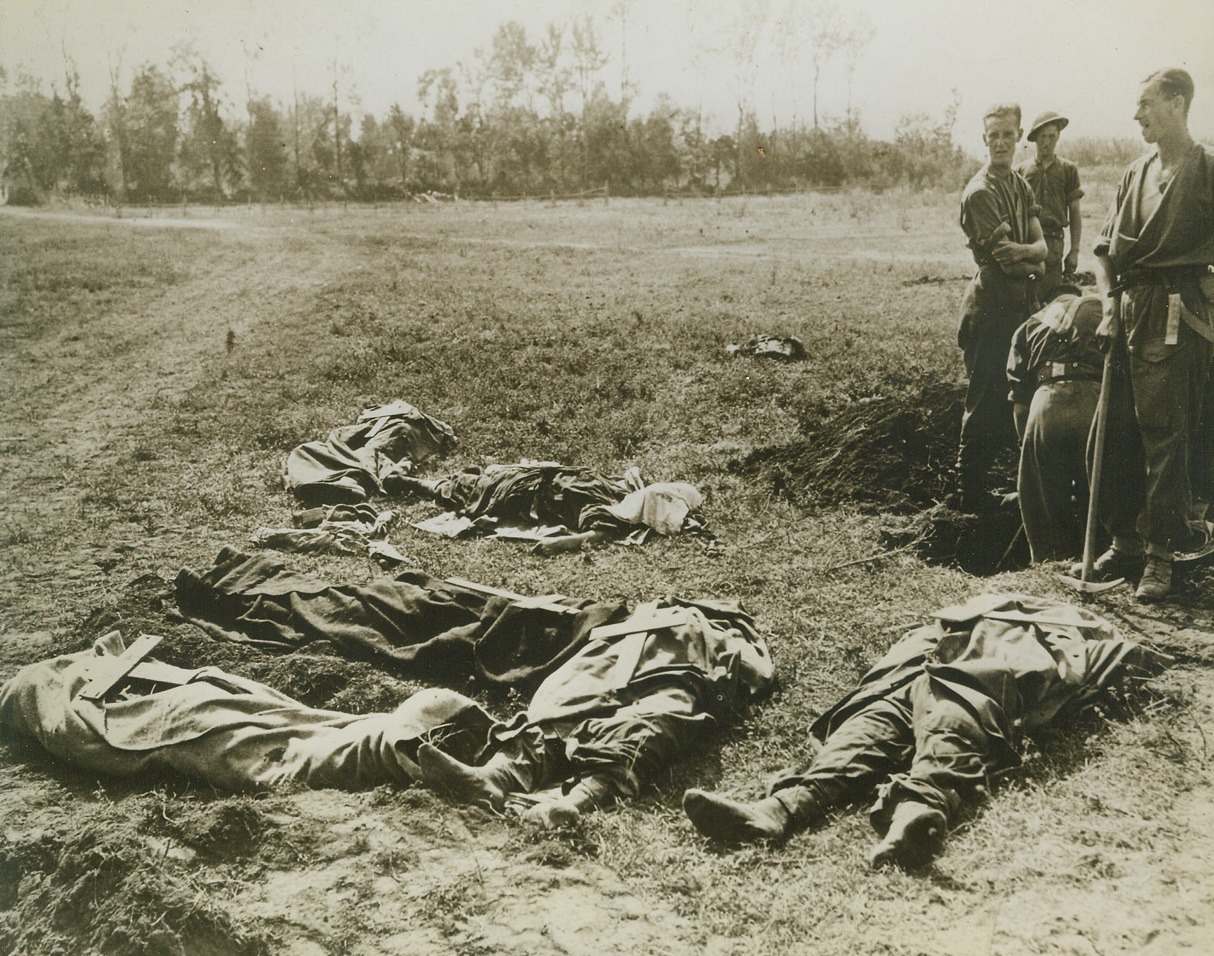
SALERNO IS THEIRS!, 10/9/1943. SALERNO, ITALY—There is a corner of this Italian field that is forever England or America—the final home of these fighting men who battled for Salerno and paid dearly for their prize. Stretched out in formless anonymity, with crude crosses placed upon their bodies, these war dead are buried by their comrades. Credit: Official U.S. Navy photo from Acme;
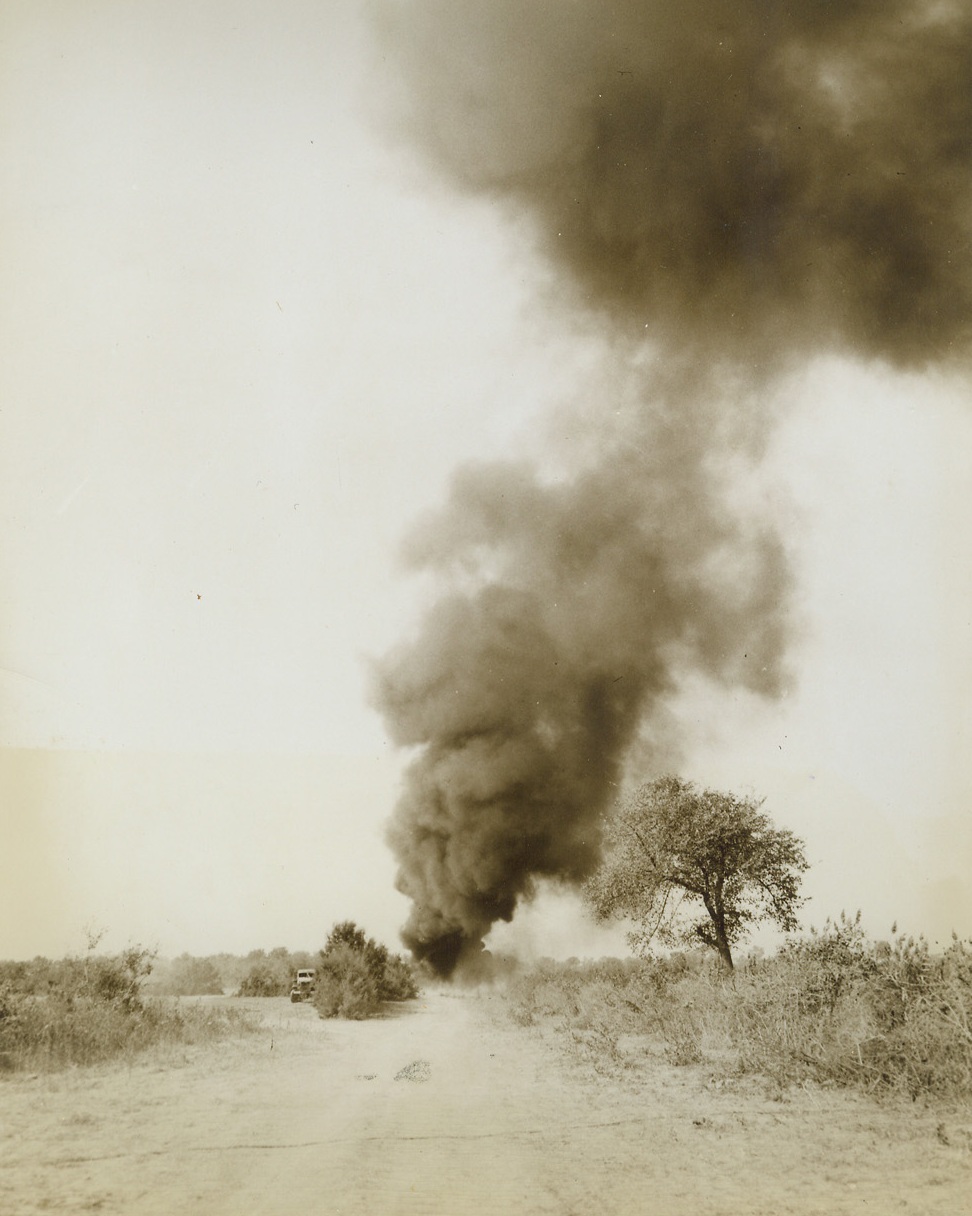
A B-26’S SMOKE, 10/9/1943. ITALY—Returning to an advanced base in Italy after a raid over Naples, a crippled B-26 bomber overshot the field and burst into flames at the end of the runway, sending up a column of heavy black smoke. Miraculously, the entire crew escaped injury and the boys are now ready to fly again. Credit: Photo by Charles Seawood, Acme photographer for War Pool;
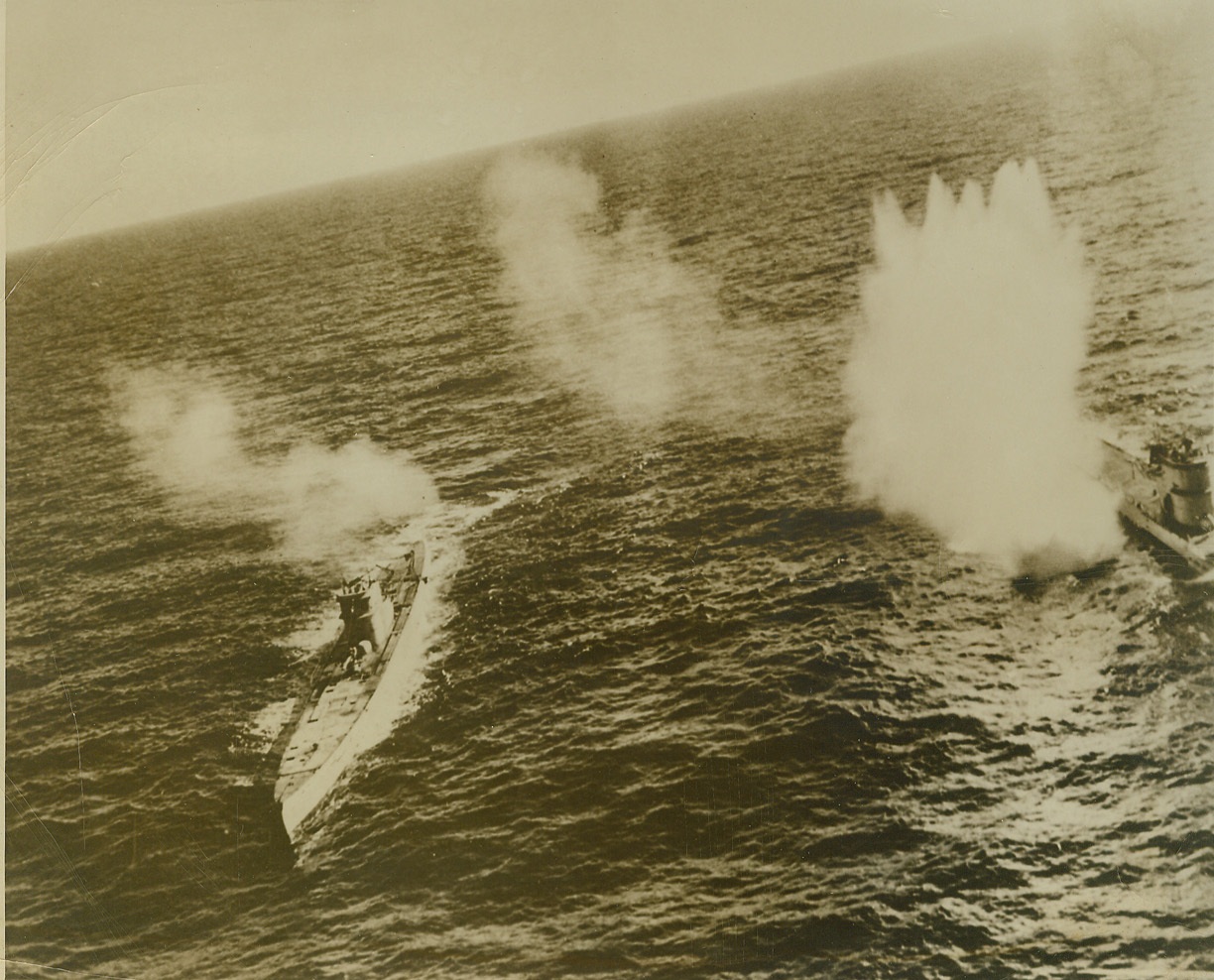
Caught in the Act, 10/22/1943. Apparently just about to attempt a refueling at sea, these two Nazi subs were surprised by depth bombs from a Grumman Avenger torpedo bomber. Attacking both subs single-handed, the pilot planted a depth charge which raises a plume of spray at right. The refueler was believed to be the U-boat at left. Credit: (Official US Navy Photo from ACME);
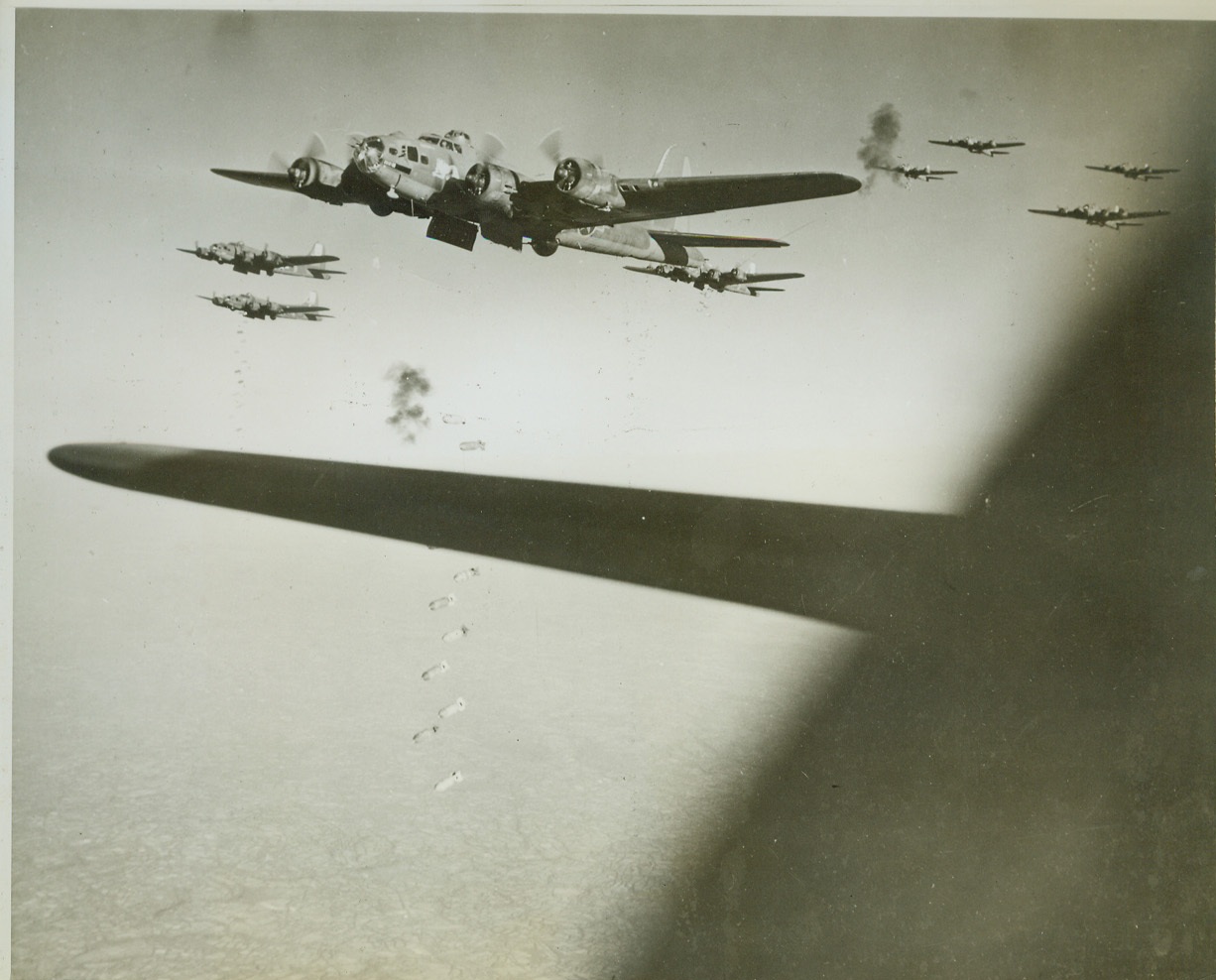
Yank Bombers Raid Nazi Fighter Base, 10/22/1943. GERMANY -- Flak bursts above and below the Fortress in foreground, sending shrapnel flying through the sky, as Forts of the U.S. Eighth Air Force Bomber Command raid a Nazi fighter base. The cry, "Bombs Away!" rings through each plane as tons of high explosives are released over the target. Credit (U.S. Army Air Forces Photo via OWI - ACME);
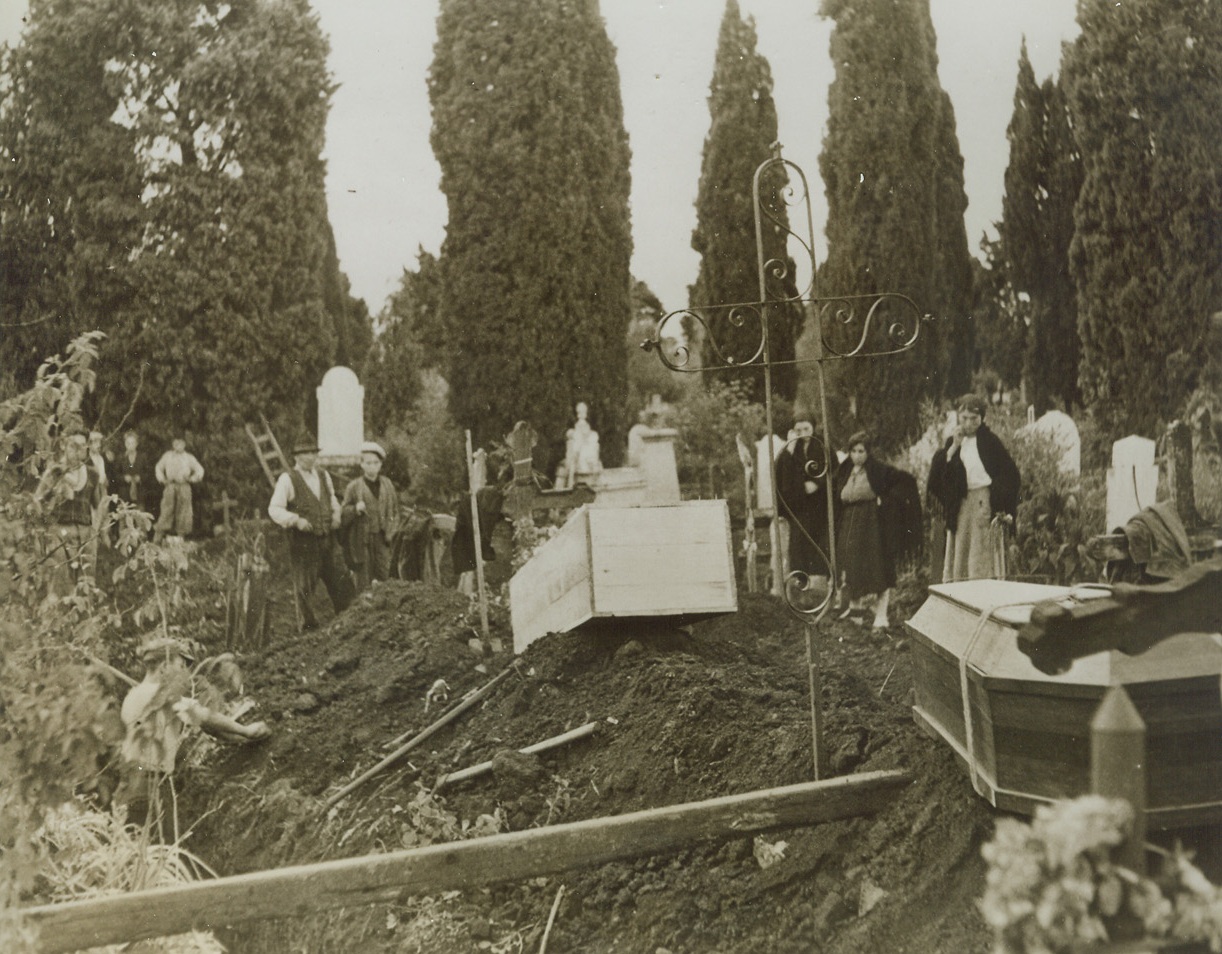
Burial for Nazi Mass Murder Victims, 10/29/1943. ITALY – Canadians spearheading the Eighth Army’s drive through Italy witnessed this burial at Rionero. Sixteen Italians were massacred by Germans when an Italian shot a German in protest against chicken-stealing. Here, the last two victims are being buried. Credit Line (ACME);
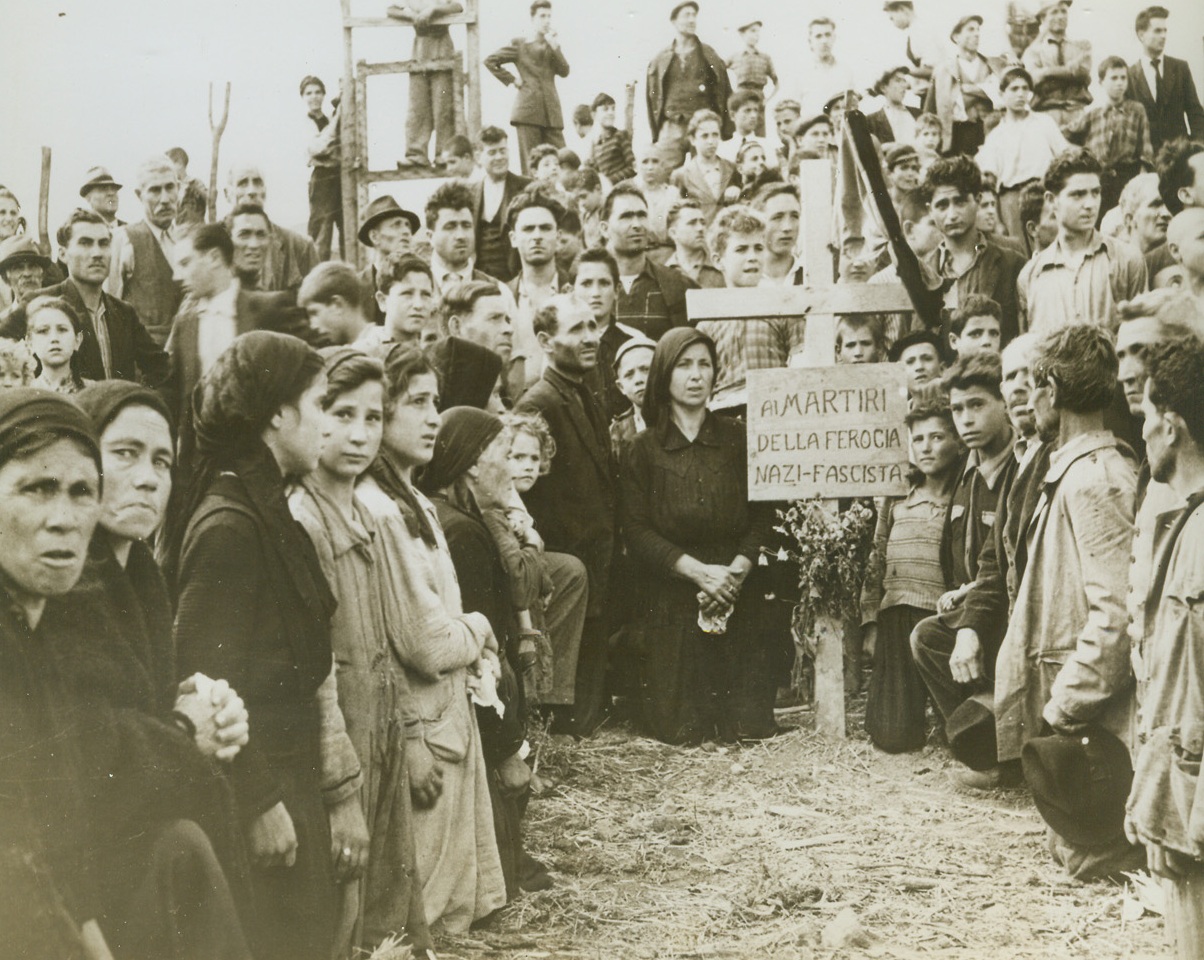
Bury Victims of Nazi Mass Murder, 10/29/1943. ITALY – A Canadian Army photographer took this picture of the wives and families of 16 Italians massacred by Germans at Rionero. This mass killing was the Nazi answer to the shooting of a German chicken thief by an Italian. Inscription on cross says men were martyrs of Nazi and Fascist ferocity. Credit Line (ACME);
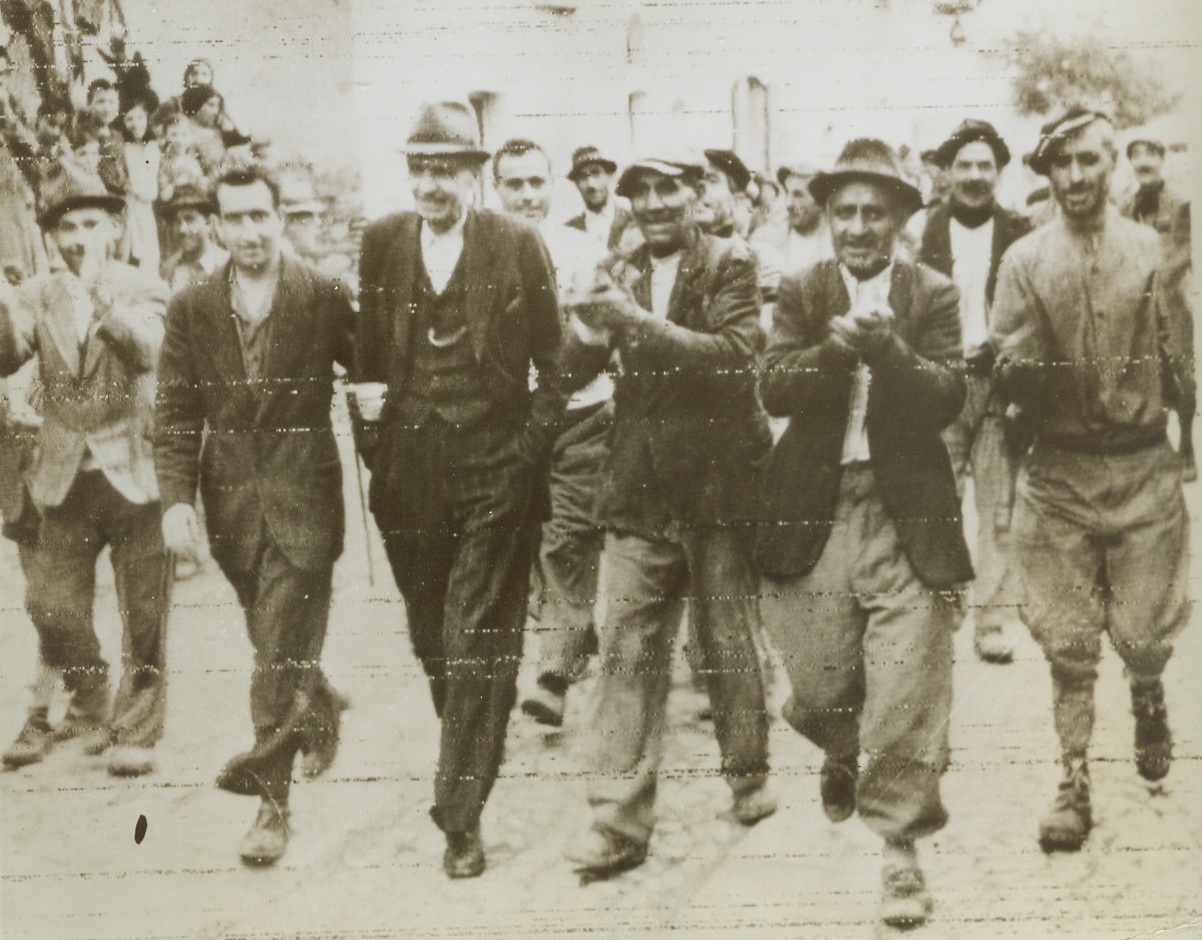
New, Anti-Fascist Mayor, 10/15/1943. CASTILLICCIO DEI SAURI, ITALY – Unanimously chosen Mayor of Castilliccio Dei Sauri by natives after Fascist Mayor had been removed, Enrico Micuoci (with hands in pockets) is escorted through the town by his neighbors. Micuoci was noted for his anti-fascist attitude throughout Nazi occupation of the town. Photo radioed to New York today (Oct. 14th) from Algiers Credit (British Army Photo via OWI from Acme);
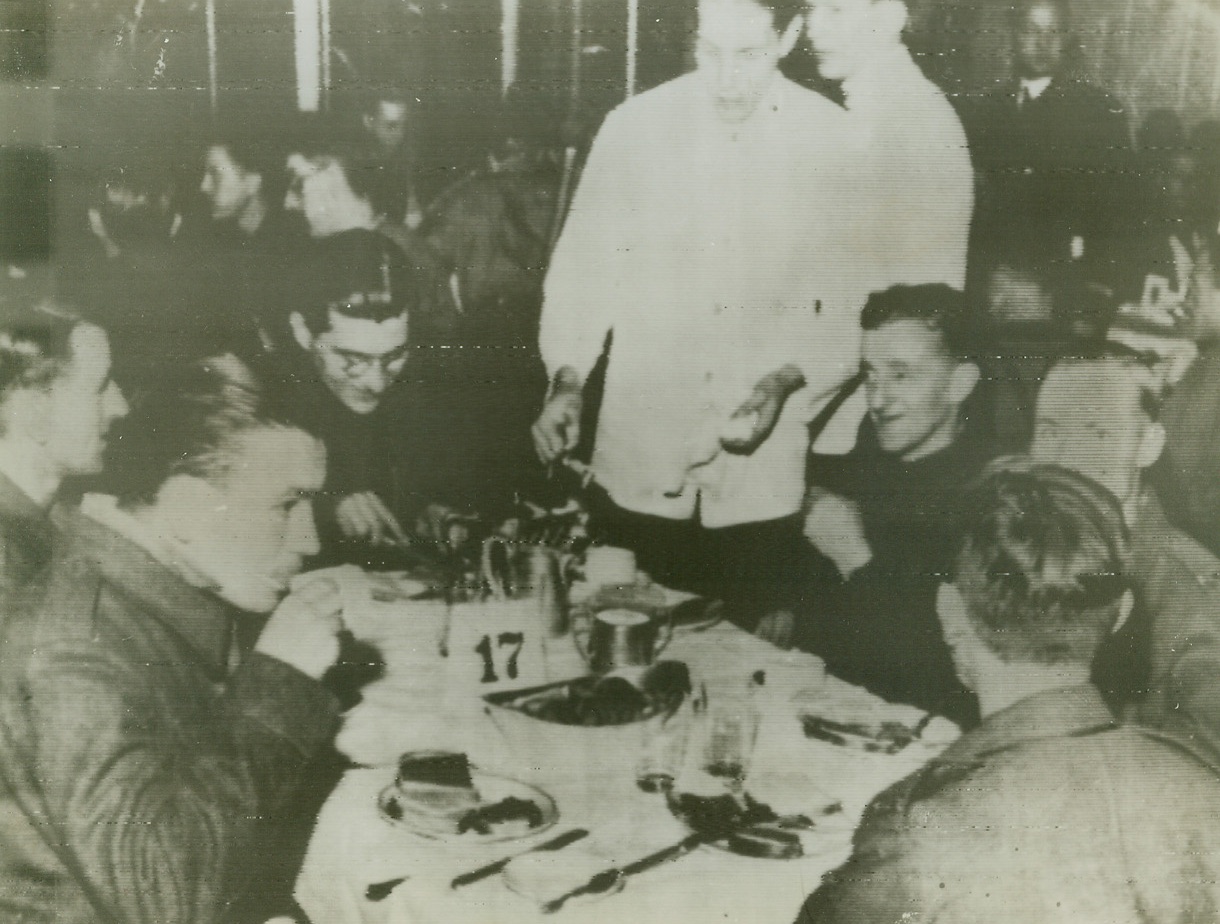
Await Exchange, 10/19/1943. GOTEBORG, SWEDEN – British, Australian and Canadian soldiers, prisoners of the Germans, have a bite to eat aboard the Swedish liner Drottningholm at Goteborg harbor before repatriation. The first exchange of prisoners of war between the Allies and Germany is being made at this Swedish port as 4,340 sick and wounded Allied soldiers, including 17 Americans, are returned to their homelands. Photo radioed from London to New York today (Oct. 19). Credit Line (ACME Radiophoto);
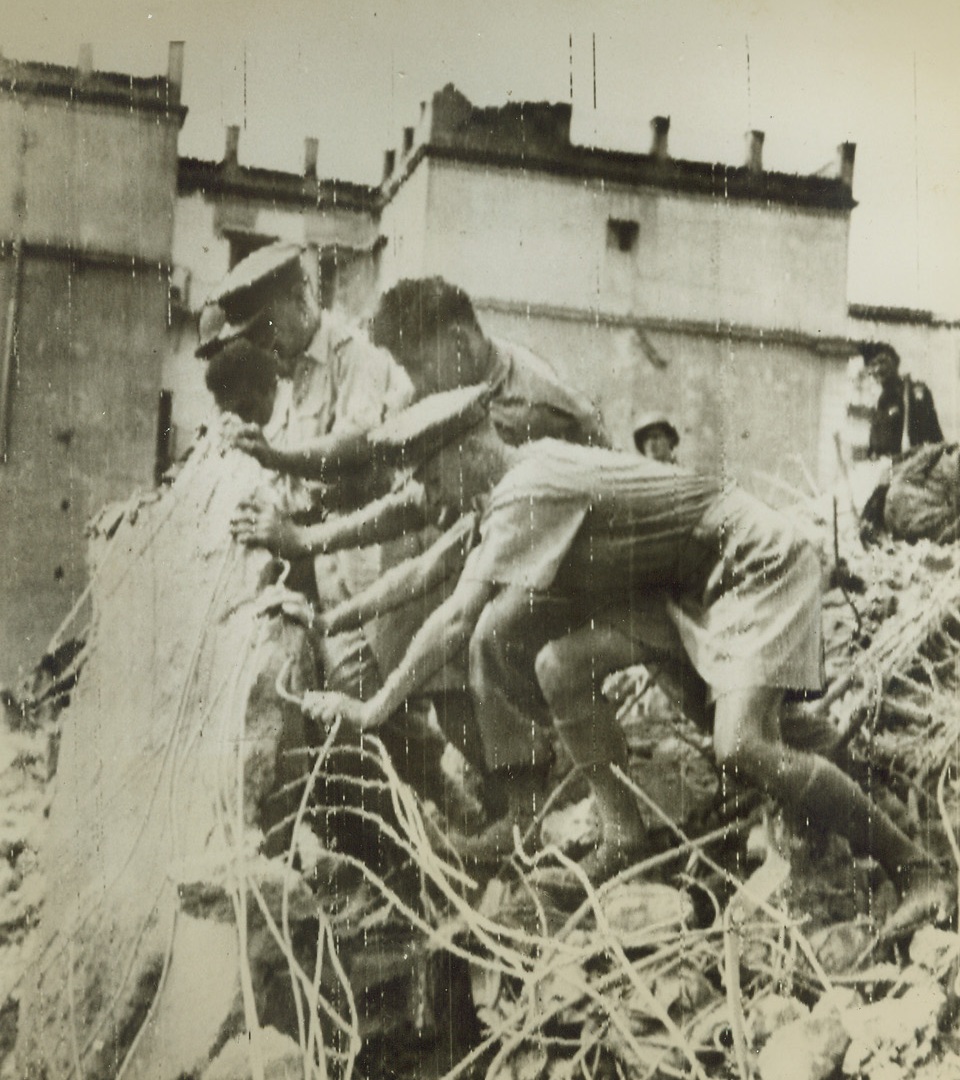
Searching for Dead or Wounded, 10/16/1943. NAPLES – British and American soldiers lift a portion of a cement floor in a search for possible dead in a U.S.-occupied barracks that was demolished by a time bomb left by retreating Germans. Naples post office was also shattered by such a time bomb. Credit – WP- (ACME Photo Via Signal Corps Radiotelephoto);
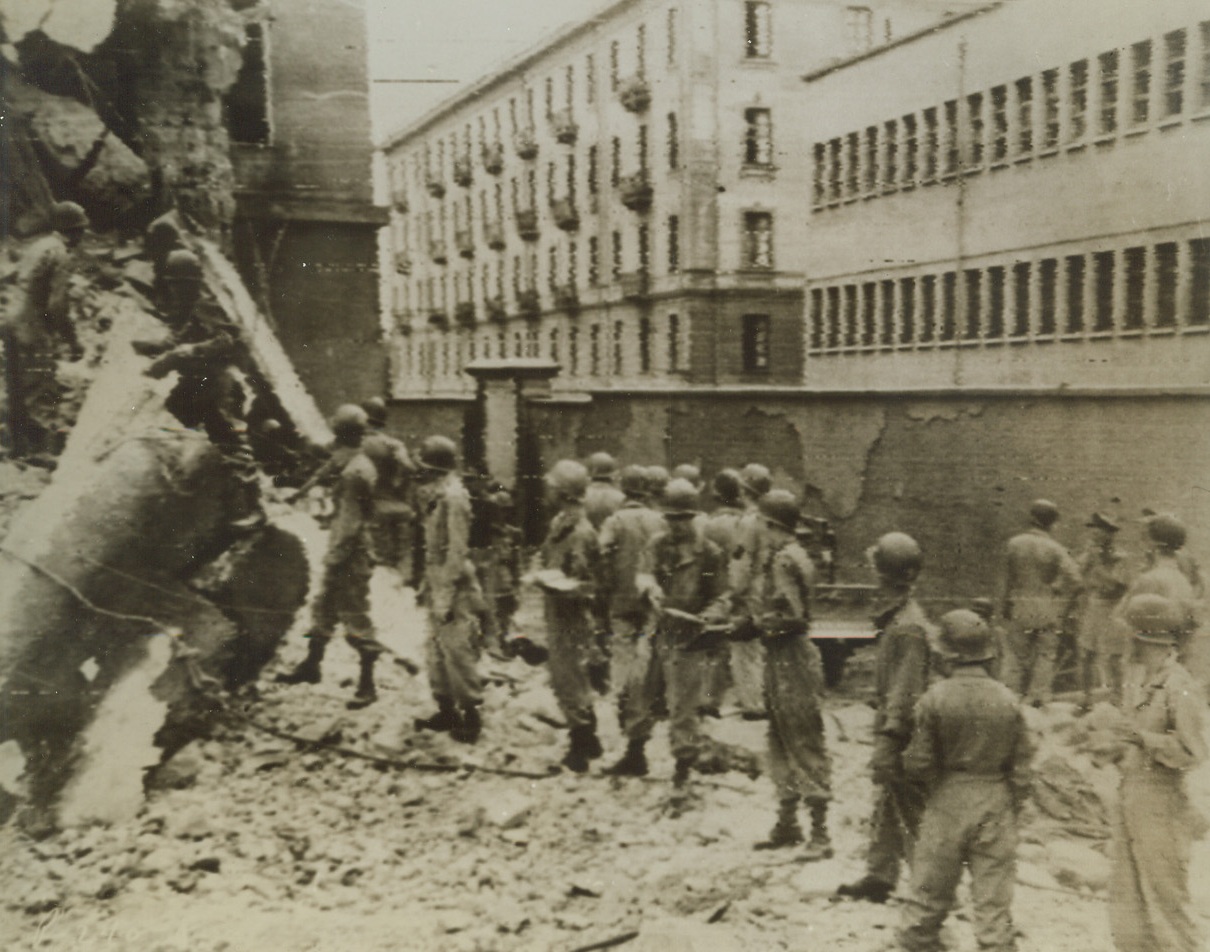
Seek Blast Victims, 10/16/1943. NAPLES – Unable to use tools for fear of further injuring men trapped under wreckage, soldiers pass debris back from man to man in their search for injured who are buried in blasted U.S.-occupied barracks that was demolished by a Nazi time-bomb in Naples. The retreating Germans leave behind their deadly booby traps as the Allies push on. Credit – WP- (ACME Photo Via Signal Corps Radiotelephoto);
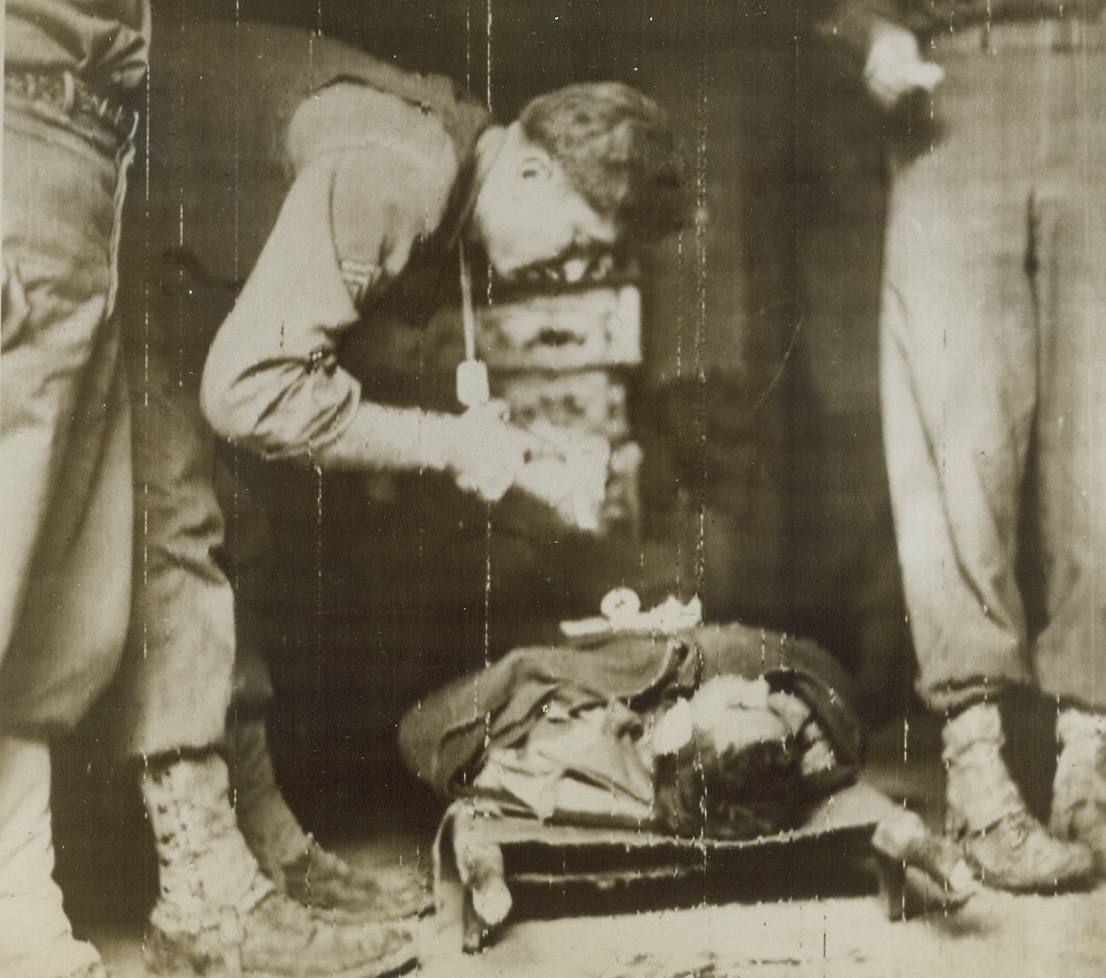
Emergency Hospital, 10/16/1943. ITALY – An Italian farmhouse serves as an emergency hospital station near the Volturno River sector. A medical corporal administers first aid to the wounded Americans suffering from shrapnel injuries. German radio admitted tonight that Nazis have retreated beyond the Volturno. Credit – WP- (ACME Photo Via Signal Corps Radiotelephoto);
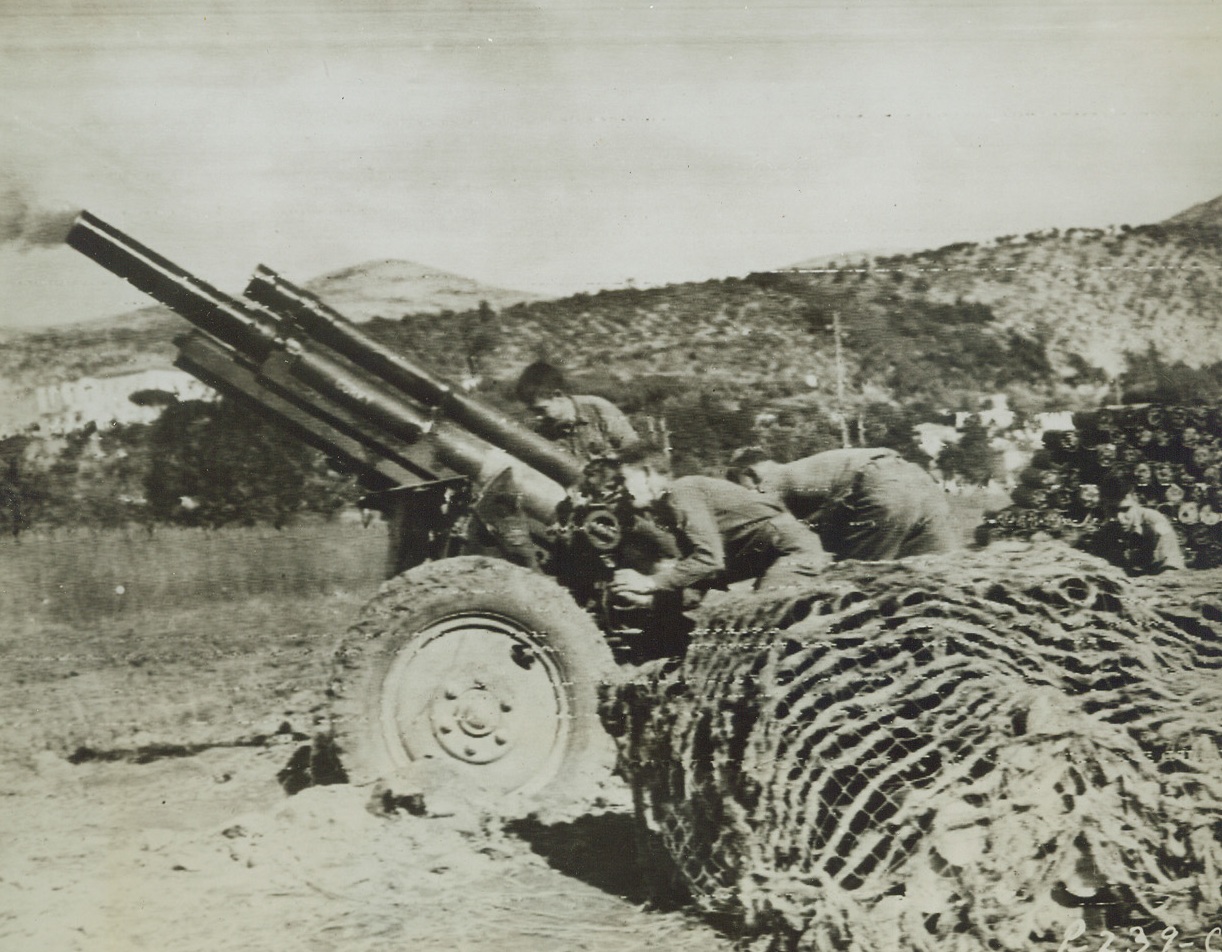
Aimed at German Machine Gun Nest, 10/16/1943. ITALY – Aimed at a German machine gun position in the Volturno River sector near Casenta, one of the American 105 MM batteries goes into action. Germans tonight acknowledged retreats north of the river and Allied Headquarters said that they are preparing new defense line along Garigliano River 80 miles south of Rome. Credit Line (Signal Corps Radiotelephoto from ACME);
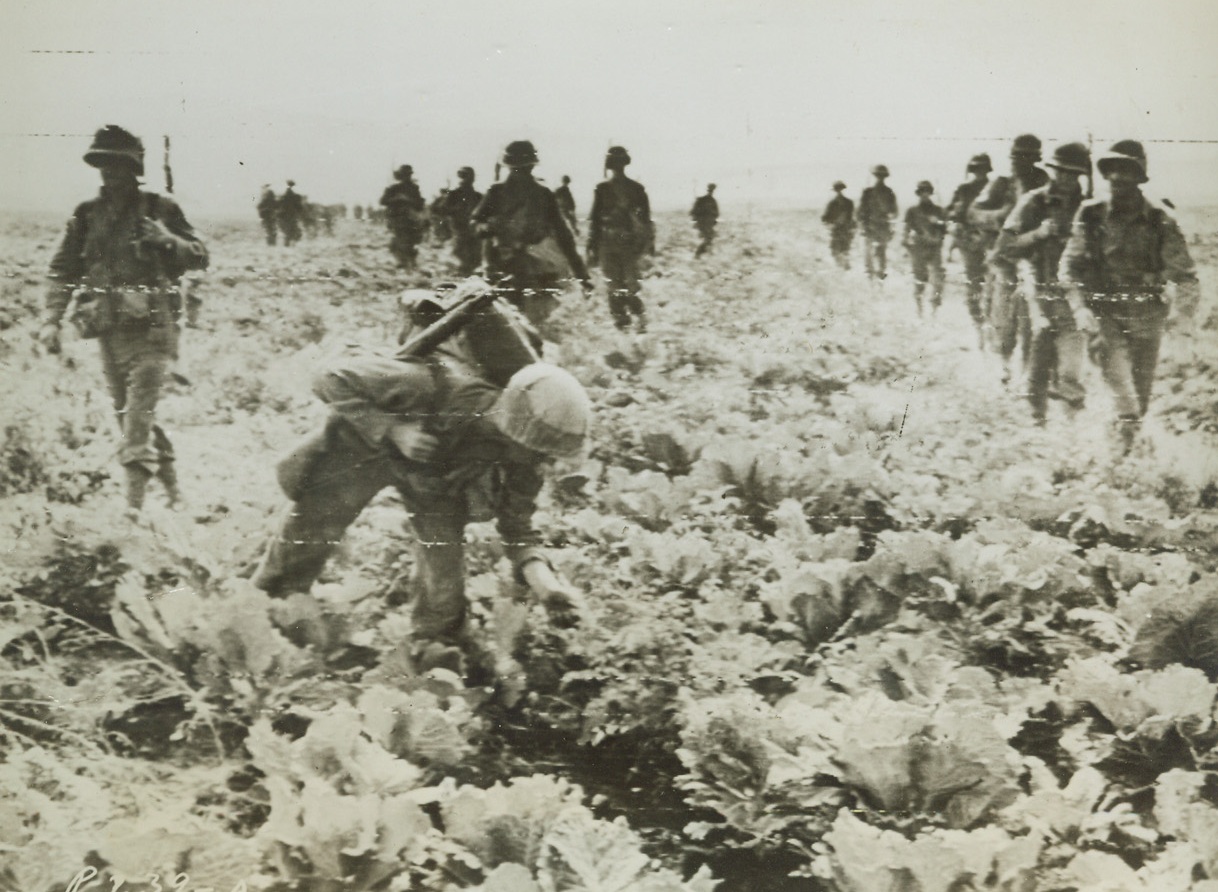
Good Pickings, 10/16/1943. ITALY – War isn’t always mud, sweat and blood. Here’s a member of an advancing group of American infantrymen who found good pickings in a tomato patch during advance on Ponti, Italy. Latest dispatches say Germans have retreated to new defense positions along Garigliano River only 80 miles from Rome. Credit Line (Signal Corps Radiotelephoto from ACME;
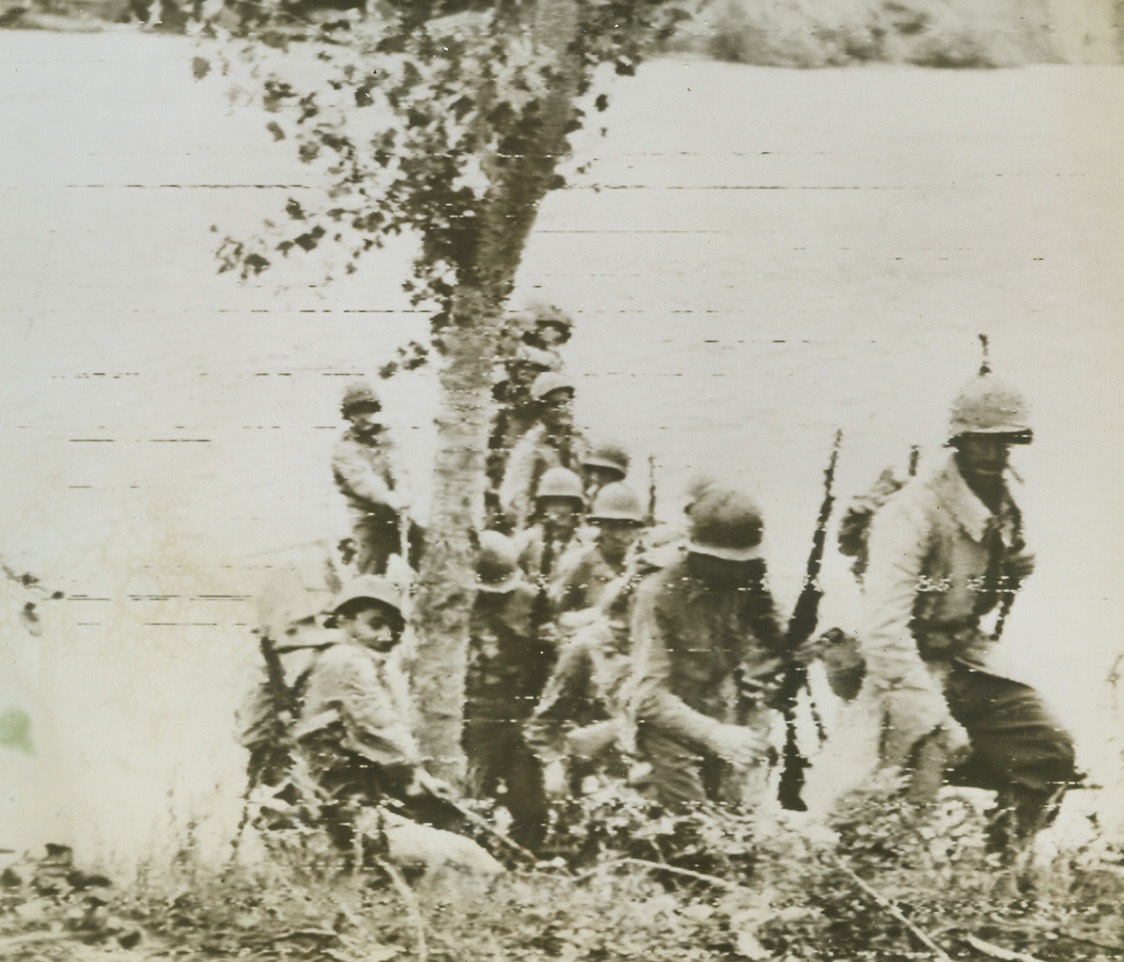
Yanks Cross Volturno, 10/19/1943. Advancing against the Germans, American troops disembark from their pontoon raft after crossing the Volturno River in Italy. This picture was taken by Bert Brandt, Acme photographer for the war picture pool, and flashed to the Untied States by Signal Corps Radiotelephoto. Credit (Acme by Bert Brandt for War Picture Pool via Signal Corps Radio-Telephoto);
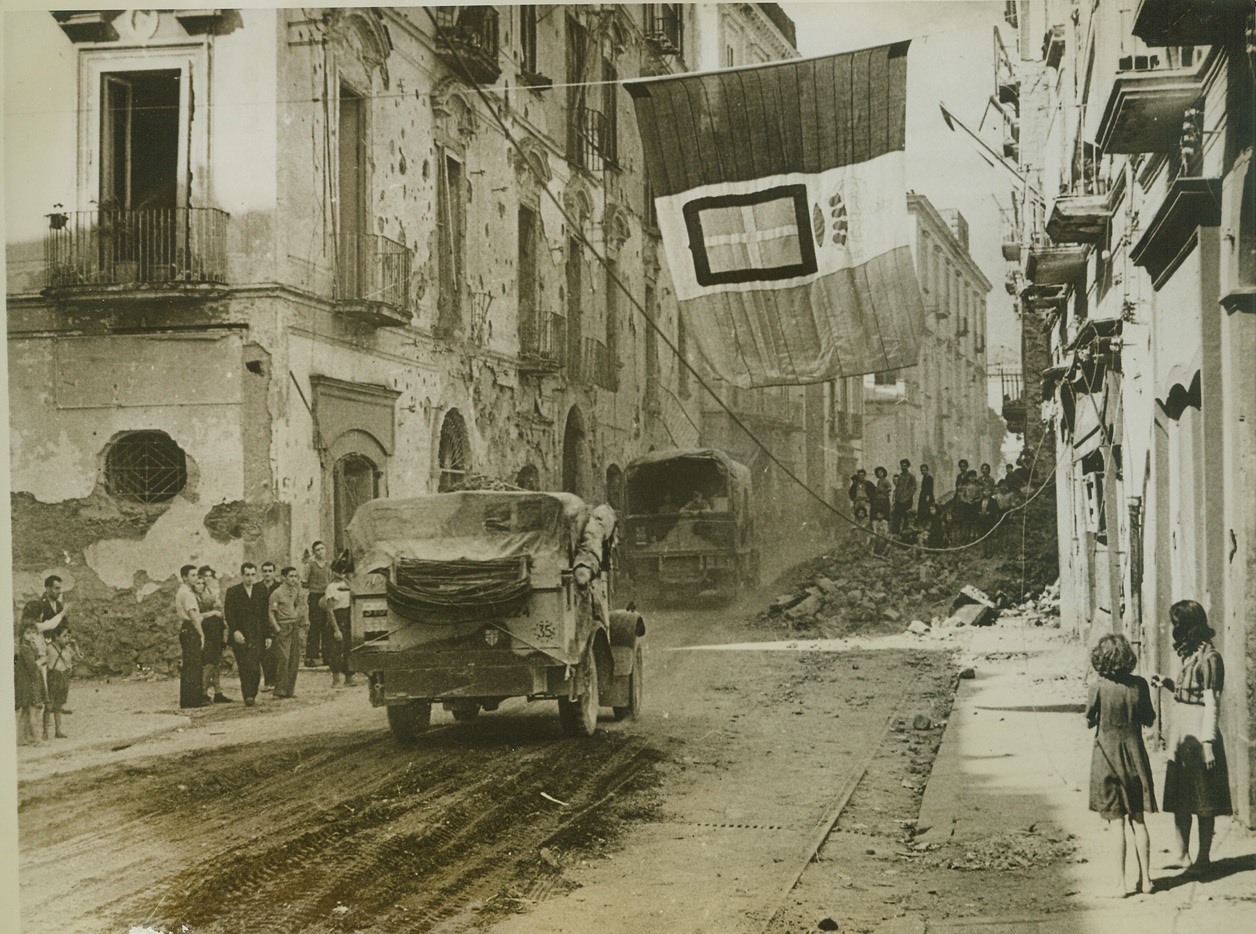
Welcome to Resina, 10/14/1943. RESINA, ITALY -- Residents of Resina gather in the streets and climb atop bomb-debris on the sidewalk to watch vehicles of the Allied Fifth Army enter their town. Shattered by attacks from the air and land, the tiny town was the last to be captured before the final drive on Naples. Credit: (ACME);
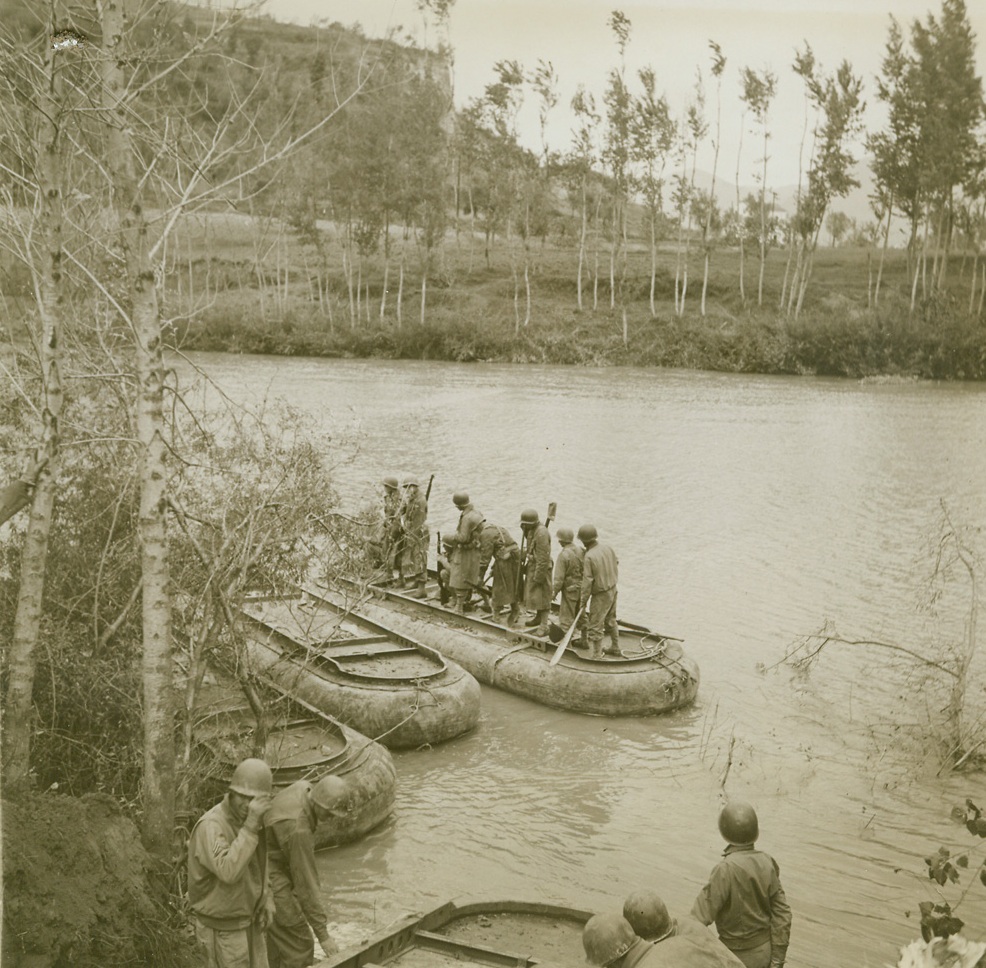
Nazi Italy Morale Drowned in the Volturno, 10/25/1943. ITALY -- When 5th Army troops splashed, paddled, or swam across the Volturno, more than a river was lost to the Germans. The Nazis learned in blood that their natural barrier defense system wouldn't work. To further consolidate this message of Axis defeat, crack American engineers immediately floated a pontoon bridge across the shallow river so that heavy Allied equipment could rumble on the heels of the advanced infantry forces who had begun the job of dislodging the enemy. These photos tell the story of that bridge which, in reality, may be called a road to victory in Italy for the Allies. New York Bureau Construction gets under way on the main 5th Army bridge spanning the Volturno as engineers begin placing pontoon sections. Credit (ACME Photo by Bert Brandt, War Pool Correspondent);
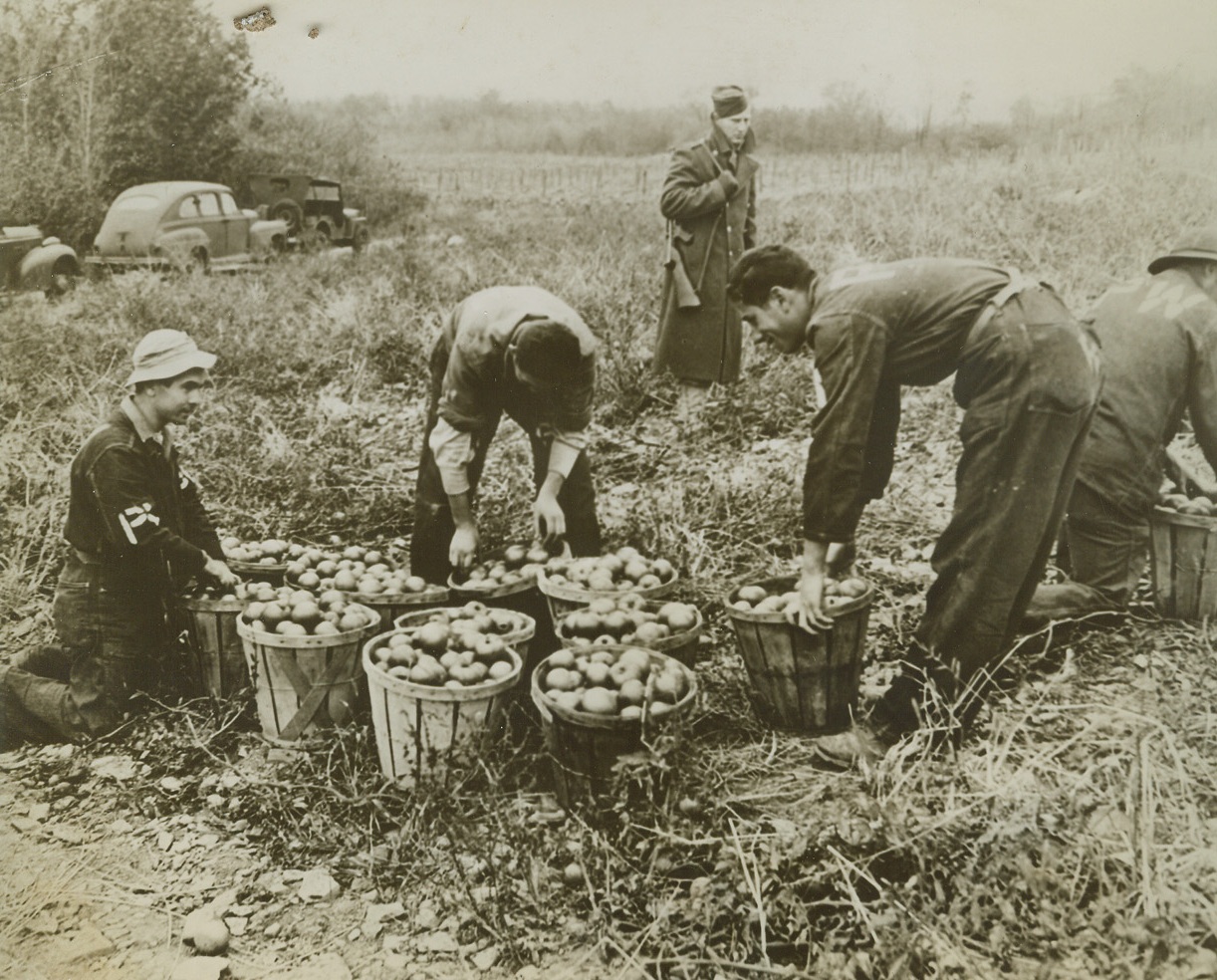
Italian Prisoners Put to Work on Farms, 10/25/1943. FREDONIA, N.Y. -- Italian prisoners of war make no trouble for their armed Yank guard as they harvest a late tomato crop on the William Russo farm near Fredonia, Chautaqu County, N.Y. Several groups of the ex-Mussolini fighters are helping relieve the manpower shortages in rural America this year. Credit Line (ACME);
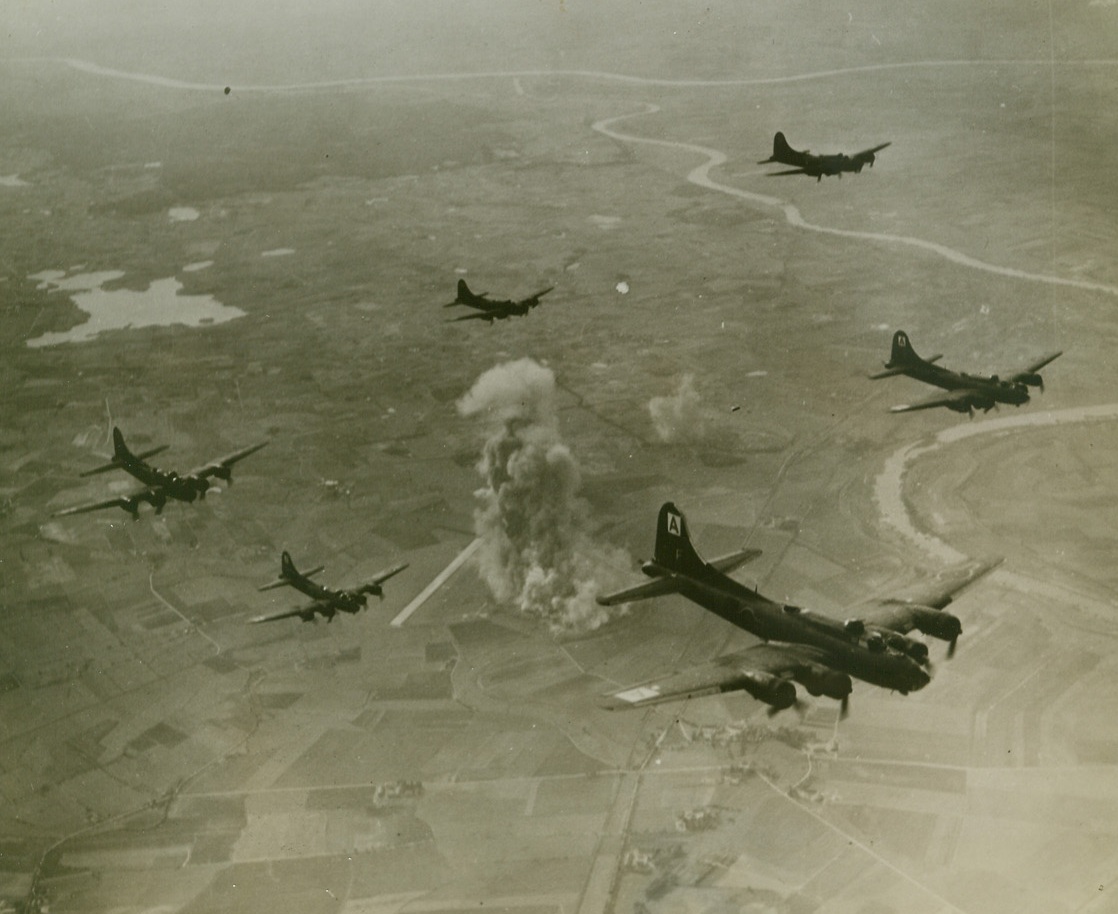
Forts Destroy Focke-Wulf Plant, 10/22/1943. MARIENBURG, GERMANY – Columns of smoke rise from the ruined Focke-Wulf aircraft plant at Marienburg as Flying Fortresses of the 8th Air Force Bomber Command turn away from their target after the raid of October 9th. German defenses were caught napping when our Forts visited the giant plant and virtually destroyed it. Credit (U.S. Army Air Forces Photo via OWI – ACME);
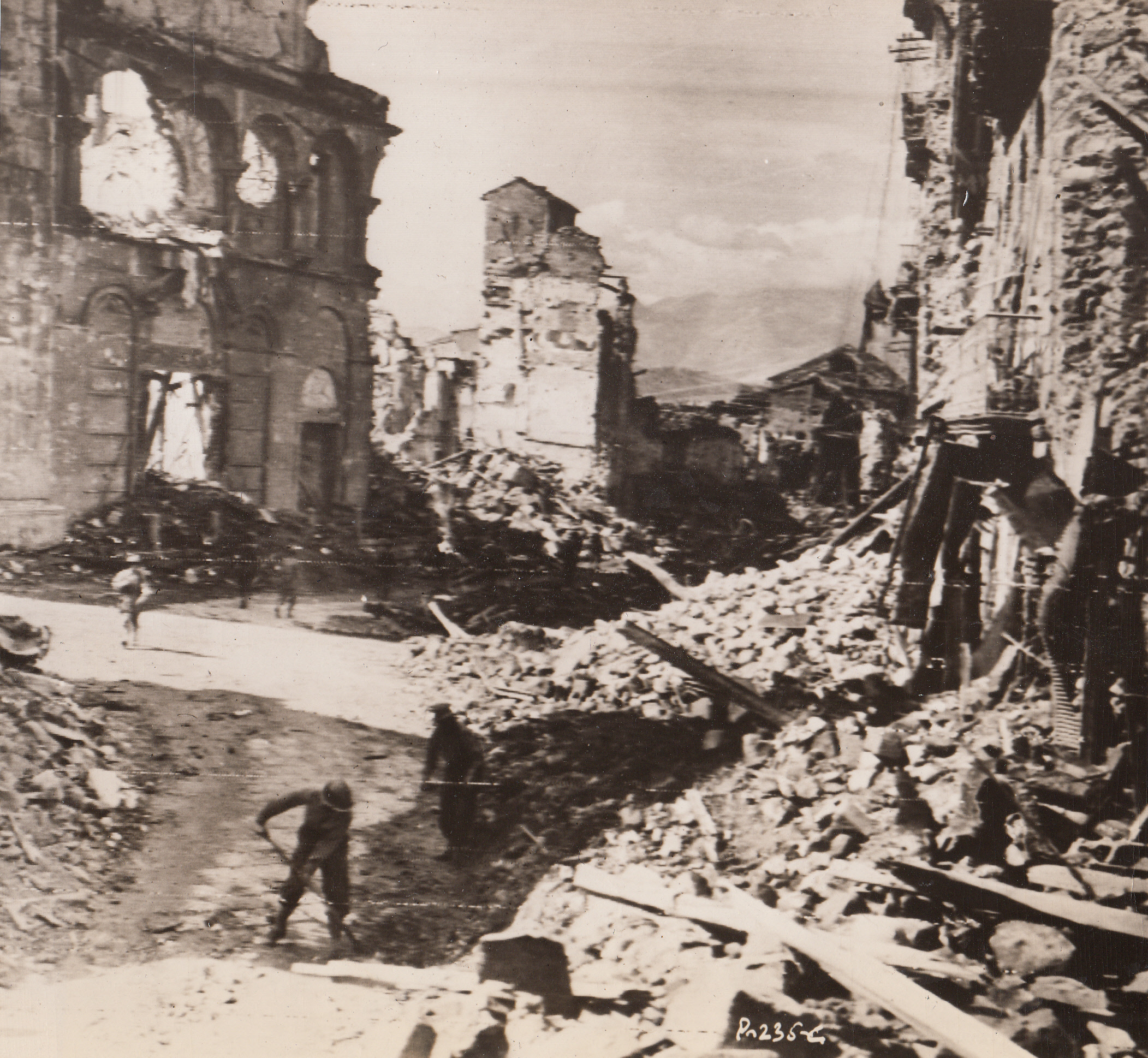
Road to Ruin Leads to Rome, 10/13/1943. BENEVENTO, ITALY – A few gutted buildings and streets piled high with rubble is all that is left of Benevento, one of the towns leading to Naples. Army engineers clear a road through the ruins while, in the background, American infantrymen press on toward the next town.;
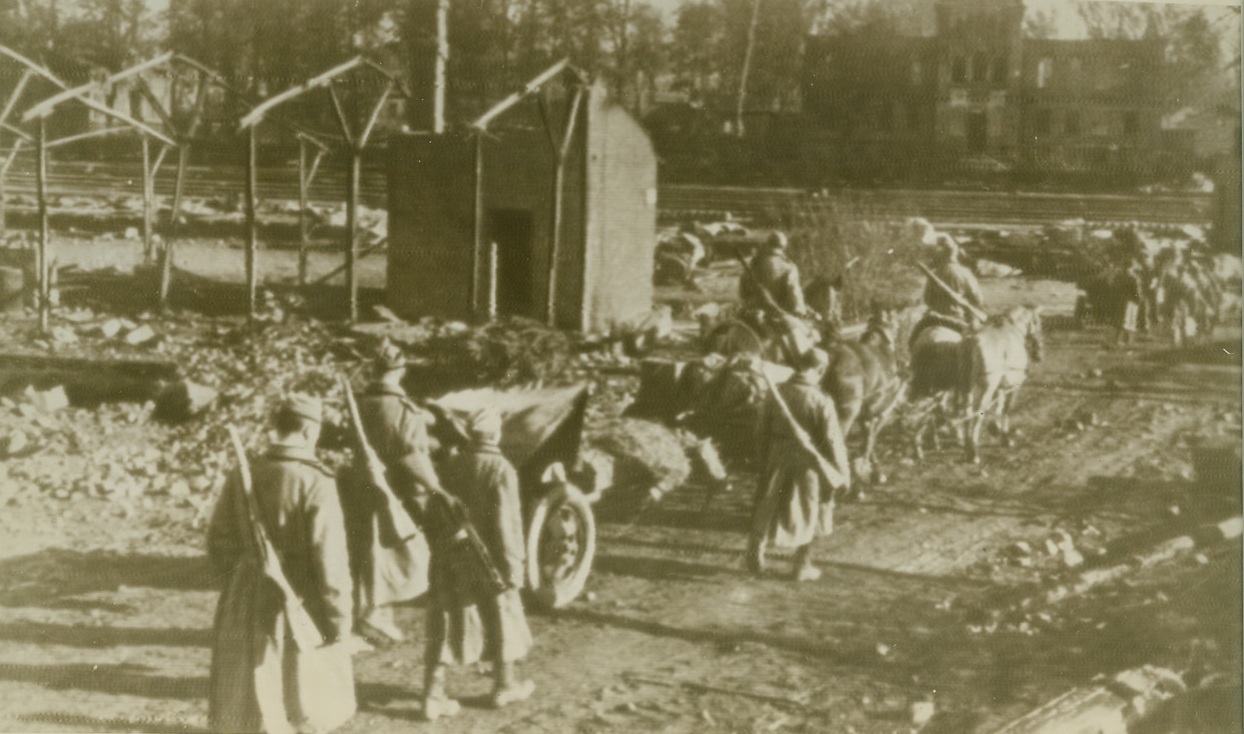
Red Army Pushes Through Roslavl, 10/14/1943. ROSLAVL – Soviet artillery moves through the town of Roslavl, and important German strongpoint in the Mogilev area, which was captured by the Red Army after the Nazis put up a stiff resistance. Latest reports on the Red Army indicate the Soviet troops fought their way back into Gomel, breaking the back of the German defense line, while the bloodiest battle of the war raged near Kiev.Credit: (ACME Radiophoto);
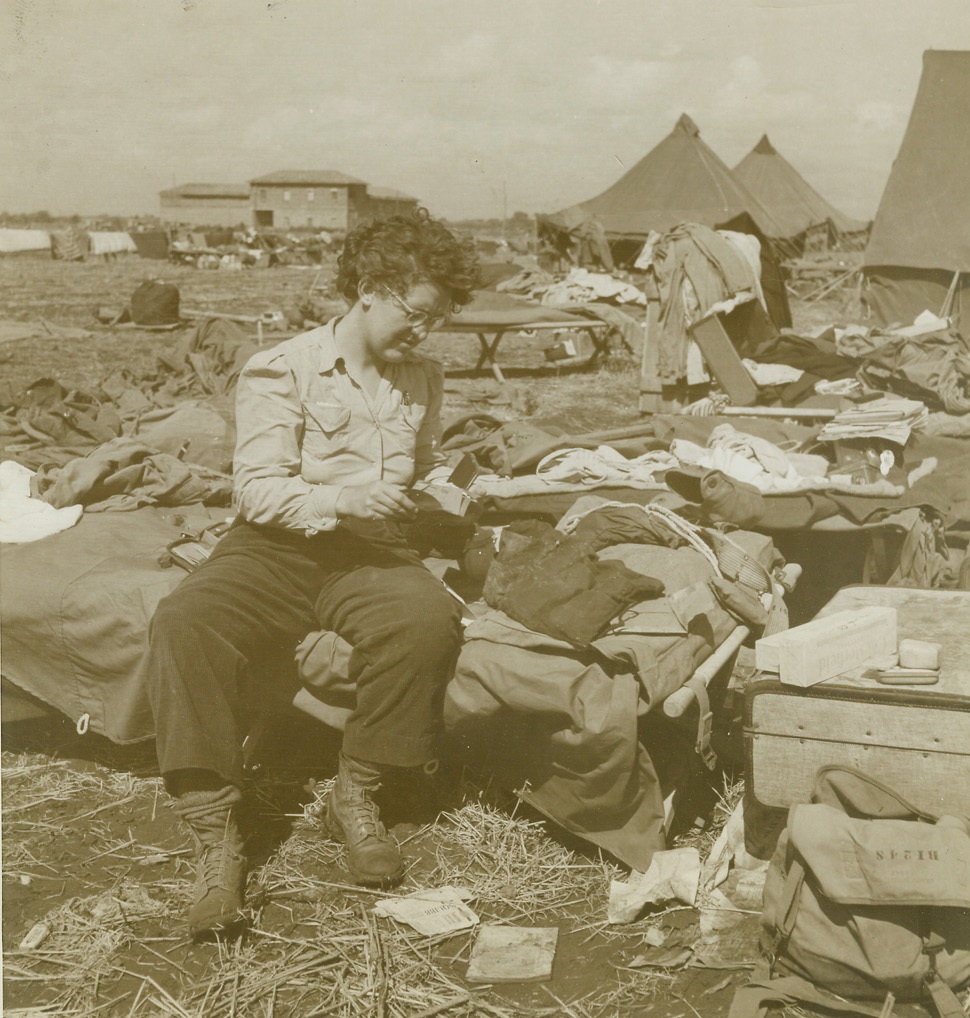
After the Storm, 10/13/1943. ITALY – The first big rainstorm experienced by our troops in Italy played havoc with the Army’s newly-established evacuation hospital. Here, after the storm, surgical nurse Edith Bishop, who hails from Green Bay, Wisc., gets her equipment in working order.Credit: – WP—(Photo by Charles Seawood, ACME Photographer for War Pool);
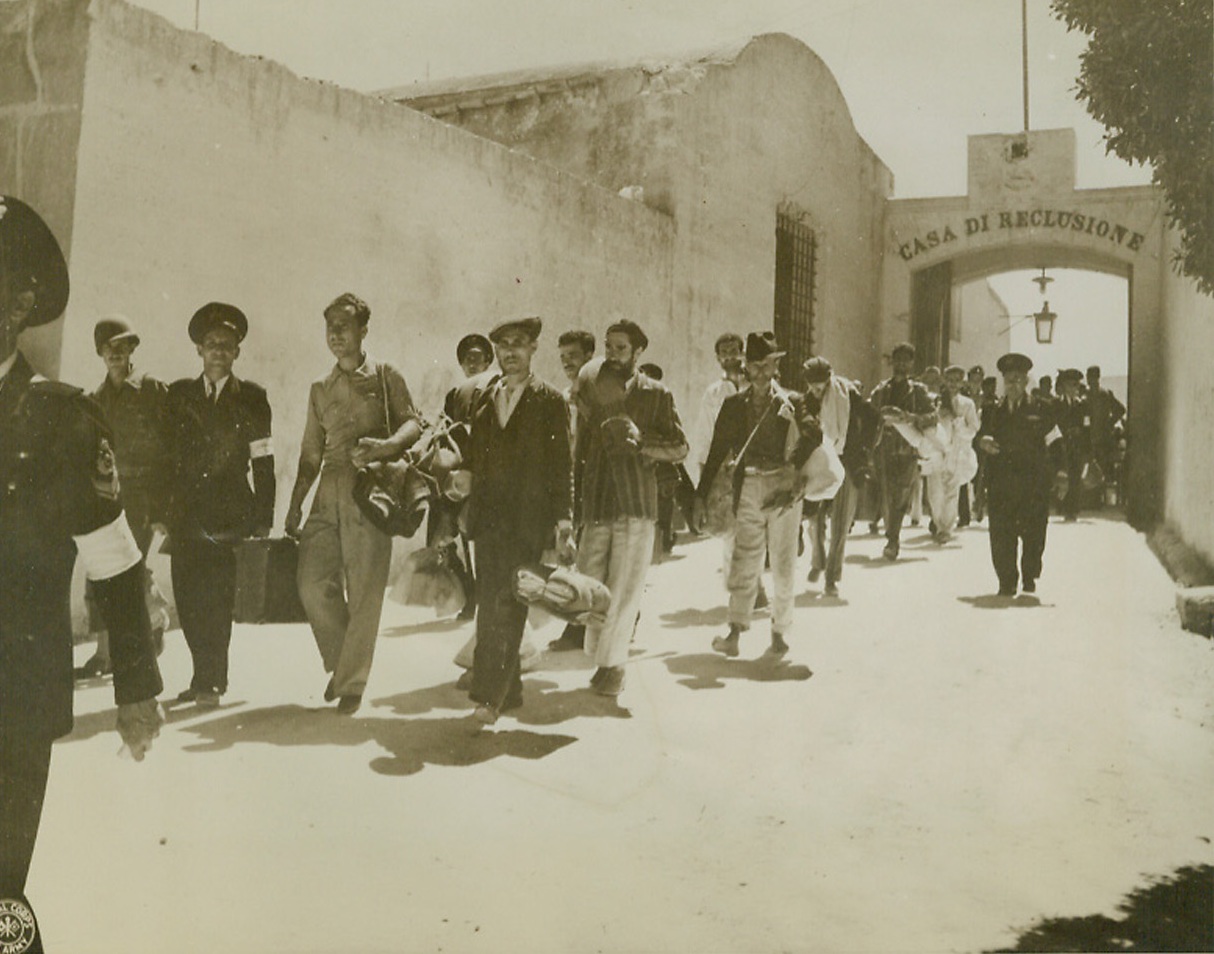
Anti-Fascist Go Free, 10/13/1943. FAVIGNANA – Political prisoners of the Fascist regime, who were interned on the island of Favignana, off the west coast of Sicily near Trapni, were release when the Allied Military Government assumed control of the island. The anti-Fascists carry their belongings as they march to the boat that took them to the Sicilian mainland.Credit: (Official U.S. Army Photo from ACME);
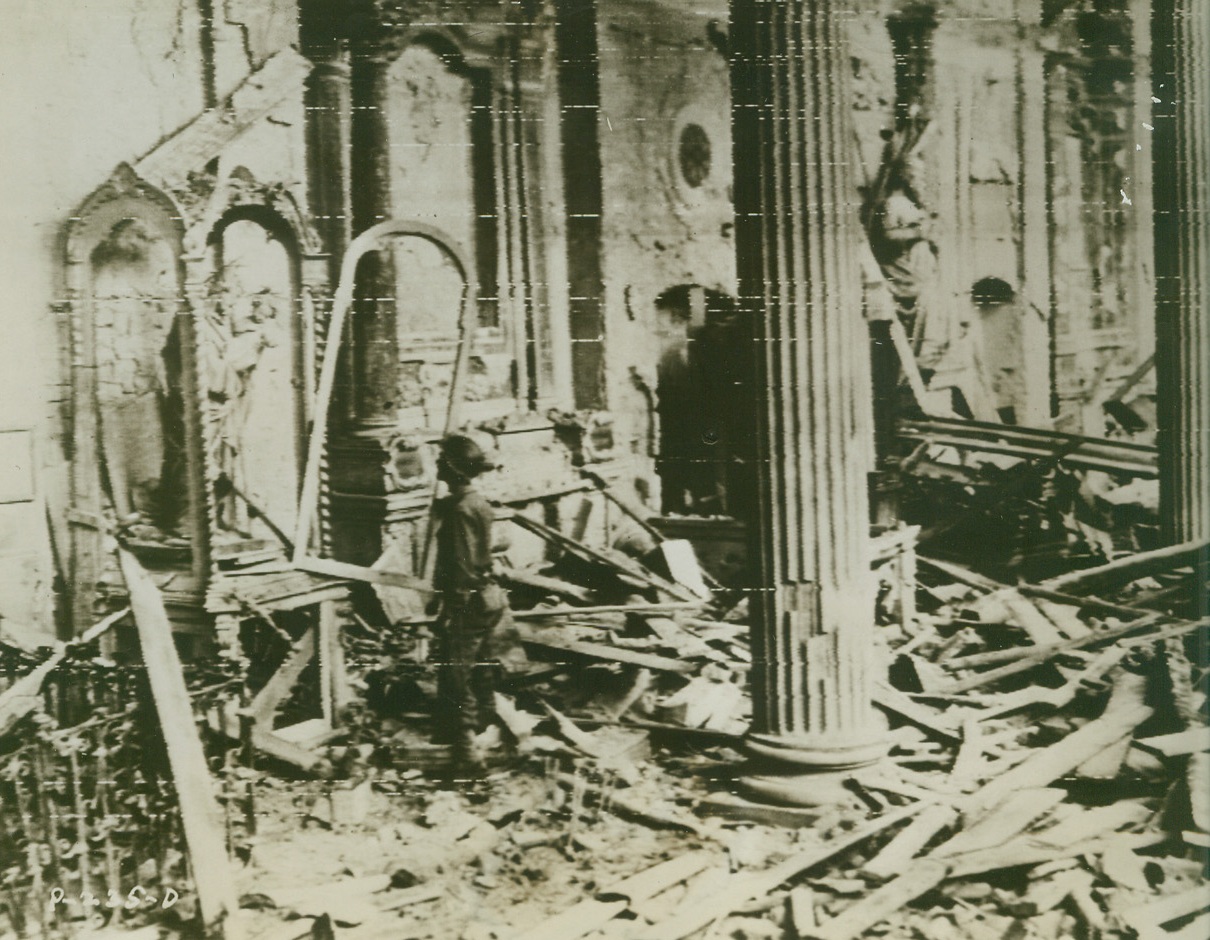
War Passes By, 10/13/1943. ITALY – Bernhard Haber, of New York City, stands wonderingly before a holy statue which was untouched by the forces of war that crippled the church in Benevento, Italy. Rubble covers the floor of the place of worship, but only the casing of the statue was shattered by demolition.Credit (U.S. Army Signal Corps Radiotelephoto from ACME);
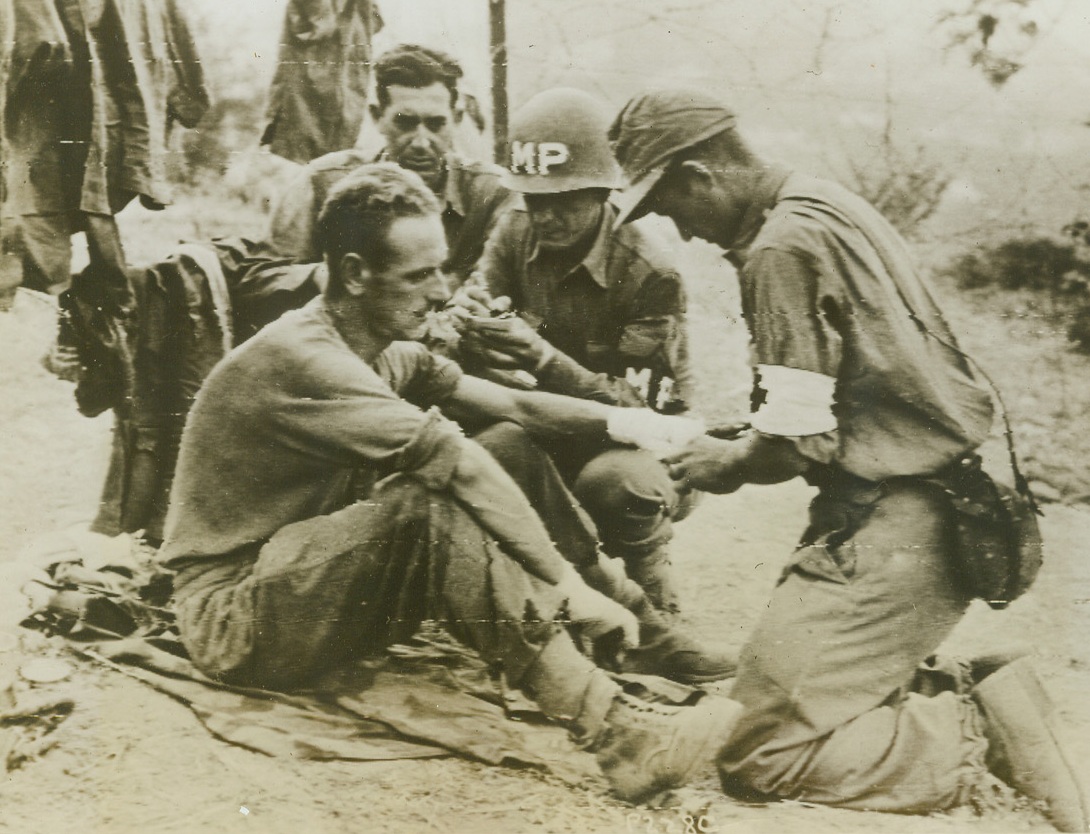
First Aid for His Buddy, 10/8/1943. ITALY – Karl Kruger, a German Medical Officer from Berlin, dresses the wounds of another Nazi prisoner, E. Baecker, also of Berlin, in a stockade in Italy. Leo A. Wexler (without helmet) of Indiana, and Sgt. Anthony Cieplinzike of Chicago, Ill., both MP’s, take the names of their prisoners.Credit Line (Signal Corps Radiotelephoto- ACME);
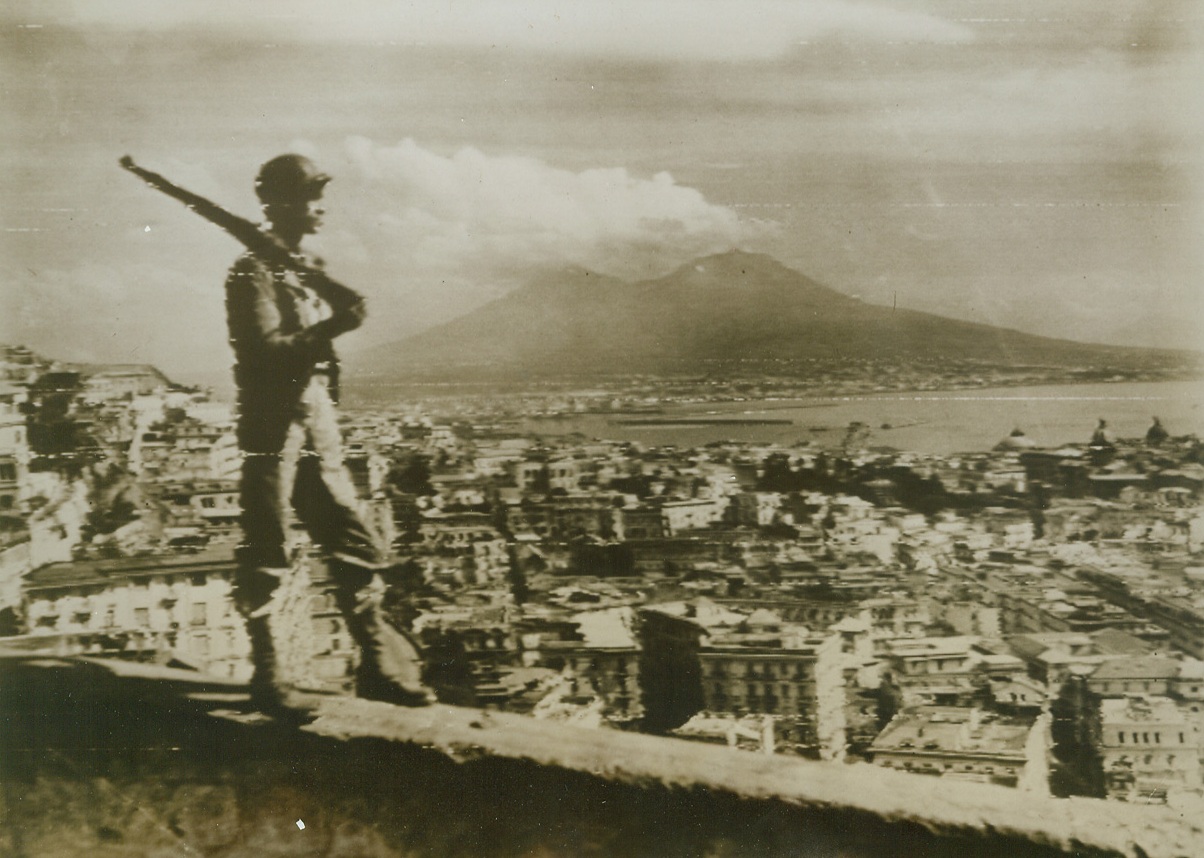
All’s Quiet, 10/8/1943. NAPLES, ITALY – All’s quiet in Naples now, but the Italian city is still in a critical condition, left without water, electricity or gas. This tranquil view of Naples was taken at an American sentry’s hilltop post.Credit (U.S. Signal Corps Radiotelephoto – ACME);
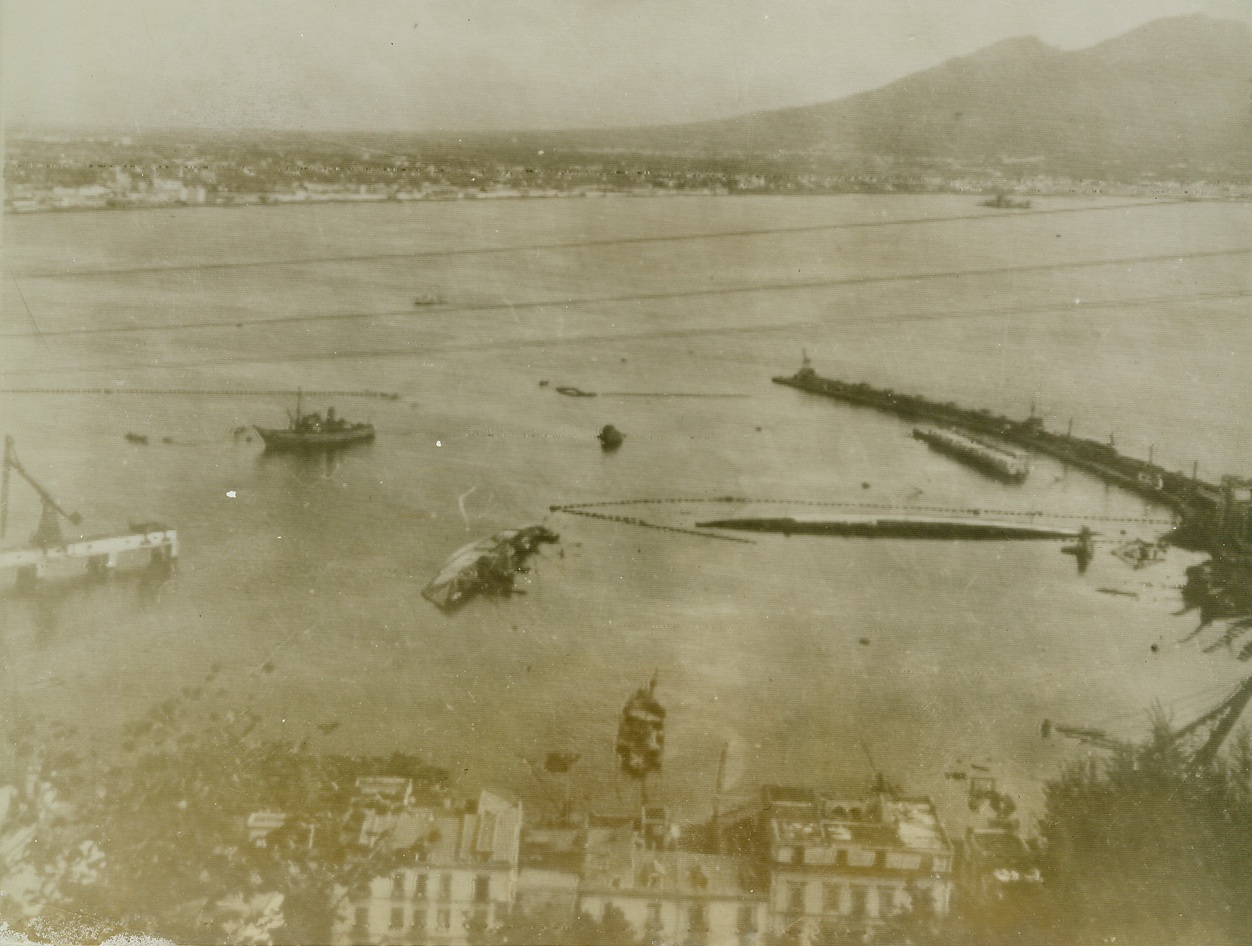
Bay of Naples Graveyard for Axis Ships, 10/6/1943. Sunken enemy ships lie in the harbor at Castel-Lammare, Italy, at the southern end of the Bay of Naples. This port had been used by Nazis for shipping and supplies to their troops in Sicily and North Africa, since the start of Allied campaigns.Credit (RAF Photo thru OWI from ACME);
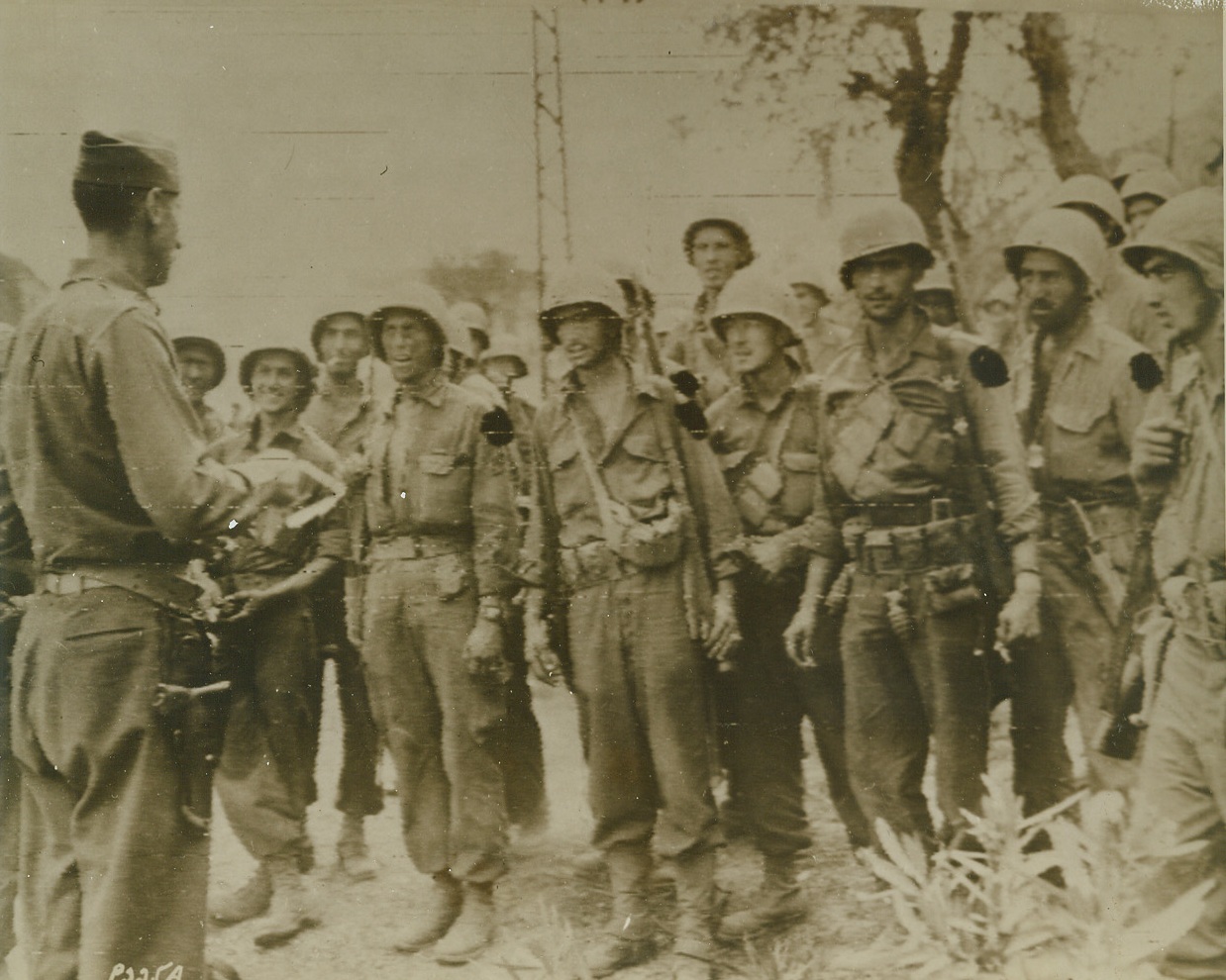
Congratulations from the Chief, 10/6/1943. Lt. Gen. Mark W. Clark, (far left), commander of the 5th Army, congratulates “his boys” after the American Infantrymen along with British forces, had been victorious in the Salerno area. This photo was flashed to the U.S. by Radiotelephoto. Today, the 5th Army has cracked Nazi lines along the Volturno River above Naples.Credit Line (U.S. Signal Corps Radiotelephoto from ACME);
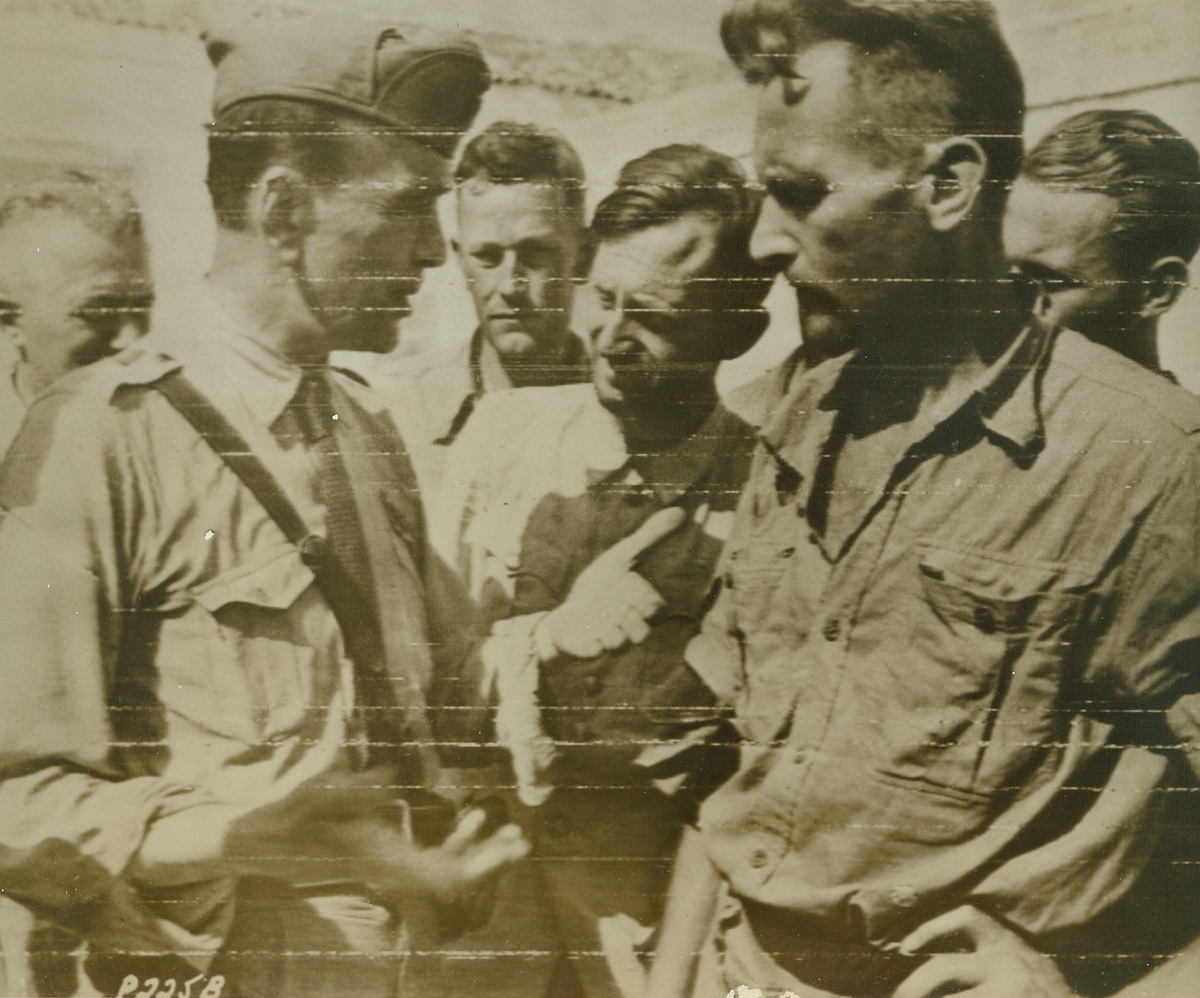
Turnabout, 10/6/1943. Major Luigo Ottino, (left), of the Italian Army, who led the capture of 11 German officers and 422 troops on the Island of Corfu, talks with one of his prisoners, in this photo transmitted to the U.S. by Radiotelephoto. The Major, working with the Allies, directed the transportation of the prisoners across the Adriatic, where they were dispatched to Allied prison camps. This was the first case where Germans on the Italian front were captured by their former partners-in-arms—the Italians.Credit Line (U.S. Signal Corps Radiotelephoto from ACME);
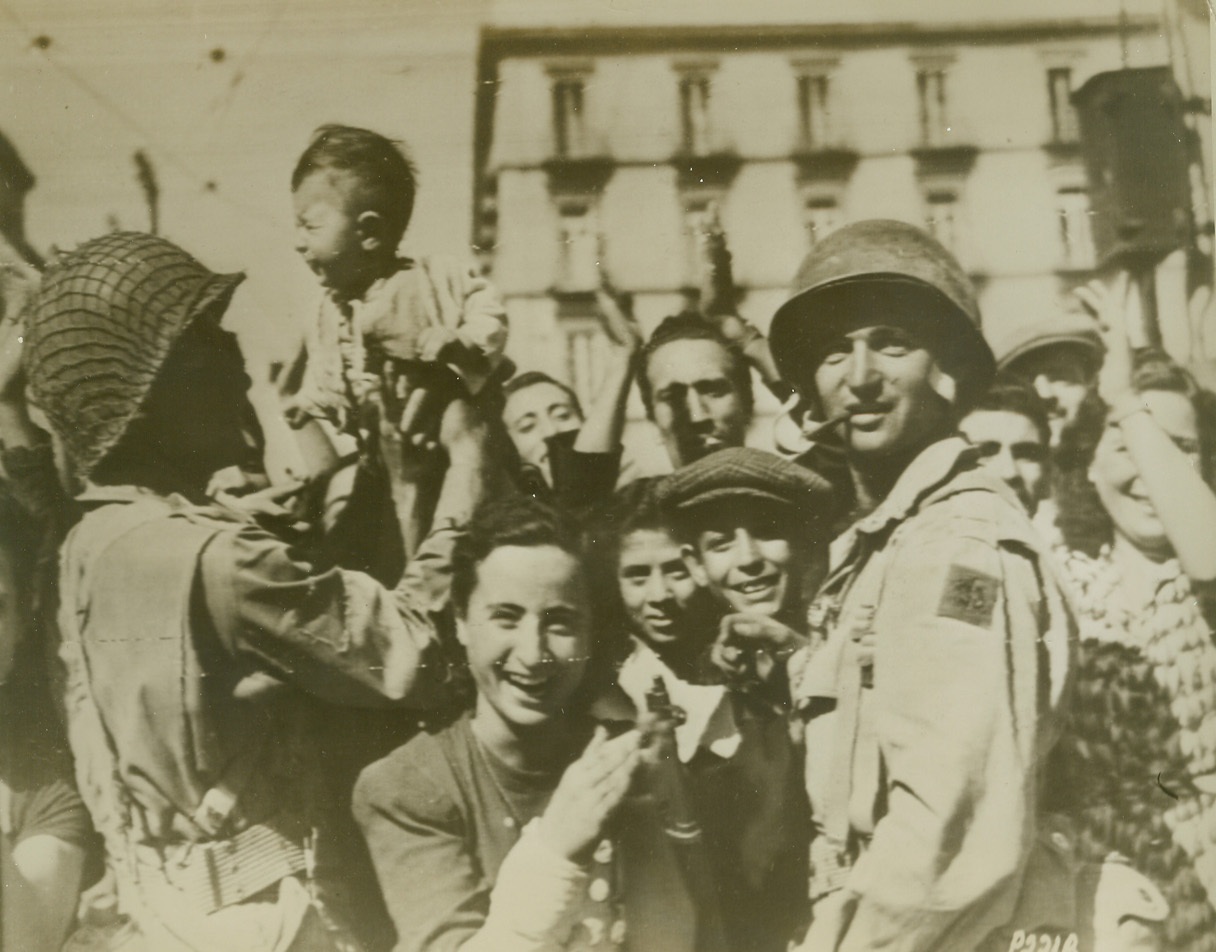
Yanks Welcomed in Naples, 10/4/1943. Natives of Naples smile as they welcome American soldiers to that city. One soldier (left), holds a baby, who doesn’t seem to share the happiness of the hour. This photo was flashed to the U.S. by Radiotelephoto. Credit Line (ACME Photo via U.S. Army Signal Corps Radiotelephoto);
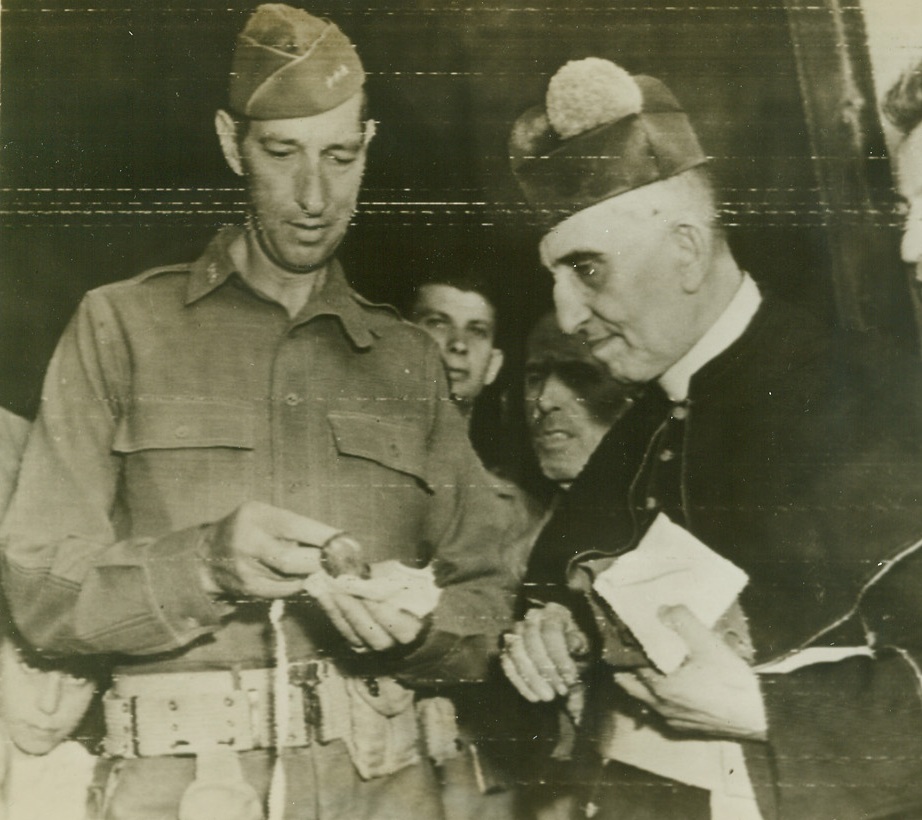
A souvenir for General Clark, 10/4/1943. ITALY – Lt. Gen. Mark W. Clark, commander of the 5th Army, admired a carved carnelian stone presented to him by Msgr. Francesco Guazzo (right), in appreciation for a gift of money raised by U.S. troops to repair his monastery at Cappaccio, which had been used by Germans as an observation post and damaged by artillery fire. Credit Line (U.S. Signal Corps Radiotelephoto from ACME);
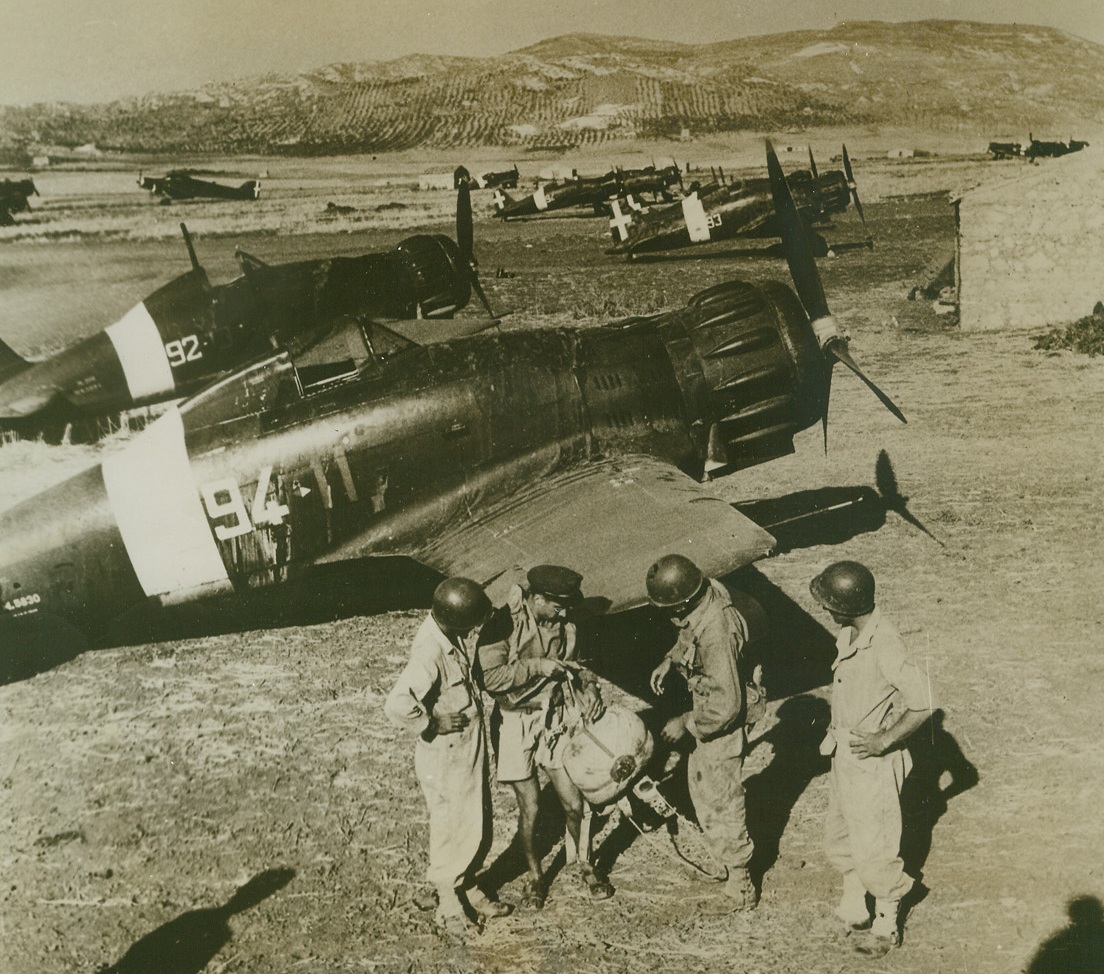
Italian War-birds Join Allies, 10/14/1943. Their performance poor on the losing side, these speedy Italian fighters and their crews wait the opportunity of fighting against the Nazis. The Italians appeared after the peace had been signed. Some were ordered to Sicily by the Badoglio government, and others came in on their own. An Italian flier talks with American soldiers just after landing.Credit (ACME from OWI);
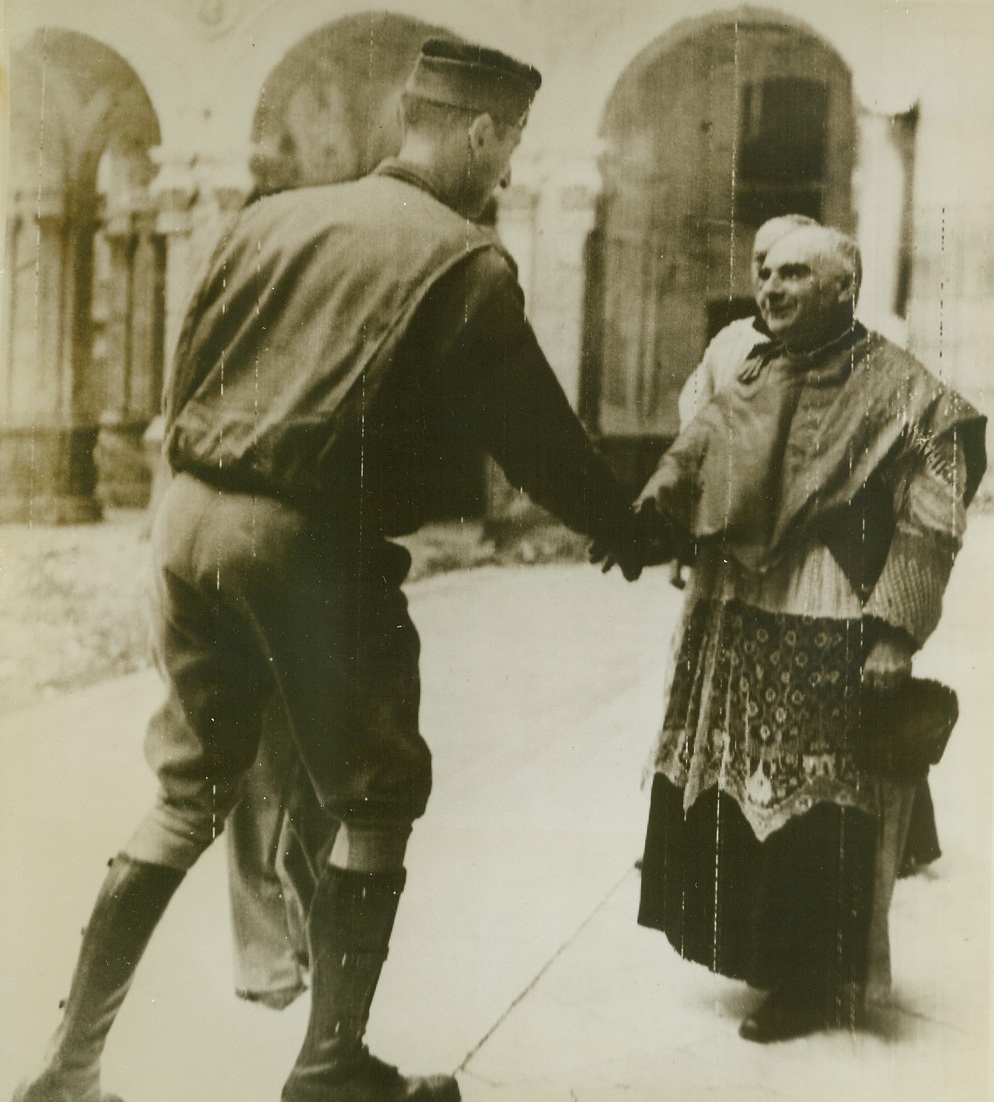
Gen. Clark Greets Bishop of Naples, 10/15/1943. This photo, flashed to the U.S. by Radiotelephoto, shows Lt. Gen. Mark W. Clark (left), Commanding General of the 5th Army, as he greeted the Bishop of Naples, before the Cathedral, where the General attended Mass. Credit Line (ACME Photo via U.S. Signal Corps Radiotelephoto);
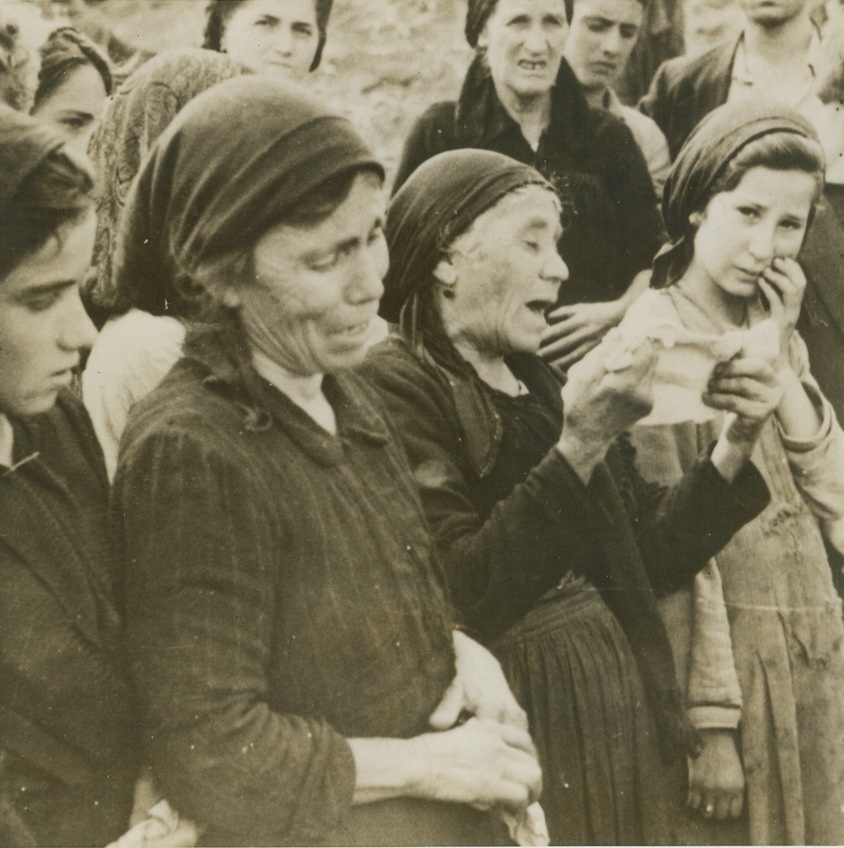
Tell Tale of Nazi Horror, 10/20/1943. RIONERO, ITALY – Grief-stricken Italian women of Rionero, Italy, sob out the story of execution of 16 men by retreating Nazis after a native farmer had shot a German chicken thief. They are unburdening their tale of woe to Canadian soldiers who entered the town.Credit Line (Acme);
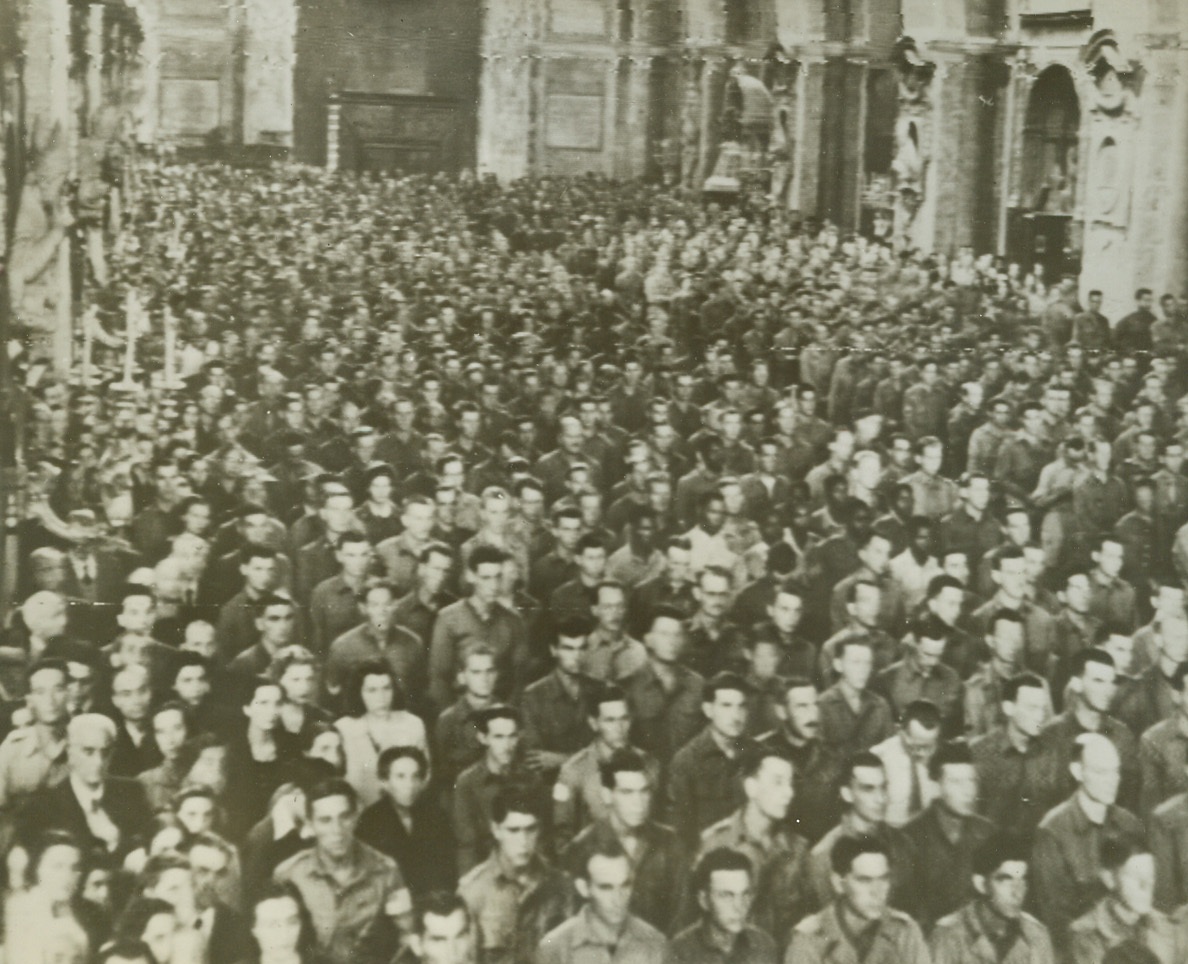
THANKSGIVING MASS IN NAPLES, 10/21/1943. This photo, flashed to the United States by radiotelephoto, shows a solemn mass of thanksgiving conducted in the Cathedral of Naples by Allied 5th Army Chaplains, for the armed forces that delivered the city. His Eminence, Cardinal Ascalesi was present in the Sanctuary during the ceremony. Many of the natives of Naples also attended. Credit: Acme photo by Charles Seawood for the War Picture Pool via Army radiotelephoto;
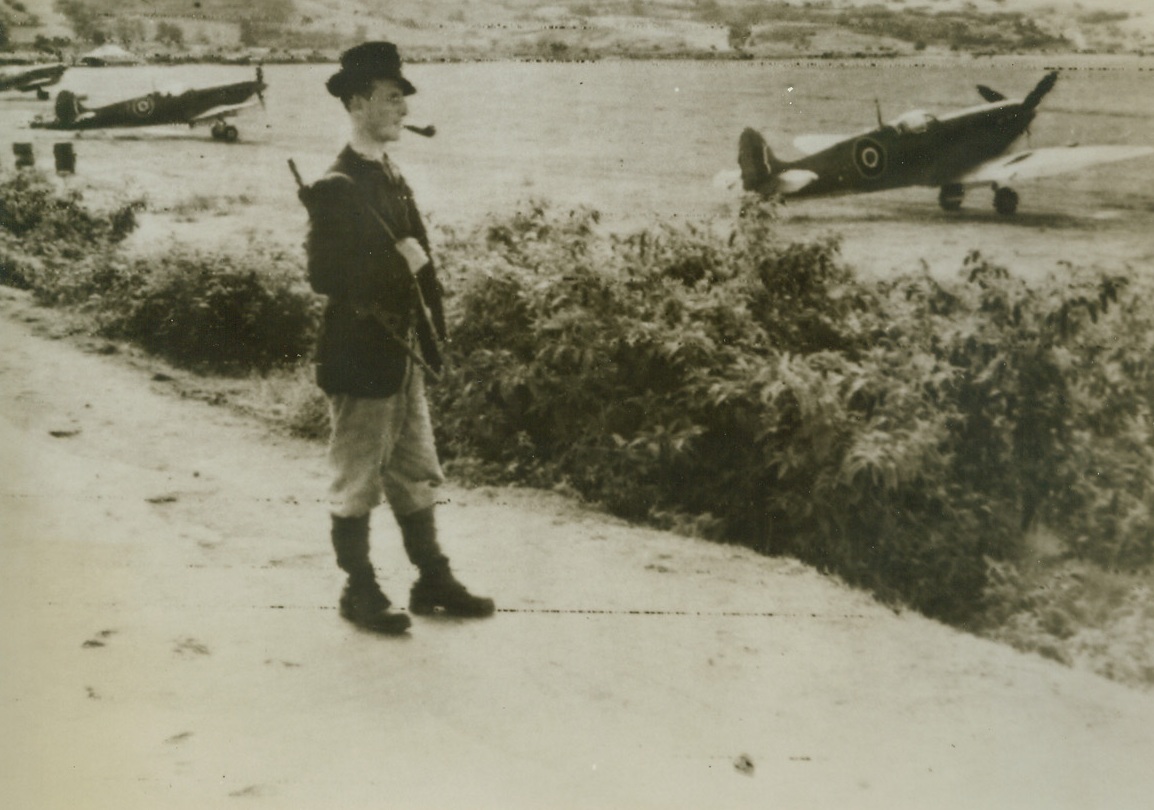
ON GUARD, 10/22/1943. CORSICA—A Corsican patriot, a gun slung over his shoulder, his pipe in his mouth, stands guard beside a group of Spitfires at an airfield in Corsica. Photo radioed to New York from Algiers today (October 22nd). Credit: R.A.F. photo via OWI from Acme;
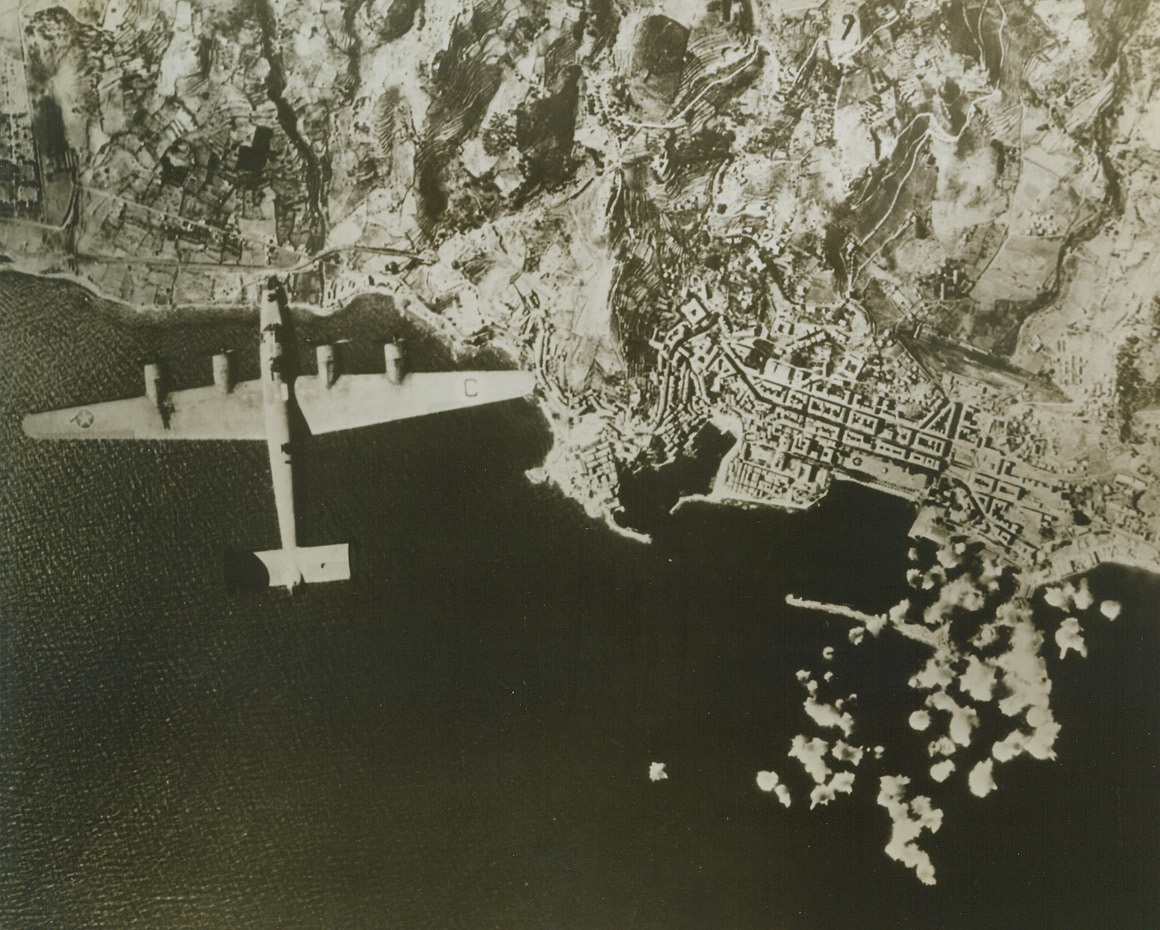
LIBERATORS BOMB CORSICA, 10/22/1943. BASTIA, CORSICA—More than fifty bomb bursts may be seen in the upper left harbor and on dock facilities at Bastia, as Liberators of the U.S. Army Air Forces raid the Corsican port. Hits were made on a large merchant vessel, three small merchant ships, and in the railroad yards. This remarkably clear photo shows the methods of contour farming that are practiced in many parts of the Mediterranean. Credit: U.S. Army Air Forces photo from Acme;
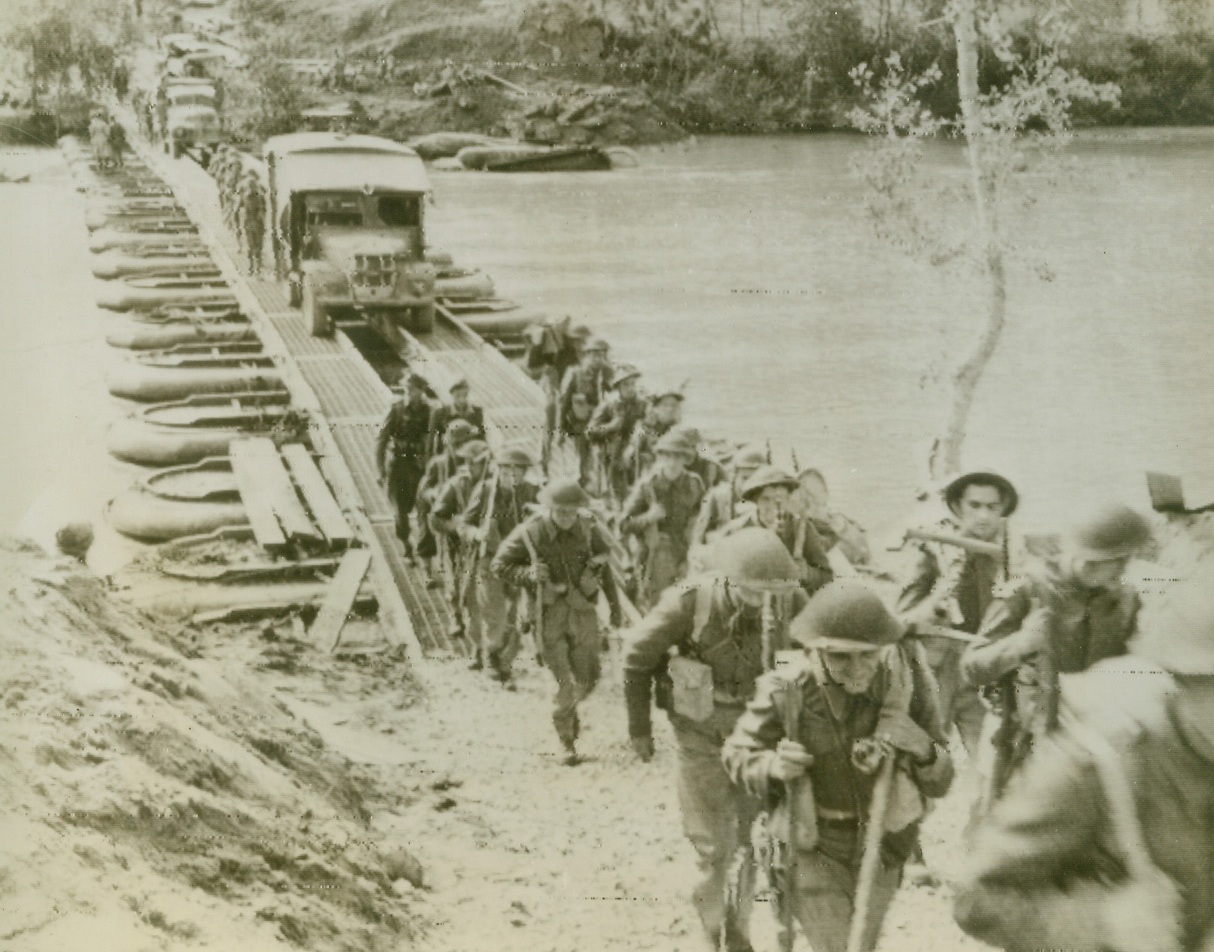
BRITISH PUSH AHEAD, 10/21/1943. ITALY—Pushing ahead in Italy, British Infantrymen tramp across a pontoon bridge, spanning the Volturno River, that was built by American engineers. Photo radioed to New York from Algiers today (October 21st). Credit: Acme radiophoto;
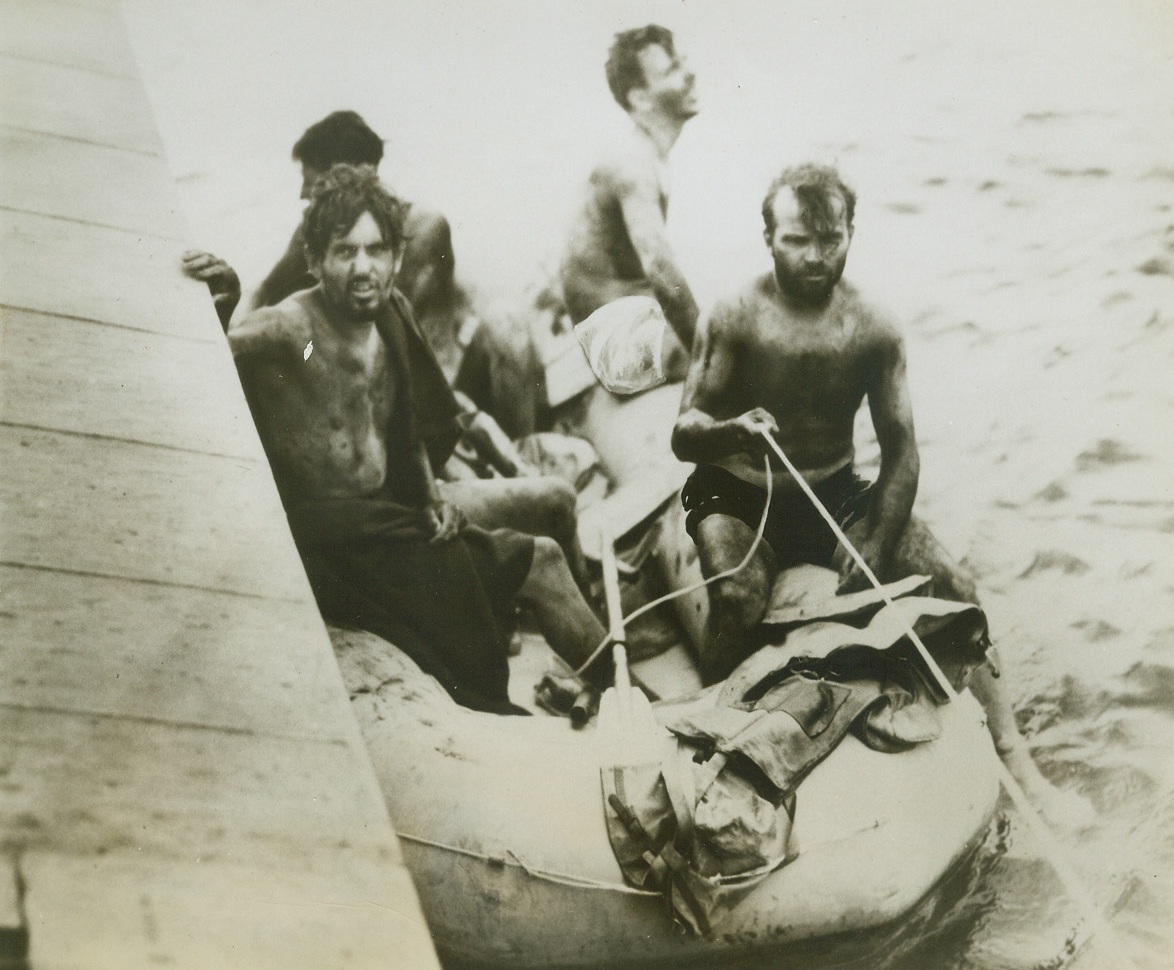
COAST GUARD OFFICER REWARDED FOR RESCUES, 10/21/1943. For rescues such as this one, in which seven German survivors of a destroyed U-boat were saved, Commander Richard L. Burke, commanding officer of the U.S. Coast Guard Air Station at Elizabeth City, N.C., won the Distinguished Flying Cross. In this photo, four of the seven Nazis are about to be hauled aboard the rescue plane. Credit: U.S. Coast Guard photo from Acme;
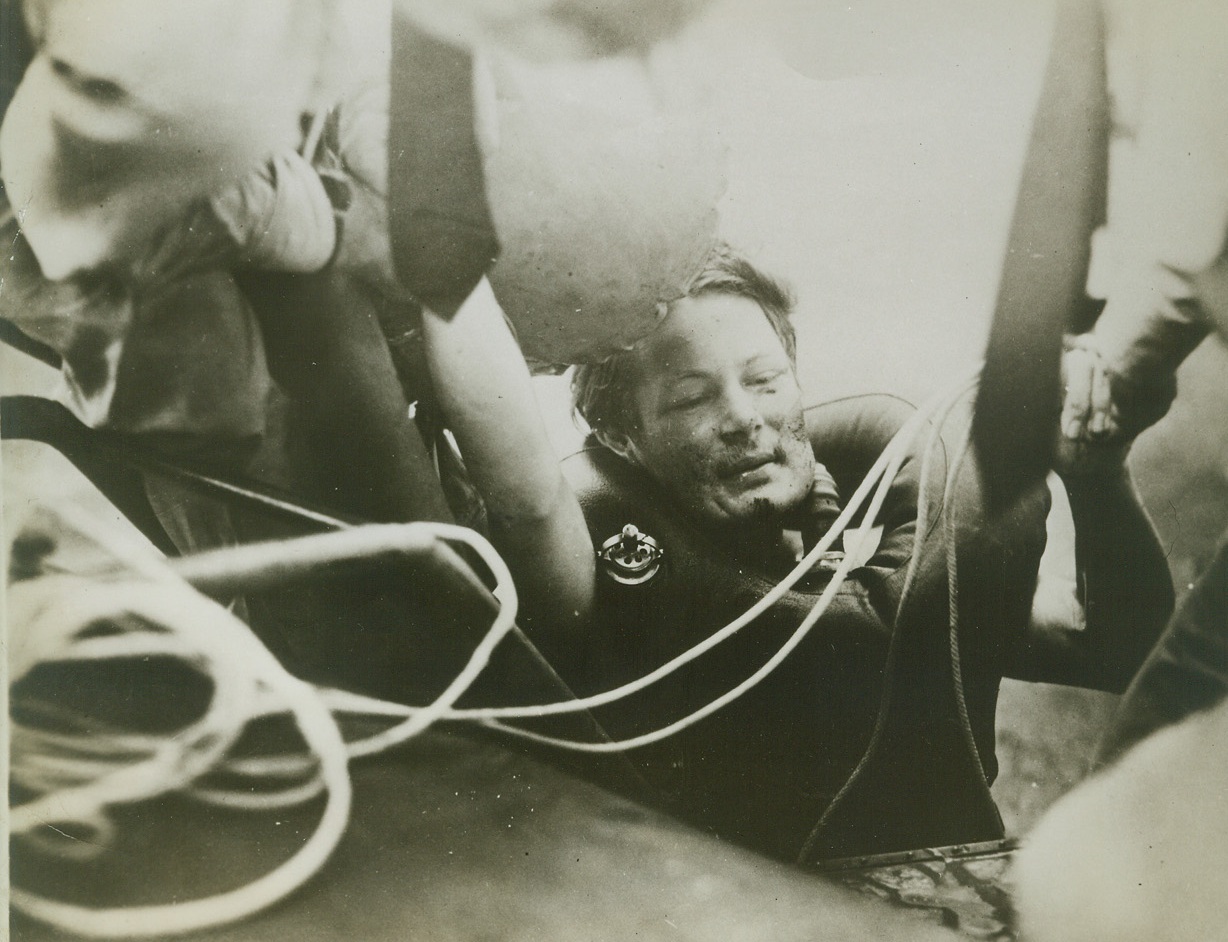
COAST GUARD RESCUES GERMAN U-BOATMAN, 10/20/1943. WASHINGTON, D.C.—A German submarine man, one of seven rescued, is hauled up a pontoon of the Coast Guard plane that rescued him. He wears an escape lung. For this rescue, and for successfully performing other dangerous flight missions, the Distinguished Flying Cross was awarded to Commander Richard L. Burke of the Coast Guard by Navy Secretary Frank Knox. Credit: U.S. Coast Guard photo from Acme;
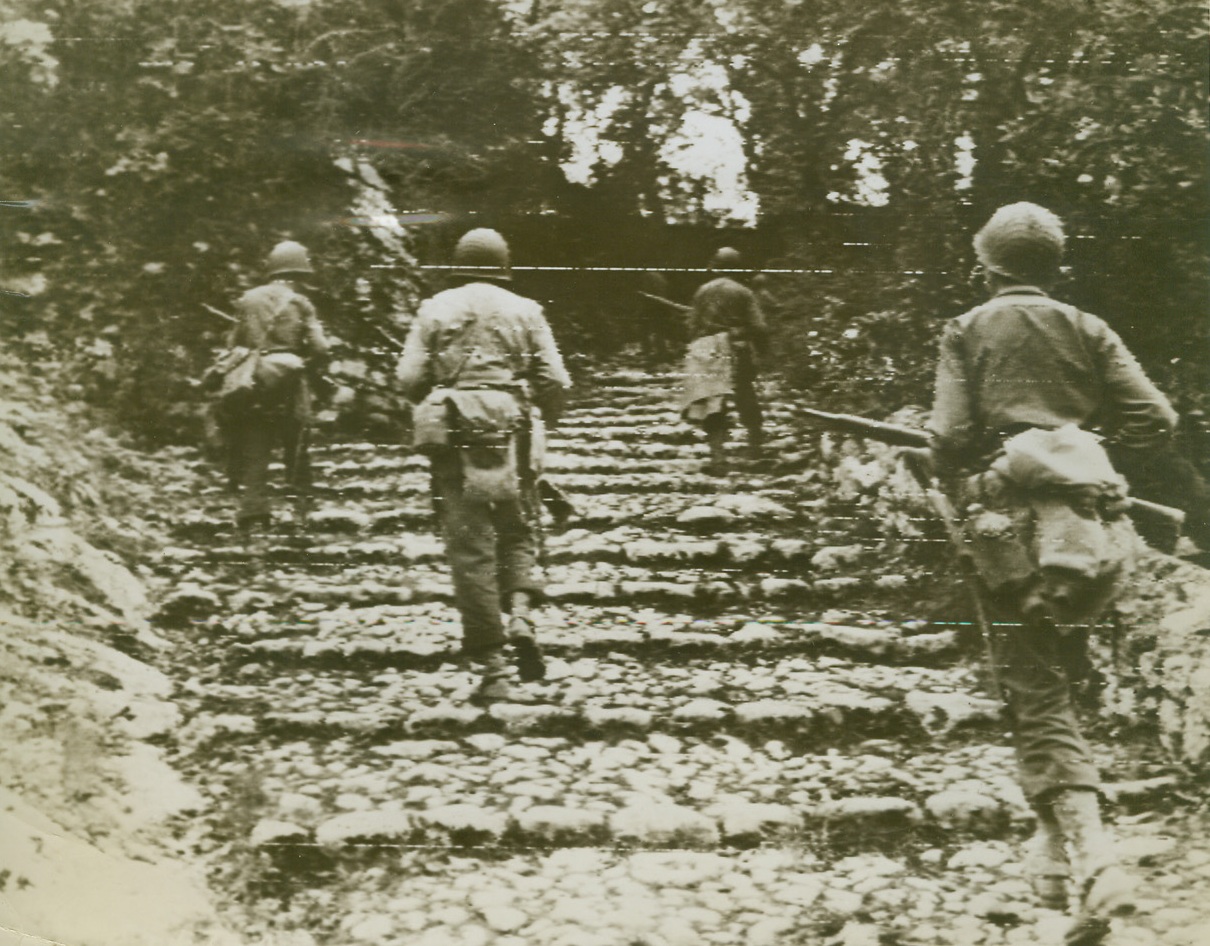
AFTER THE GERMANS, 10/20/1943. CAIZZO, ITALY—An American infantry patrol, their guns held ready, advances double time up a flight of steps in the outskirts of Caizzo, in pursuit of fleeing German troops. Today, Nazi forces are retreating to a new mountain line along Massico Ridge, after shooting civilians and burning farms in the Volturno Valley. This photo was flashed to the United States today. Credit: U.S. Signal Corps radiotelephoto from Acme;
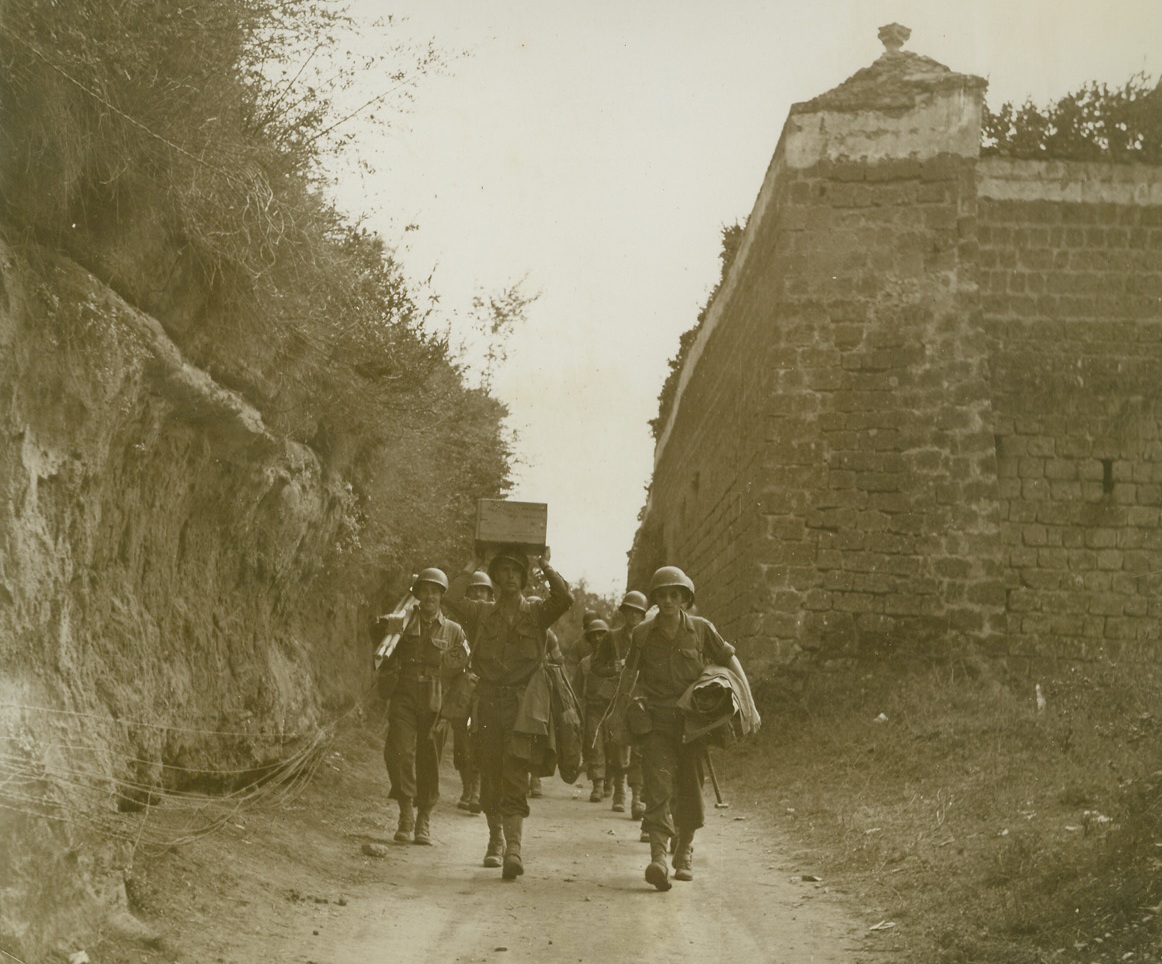
ANSWERING THEIR BUDDIES’ S.O.S, 10/24/1943. ITALY—Medical aid men move forward on the double to a company covering the Volturno River bank where their help is urgently needed. The battle for that water defense line is being waged a short distance away. Credit: Acme photo by Bert Brandt, War Pool photographer;
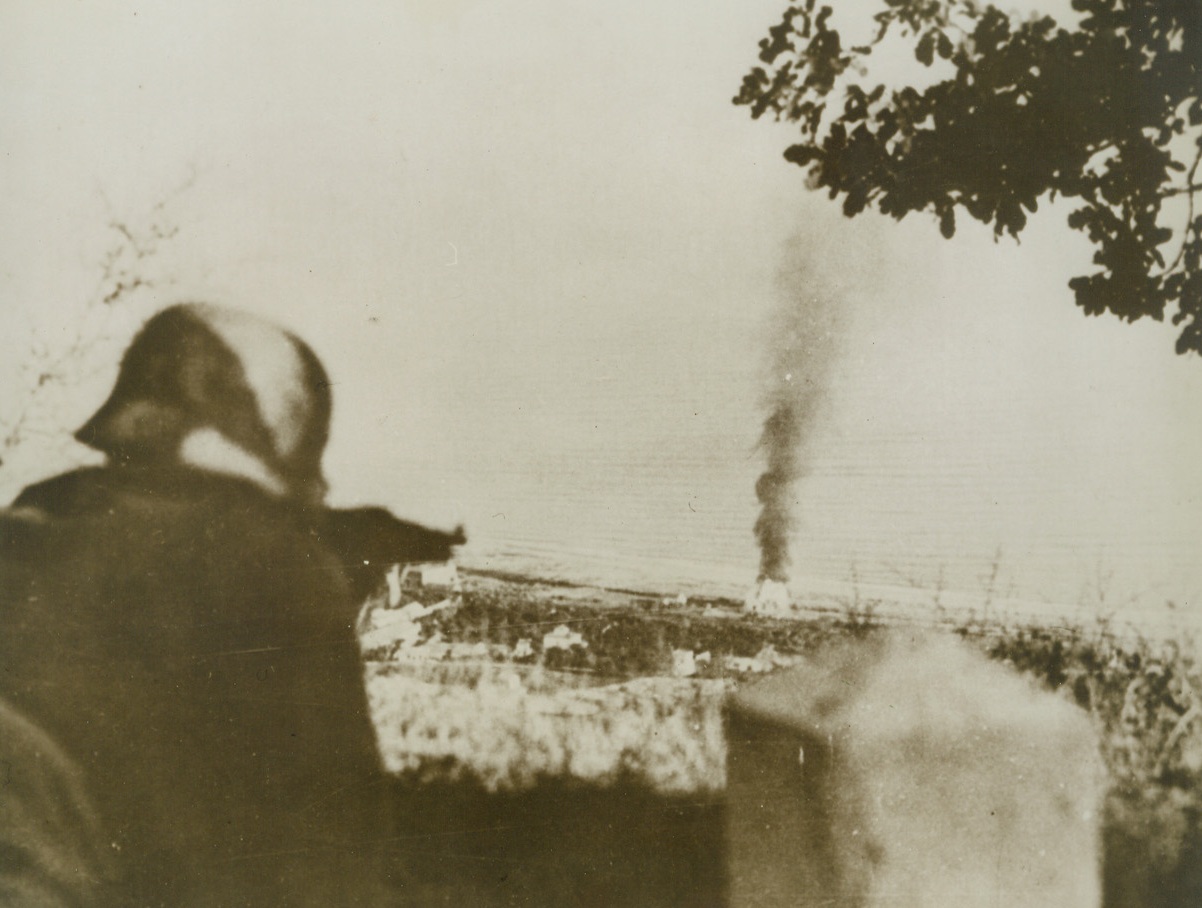
BIG JOB ON HIS HANDS, 10/24/1943. ITALY—A Nazi soldier, defending the southern coastline of Italy against Anglo-American invasion, fires at the crew members of an Allied tank who abandon their vehicle which was blasted by anti-tank shells. This caption accompanied the photo from Lisbon. Credit: Acme;
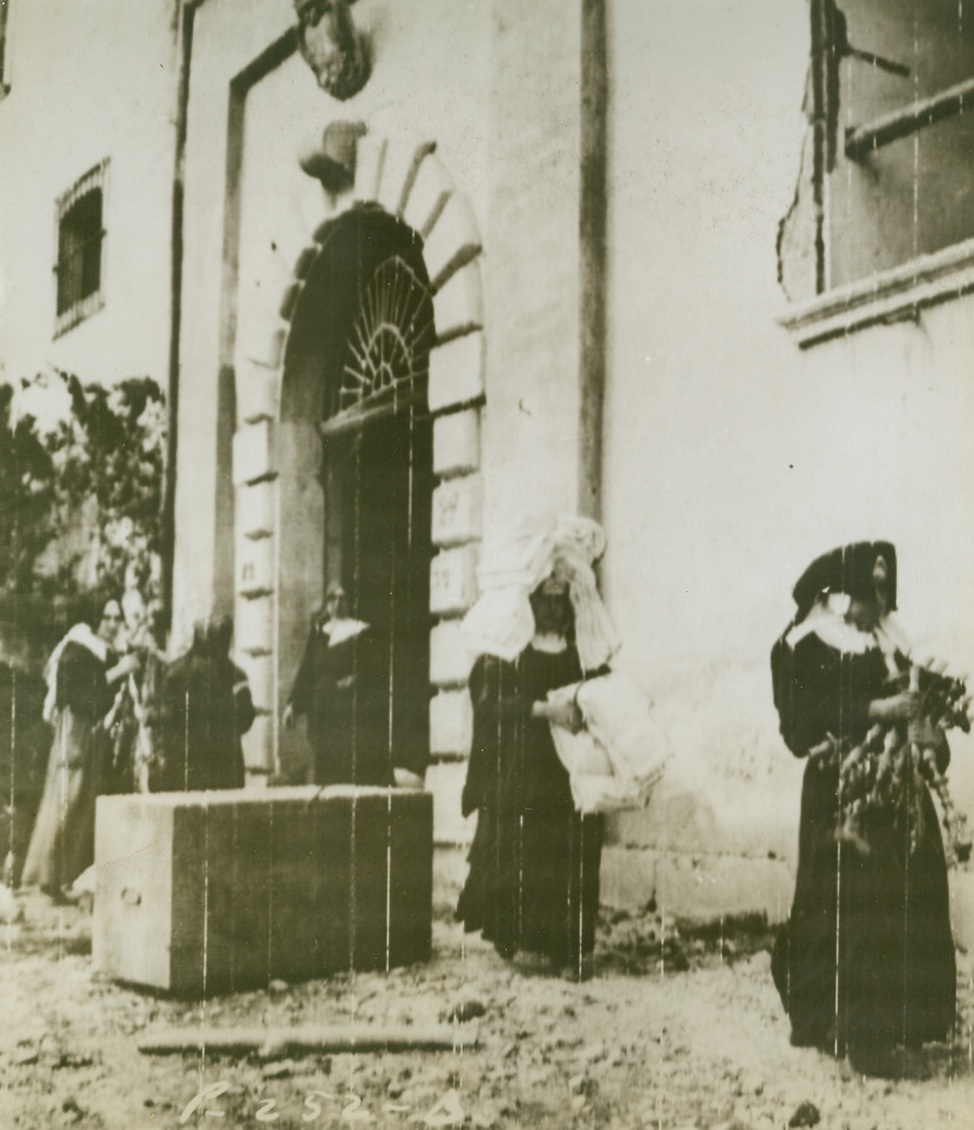
REMOVING RELIGIOUS ARTICLES FROM WRECKAGE, 10/23/1943. These nuns are shown removing religious articles from a church in Faicchio, Italy, which was badly damaged by artillery fire while Allies were taking town from Germans. Credit: Signal Corps radiotelephoto from Acme;
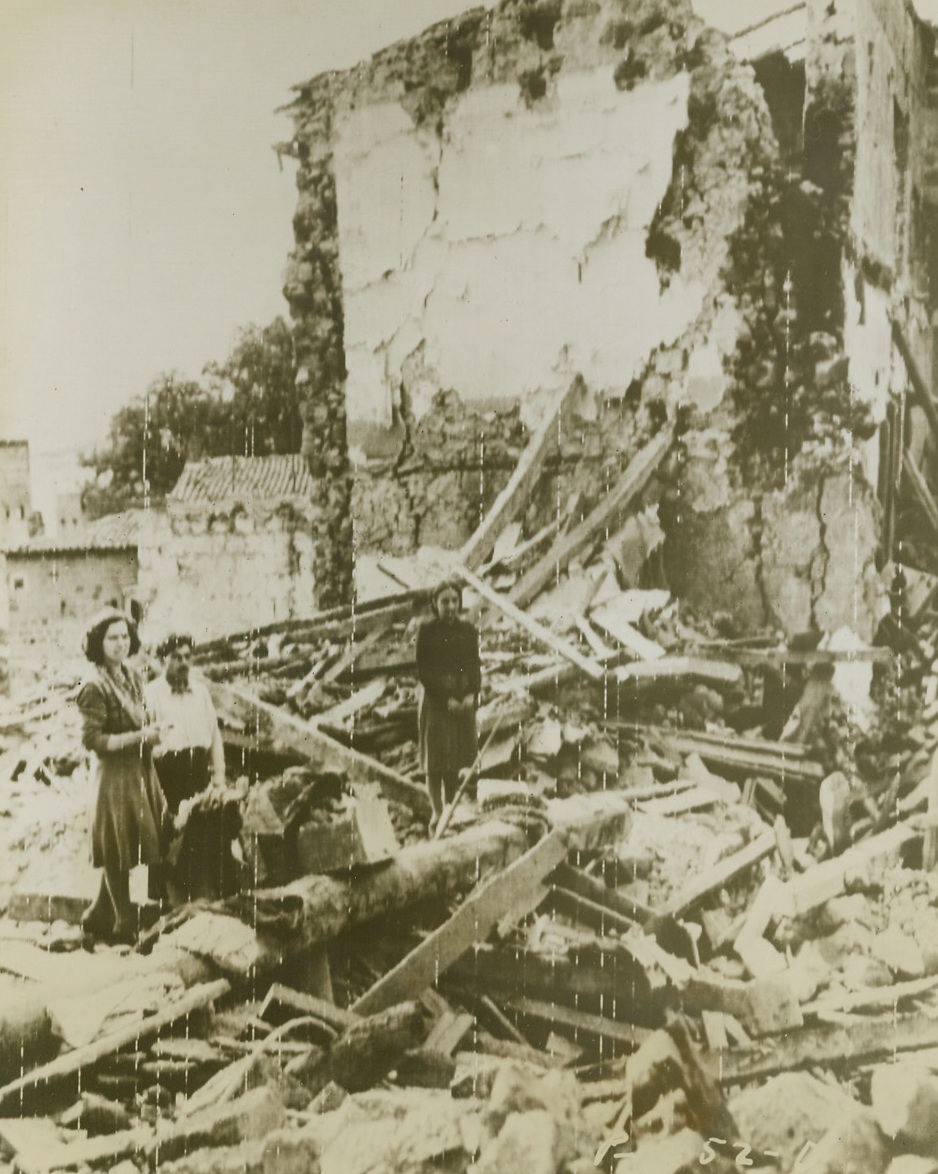
BATTLE WRECKAGE, 10/23/1943. This family returned to what remains of their home after the battle for Faicchio, Italy, was won by Allied troops. Credit: Signal Corps radiotelephoto from Acme;
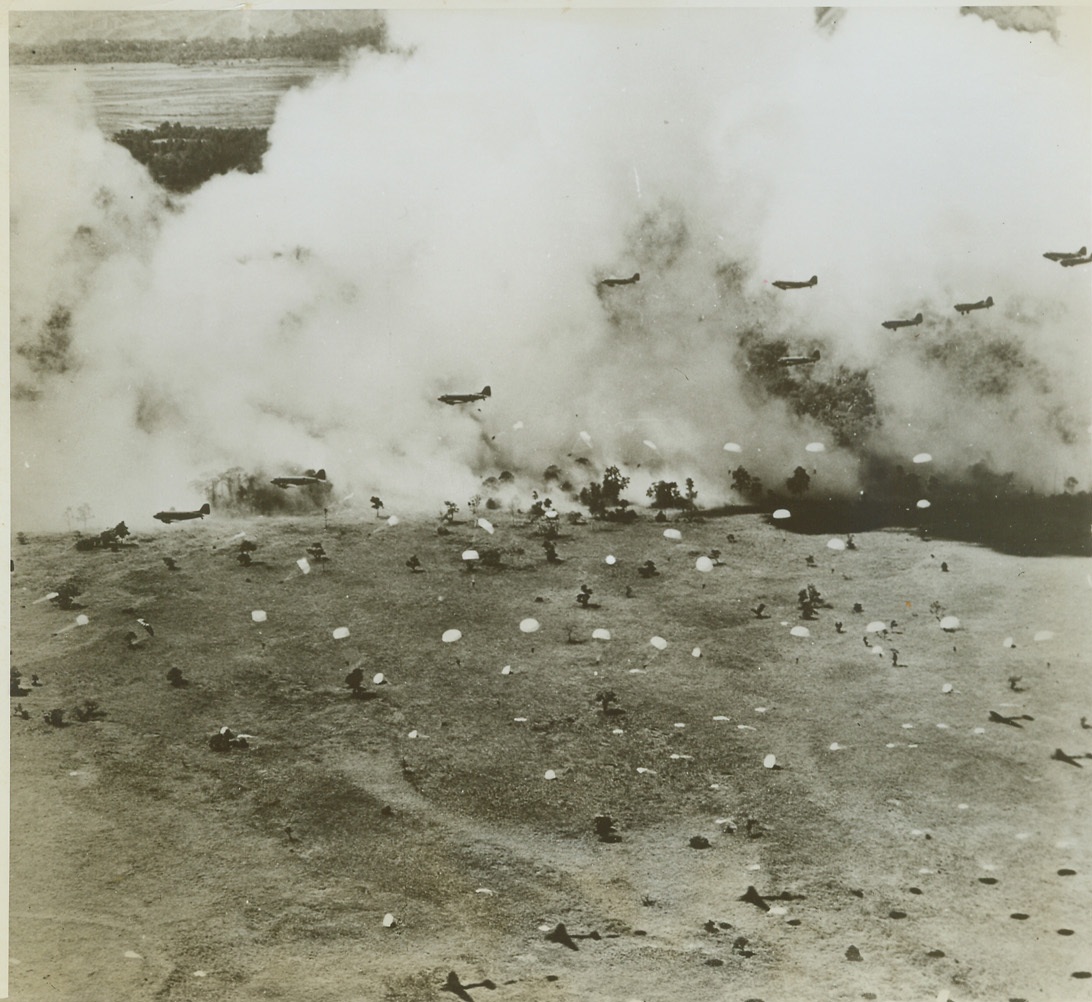
"Treetop Bail-Out" at Lae, 10/21/1943. Against a background, formed by a smokescreen laid down by Boston bombers, U.S. Army paratroopers bail out near Lae, New Guinea, from almost treetop altitude. After landing, the paratroopers captured the Jap air strip at Lae, which led to the Nipponese defeat in the area. In the photo, 11 huge American transports can be counted, many parachutes can be seen in the air, and flattened 'chutes on the ground (right, foreground) mark where paratroopers have landed. Credit: (U.S. Army Air Forces Photo from ACME);
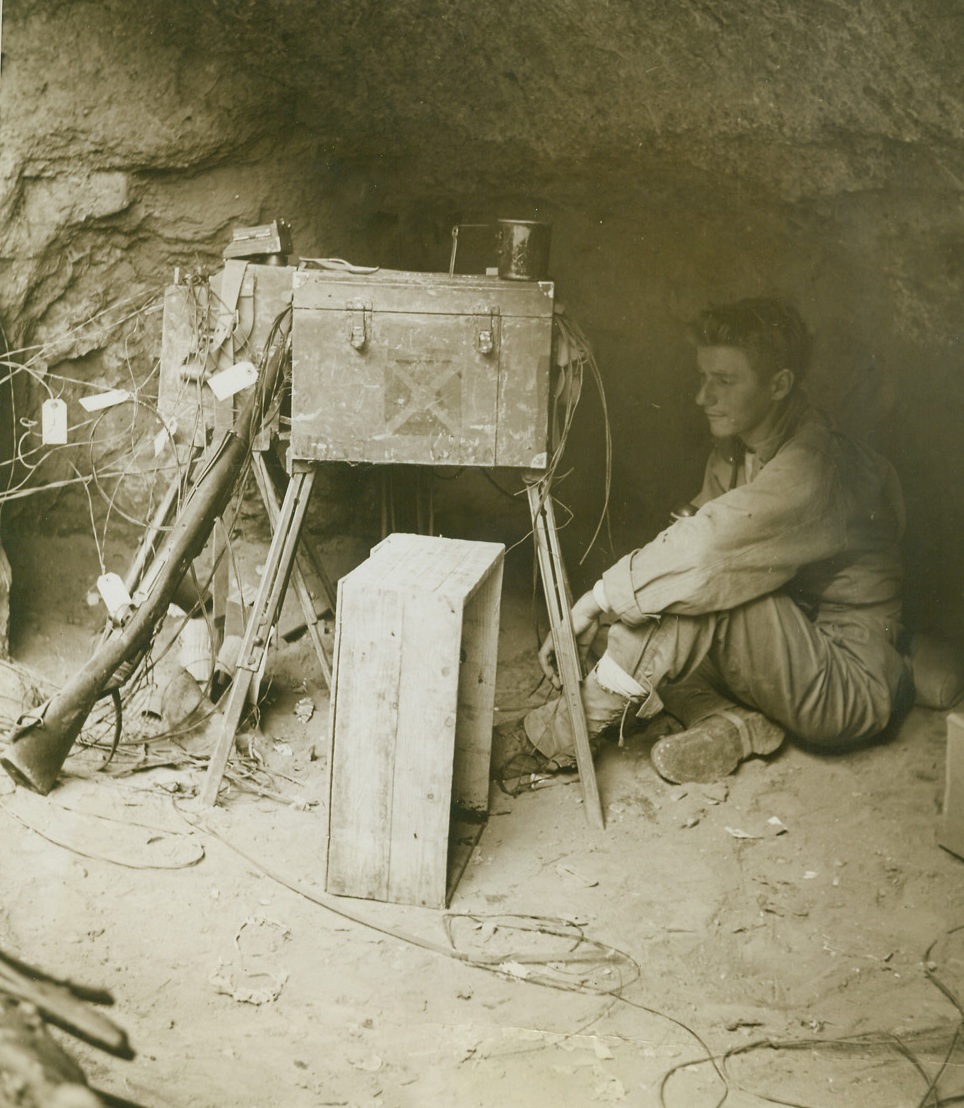
NOISY SWITCHBOARD, 10/24/1943. ITALY—Pvt. Thomas Krezan, of Slickville, Pa., operates as middleman between the Allied front line units and headquarters, during the 5th Army fight to span the Volturno. With his telephone switchboard, he is dug in only 800 yards from the river. Credit: Acme photo by Bert Brandt, War Pool Photographer;
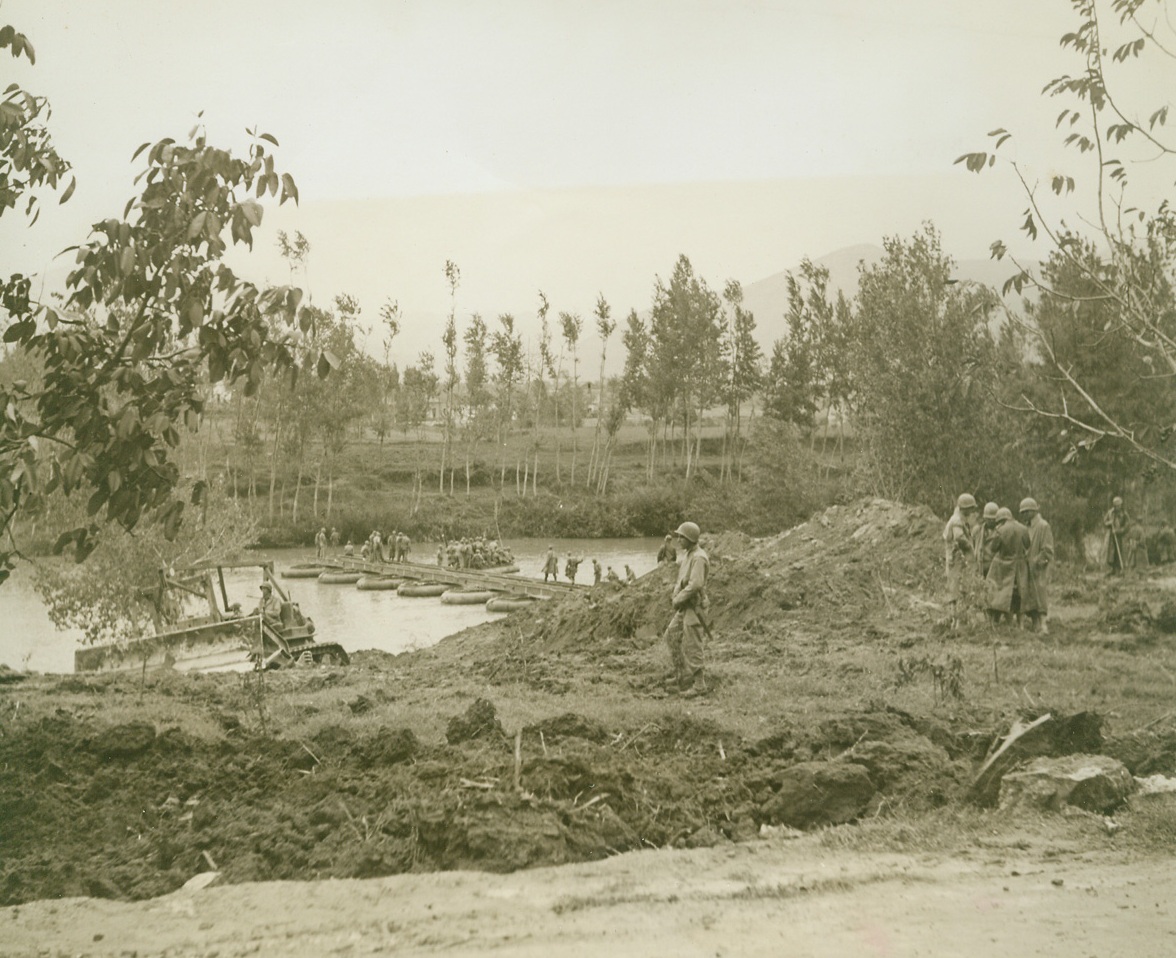
NAZI HOPES DROWNED IN THE VOLTURNO, 10/25/1943. ITALY—When 5th Army troops splashed, paddled, or swam across the Volturno, more than a river was lost to the Germans. The Nazis learned in blood that their natural barrier defense system wouldn’t work. To further consolidate this message of Axis defeat, crack American engineers immediately floated a pontoon bridge across the shallow river so that heavy Allied equipment could rumble on the heels of the advanced infantry forces who had begun the job of dislodging the enemy. These photos tell the story of that bridge which, in reality, may be called a road to victory in Italy for the Allies. NEW YORK BUREAU While 5th Army engineers speedily lay each pontoon section of the bridge in place, a bulldozer chews up and removes the earth on the foreground bank of the Volturno, where a tank approach to the floating roadway is speedily constructed. Credit: Acme photo by Bert Brandt, War Pool Corresponden;
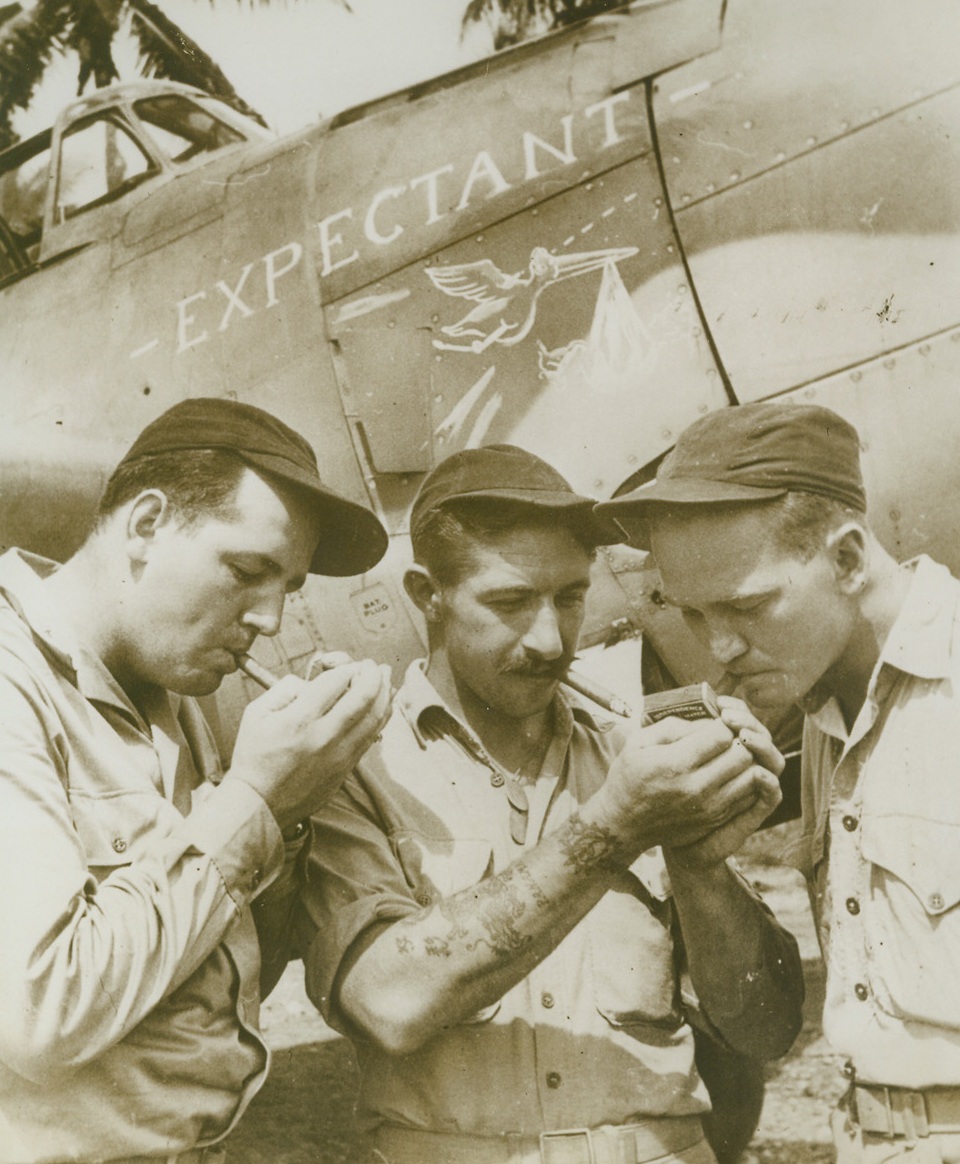
THESE “AVENGERS” ARE “EXPECTANT”, 10/25/1943. GUADALCANAL, S.I.—This Grumman “Avenger” torpedo bomber is named “Expectant” because the members of its three-man crew expect to be fathers before the end of the eyar. The fathers-to-be are (left to right) Marine Maj. Rolland F. Smith, Laguna Beach, Calif.; Sgt. Jack N. Stanner, radioman and gunner, Niles, Mich.; and Sgt. Irwin F. Waldvogel, turret gunner, of Cicero, Ill. Credit: Official Marine Corps photo from Acme;
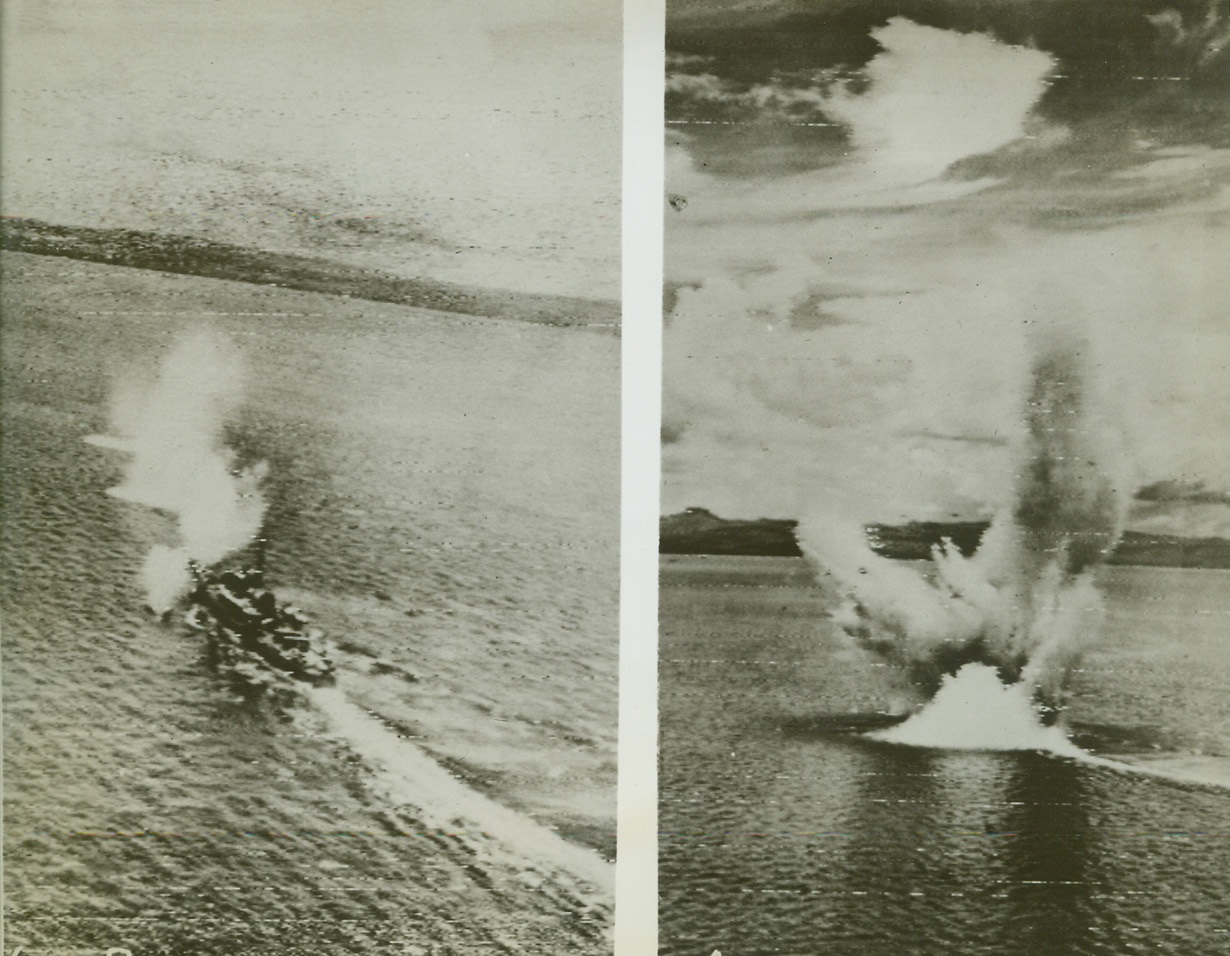
THREE STRIKES AND OUT, 10/22/1943. SOUTH PACIFIC—Yank B-25 Mitchells score near misses on a Jap corvette (left), which tries frantically to dodge the death from the sky. In the right hand photo, the enemy ship disappears amid a terrific explosion as a 1,000-pound bomb scores a direct hit. The action takes place near Rabaul;
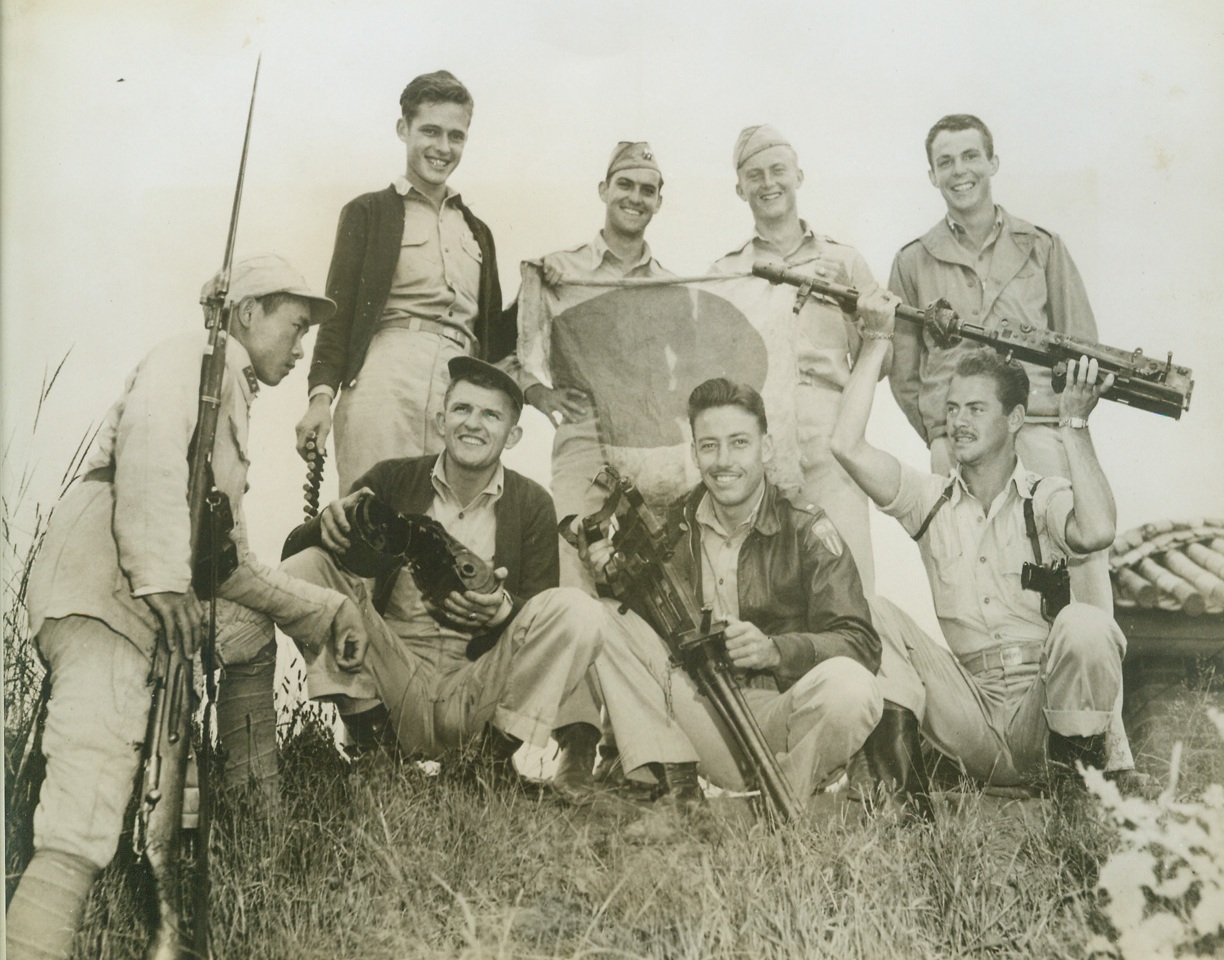
THEY SLUGGED IT OUT, 10/22/1943. CHINA—These smiling fighter pilots slugged it out with Jap airmen when the Nips called at the headquarters airfield of Gen. Chennault’s 14th Air Force. Although the Japs intended to wipe out the airfield, in celebration of their “Aviation Day” (Sept. 20th), they suffered the heaviest losses they’ve ever had in air combat over China. Chatting with a Chinese soldier, the airmen exhibit trophies of the raid: (left to right) front row: Capt. Matthew Gordon, Pueblo, Col., who shot down 1 confirmed and 1 probable; Lt. Curtis L. Scoville, Kansas City, Mo., who got one bomber; Lt. Don Glover, Olympia, Wash., one bomber; rear: Lt. Donald Brookfield, Bryn Mawr, Pa., 1 bomber, 1 Zero; Capt. Roger Pryor, Starkville, Miss., 2 confirmed and 2 probables; Lt. Vernon Tanner, Dallas, Tex., one bomber; and Capt. William Grosvenor, Providence, R.I., 2 confirmed and 2 probables. Credit: Acme;
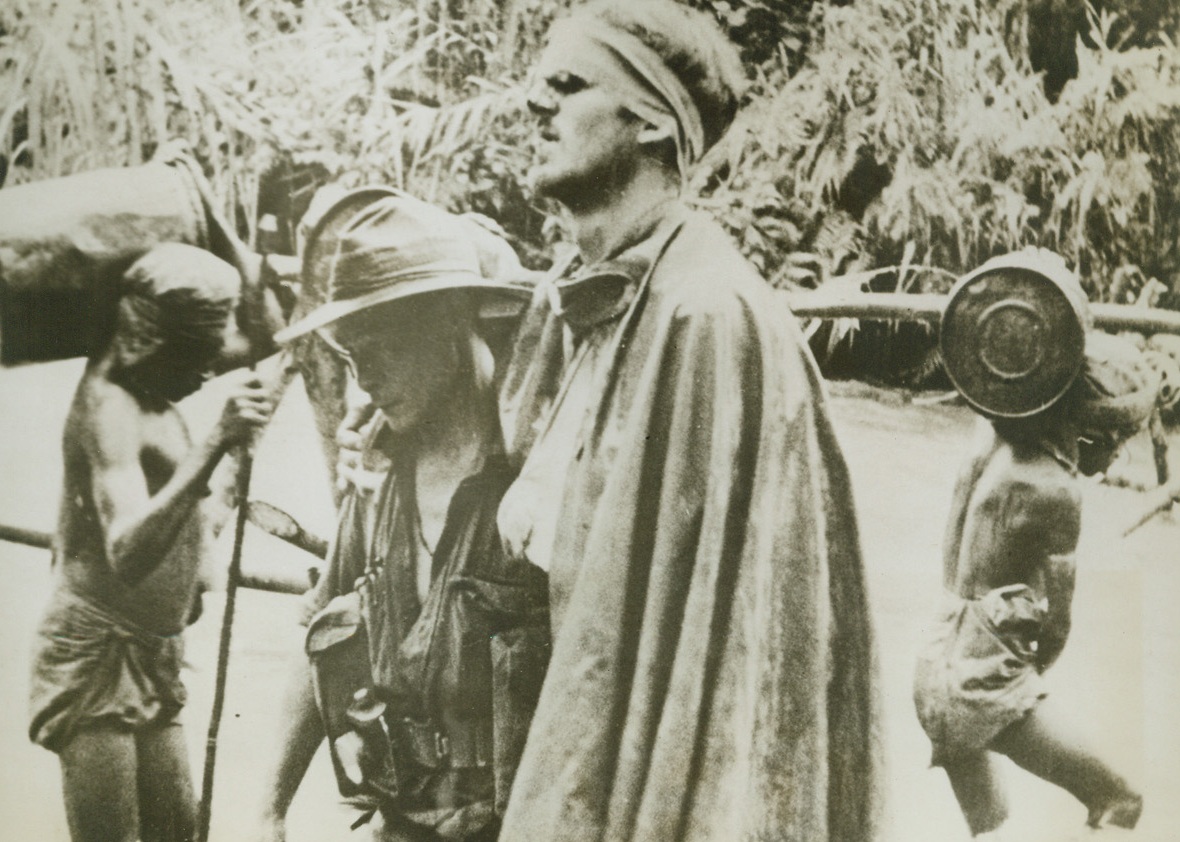
COMRADES AT ARMS, 10/21/1943. NEW GUINEA—A wounded Allied soldier grasps the shoulder of Sgt. Gordon Ayres, of Shepparton, Victoria, who helps him across a creek to a dressing station. This action, during the advance on Salamaua, New Guinea, takes place in a drenching rainstorm. Credit: Acme;
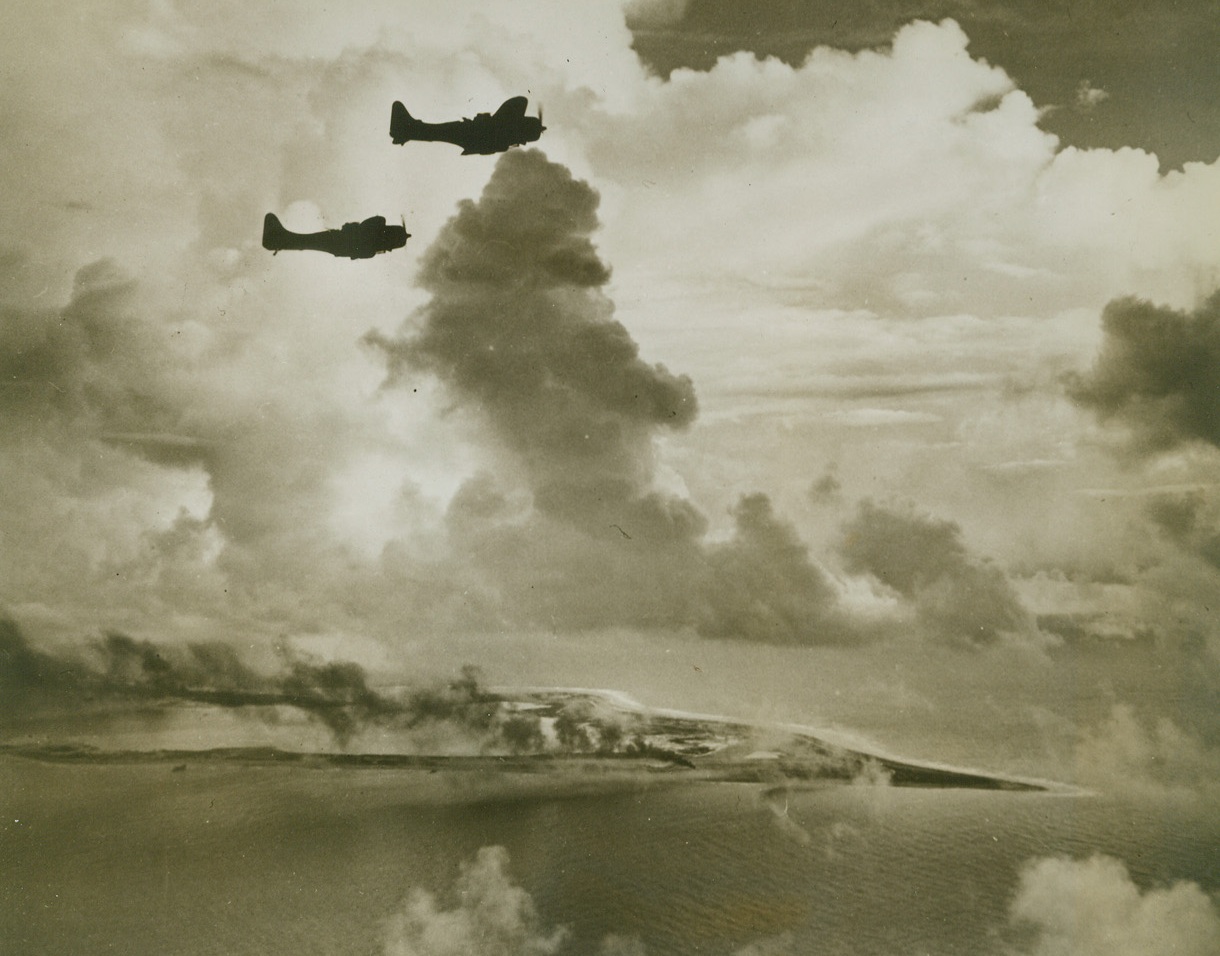
REVENGE AT WAKE, 10/25/1943. WAKE ISLAND—Two Douglas Dauntless dive bombers roar over Wake Island before wheeling down to drop their bombs, October 6, when a U.S. carrier task force destroyed 61 Jap planes, many ships, barracks and other installations. Before the day ended, the enemy island base was a shambles. Credit: U.S. Navy photo from Acme;
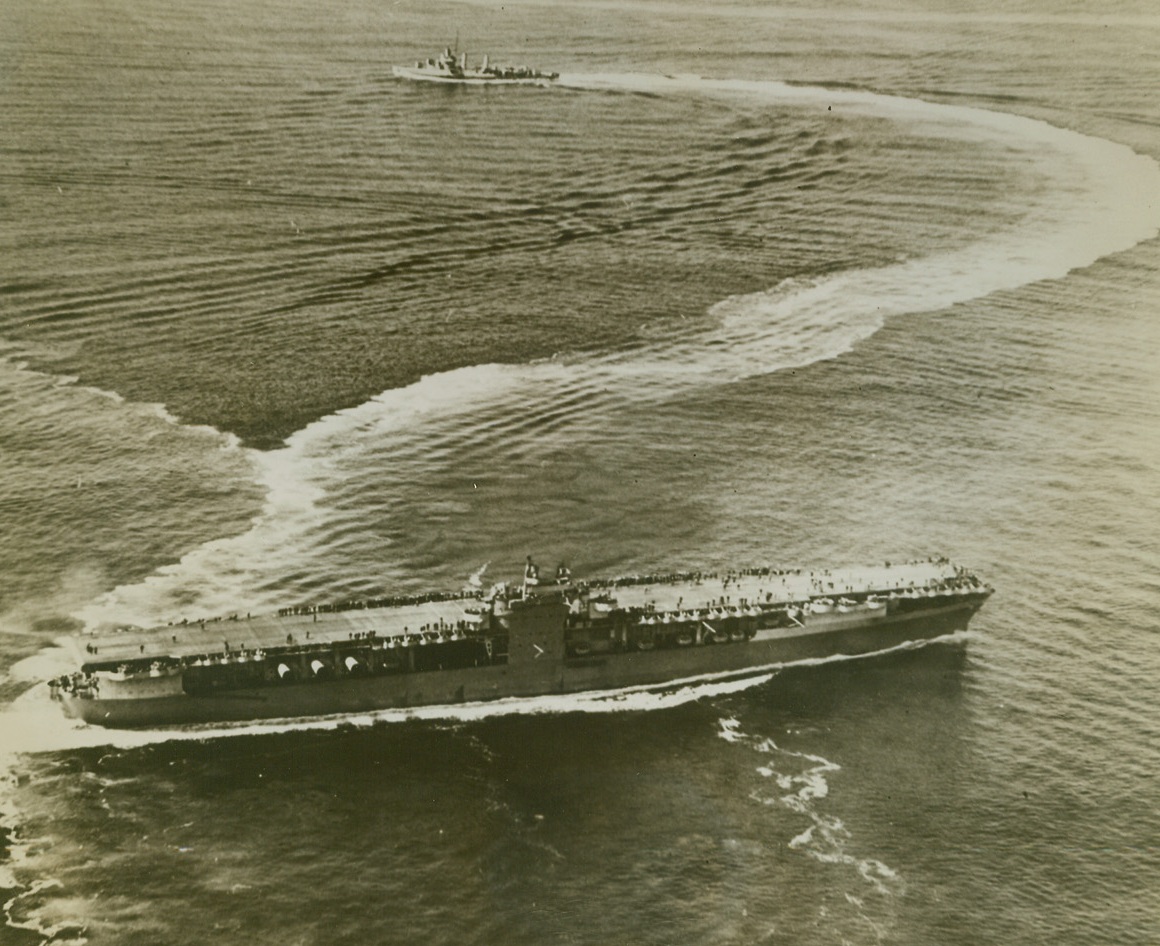
SMALL ESCORT FOR BIG CRAFT, 10/22/1943. AT SEA—One would think that an escort should be bigger and stronger than its charge, but in naval warfare a smaller, and for that reason swifter, escort is desirable. From one of the planes flying above an aircraft carrier, comes this interesting camera study of a modern flat-top and one of its destroyer escorts. Credit: Official US Navy photo from Acme;
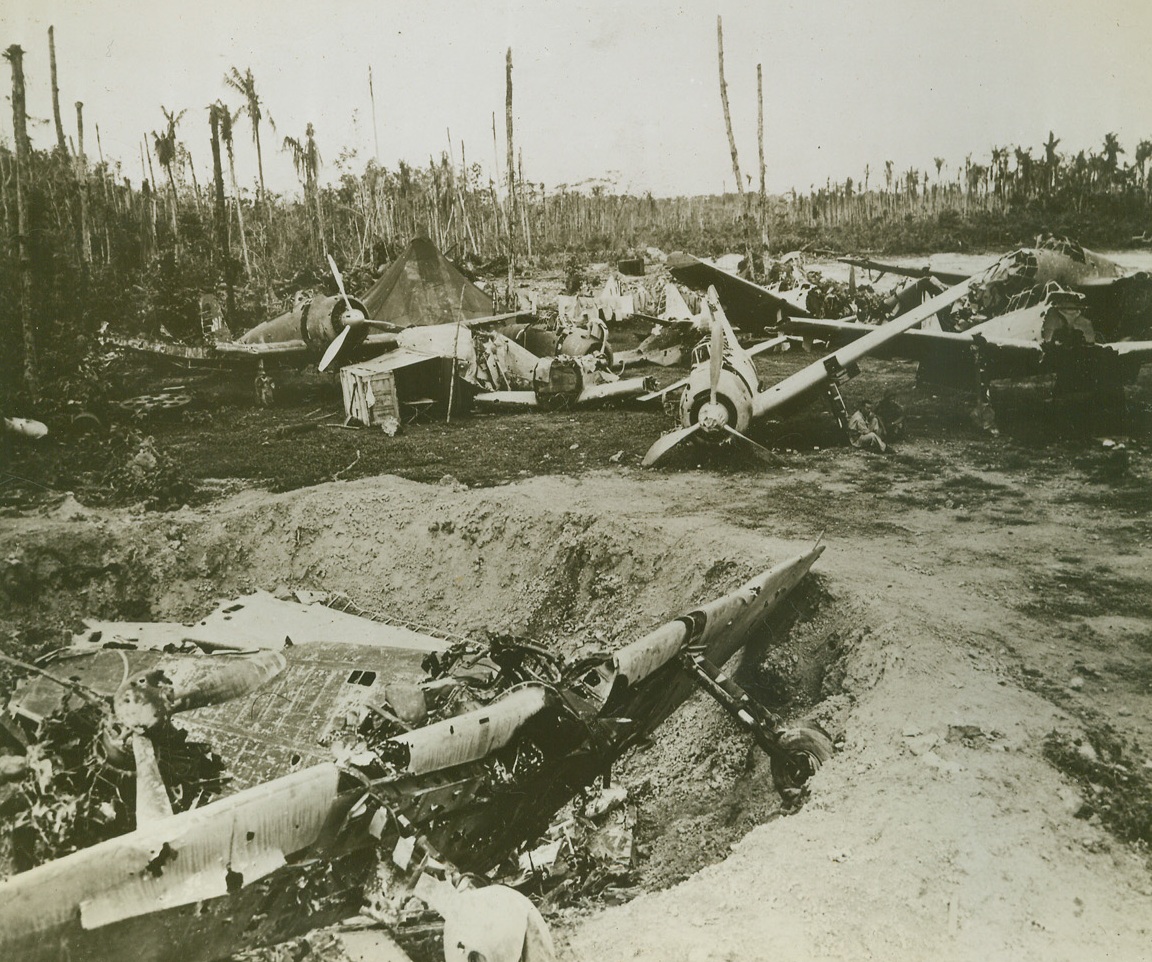
BONEYARD FOR JAP WARBIRDS, 10/9/1943. MUNDA—Wrecked Japanese planes, destroyed during the Allied battle for Munda, stretch across this war-torn field. The enemy warbirds were assembled for study by Marine aviation intelligence officers. Credit Line (Official U.S. Navy Photo from ACME);
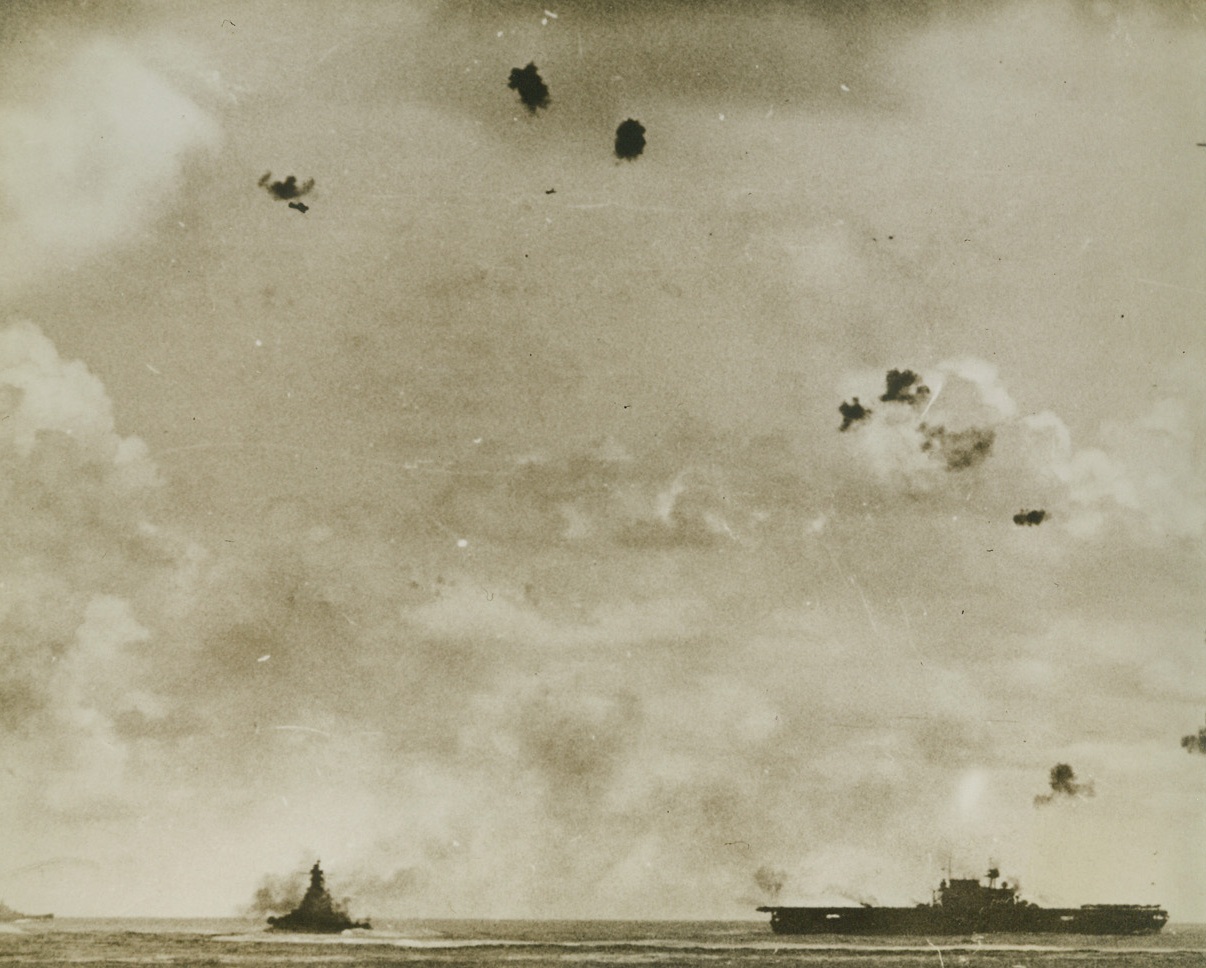
…the USS SOUTH DAKOTA, 10/2/1943. …bombers and torpedo planes attack…USS South Dakota, just revealed as the “Battleship X” of Guadalcanal fame, and the USS Enterprise in the Battle of Santa Cruz, October 26, 1942. The sky is filled with bursts of ack-ack fire from the Bofors and Oerlikon batteries of the U.S. battleship and aircraft carrier as they bring down scores of enemy planes. The South Dakota knocked 32 Jap planes out of the skies that day and the Enterprise accounted for 33. The latter’s score included the “kills” made by her planes as well as her anti-aircraft batteries. Credit Line (Official US Navy Photo from ACME);
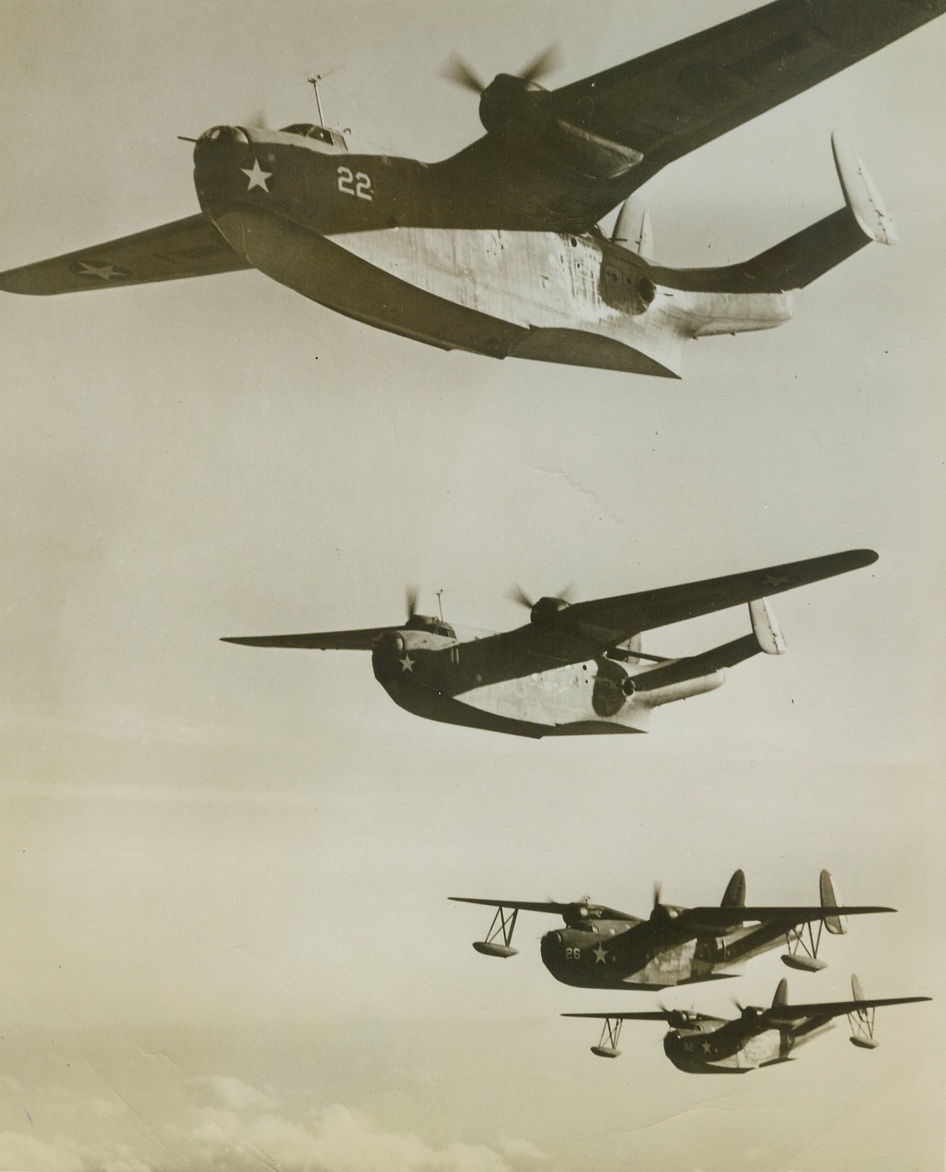
Warbirds of the Sea, 10/27/1943. Heavily armed and long in range, Martin Mariners serve the Navy well as patrol planes able to cover vast distances, and hit hard when the enemy is in sight, their sweeping lines provide a distinctive grace in flight. Credit: (Official US Navy Photo from ACME);
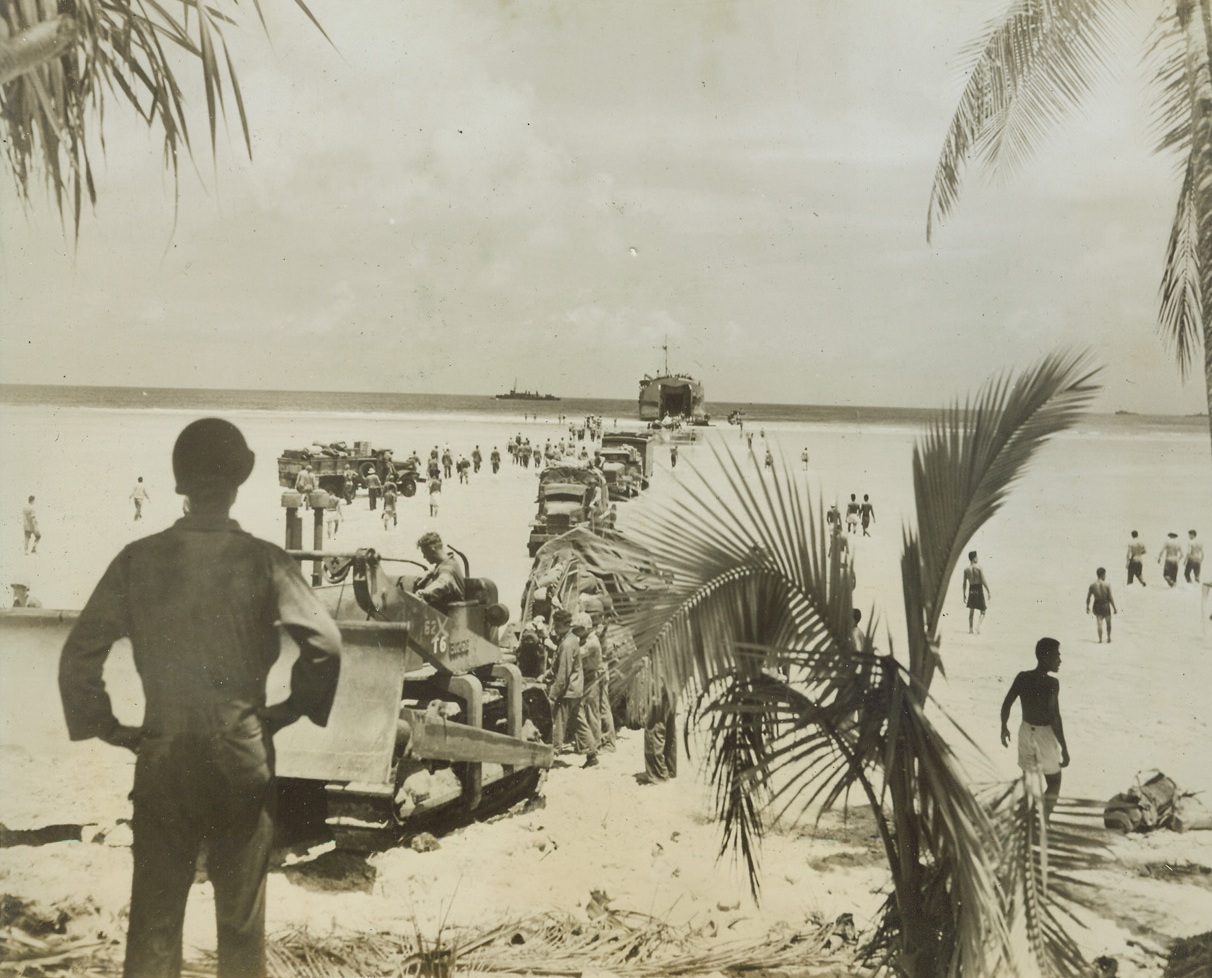
Marines Take Another Pacific Isle, 10/4/1943. Nanumea, Ellice Islands – United States Marines occupy the island of Nanumea, which looks like a tropical poster but is vitally placed for our Pacific offensive. Under protection of U.S. Destroyers, a stream of men and supplies comes ashore from a landing craft at the island in the Ellice group September 4. Credit: U.S. Marine Corps photo from ACME;
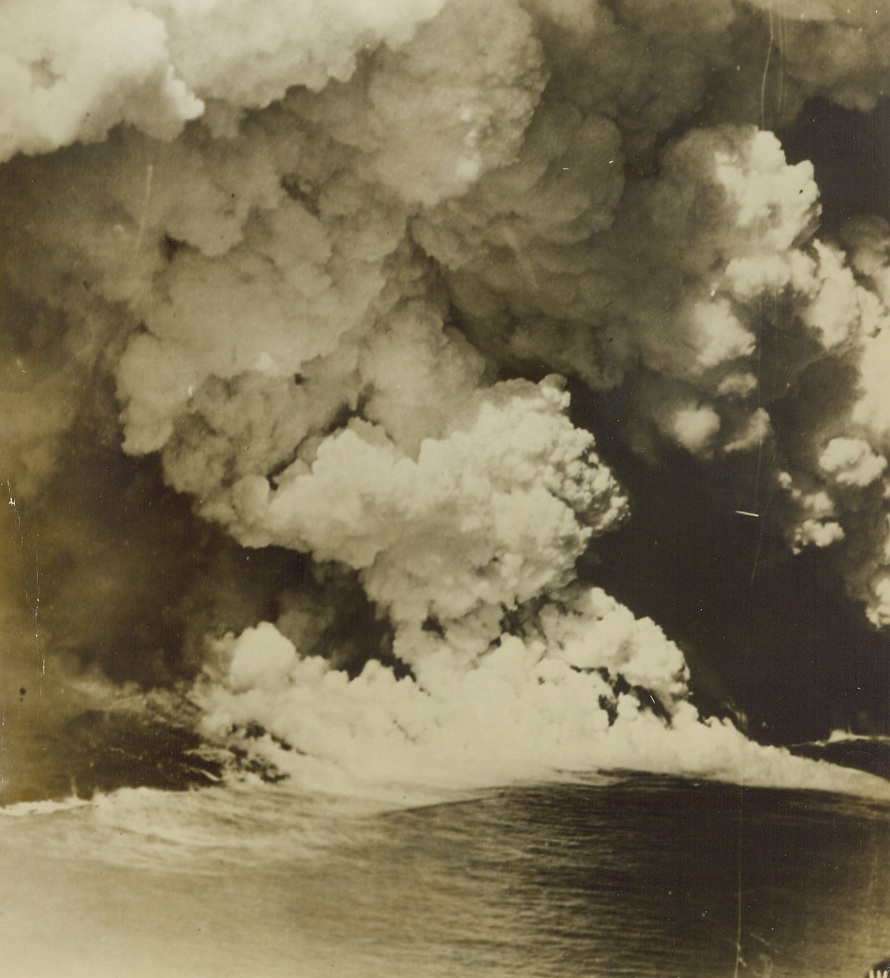
Nature Follows Suit, 10/14/1943. Not to be outdone by air raids and naval battles in the war-torn Pacific, Dame Nature staged a spectacular show of her own last Sept. 26 on Niuafoo Island, in the Samoan group, where this photo of a volcanic eruption was taken from a U.S. Marine transport plane. The last volcanic disturbance on the island, which is inhabited by 1,100 Polynesians, was in 1929 and the next one was not scheduled until 1945. Here, (photo above), smoke pillars 25,000 feet into the sky from a fissure a mile and a half long, while streams of lava pour into the sea. Credit: U.S. Marine Corps photo from ACME;
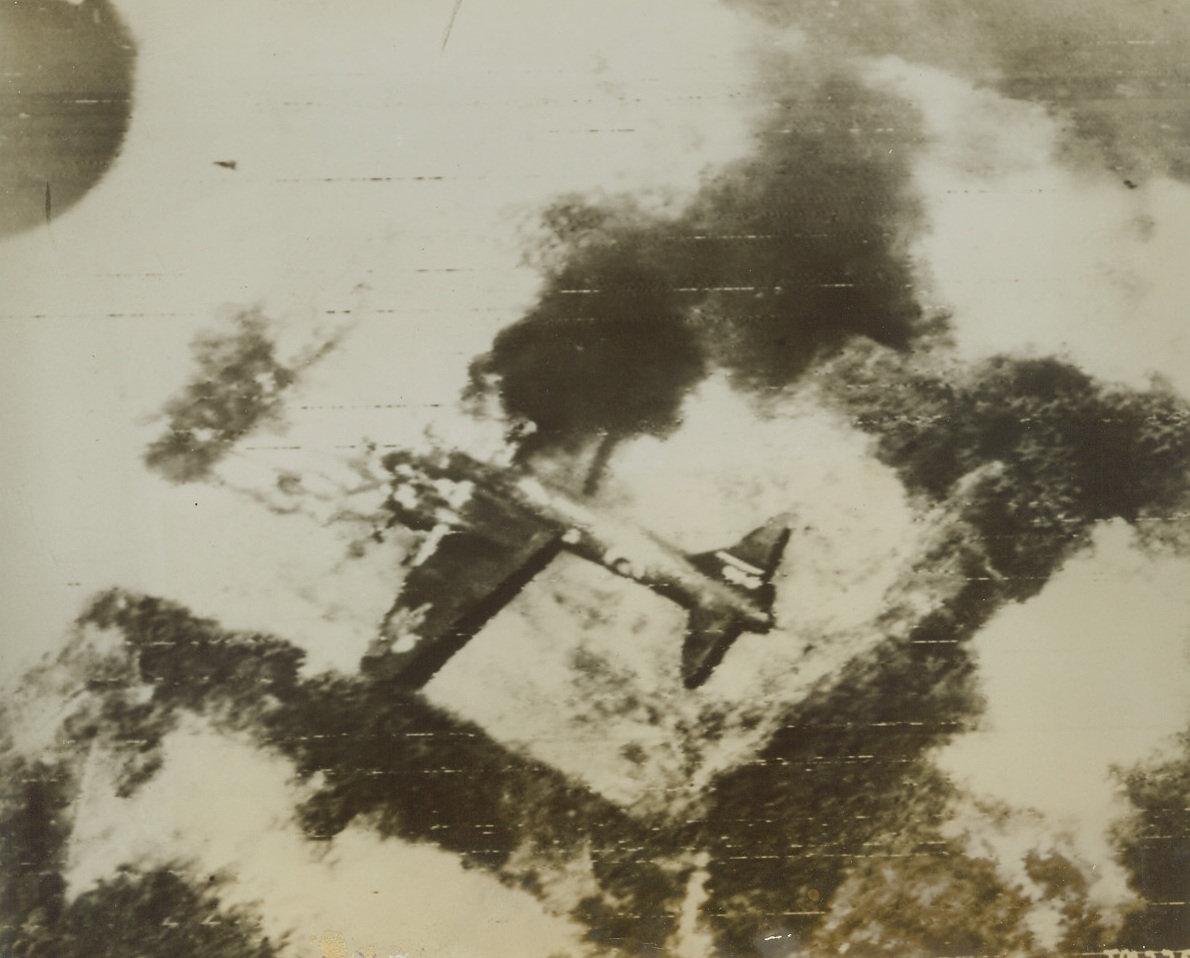
A Jap is “Scratched” at Rabaul, 10/14/1943. A Japanese Bomber in its revetment on the airfield at Rabaul, burns fiercely after it was hit by a bomb from Allied Air Raiders during this week’s devastating raid on the Nip’s powerful New Britain base. MacArthur’s airmen caught most of the Nip planes on the ground, destroying 177 of them – or about 60% of the air strength located there. Credit: U.S. Army Air Forces photo via Radiotelephoto from ACME;
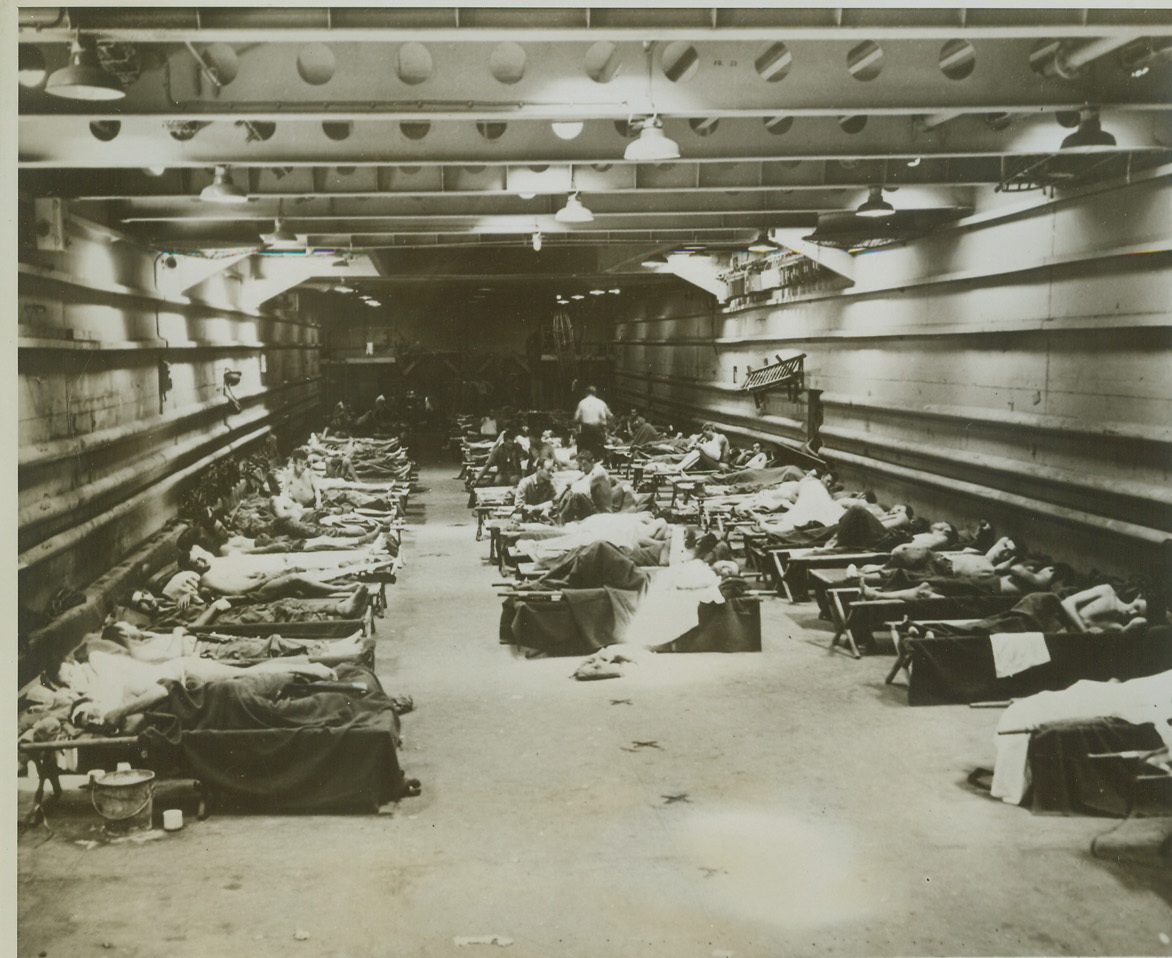
"Green Dragons" Become Hospital Ships, 10/21/1943. SOUTH PACIFIC -- This LST (Landing Ship Tanks), commonly called a "Green Dragon" because of its color and size, has been pressed into action as a hospital ship in the South Pacific carrying wounded from combat areas to base hospitals. These ships are seldom idle, for, on the trip to combat areas they carry men, supplies and equipment, and on the return trip they carry wounded. Credit: (U.S. Marine Corps Photo form ACME);
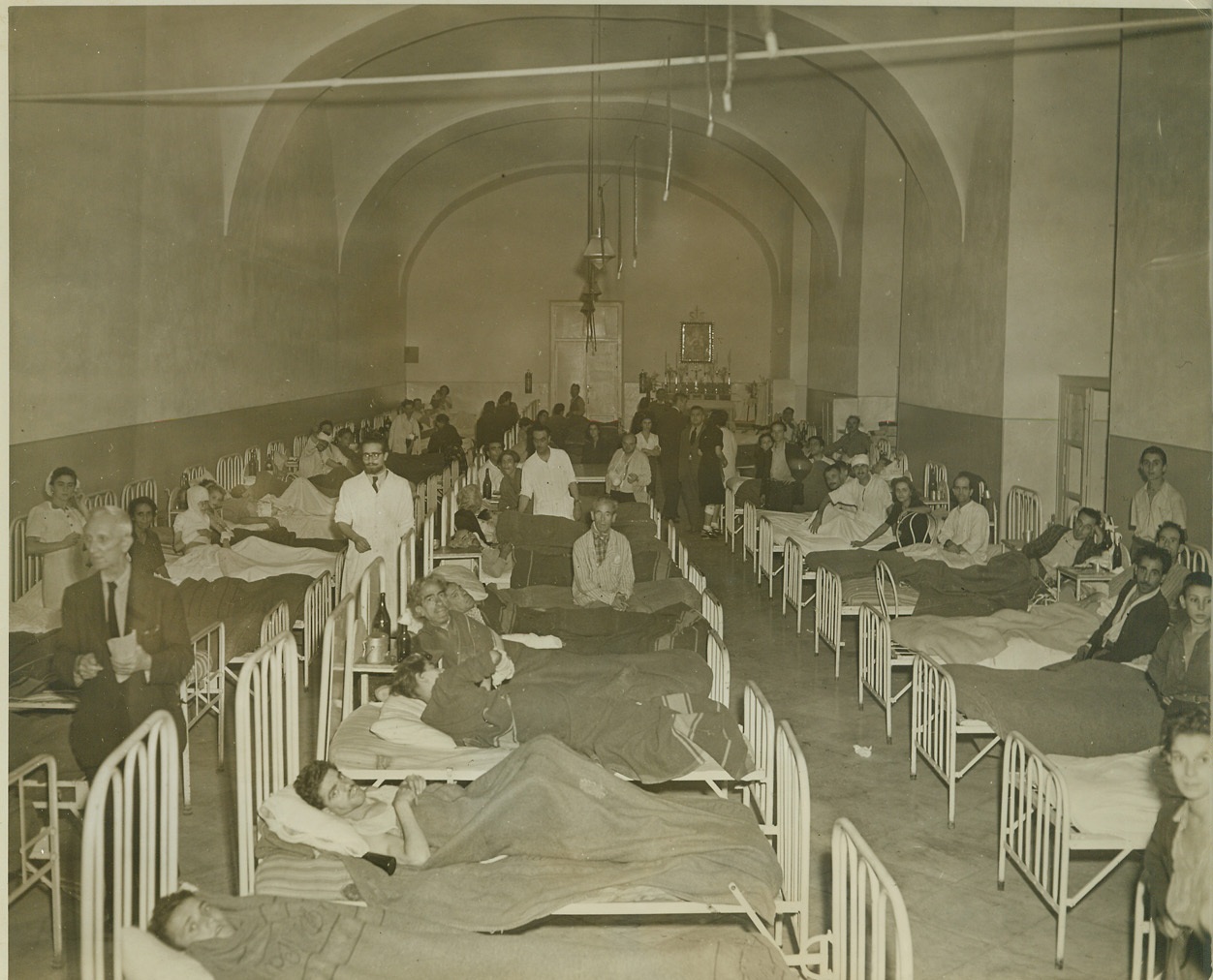
Civilians Who Fought Against Nazis, 10/9/1943. NAPLES, ITALY -- Wounded civilians crowd a ward at the Incurabilli Hospital, Naples, after the seven days civil war against the Nazis in that city. This one hospital held approximately 200 dead and 600 wounded following the bloody street war fare. Credit: (ACME Photo by Charles Seawood, War Pool Correspondent);
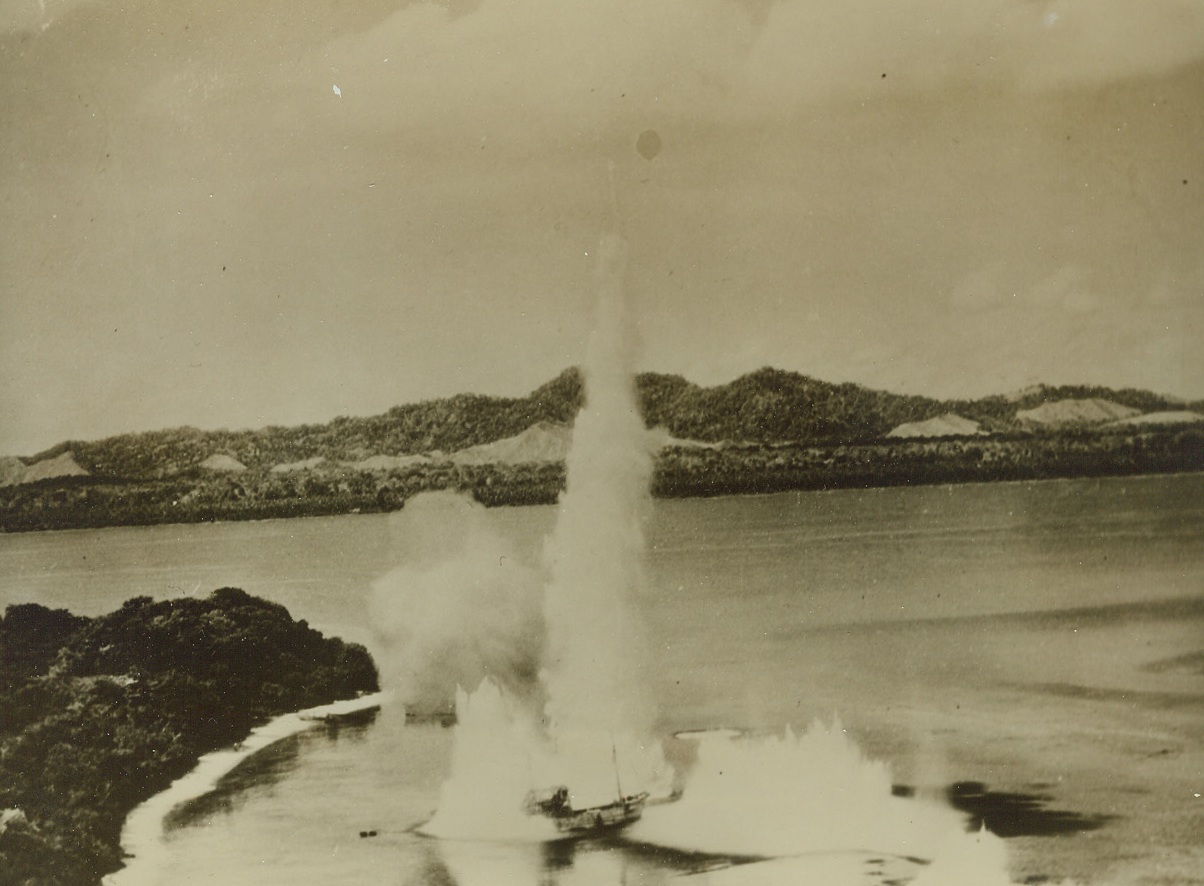
Finger of Doom, 10/14/1943. Hansa Bay, New Guinea – Like a finger of doom, a giant geyser rises alongside a small Jap boat in Hansa Bay, on the North Coast of New Guinea. Bombs from the planes of the U.S. Fifth Air Force were responsible for this and other bursts seen in photo. At least 45 barges and other small boats were destroyed by attacking USAAF planes. Credit: U.S. Army Air Forces photo from ACME;
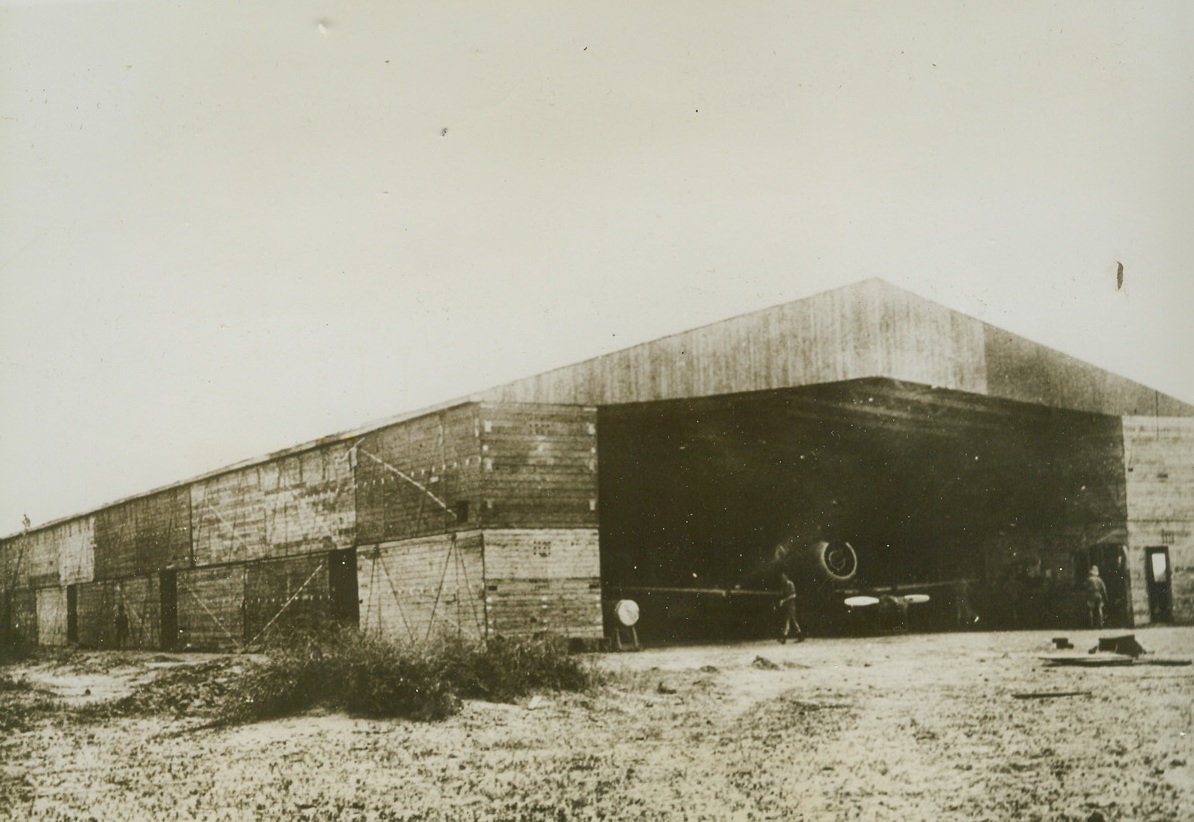
New Use for Old Crates, 10/6/1943. Sind Desert, India – Royal Air Force crews, stationed in India, where wood is at a premium, have found good use for crates in which fighter planes and plane parts are shipped. The crates are turned into bungalows, workshops and other necessary buildings. Sixty crates were used to build this hanger at an RAF Assembly Unit in the Sind Desert. Credit: ACME;
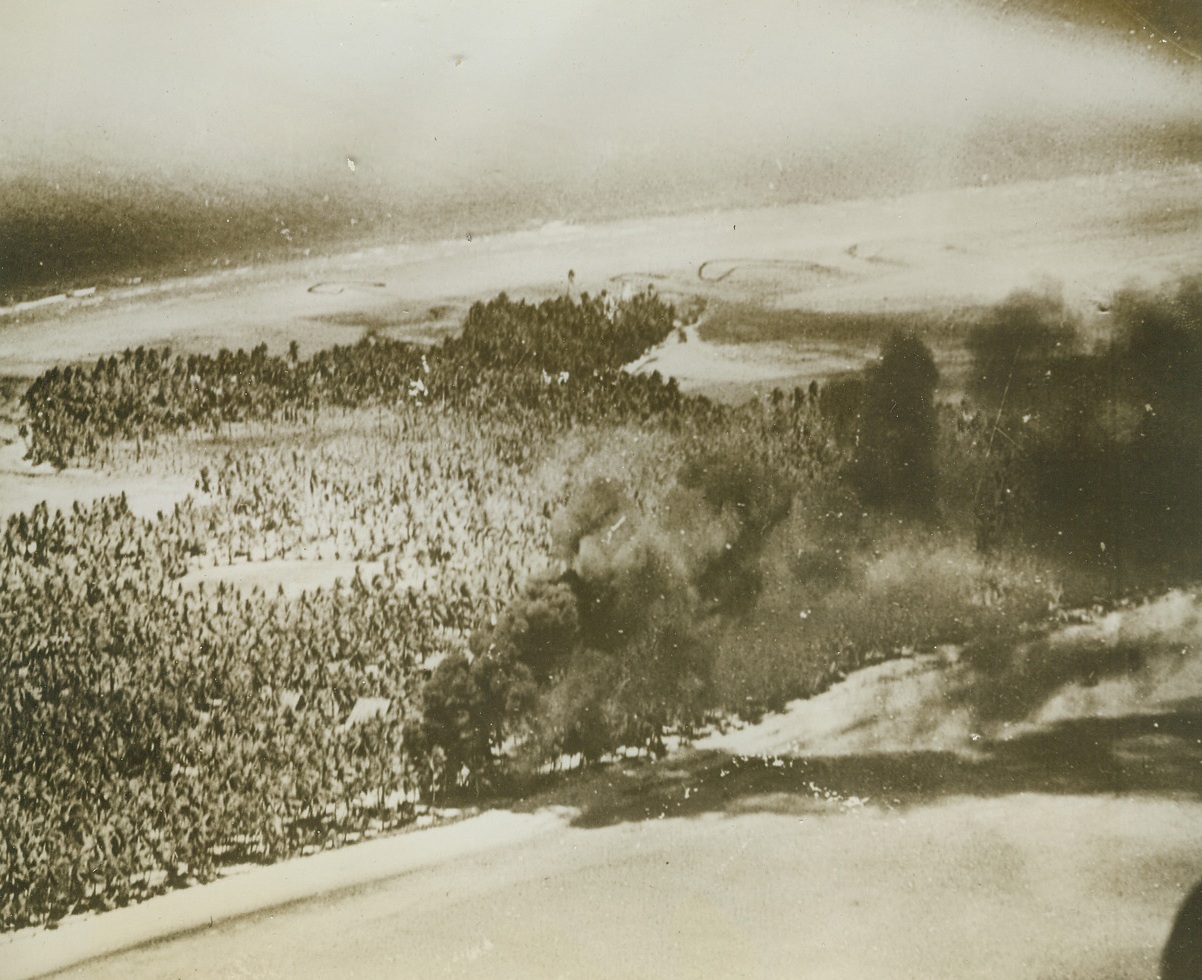
Blasting Tarawa, 10/8/1943. Smoke billows from battered Jap installations during the combined Army-Navy raid on Tarawa Island in the Marshall-Gilbert group on September 18th. One of the Navy planes that flew from Carrier decks to raid the Jap outpost flew so low for strafing activity that it returned with palm fronds clinging to the fuselage.Credit: Official U.S. Navy photo from ACME;
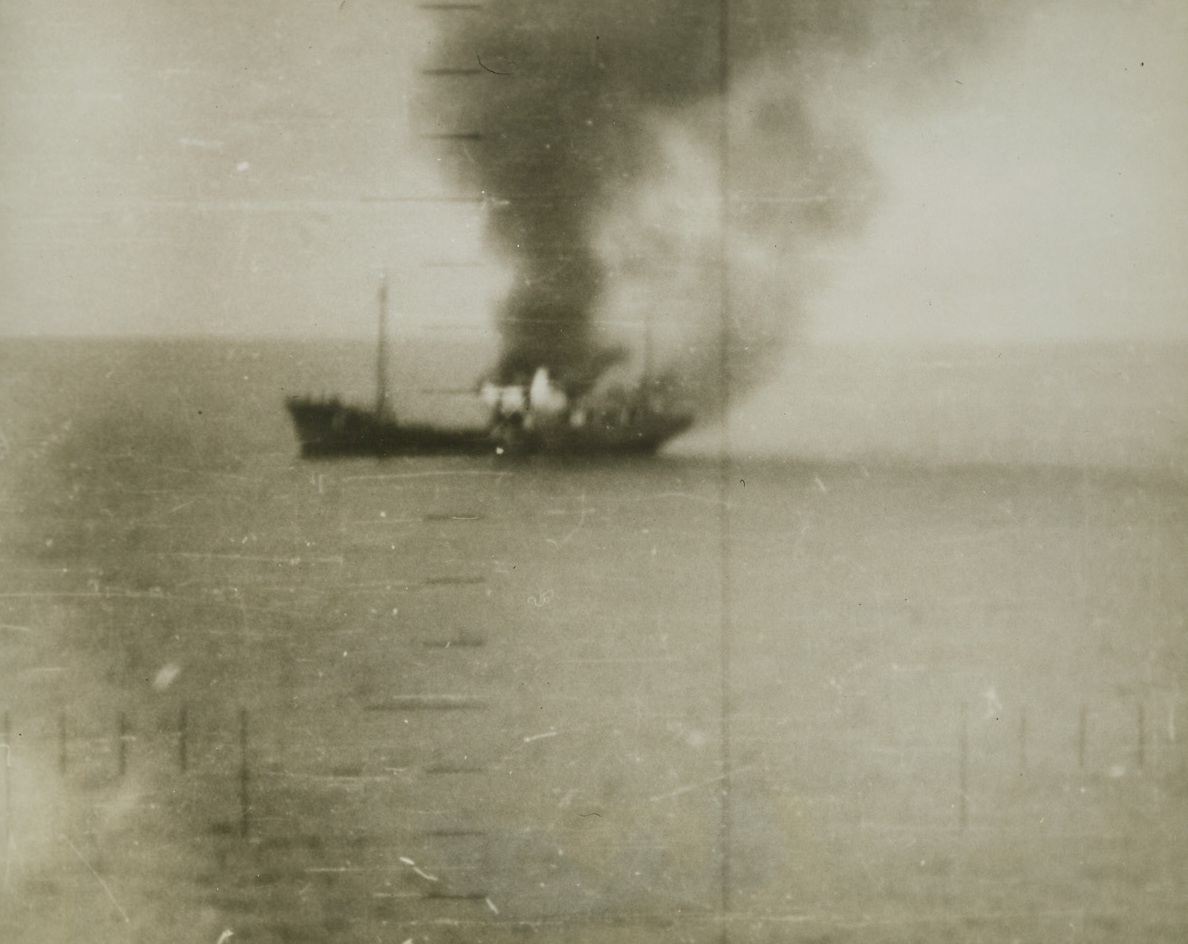
Japs Sampan Burns After Hit, 10/19/1943. Washington, D.C. – Taken through periscope sights, this picture shows flames shooting upwards from a Japanese cargo sampan after the submarine Hal scored a hit on the boat. Navy underseas raiders have taken a heavy toll of enemy cargo and supply ships running between Japan and her conquered territories.Credit (Off. U.S. Navy photo from ACME);
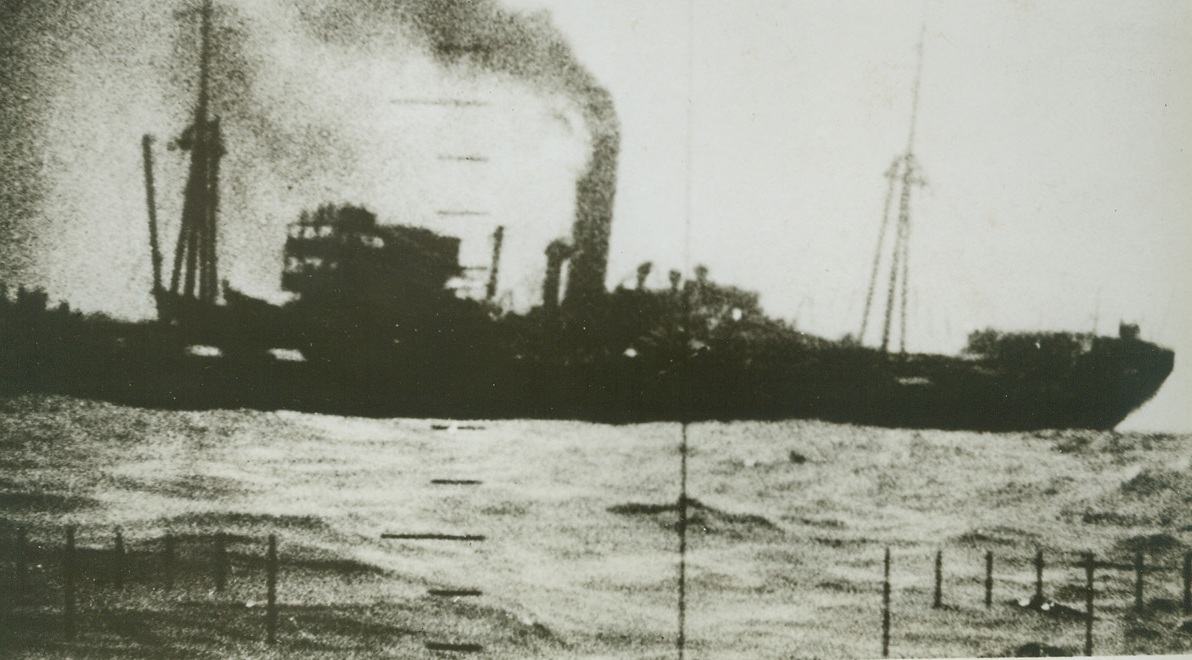
One Way Trip -- Down, 10/19/1943. Washington D.C. – Framed in the sights of this submarine, of the U.S. Pacific fleet, is this enemy transport, a Jap. Needless to say, the ship went on a one way trip – down. A Navy department communiqué announced that submarines of the Pacific fleet have definitely sunk 27 Japanese transports in the Pacific, probably sunk 5 others and have damaged 8 additional ships.No credit line provided;
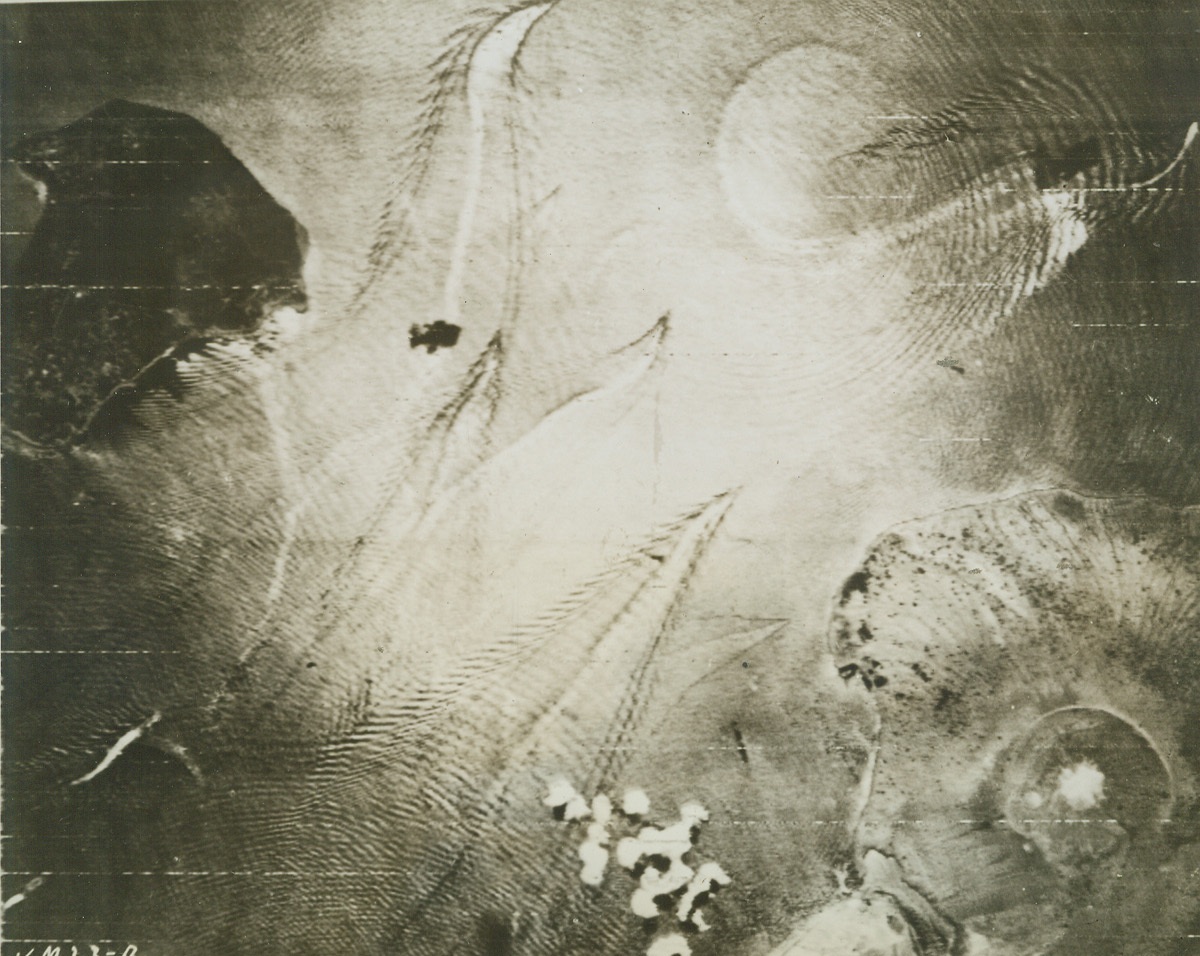
Target: Rabaul, 10/16/1943. The heavy damage that the Japs suffered as a result of the attack on Rabaul is evidenced in this aerial view showing bomb bursts among several Jap ships anchored off Vulcan volcano at Rabaul. Note Jap ships weaving and dodging in an attempt to evade this greatest of air attacks in the Pacific. Allied bombers sank or damaged 55 enemy ships.Credit Line (Signal Corps radio telephoto from ACME);
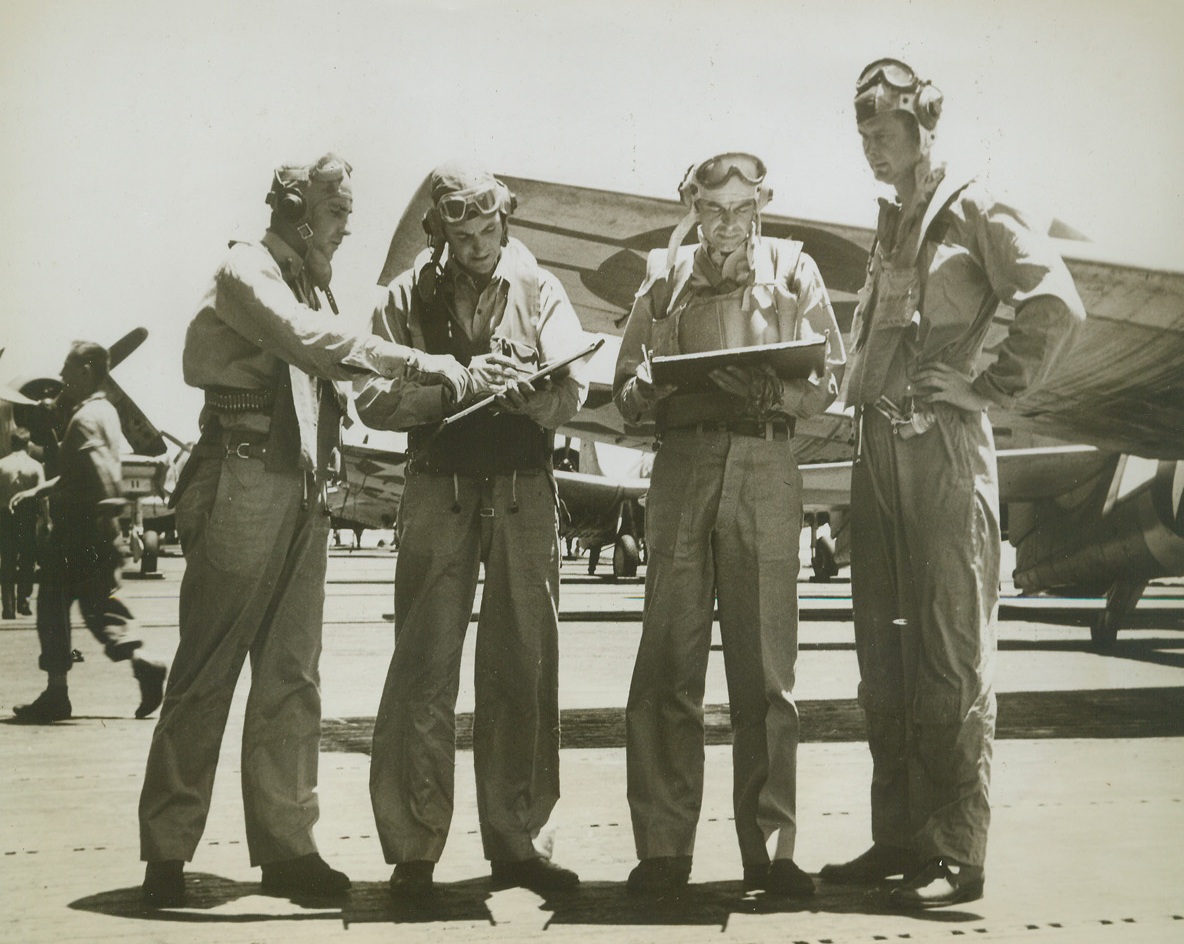
Getting Ready for Tarawa Raid, 10/16/1943. At Sea – Navy air group commanders and squadron commanders get together on the flight deck of their flat-top before taking off on the raid of Tarawa, Jap-held island of the Gilbert group, on Sept. 18 and 19. Planning the teamwork are (left to right) Lt. Cmdr. R.H. Isely, Lt. Comdr. E.M. Snowden, Air group Commander L.B. Southerland, and Lt. Comdr. P.D. Bruie.Credit Line (official US Navy photo from ACME);
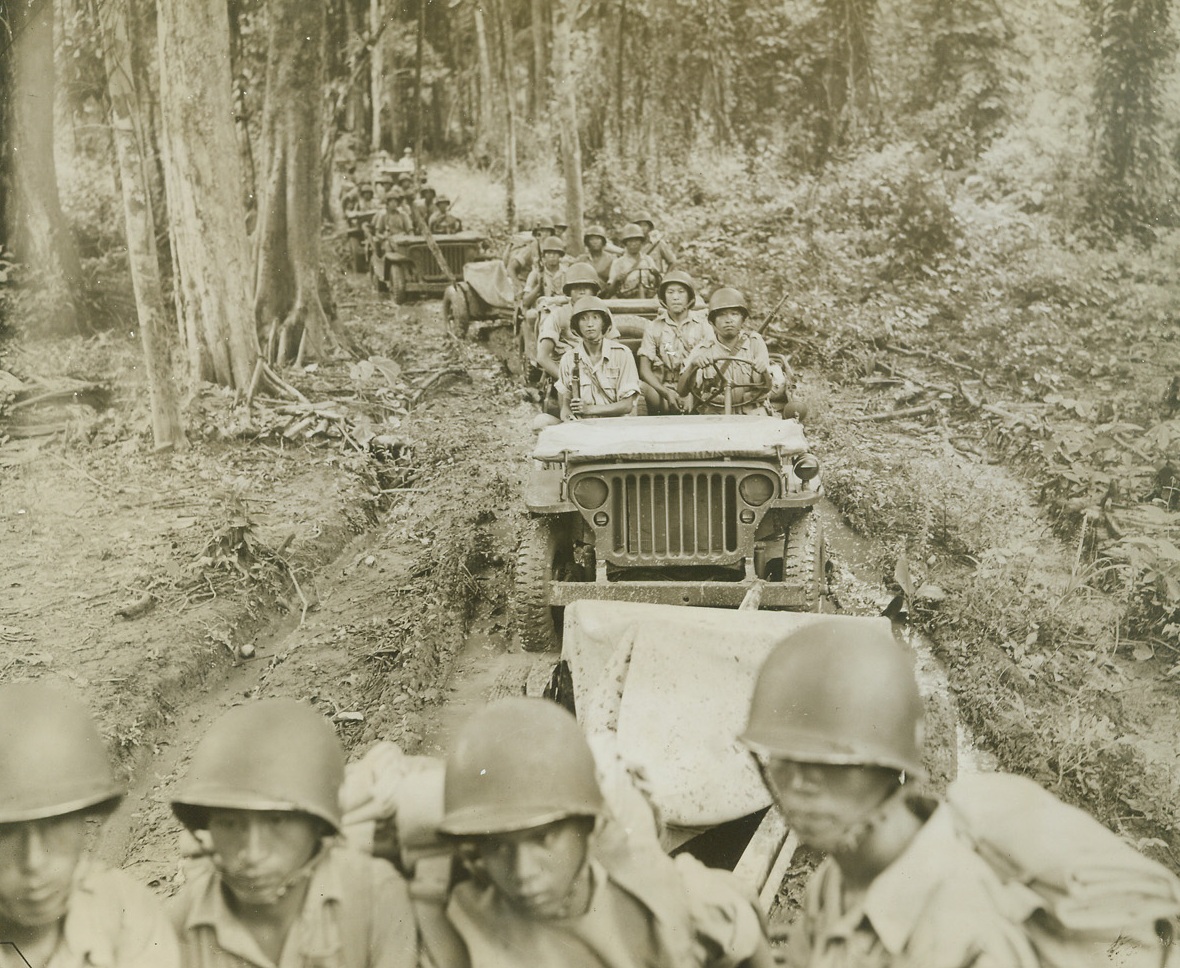
Chinese Fighters Man Yank Jeeps, 10/14/1943. CBI Theater – The famous American jeep is no mystery to these Chinese fighters, for they have been trained in the use of all the latest war weapons at the U.S. training center for Chinese in India, under Lt. Gen. Joseph Stilwell’s supervision. A September 16 communique reported that the Chinese fighters fought a skirmish with 200 Japanese in the Naga Hills of North Burma.Credit (ACME photo by Frank Cancellare, War Pool Photographer);
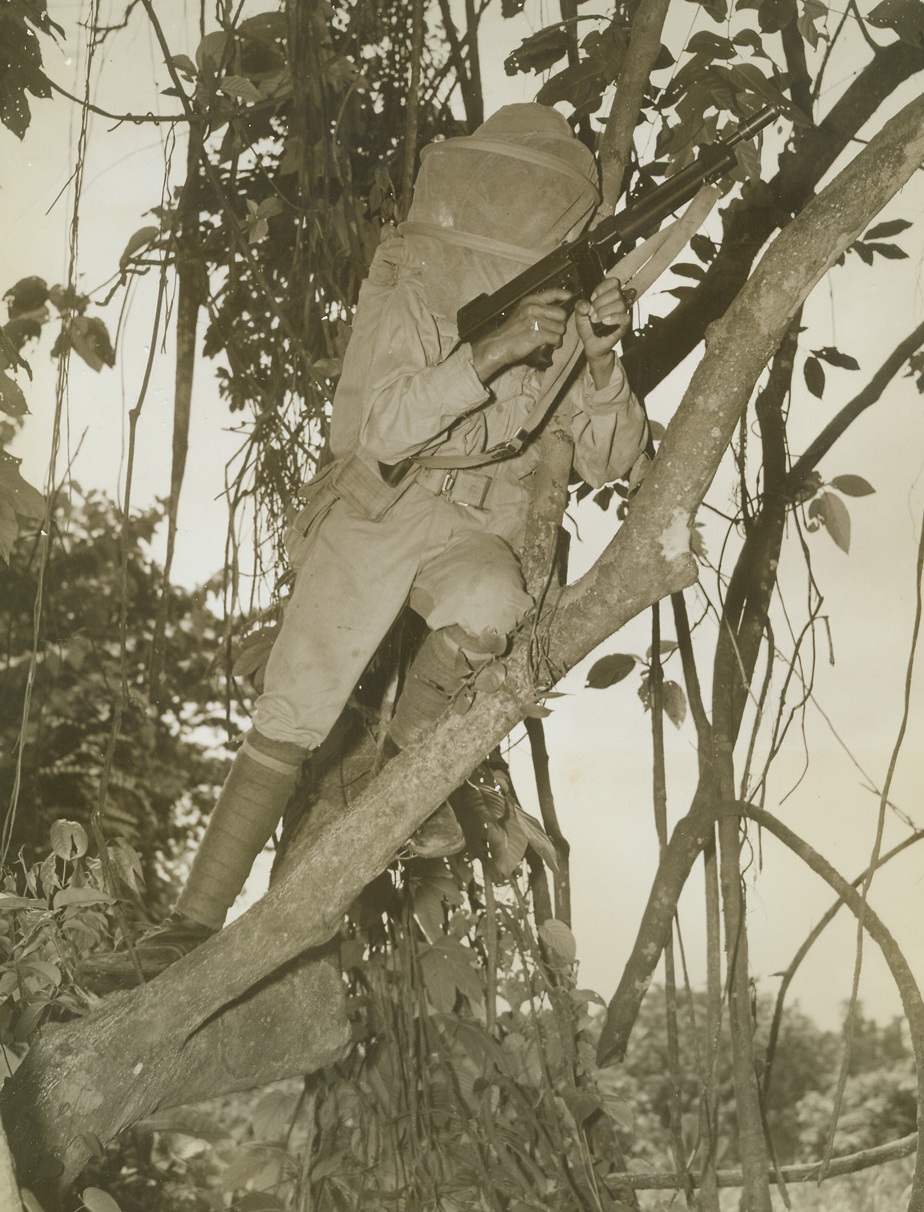
On Lookout For Japs in CBI, 10/14/1943. CBI Theater – His head guarded by mosquito netting, an American-trained Chinese soldier takes up his Sniper’s post in the thick of a jungle somewhere in the China, Burma, India war theater. Thousands of Chinese troops have been trained and equipped at Lt. Gen. Joseph Stilwell’s Chinese U.S. training center in India, and are now ready to do battle with the most modern U.S. war weapons.Credit (ACME photo by Frank Cancellare, War Pool Photographer);
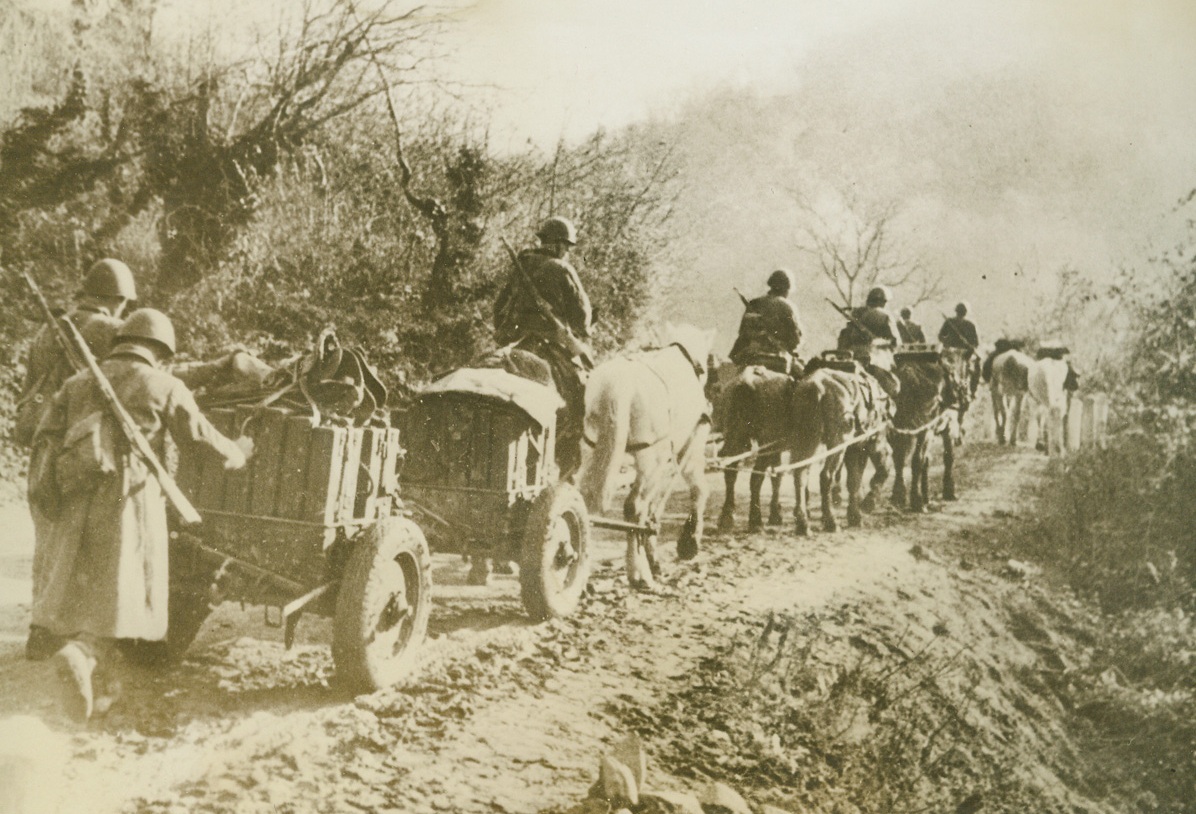
Russians Advance, 10/14/1943. NORTHERN CAUCASUS—Red Army soldiers and their horse-drawn artillery push ahead to the front in the northern Caucasus. Through the extensive use of horses, the Red Army is able to make use of roads that cannot be navigated by heavy, mechanized vehicles.Credit: ACME;
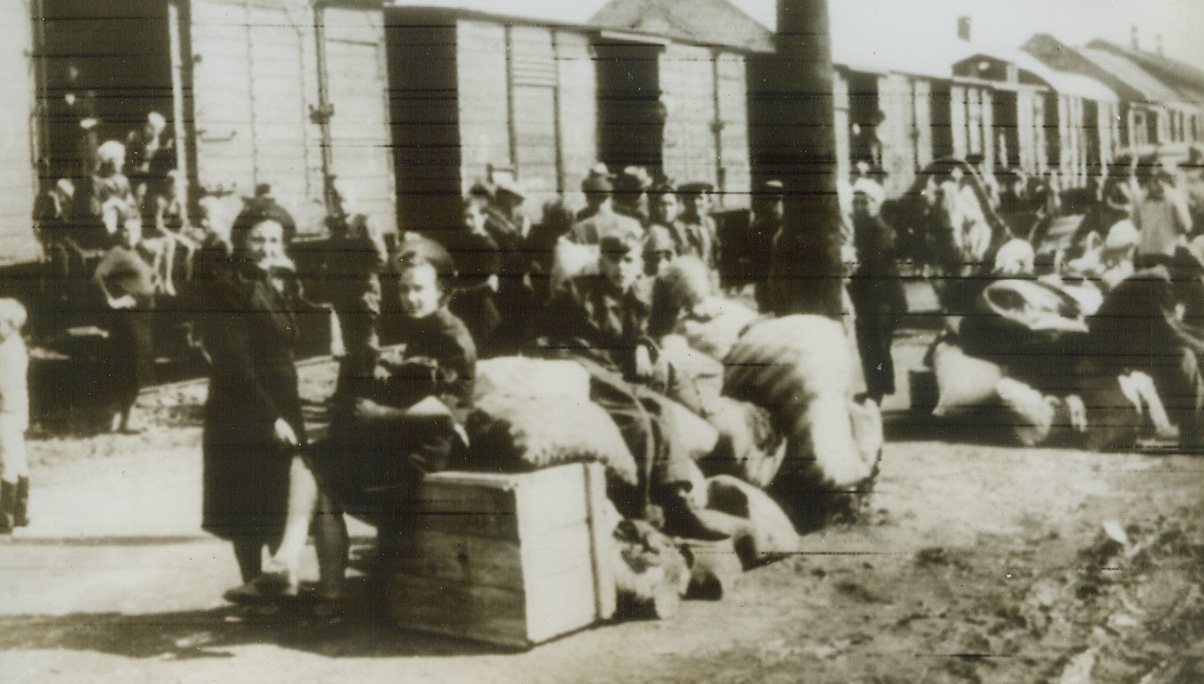
Had a Brief Stay, 10/29/1943. Russia – Here’s proof that Hitler’s “colonies” are disappearing, one by one, this photo obtained through neutral sources shows German colonists being forced to abandon briefly-held farms in Russia by the push of the Red Army. They are being evacuated in boxcars “to colonies nearer the homeland,” according to the German caption. Photo radioed from Stockholm this morning.Credit: ACME Radiophoto;
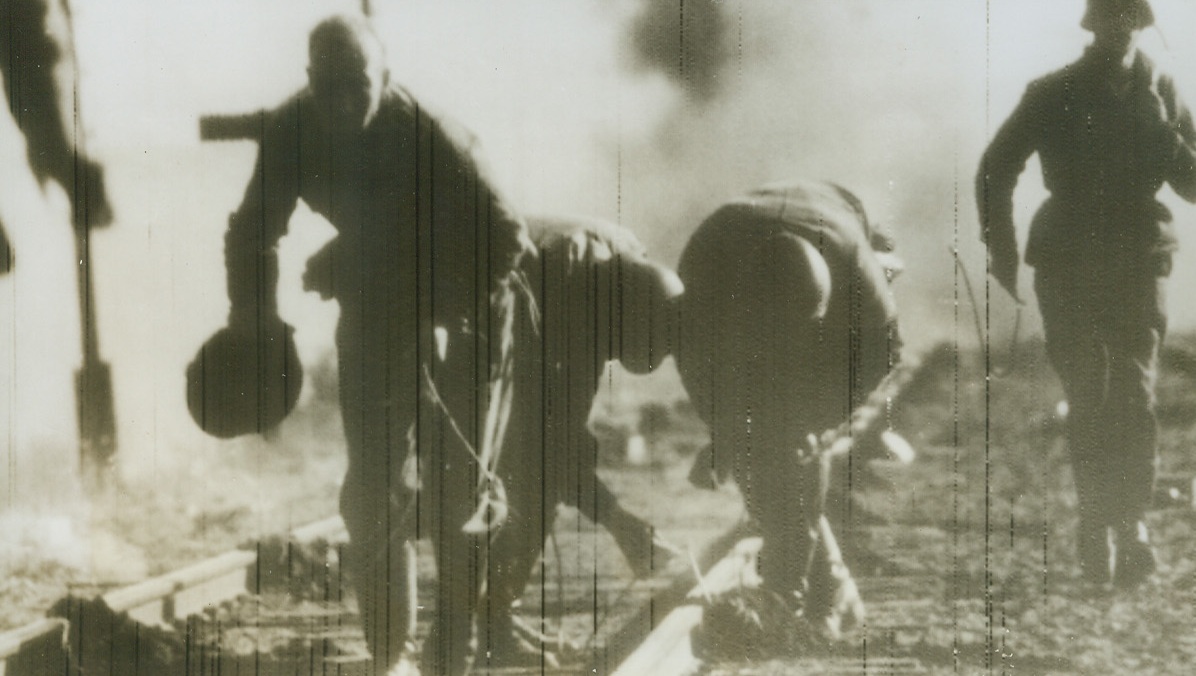
Nazis Practice Scorched Earth Policy, 10/29/1943. Russia – The Nazis must remember how effective the Russian scorched earth policy was when they were advancing so now that they’re retreating, they’ve decided to do likewise. German sappers are shown blowing up rail lines as they retreat. According to German caption, they are placing explosive charges every five meters. Photo radioed from Stockholm today.Credit: ACME Radiophoto;
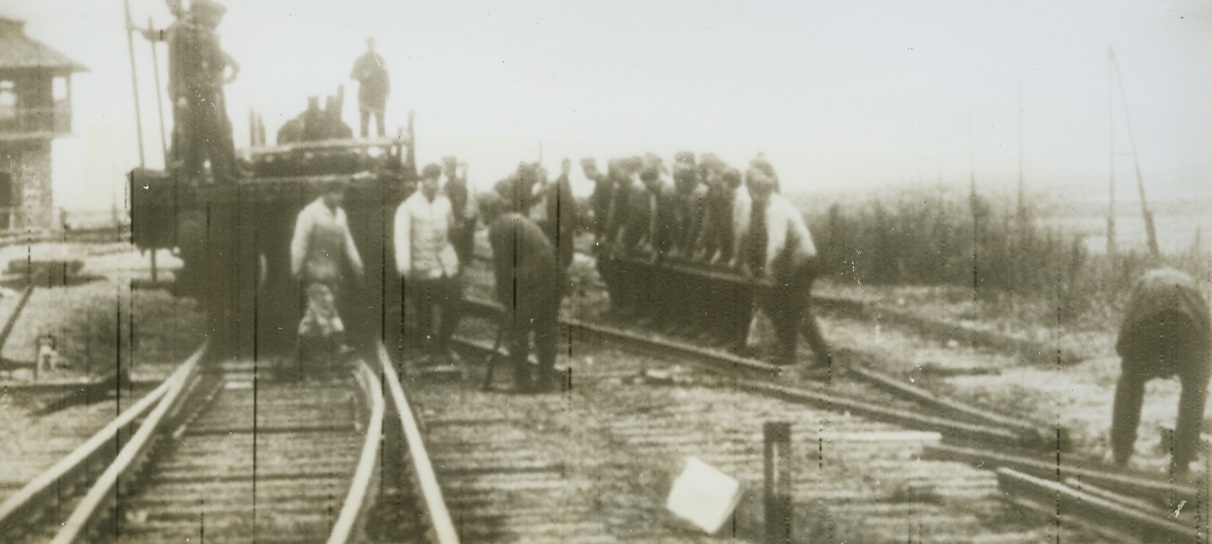
Nazi Strip Act, 10/29/1943. Russia – Stripping the countryside like Japanese beetles would strip a rose bush, German soldiers remove rails from Russian Territory as they retreat before the Red Army. They’ll probably be used in Germany to replace those blown up by well-aimed Allied bombing. Photo radioed from Stockholm today.Credit: ACME Radiophoto;
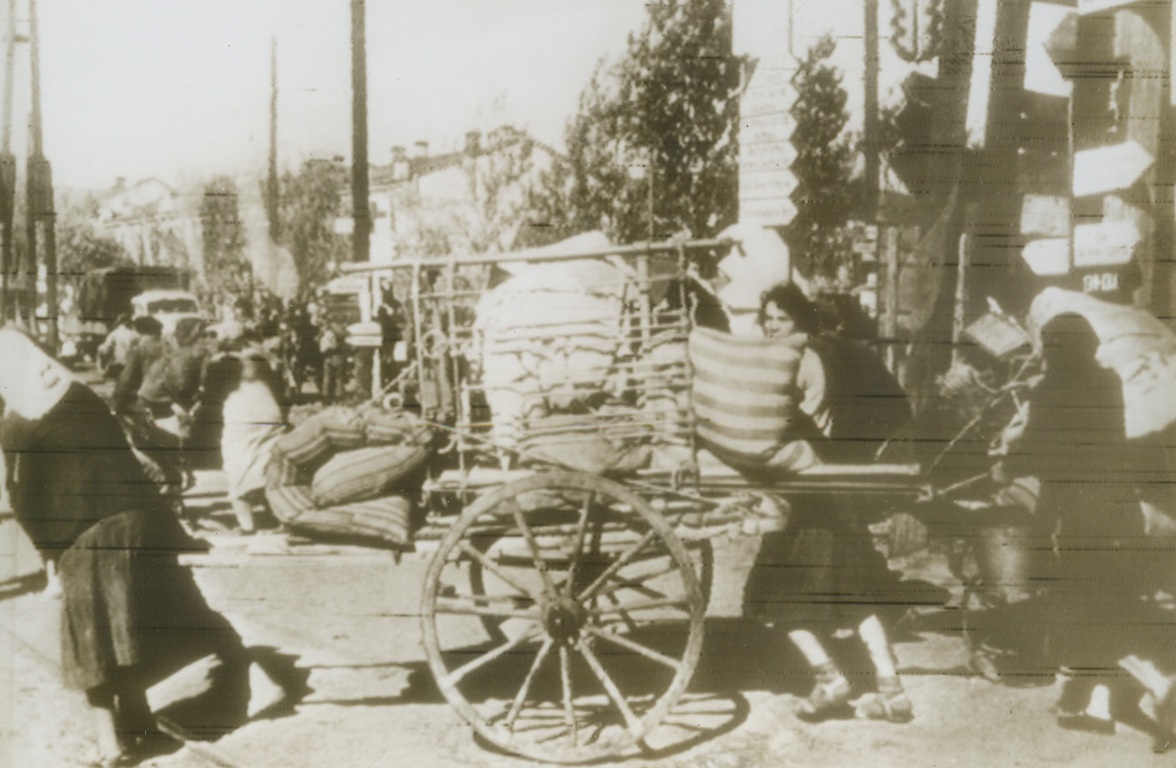
Evacuate Kiev, 10/30/1943. Russia – Photo radioed from Stockholm this morning shows civilians being evacuated from the Eastern portion of a Russian city which is not identified in the German caption. However, because the district where the Nazis are taking up defensive positions against the Red Army borders on a river, city is believed to be Kiev.Credit: ACME Radiophoto;
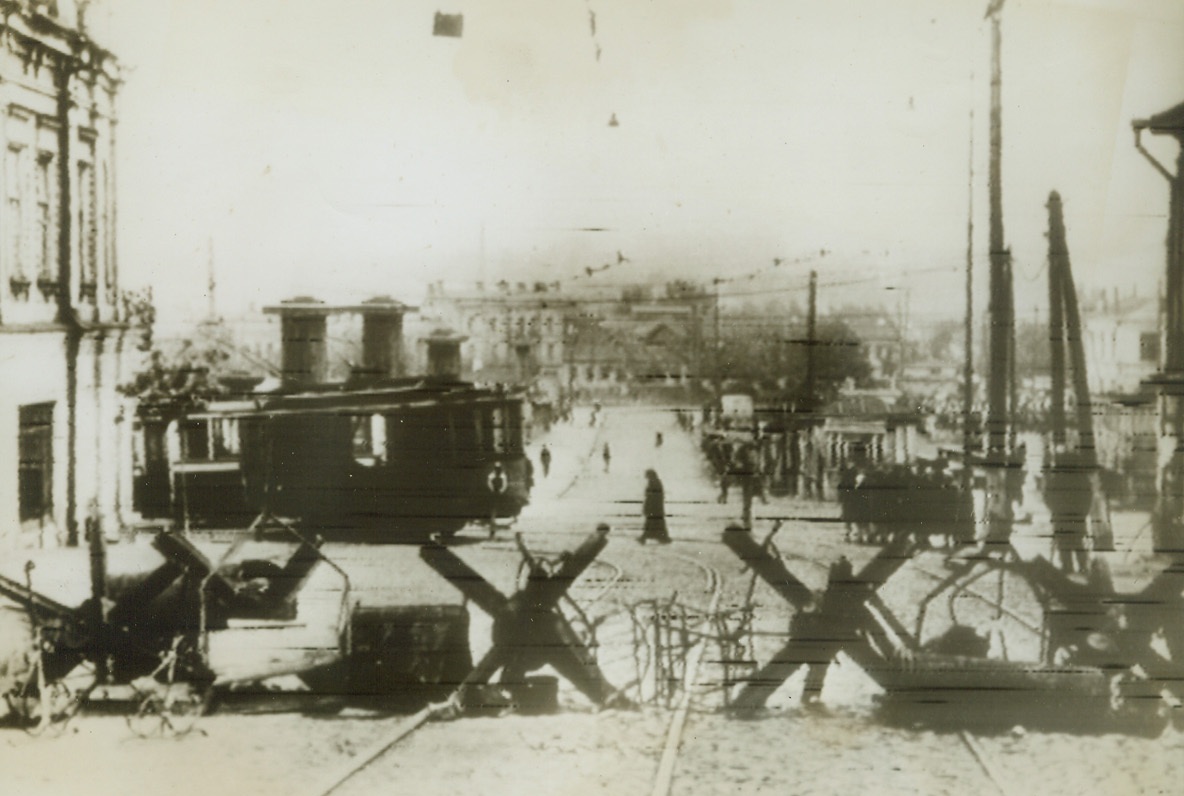
Germans Barricade Kiev, 10/30/1943. Russia – Photo just radioed from Stockholm shows a Russian city, not identified by the German caption, but which is probably Kiev, as it has been prepared by Nazis for Red Army onslaught. The Eastern portion of the city has become a front zone and had been barricaded. Barricades are trespassable only by persons with permits.Credit: ACME Radiophoto;
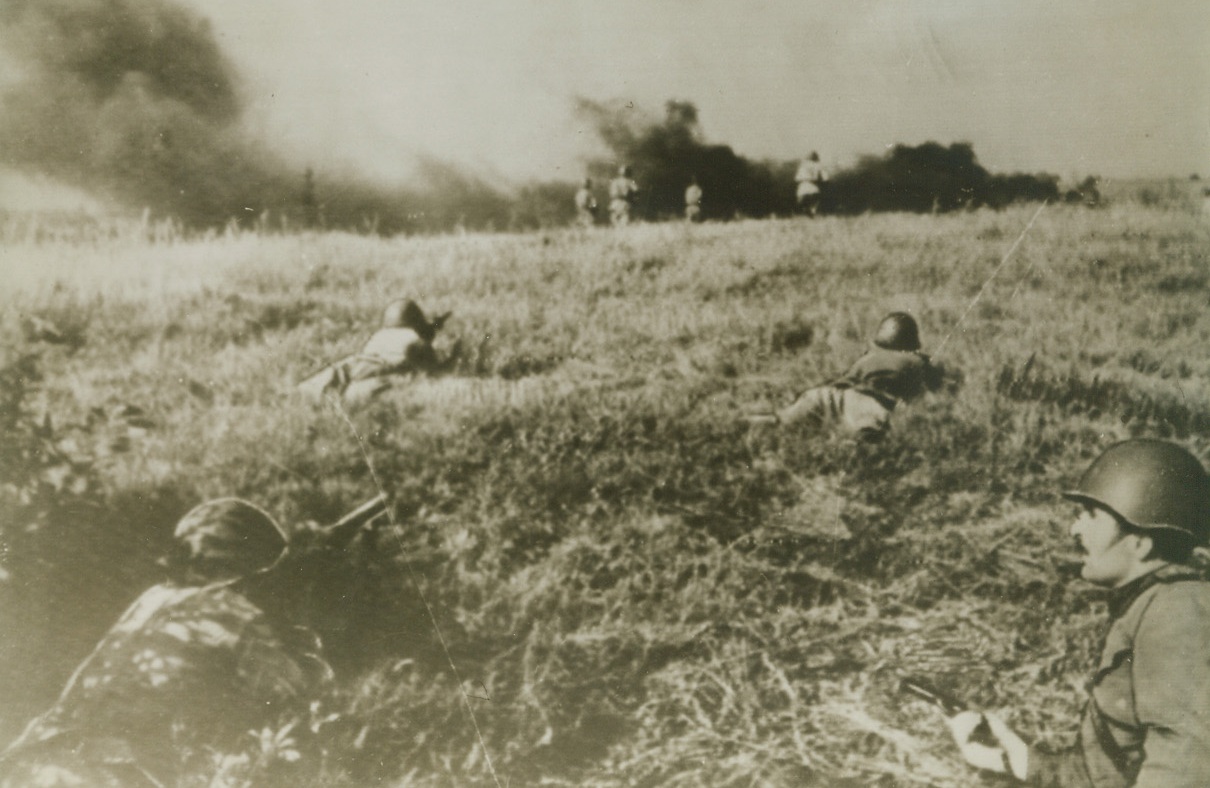
Red Army Attacks, 10/15/1943. ON THE RUSSIAN FRONT—Captain Gadabadze’s company makes its way through thick grass as it attacks German positions near the Dnieper. Latest reports from the Soviet front indicate that the Red Army stormed and captured Zaporozhe, industrial strong point on the east bank of the Dnieper River bend, breaking German southern defenses and opening the way for a Russian drive into the Crimea. Credit: ACME Radiophoto;
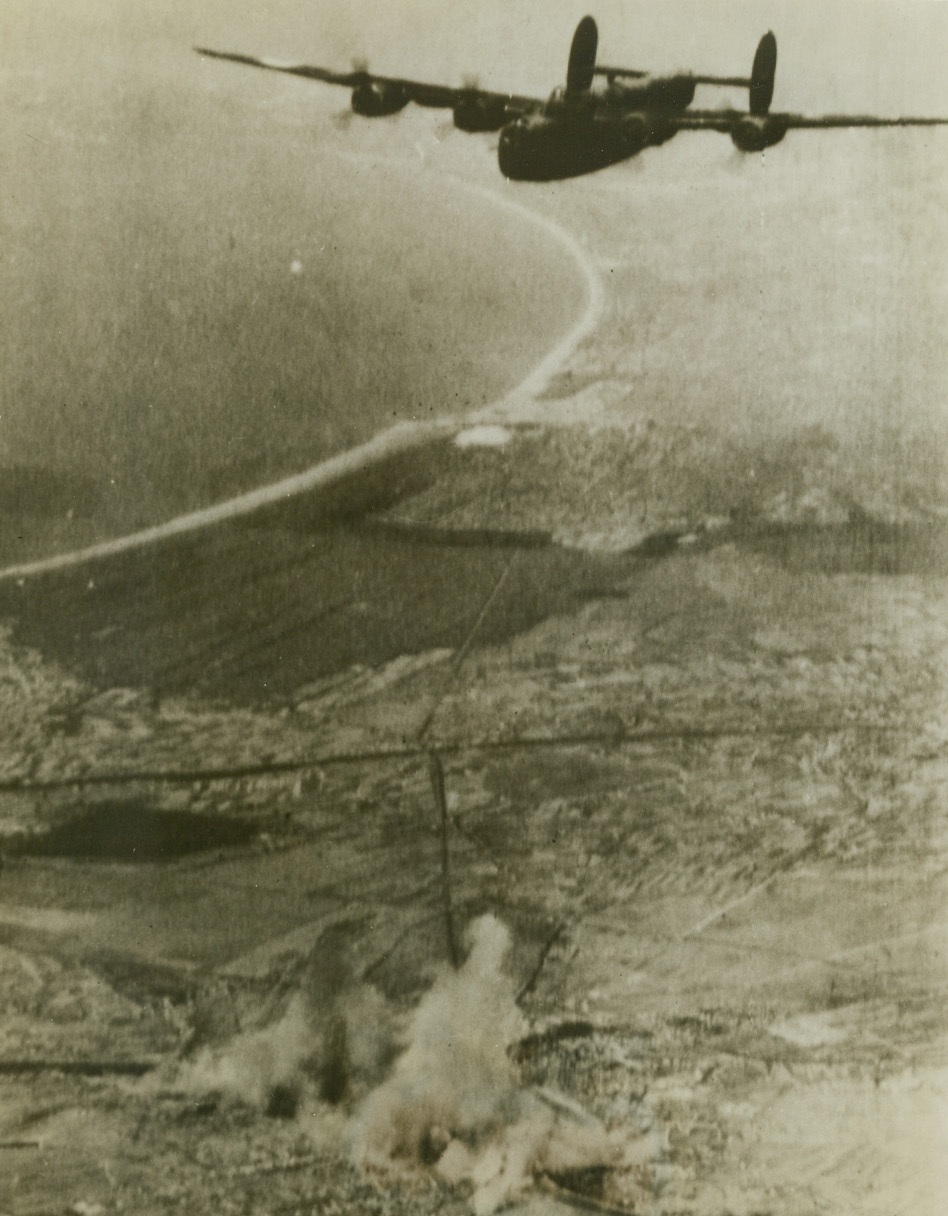
Bombing Pisa, 10/2/1943. Operating under the direction of the Northwest African Air Forces, B-24 Liberators bombed targets at the Pisa marshalling yards in Northern Italy. Buildings were severly damaged and the main line to Florence and the East was out. Here one of the planes is shown over the target.Credit line (Signal Corps radio telephoto – ACME);
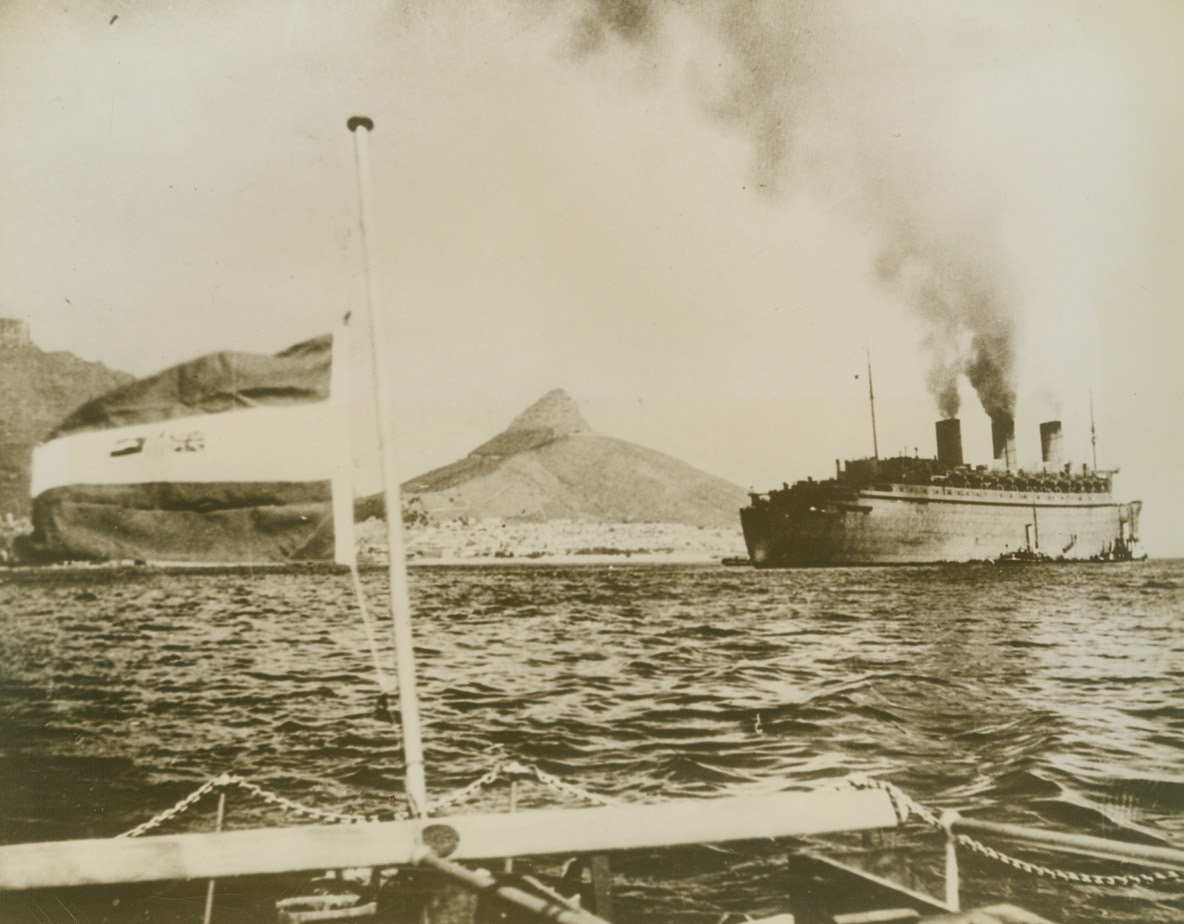
Queen of the Seas Does Her Bit, 10/2/1943. Cape town, South Africa - - Wearing her drab wartime coat of gray paint, the 81,235-ton liner Queen Mary rides at anchor in Table Bay, at Cape town. The British government has just released this photo of the giant ship, shown soon after she carried a load of American soldiers from New York in a record run of 12 days. Nineteen days was the previous mark. The Queen of the seas once sped through a submarine pack so fast that none could torpedo her.Credit line (ACME);
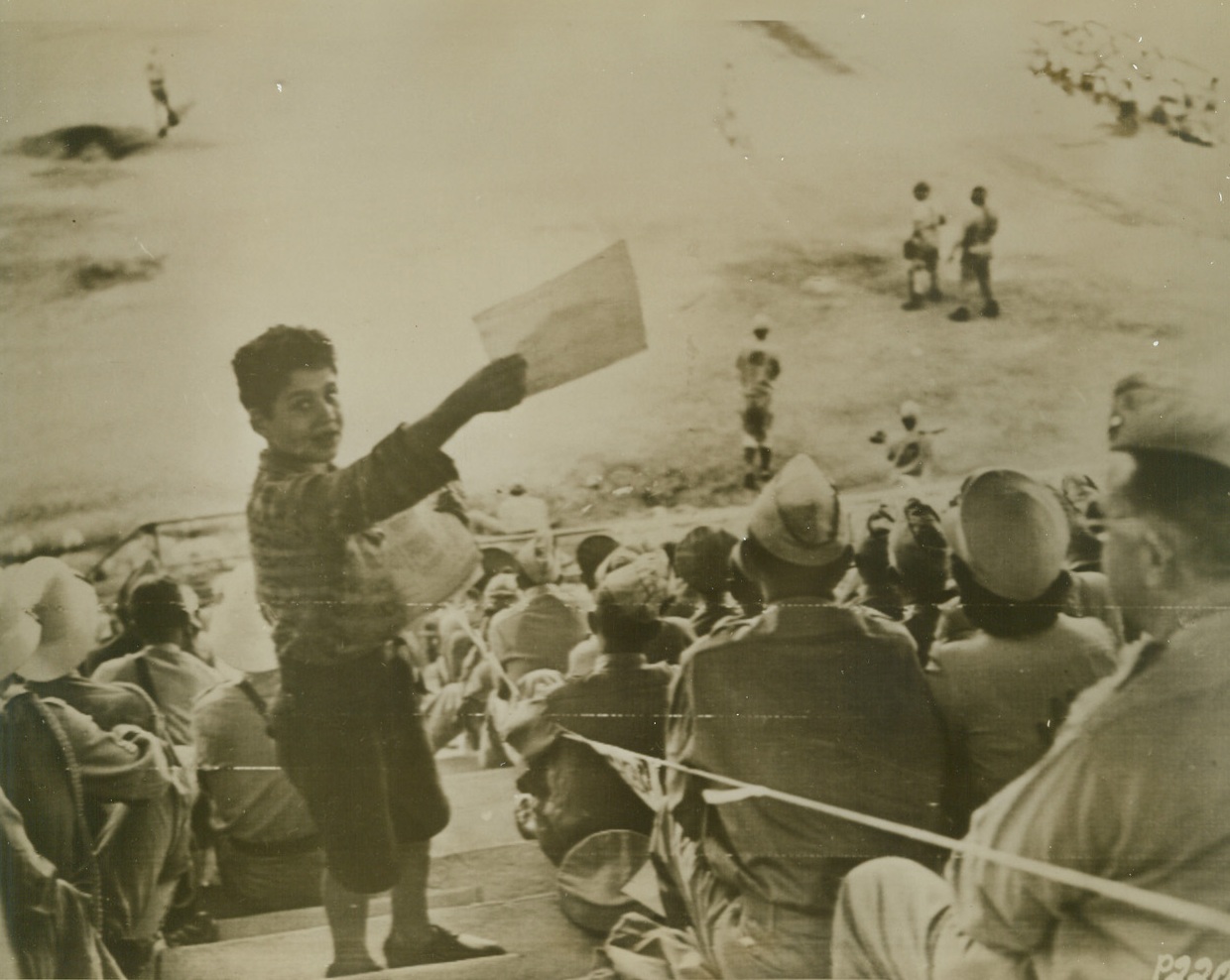
North African “World Series”, 10/4/1943. North Africa – A young Arab lad does a big business selling programs in a packed stadium in North Africa, where the Casablanca “Yankees” took the opening baseball game of the North African “World Series”, from the Algiers M.P.S by a score of 9 to 0. This picture was flashed to the U.S. by radio telephoto today. Credit line (ACME photo for the war picture pool by Bert Brandt via U.S. Signal Corps);
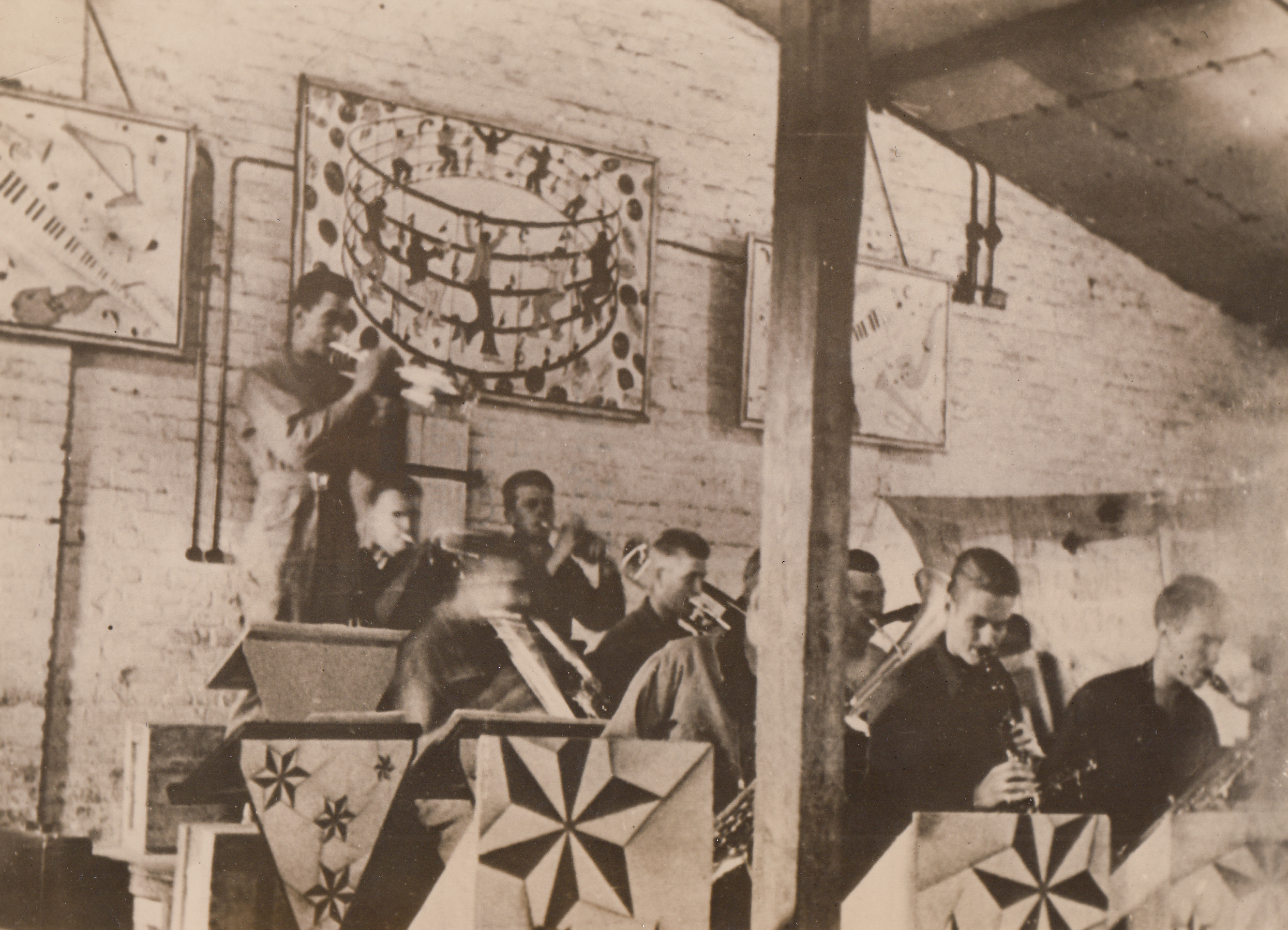
Captured Yanks Have Own Band, 10/7/1943. This photo, taken and sent to the U.S. by a Y.M.C.A. war prisoners aid delegate who visited the prison camp, shows American soldiers, captured in the North African fighting, as they gave a concert to entertain their comrades at Stalag 111B, a German prison camp Southeast of Berlin. M/Sgt. Clyde M. Bennett, leader of the Americans in the camp, says: “we’ll soon have the best band in Germany.”;
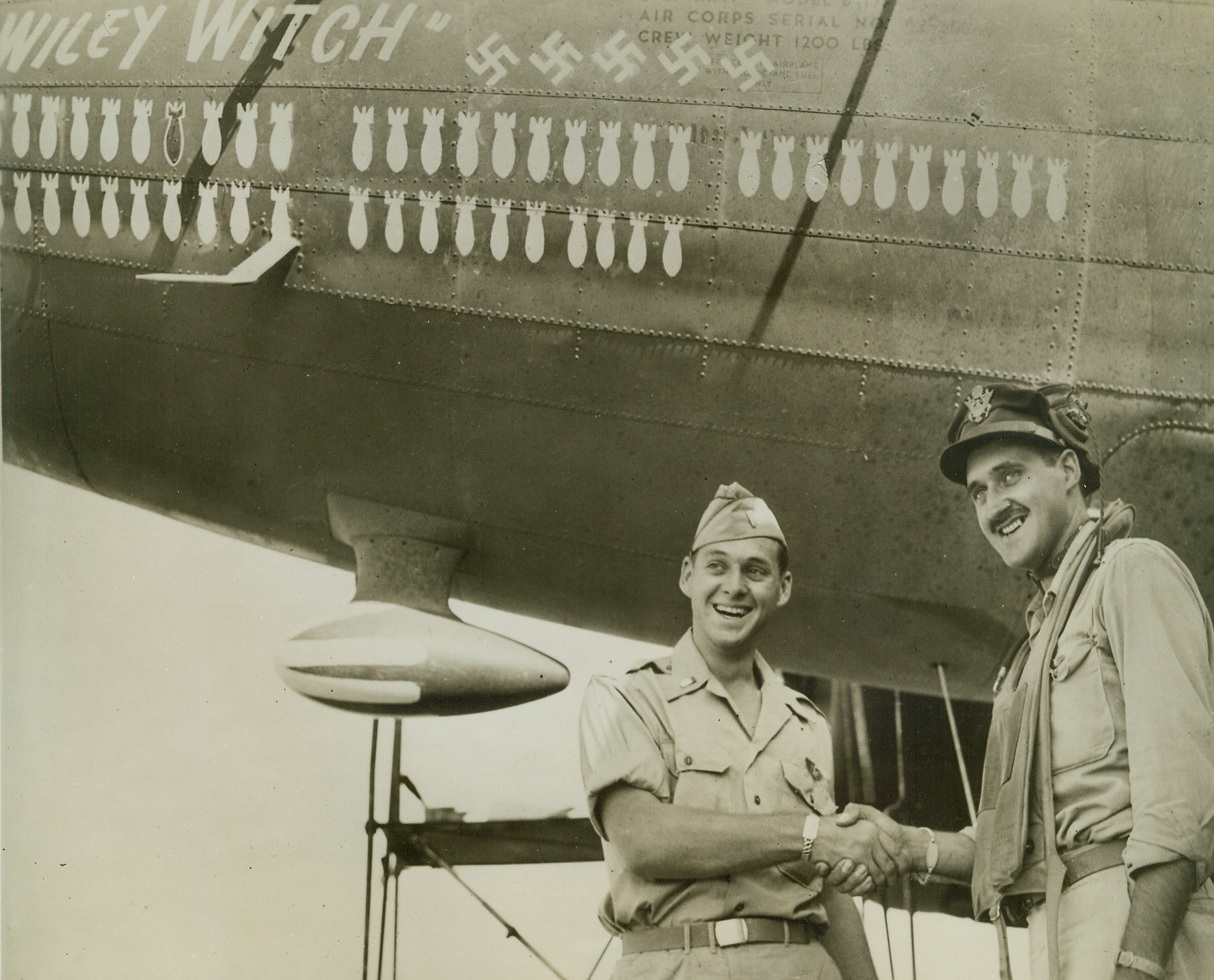
Well, Fancy Meeting You Here!, 10/20/1943. Somewhere in North Africa—Lt. James G. Johnson (left) and Maj. Roscoe H. Johnson, Jr., both Chicagoans, for two months have been piloting bombers from airports just ten miles apart in North Africa and had even participated in the same missions but neither was aware of the other’s presence until they met accidentally and had this picture made to send to their father who is a Major in the Illinois Reserve Militia. Credit: ACME.;
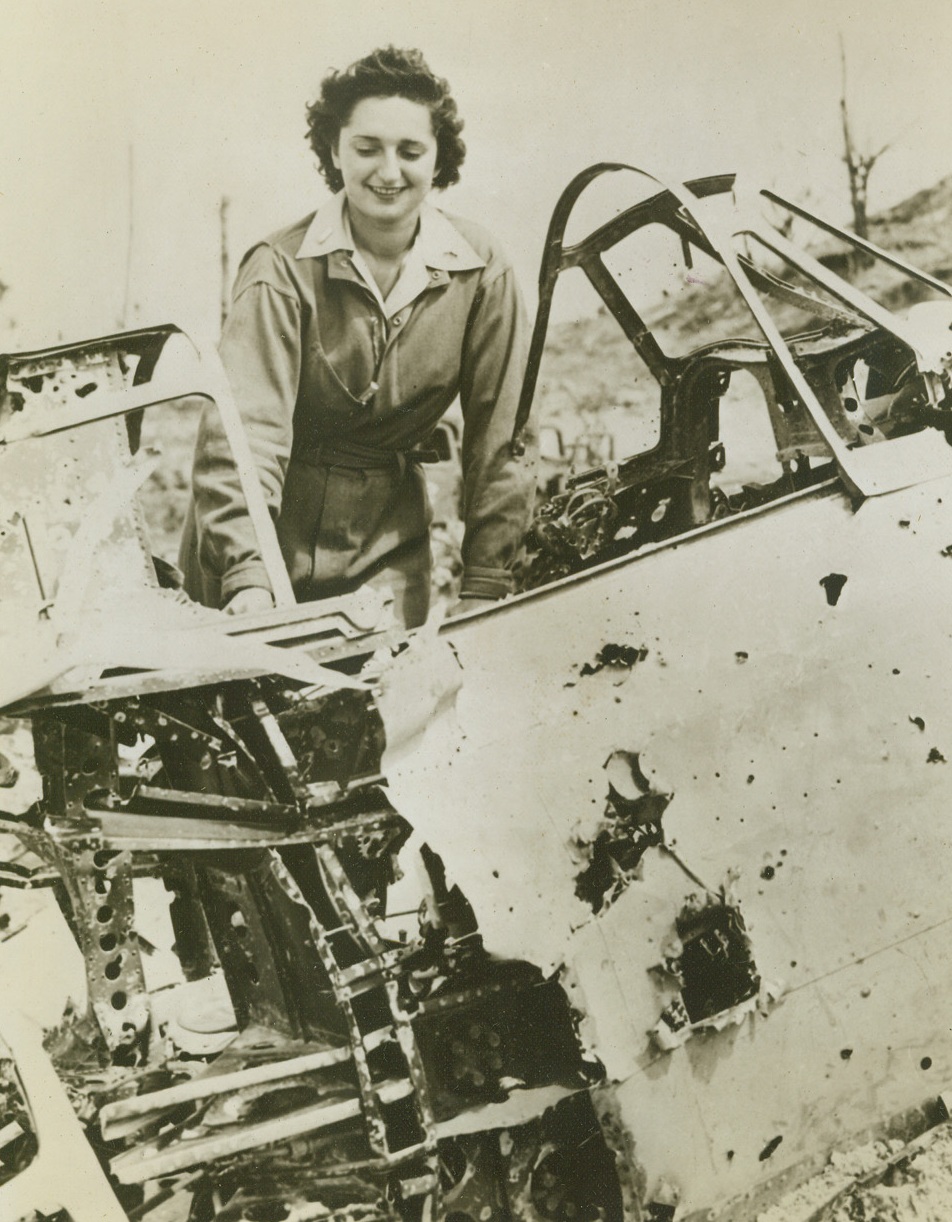
First American Woman on Munda, 10/9/1943. Munda, New Georgia—Inspecting a wrecked Jap dive bomber on captured Munda airfield, Lt. Dorothy Shiposki of Greenlake, Wisc., was the first American woman to set foot on Munda. An Army nurse, she arrived by a Marine-operated hospital plane, to help in the evacuation of wounded from the island’s fighting lines. Credit: U.S. Marine Corps photo from ACME.;
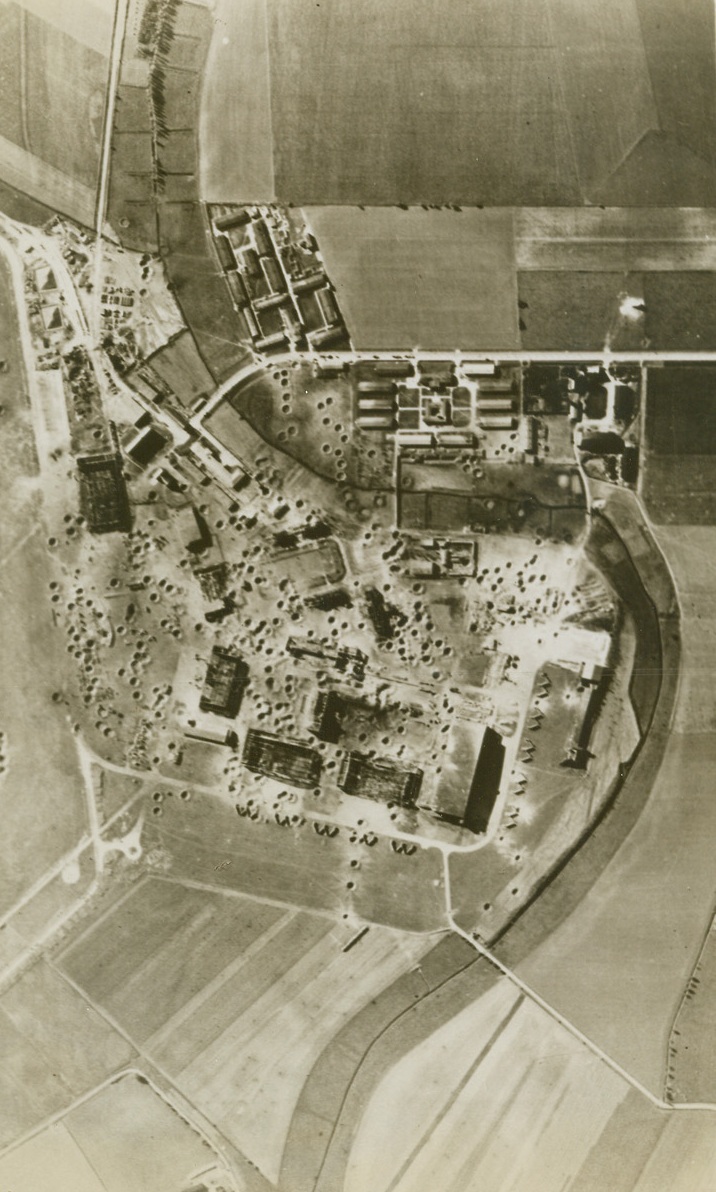
Yank Bombers Blast Martenburg, 10/20/1943. Washington, D.C.—This photo, released today in Washington, shows huge bomb craters and blasted buildings at the Focke-Wulf 190 fighter plane factory at Marienburg, East Prussia, after four raids by large formations of Flying Fortresses and LIberators last Oct. 9th. Called the finest example of daylight precision bombing by Gen. Henry H. Arnold, Chief of the U.S. Army Air Forces, this raid was the deepest penetration yet by the U.S. 8th Air Force. Credit: U.S. Army Air Forces photo from ACME.;
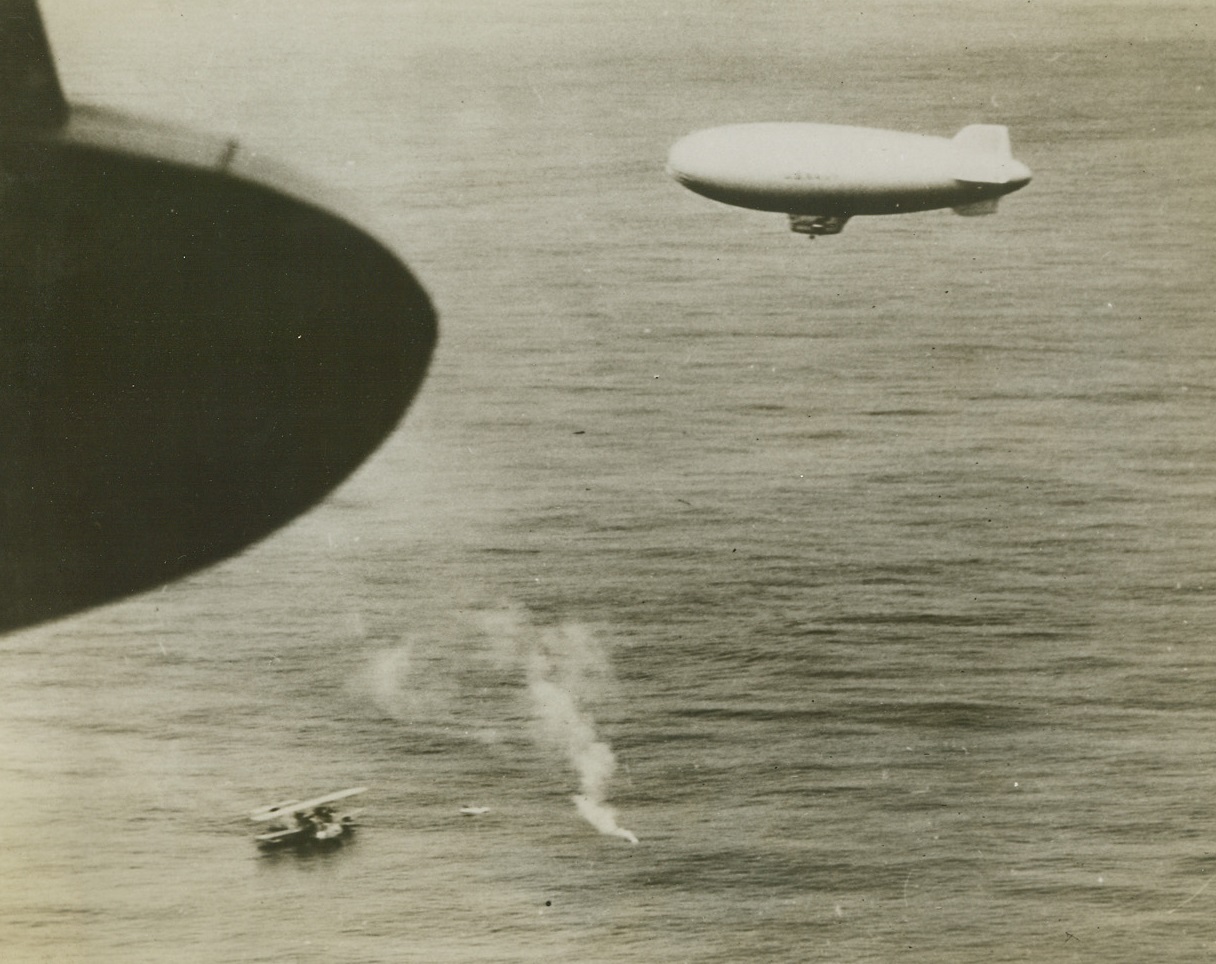
U-Boat Survivors Rescued, 10/20/1943. Washington, D.C. – The Distinguished Flying Cross was awarded to Commander Richard L. Burke, commanding officer of the U.S. Coast Guard Air Station at Elizabeth City, N.C., for rescues, such as this one, that of seven German survivors of a destroyed U-Boat. Here the Coast Guard officer’s plane is shown on the sea near a life raft dropped to the Germans, while a burning smoke bomb identifies the location. A Navy blimp hovers overhead. 10/20/43 Credit (U.S. Coast Guard Photo From ACME);
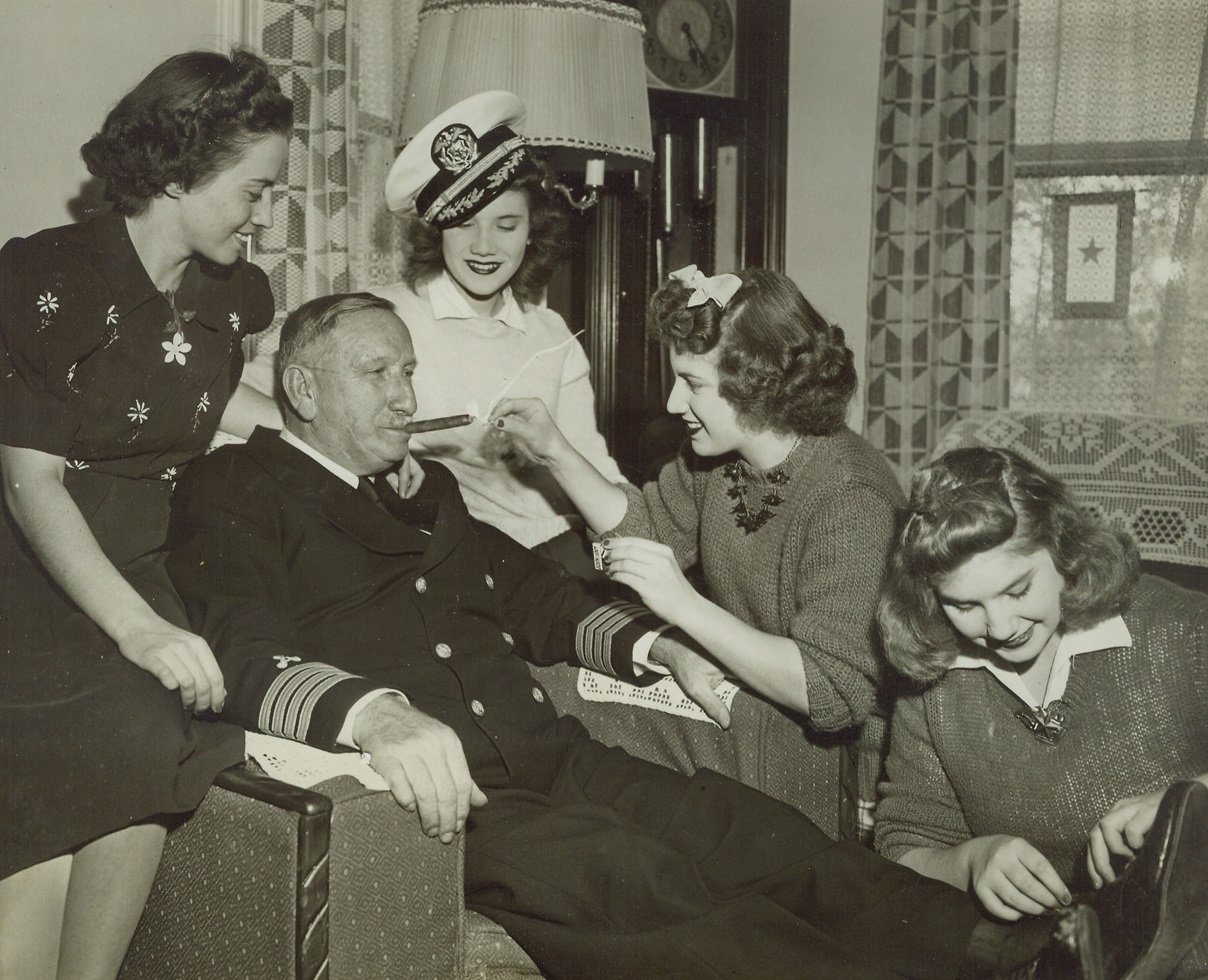
Wounded Hero of Three Wars Gets “The Works”, 10/16/1943. Park Ridge, Ill.—Capt. Charles Danielson, 68, receives the best of attention from his four daughters (left to right) Alice, Lorraine, Gloria, and Sylvia, when he arrived at the family home in Park Ridge, to recover from wounds received in landing operations at Salerno, Italy. The vet, formerly chief engineer on a Liberty ship, has been given the rank of captain. Credit: ACME.;
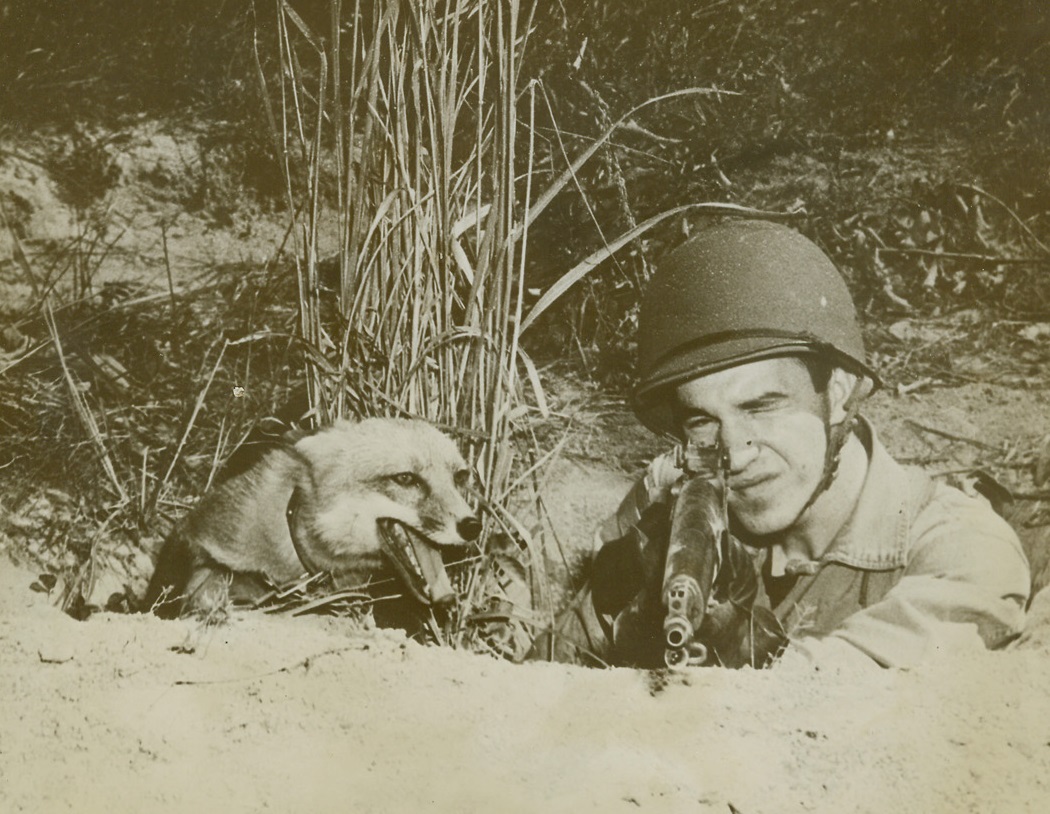
Come Into My Fox Hole, 10/15/1943. Quantico, VA—Rusty the Red Fox should be at home in the fox-hole of his master Pvt. Harry W. Weber, 19, Skouhegan, Me., who aims his rifle in the field of Quantico, Va. Marine base. Rusty is a pet of Pvt. Weber and watches the shooting with proud interest. Credit: U.S. Marine Corps photo from ACME.;
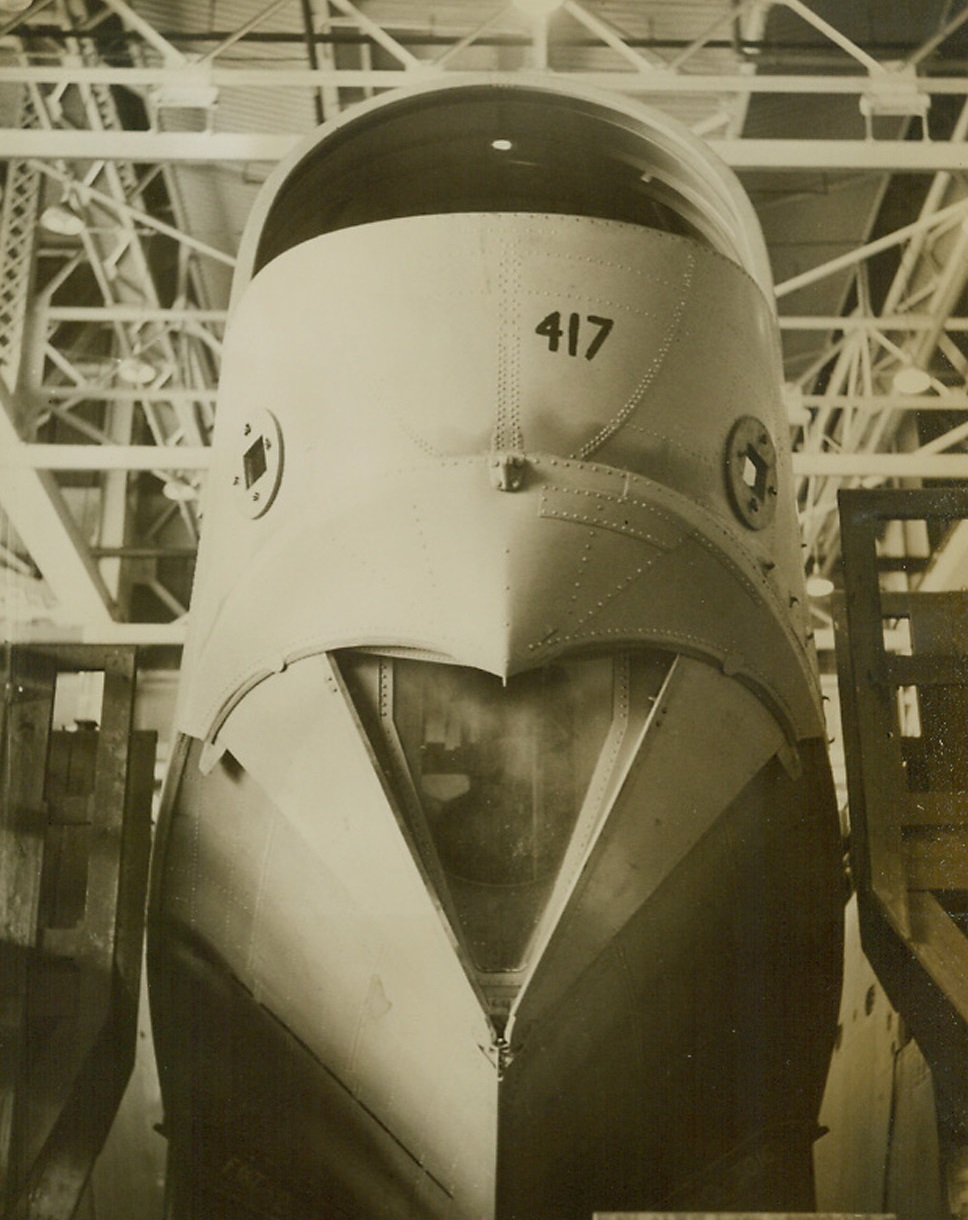
Where Mariner Patrol Bombers Are Built, 10/4/1943. Baltimore, MD—Here is a view of the nose of a huge martin (illegible word) mariner patrol bomber, looking like the head of a bird of prey. The ship is shown on the final assembly line of the Glenn L. Martin plant in Baltimore. (Passed by U.S. Navy censors). Credit: ACME.;
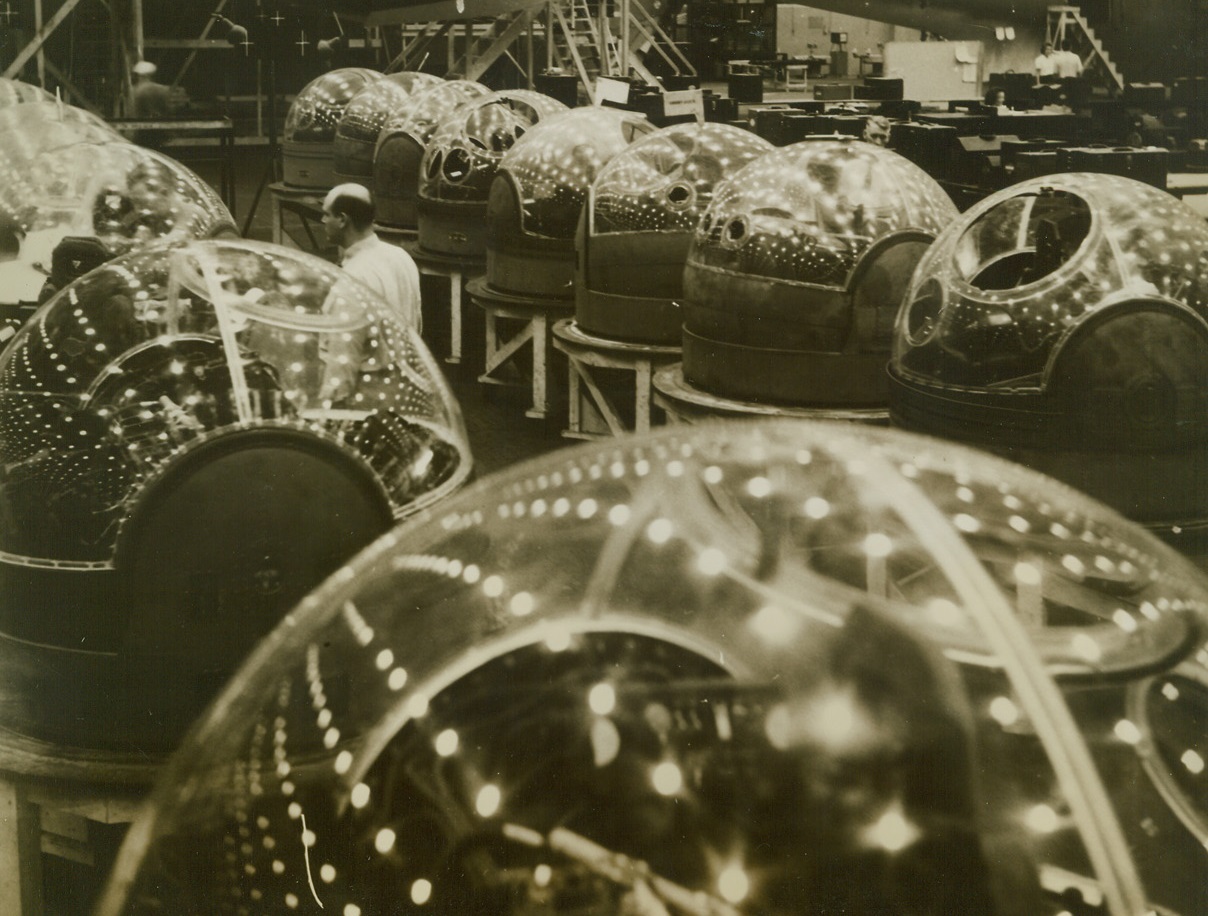
Where Mariner Patrol Bombers Are Built, 10/4/1943.
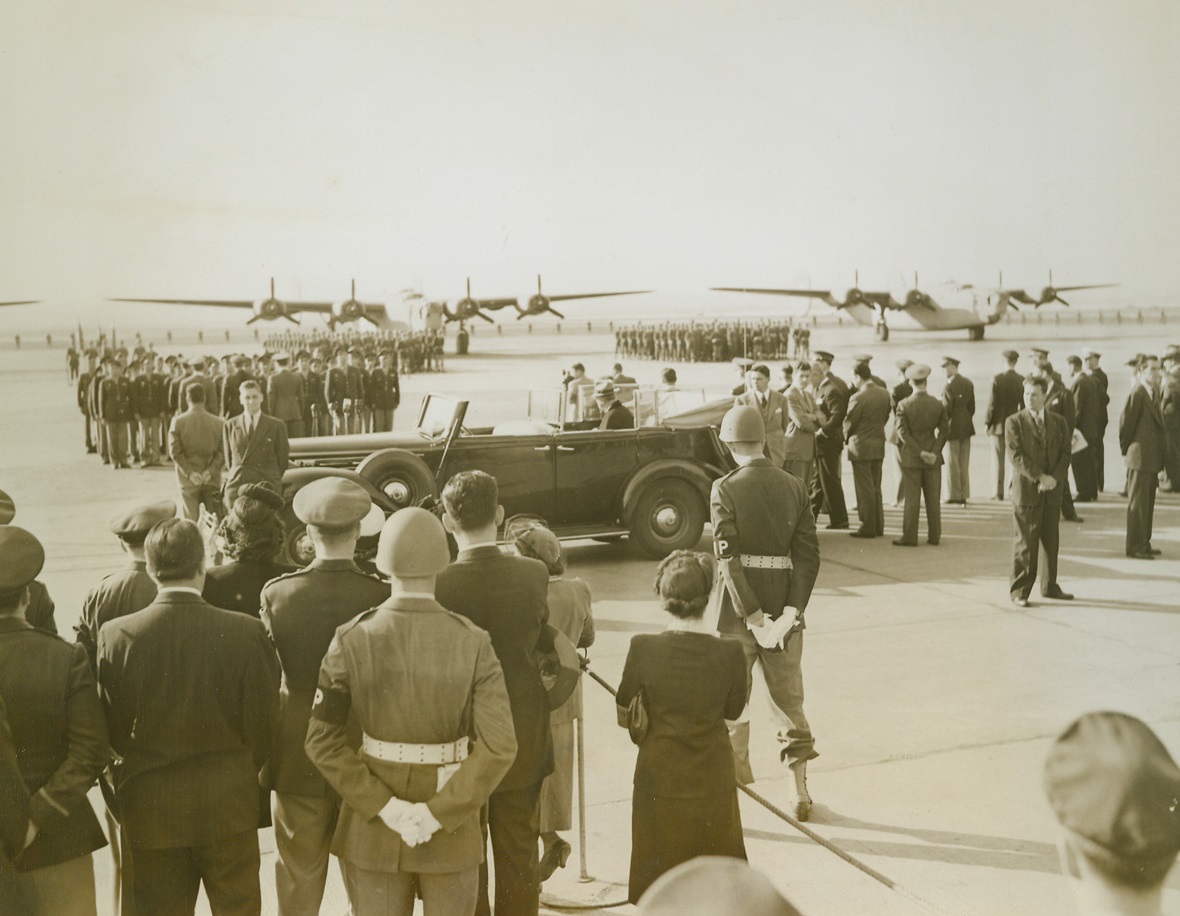
First Yugoslavian Combat Unit Activated, 10/7/1943. Washington, D.C. -- Activation of the first Yugoslavian combat unit in the Army Air Force took place with the dedication At Bolling Field, Washington, of four B-24 Liberator Bombers, and their delivery to the American-trained Yugoslavian combat crews. President Roosevelt watched the ceremonies from his car. Crews and planes, which took off for Europe after the ceremonies, can be seen in the background. Credit: ACME;
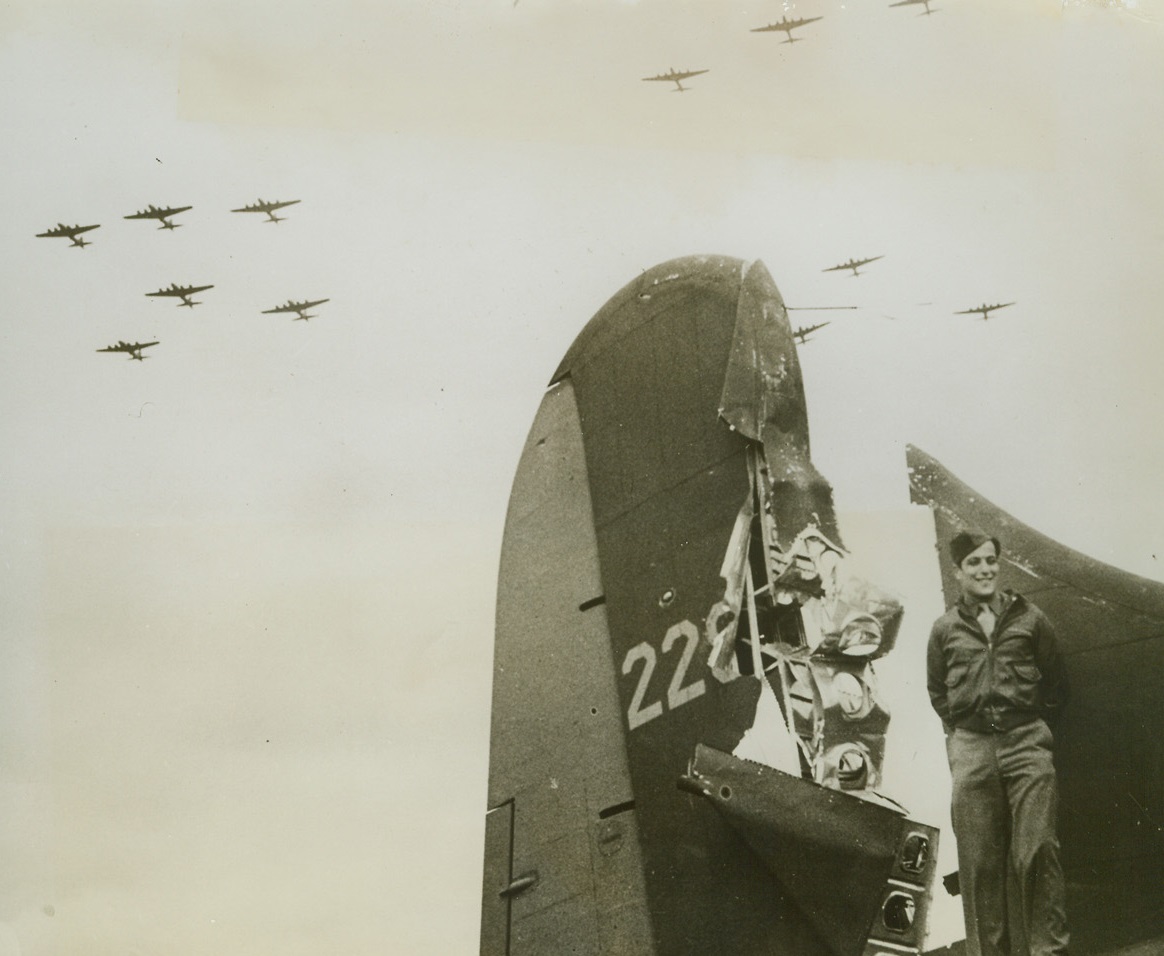
Lucky Gunner Vet of 57 Missions, 10/8/1943. Veteran of 57 missions over enemy territory, Sgt. Harris Goldberg of Brookline, Mass., was Tail Gunner in this war-torn Flying Fortress when the plane was ripped by 20mm fire from enemy cannons. Sgt. Goldberg had completed 42 missions with the RAF before he transferred to his own country’s Air Force. Credit: U.S. Army Air Forces photo from ACME;
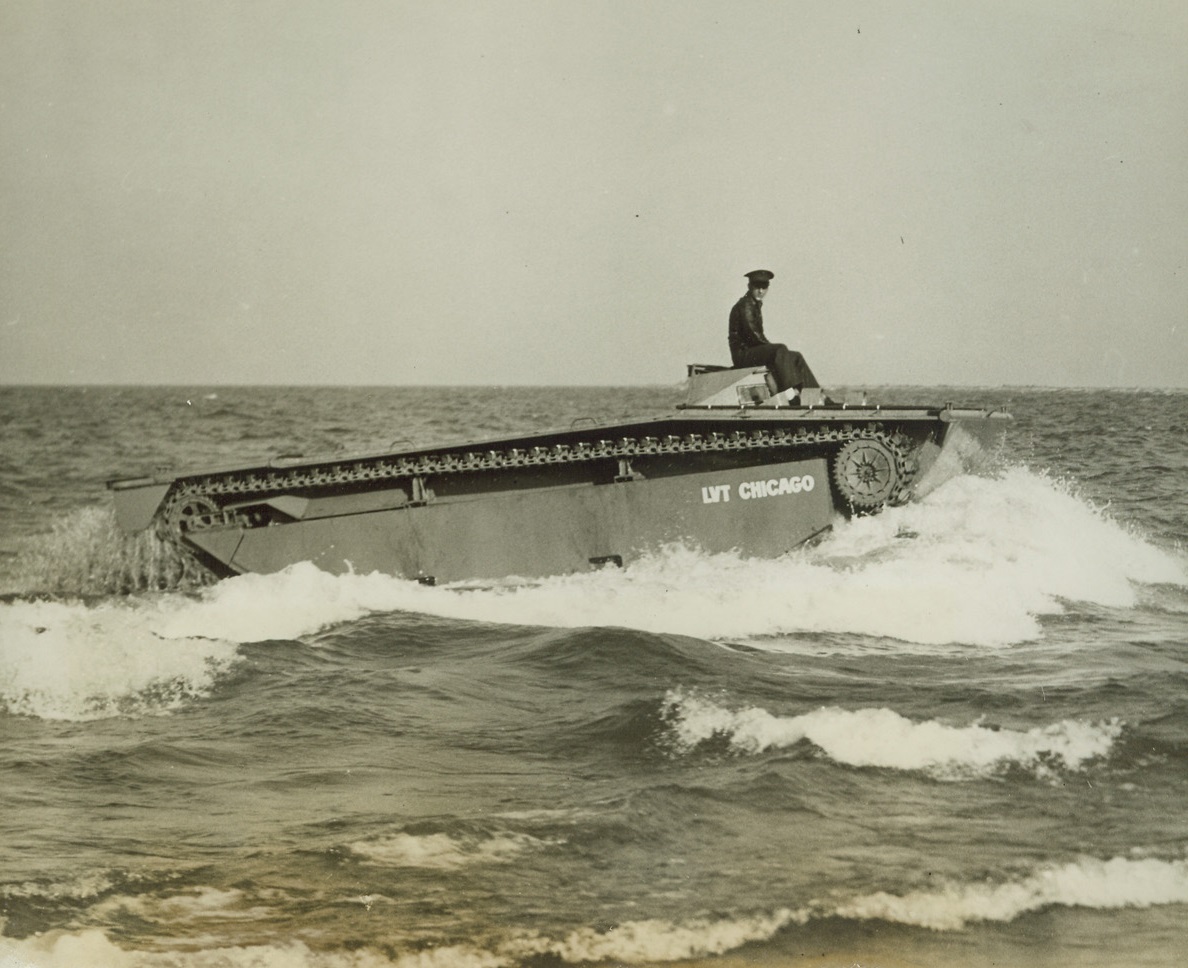
First Public Demonstration of “Water Buffalo”, 10/9/1943. Chicago - The New “Water Buffalo” developed by the U.S. Marine Corps, as the successor to the famous “Alligator” used in landing operations at Attu, Sicily, Solomons, and the Italian mainland, brought to Chicago for current war loan drive show, is shown as it entered Lake Michigan during its first public appearance. The LVT or “Landing Vehicle Tractor”, built by Borg-Warner Corp., is driven by members of the Marine Amphibian Tractor Detachment from Dunedin, Fla. Credit: ACME;
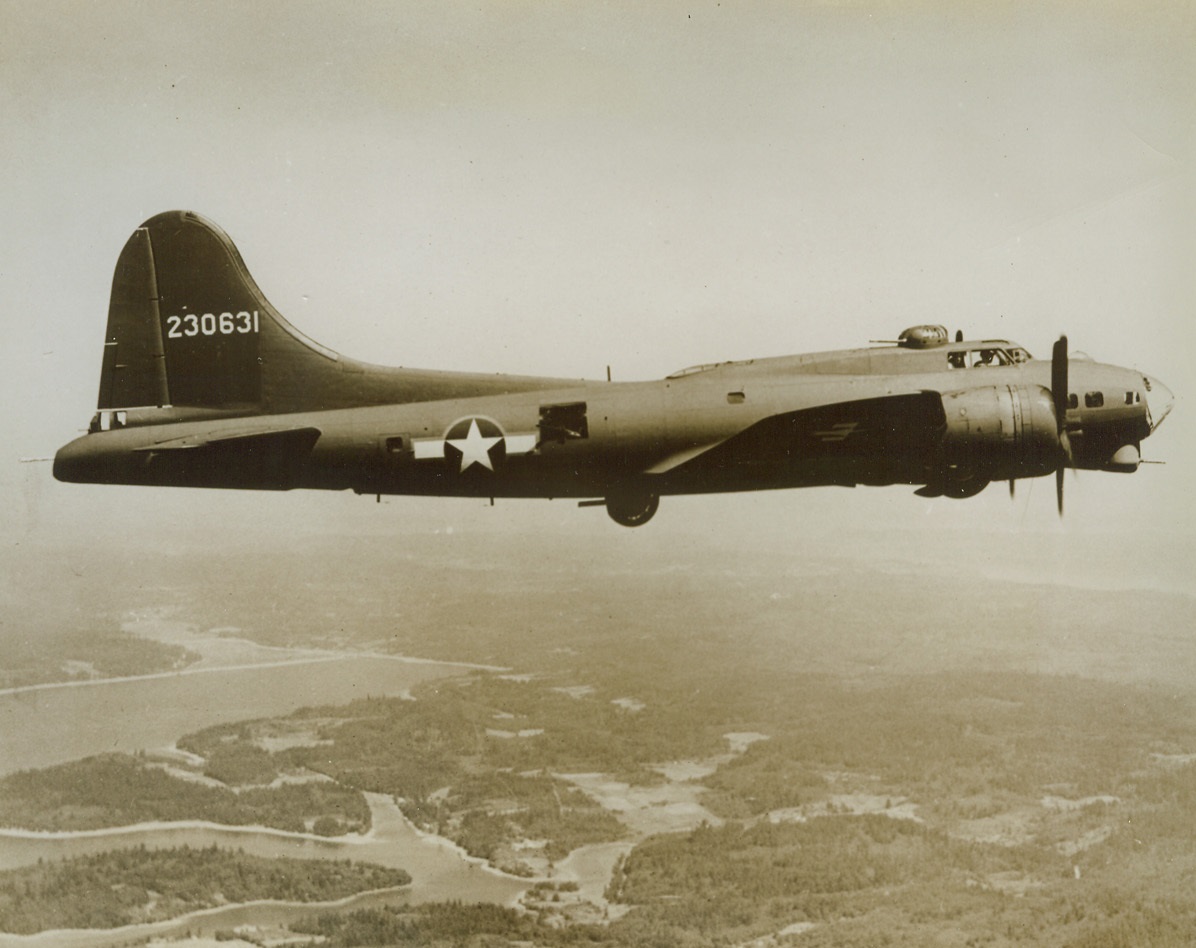
Eighth Generation, 10/6/1943. Here is the eighth member of the B-17 family, the B-17-G Flying Fortress, ready for combat with the enemy. The new plane boasts a “chin turret”, which is armed with two .50 caliber machine guns. Operated by remote control from the bombardier’s “green house”, the new turret is the answer to the Nazis’ favorite tactic, the frontal attack. Credit: ACME;
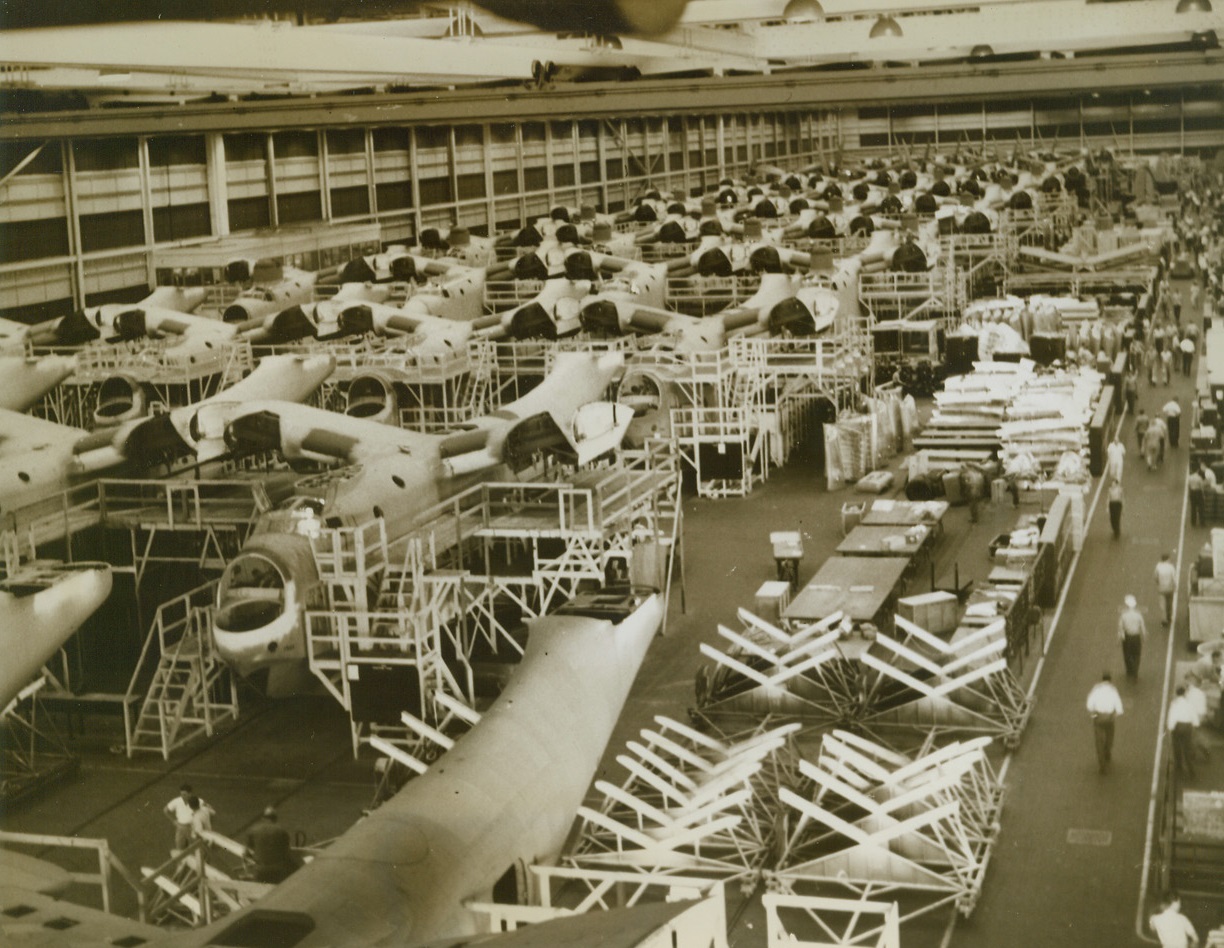
Where Mariner Patrol Bombers are Built, 10/4/1943. Baltimore, MD. - Here is a view along the final assembly line at the Glenn L. Martin plant in Baltimore, where huge Martin PBM-3 Mariner Patrol Bombers are built. (Passed by U.S. Navy Censors). Credit: ACME;
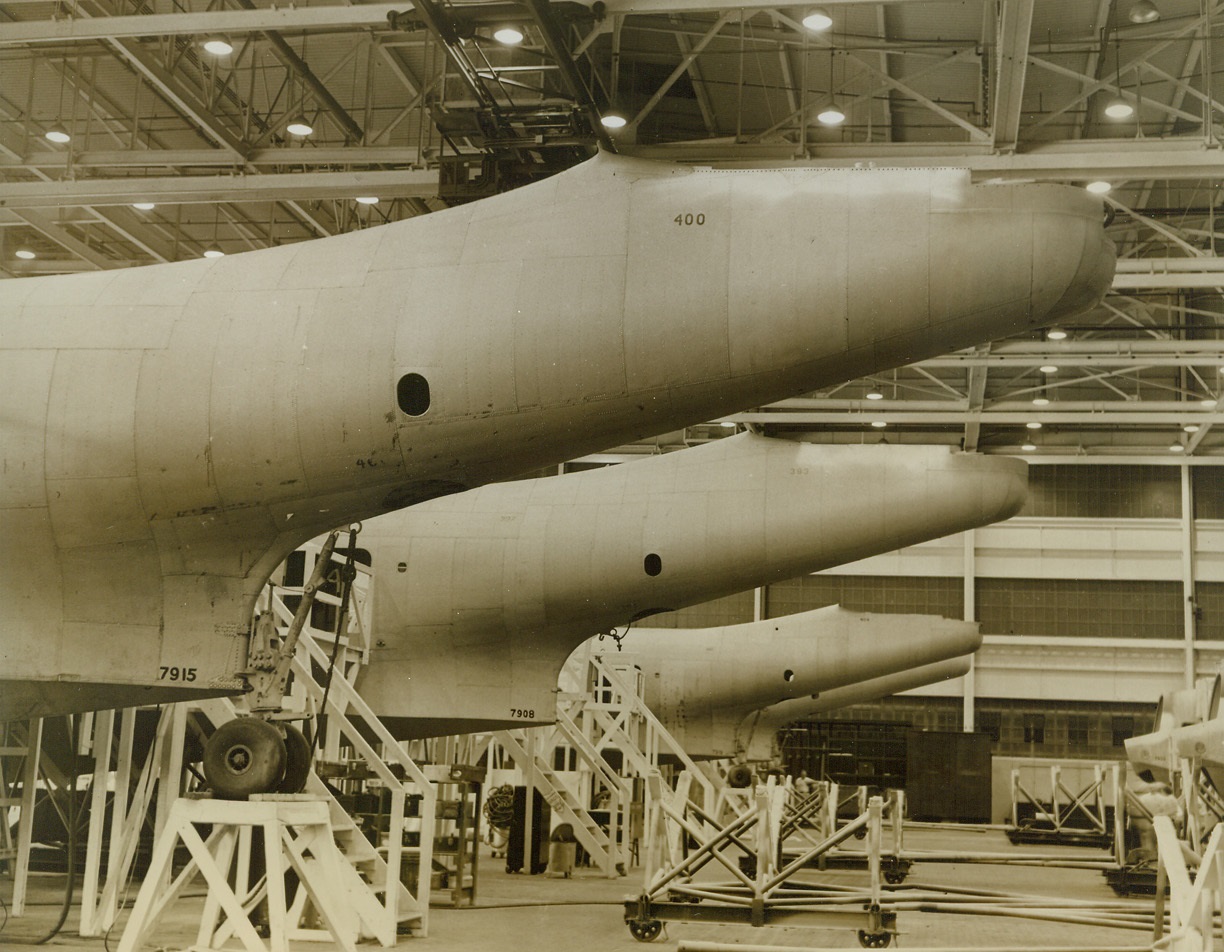
Where Mariner Patrol Bombers are Built, 10/4/1943. Baltimore, MD. - A view of tail sections of huge Martin PBM-3 Mariner Patrol Bombers, along the final assembly line at the Glenn L. Martin plant in Baltimore. (Passed by U.S. Navy Censors). Credit: ACME;
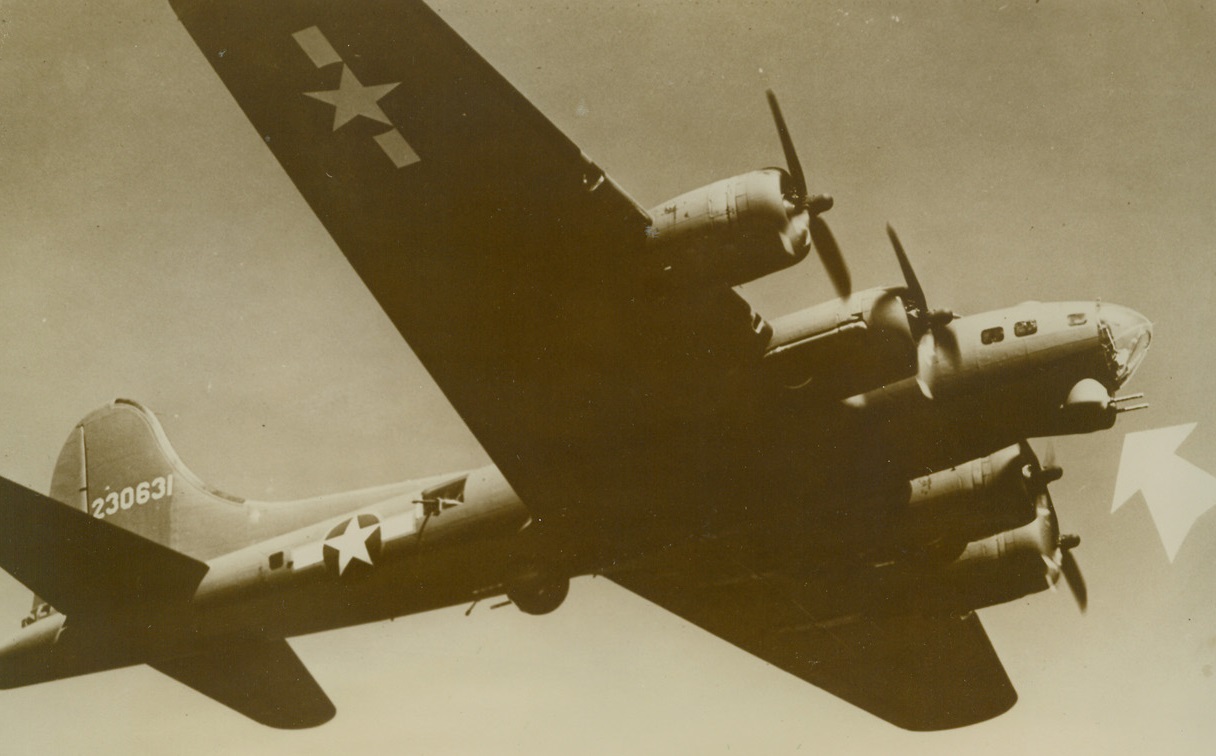
Deadly Chin “Whiskers”, 10/7/1943. Seattle, Wash. - Firepower of the Boeing Flying Fortresses, already credited with being most effective of any aircraft in existence, is increased still further by addition of power-operated “chin turret.” Addition of the new turret, heavy-hitting .50 caliber machine guns, gives the B-17G model a total of 13 guns - four twin gun turrets plus five single guns in various parts of the plane. Credit: ACME;
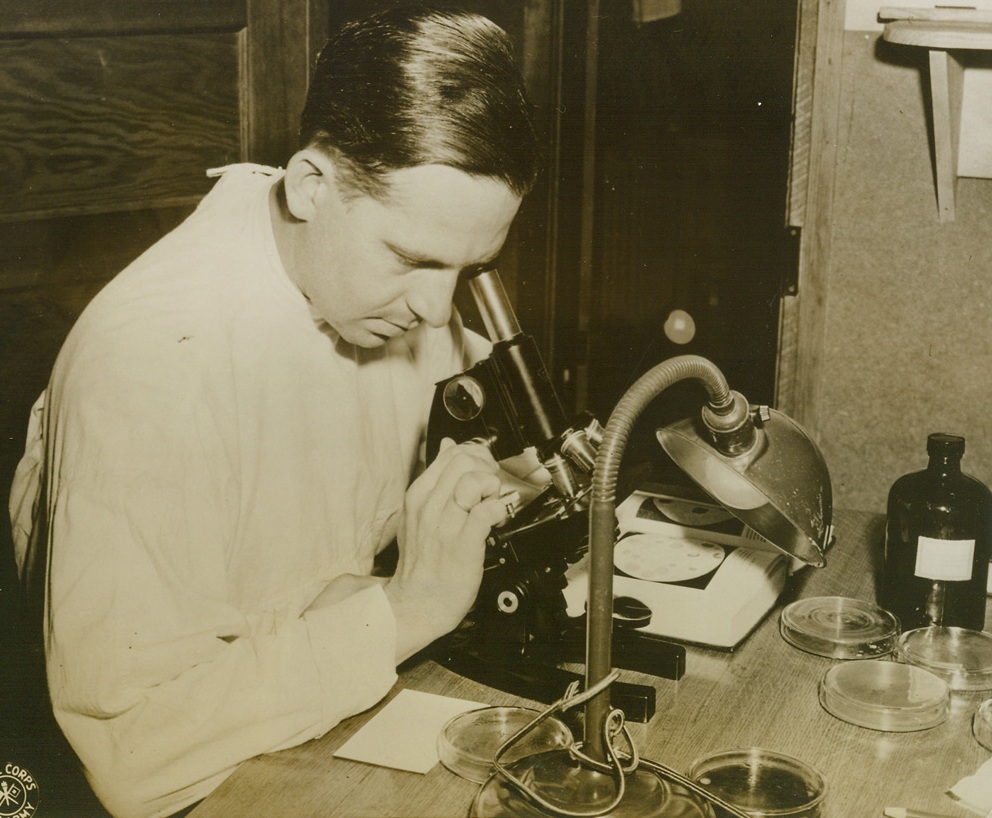
Life at the Largest Nazi Prisoner of War Camp, 10/4/1943. Aliceville, Alabama -- Thousands of German prisoners now occupy miles and miles of guarded territory at Aliceville, Alabama, at the country’s largest internment camp for captured Nazis. Tennis courts, badminton and various ball game facilities are available between the barracks within each compound, each compound containing 1,000 prisoners. A contest in landscaping resulted in beautifully kept green lawns, sculptured animals and patterned flower gardens, while the opportunity to build exercise aids led to the erection of horizontal bars, broad-jump pits and shot-put courses. Very few Nazis have tried to escape, and not one has succeeded. These photos show a few typical scenes at the Aliceville internment camp. New York Bureau He’s a German prisoner of war, but he is still a laboratory technician and his skill is recognized and appreciated by American officials at the giant internment camp. Other prisoners are helped to stay in good health by this Nazi. Credit: U.S. Army Signal Corps photo from ACM;
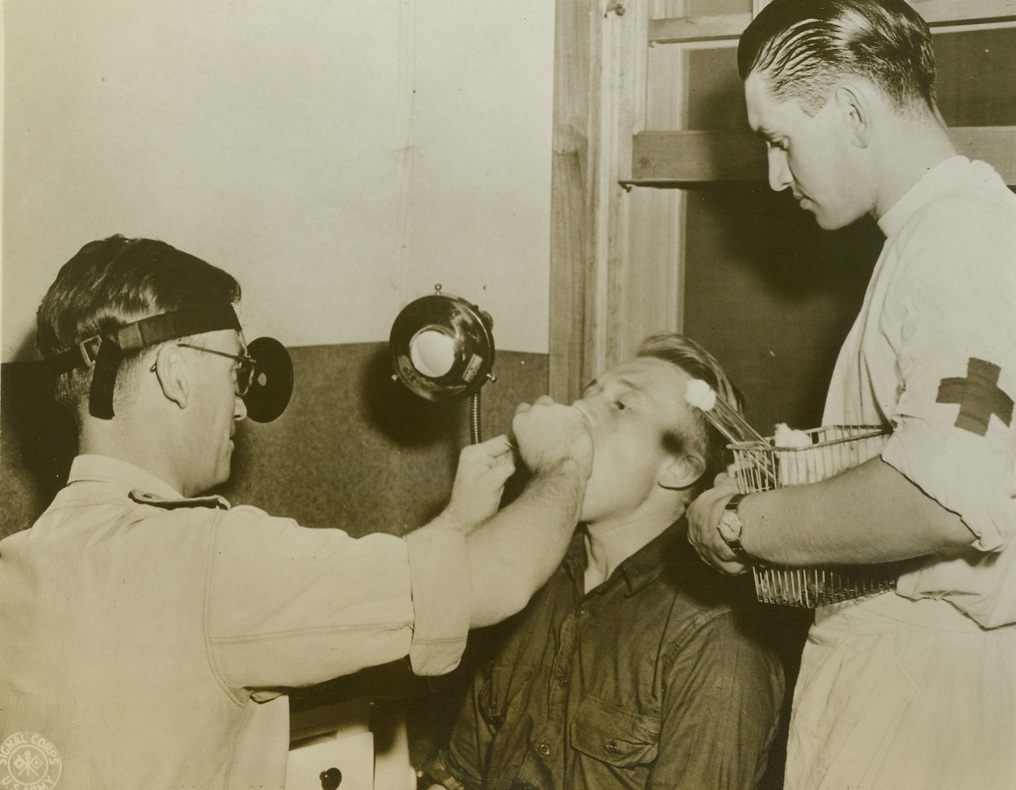
Life at the Largest Nazi Prisoner of War Camp, 10/4/1943. Aliceville, Alabama -- Thousands of German prisoners now occupy miles and miles of guarded territory at Aliceville, Alabama, at the country’s largest internment camp for captured Nazis. Tennis courts, badminton and various ball game facilities are available between the barracks within each compound, each compound containing 1,000 prisoners. A contest in landscaping resulted in beautifully kept green lawns, sculptured animals and patterned flower gardens, while the opportunity to build exercise aids led to the erection of horizontal bars, broad-jump pits and shot-put courses. Very few Nazis have tried to escape, and not one has succeeded. These photos show a few typical scenes at the Aliceville internment camp.;
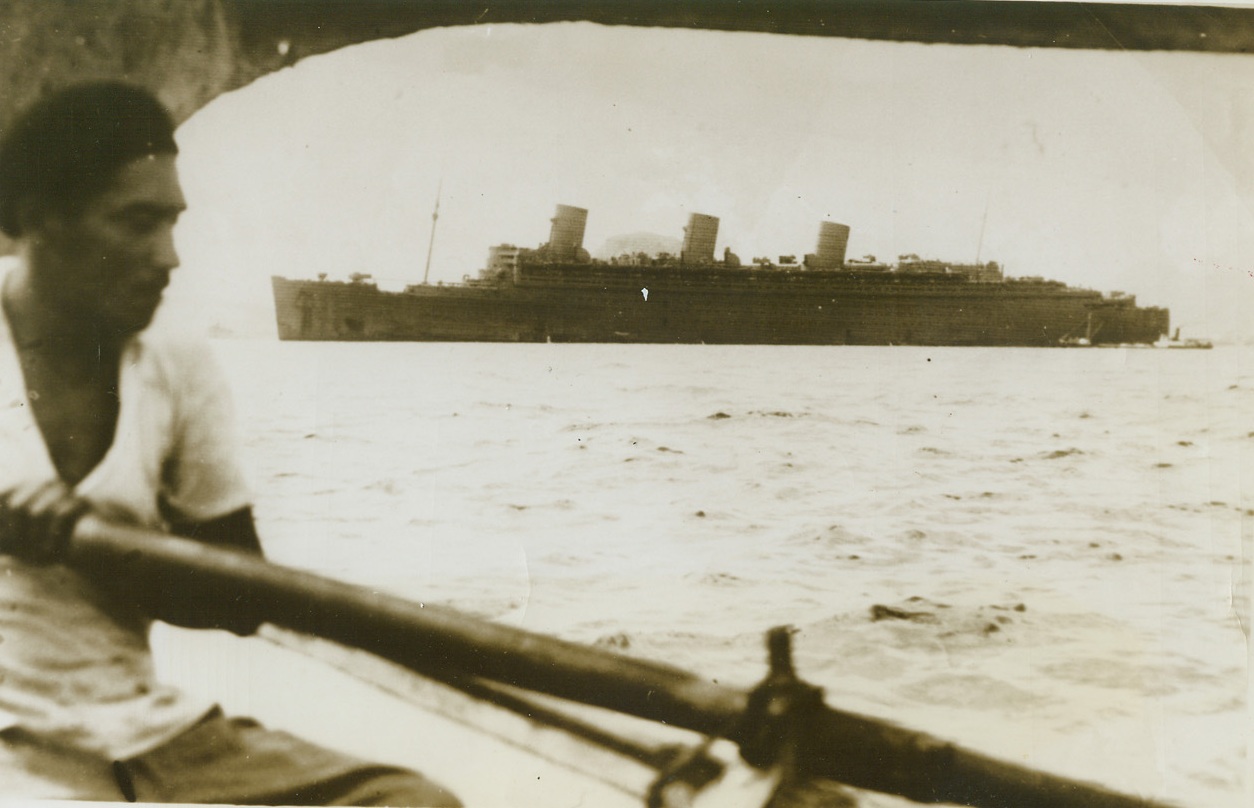
Queen Mary in War Paint, 10/2/1943. Rio de Janeiro -- Wearing her drag, gray coat of war paint, the former luxury liner Queen Mary is shown in Rio de Janeiro harbor. Made some time ago, this photo has just been cleared for release by the British government. At the time, she was carrying American soldiers on a regular 12-day run from New York to South Africa. Credit: ACME;
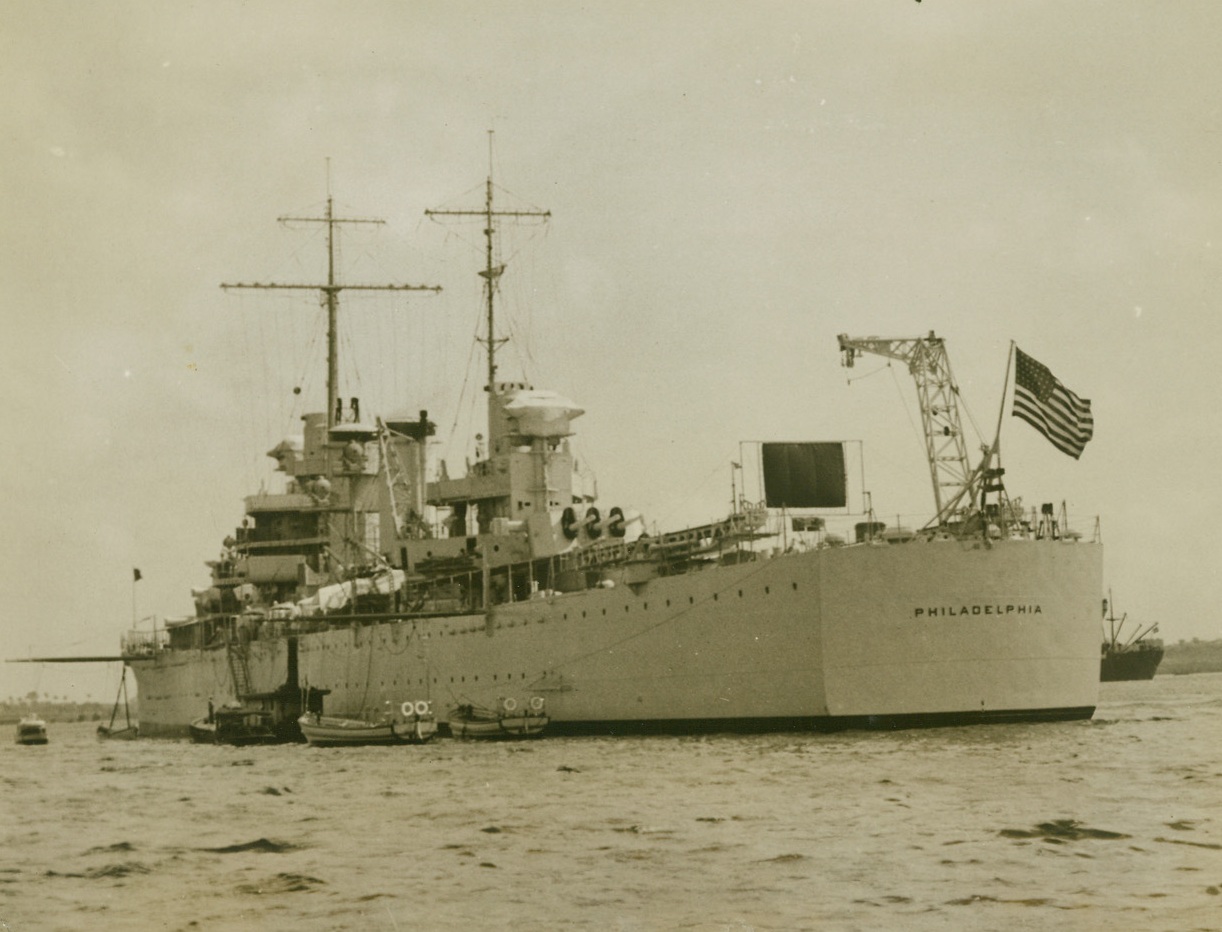
REPORTED “HEAVILY DAMAGED”, 10/14/1943. LONDON—A German Transocean News Agency Broadcast, heard in London today (Oct. 14th), said that dispatches from La Linea, Spain, reported that the United States Cruiser, Philadelphia (above) had arrived at Gibraltar, heavily damaged. Credit Line (ACME);
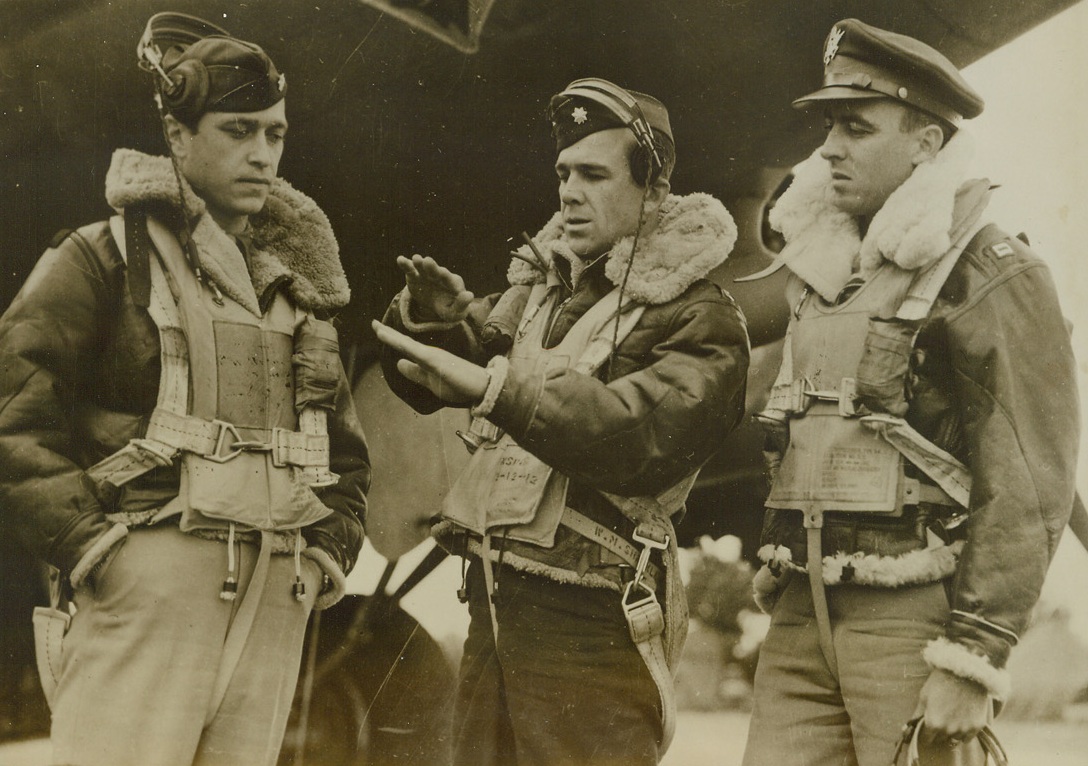
AIRMEN’S KINDERGARTEN, 10/7/1943. ENGLAND—These are some of the men who are doing an expert job of bombing Europe from their “Kindergarten Station” in England. The Station won its name because every member of its staff is under the age of 30. Left to right are: Major William Tesla, 25, of Pittsburgh, Pa; Major Septime S. Richard of Jackson, Miss., who, at 29, is “old man” of the group; and Capt. Archie Benner, 25, of El Paso, Texas. Credit Line (ACME);
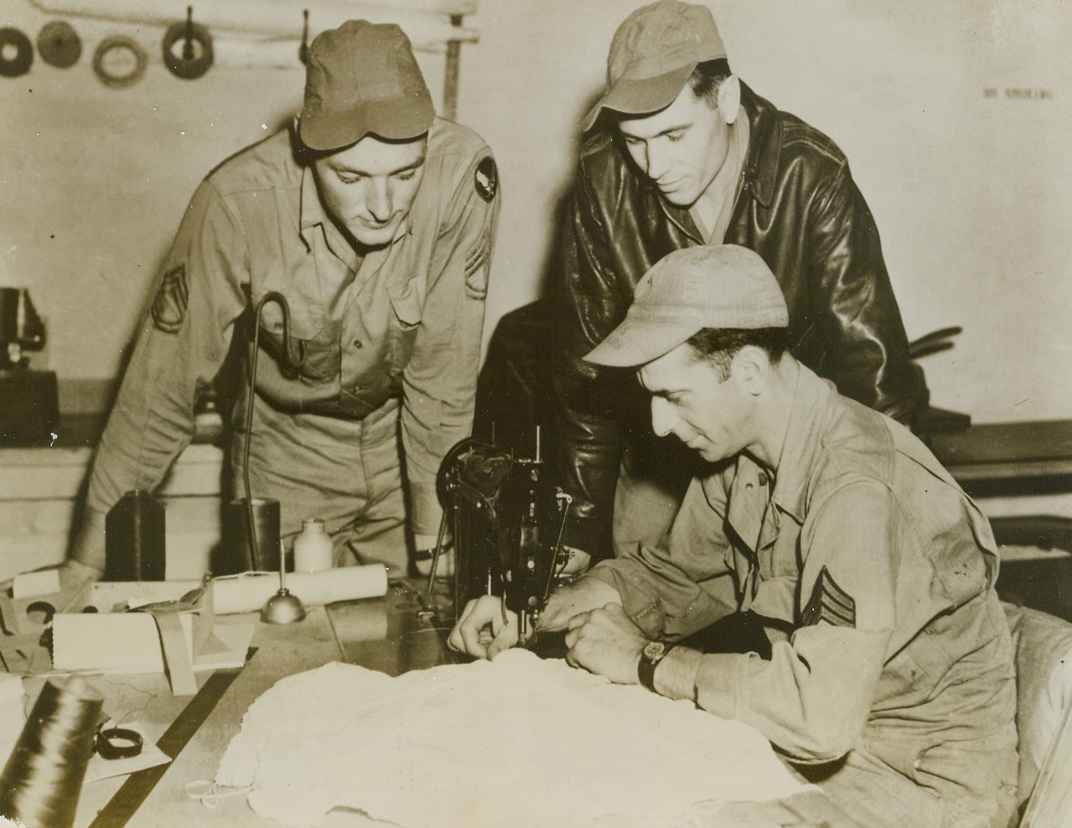
AIRMEN’S KINDERGARTEN, 10/7/1943. ENGLAND—Eager young officers of the Flying Fortress “Lucky Strike” talk over their latest mission after returning to their base, the “Kindergarten Station” in England. The base was named because none of its officers are more than 30 years of age. Left to right: Lieutenants Norman L. Wider, pilot, of Richmond Hills, N.Y.; Juan J. Porvencio, co-pilot, El Paso, Texas; and Douglas Baker, bombardier, Gloverville, N.Y. Credit Line (ACME);
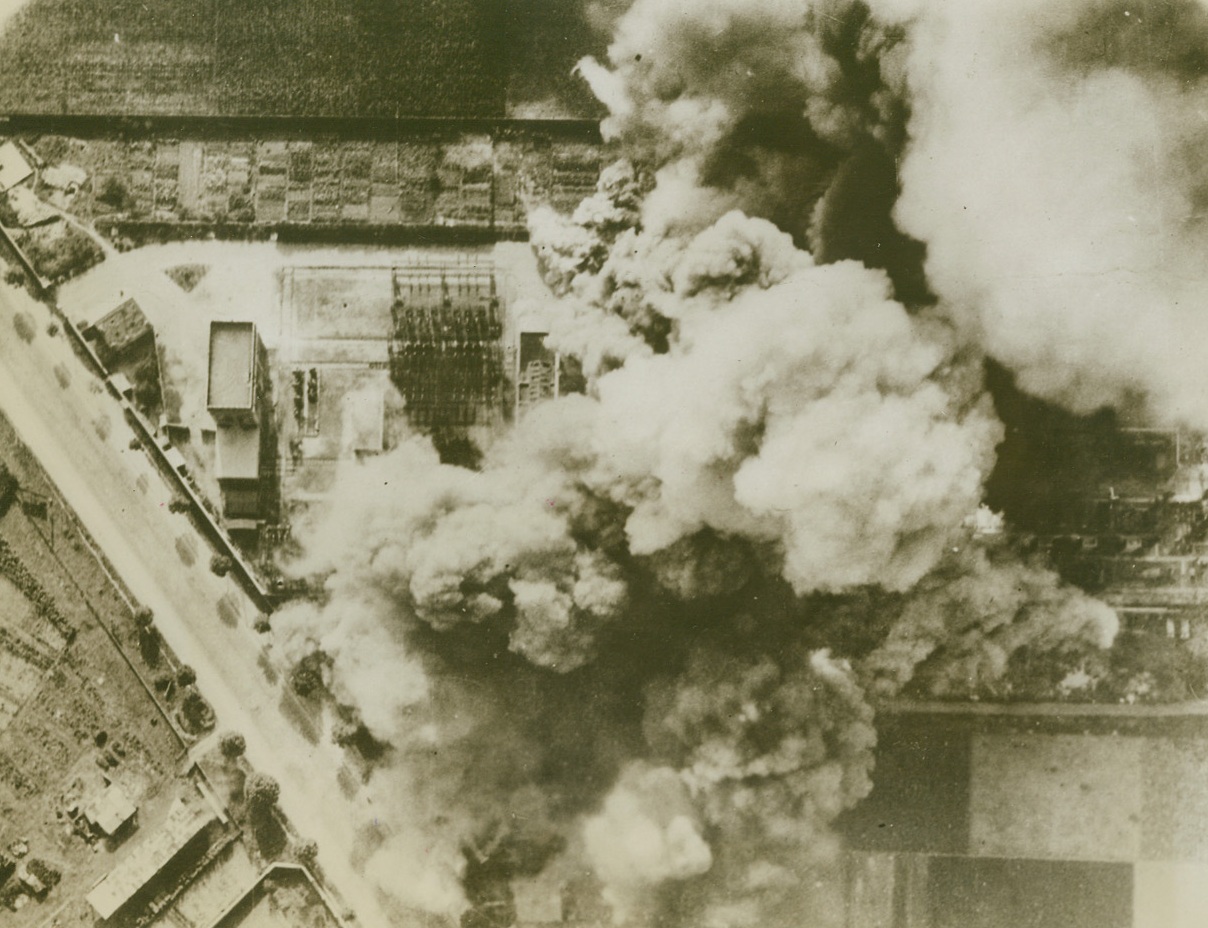
Paris Switching Station Bombed, 10/22/1943. Paris – This photo shows attack by RAF Boston Home-Light Bombers on the Chevilly-Larue Switching Station near Paris on Oct. 3rd. A great volume of smoke arises from the section of the station in which are located 220 K.V. busbars and isolating switches, walled cells containing transformers and a large building housing offices, control rooms and compensating apparatus. Credit: ACME;
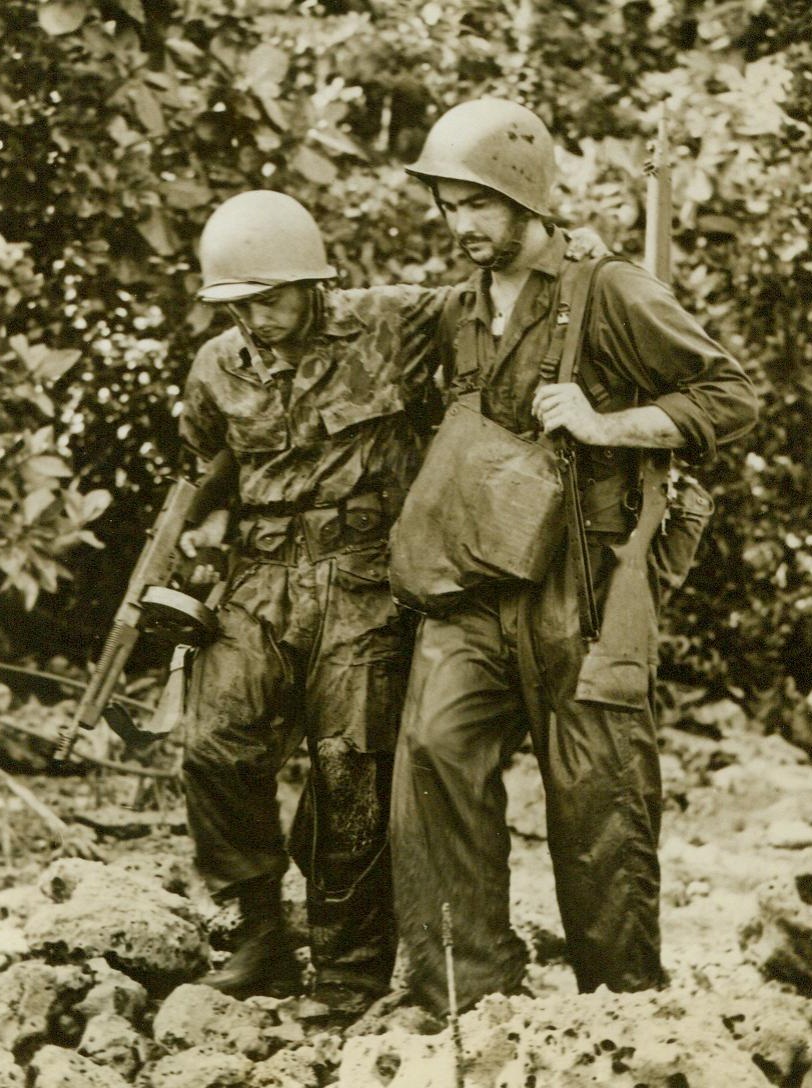
Wounded, They Help Each Other, 10/13/1943. New Georgia Island—In the best tradition of the service, two wounded American infantrymen help each other out of the dense jungles of New Georgia. Heading for the beach, they limp toward a Higgins Boat that evacuated them to a safer area. 10/13/43 (ACME);
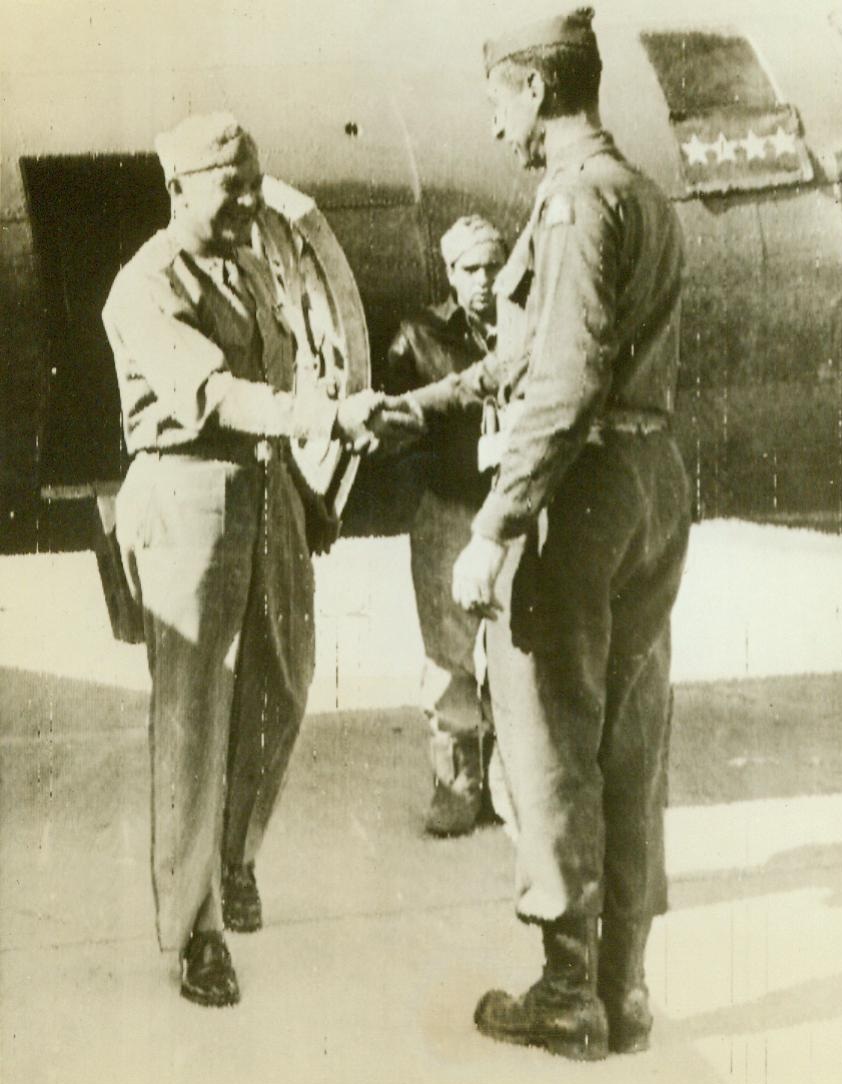
General Ike Visits Italy Front, 10/25/1943. Italy—General Mark W. Clark (Right), Commander of the Allied 5th Army, greets General Dwight D. Eisenhower, Commander-in-Chief of Allied forces, who arrives at the Naples airport for a tour of the Italian battlefront. Probably words of congratulation are on the lips of “General Ike” for the thorough job being accomplished by Clark’s troops in beating back the Germans. 10/25/43 (ACME Raidotelephoto);
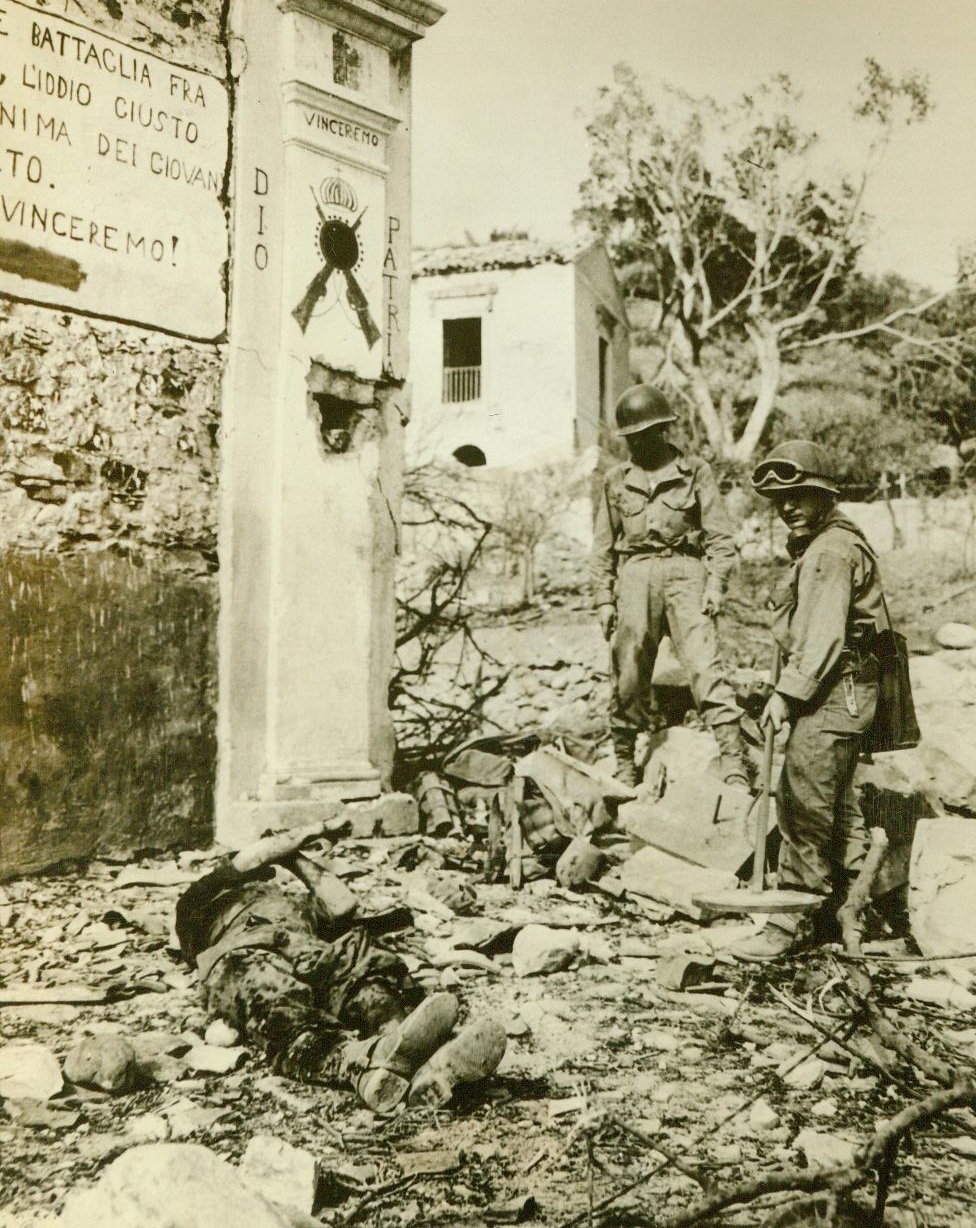
American Victim of Nazi Booby-Trap, 10/4/1943. This American soldier, (left, foreground), killed by a Nazi booby-trap in Sicily, fell before a sign extolling Fascism and ending with the word “Vincermo”, whichmeans “We will Win”. Before the Yank’s buddies could approach his body, they had to use a mine detector to make sure there were no more Nazi traps. 10/4/43 (ACME);
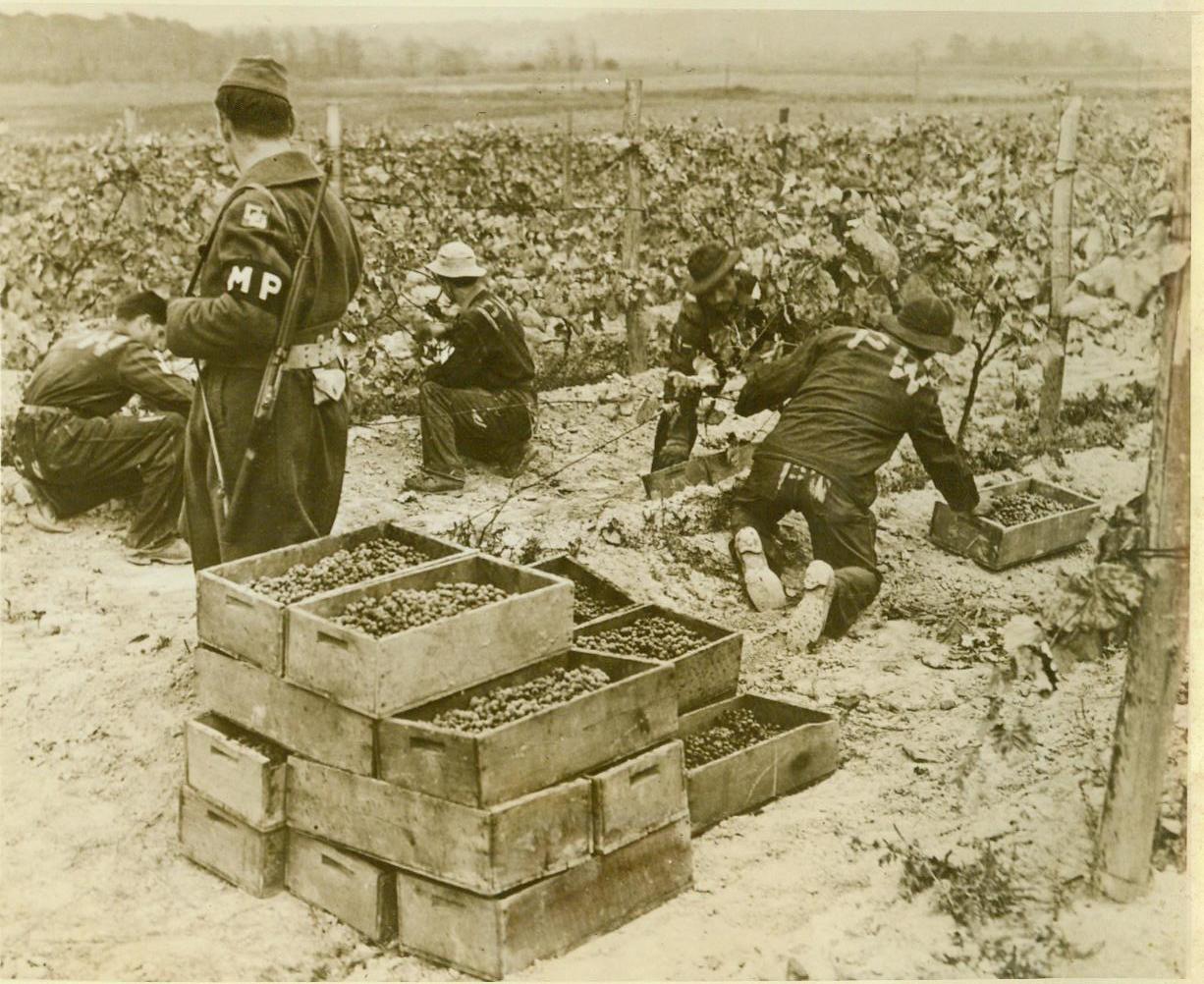
A Crop They Know Well, 10/25/1943. Fredonia, N.Y. – The Italian Prisoners of War, helping harvest grapes on the William Russo farm near Fredonia, N.Y., receive 80 cents a day for their labor as compared with their pay of 26 cnts per day in the Fascist Army. From his earnings, each prisoner receives a credit of $3.00 per month at the Camp Canteen, and the rest will be handed to him when he is freed by Allied victory. 10/25/43 ACME;
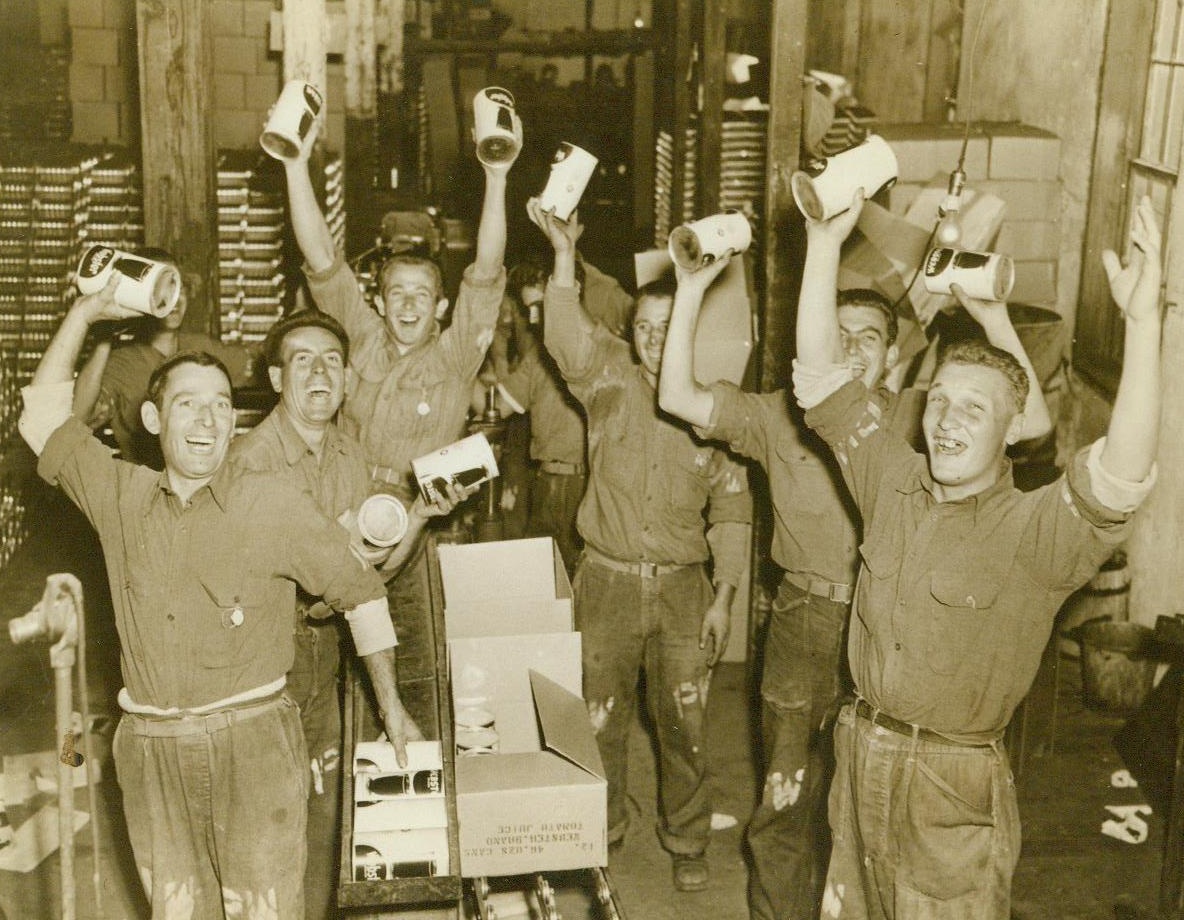
They'd Like To Can Hitler, 10/14/1943. Rochester, N.Y. -- A group of Italian war prisoners working at the Webster Canning Company Plant receive the news of Italy's Declaration of War on Germany with wild, joyful whoops. The prisoners, who will continue their jobs at the canning company, plunged into their work with new enthusiasm when they learned that Italy was out to get Hitler 10/14/43 (ACME);
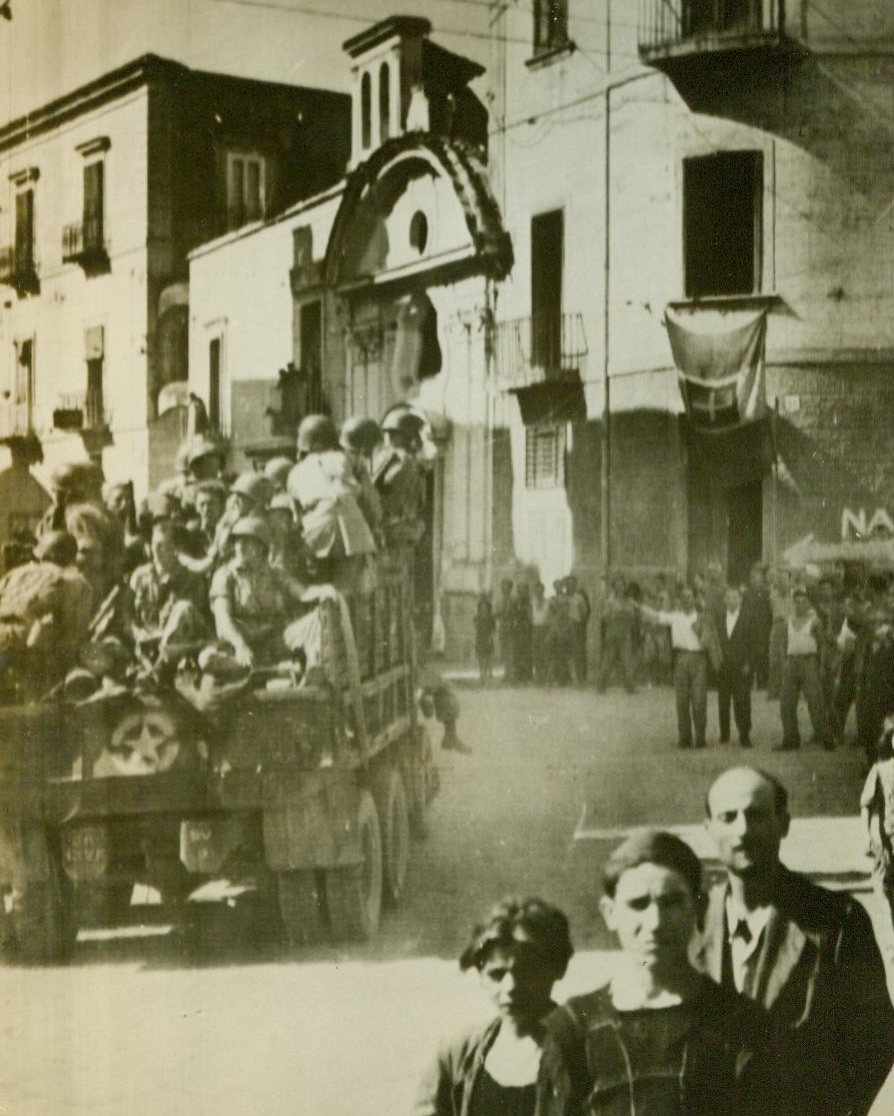
American Troops Enter Naples, 10/4/1943. In this photo flashed to the U.S. today by Radiotelephoto, a truck loaded with U.S. troops rolls into Naples, Italy, as natives stand by to watch them. Note arrow, (right, background) indicating the route to Naples Proper. 10/4/43 (ACME);
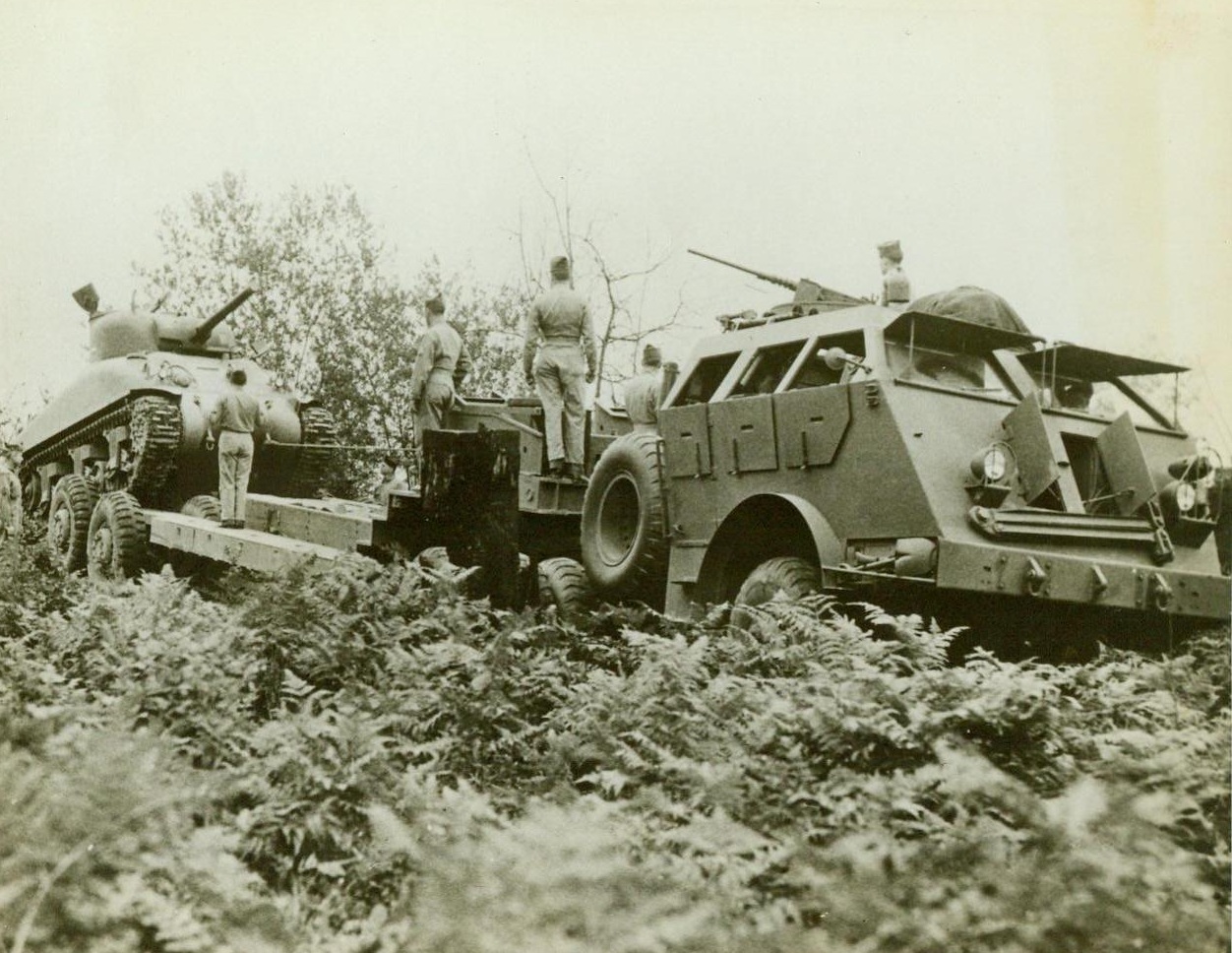
And Now, Tanks Ride To Battle, 10/28/1943. The tank recovery vehicle, known to the War Dep't as the M-25, takes on a tank. These gross vehicles, weighing over 40 tons carry tanks or armored vehicles to front lines and disabled ones from the battlefields for repairs. They make it possible for tanks to enter battle with full fuel tanks and cool motors. Each vehicle is armed to protect itself from enemy ground and air attack and can operate on its own for four days. 10/28/43 (ACME);
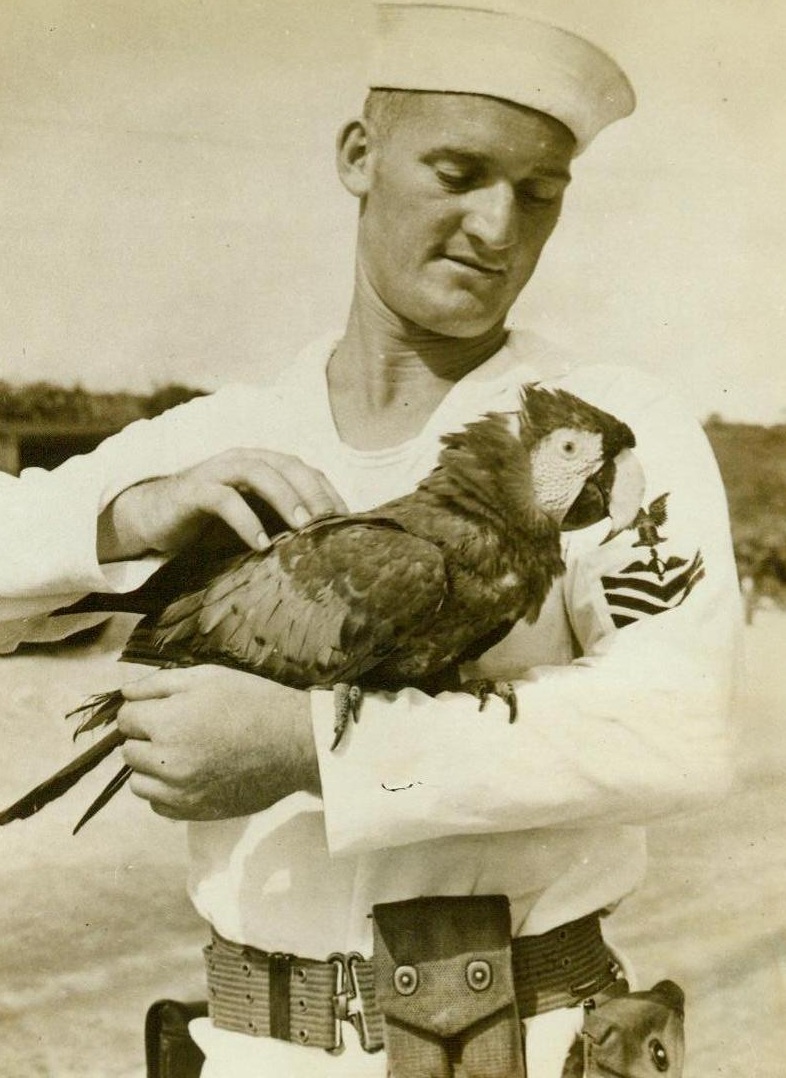
Duration Pet, 10/29/1943. Bahamas – Raymond Perry, Aviation Machinist’s Mate ICL., of Wilsondale, W.Va., is worrying about the United States law barring the entrance of Macaws into the nation. He guesses “Mike” will have to be a duration pet and a companion for the rest of his stay at a Naval Air Station on a lonely Bahamas Island, which we received from the British in exchange for destroyers 10/29/43 (ACME);
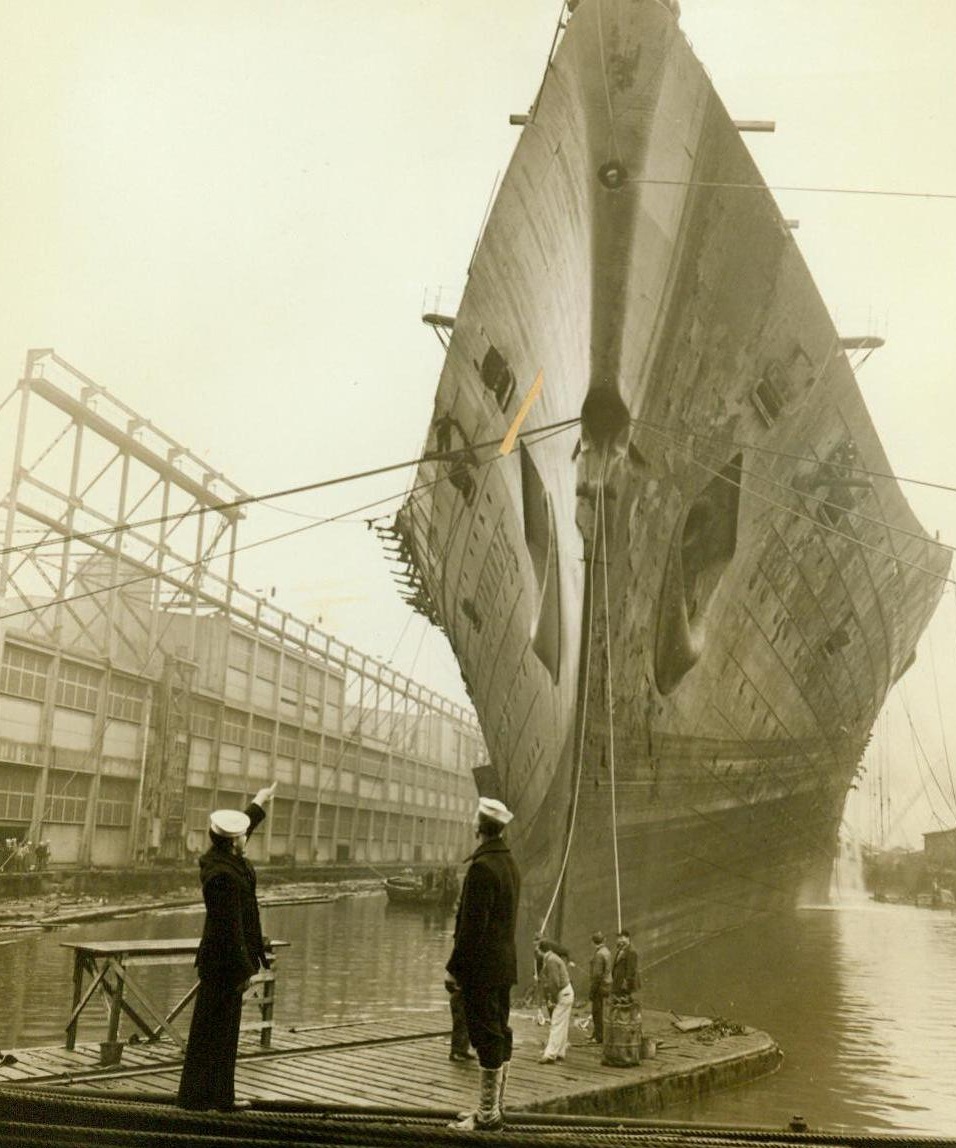
On Even Keel, 10/27/1943. New York: - The U.S.S. Lafayette, the former luxury liner Normandie which burned and capsized at its pier in the North River Feb. 9, 1942, is on even keel again. And in fitting ceremonies, the ship was turned over to the Navy, Oct. 27, by Merritt, Chapman & Scott; salvage contractors, for refitting in dry dock. Cost of salvage operation was four and a half million dollars. 10/27/43 (ACME);
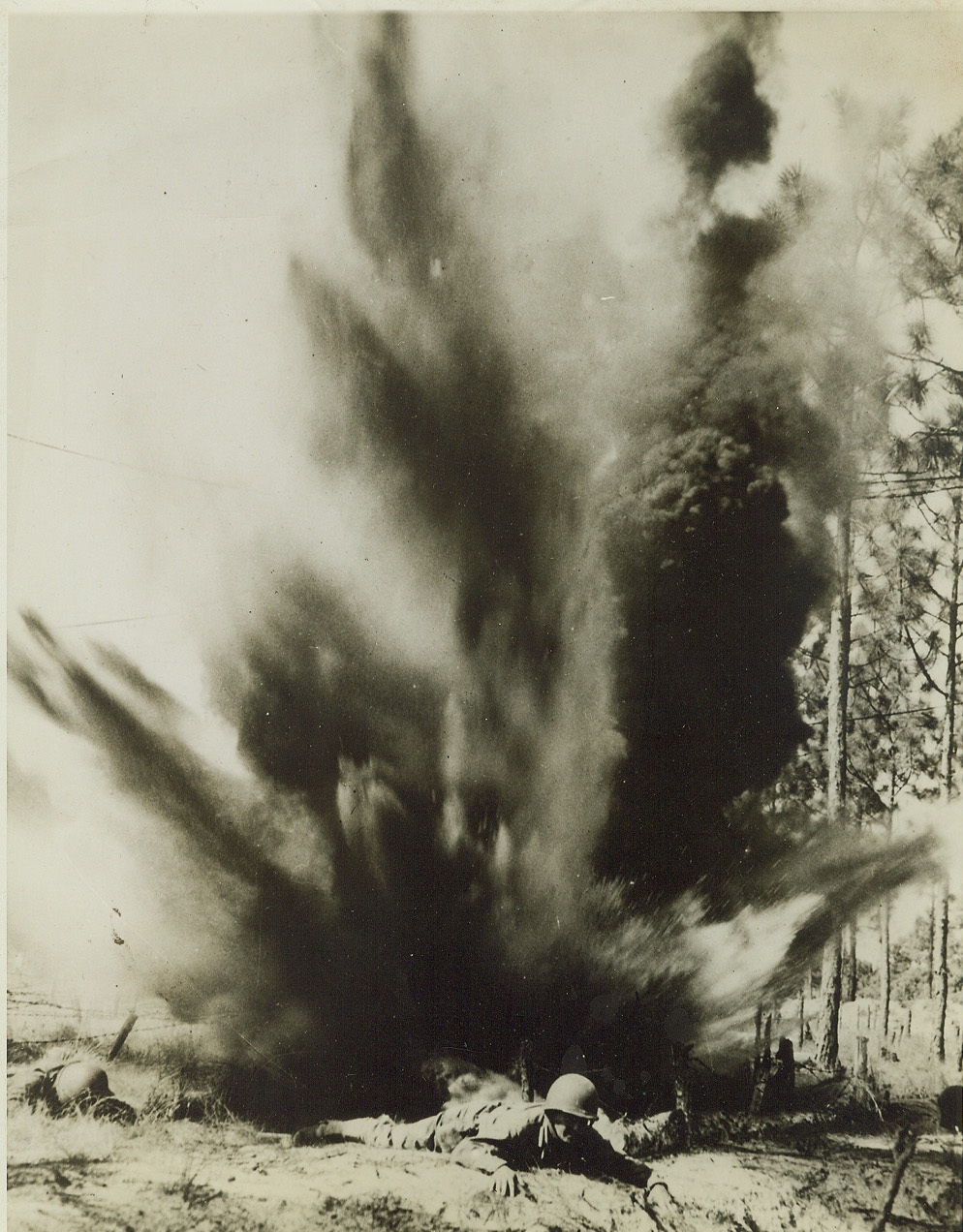
Dress Rehearsal for War, 10/14/1943. CAMP DAVIS, N.C. – This isn’t the real business, but it’s uncomfortably close to it. Officer candidates at the Antiaircraft Artillery School at Camp Davis, N.C. hug the good earth just after an explosive is set off on the combat conditioning course. Your credit: must read “ACME”;
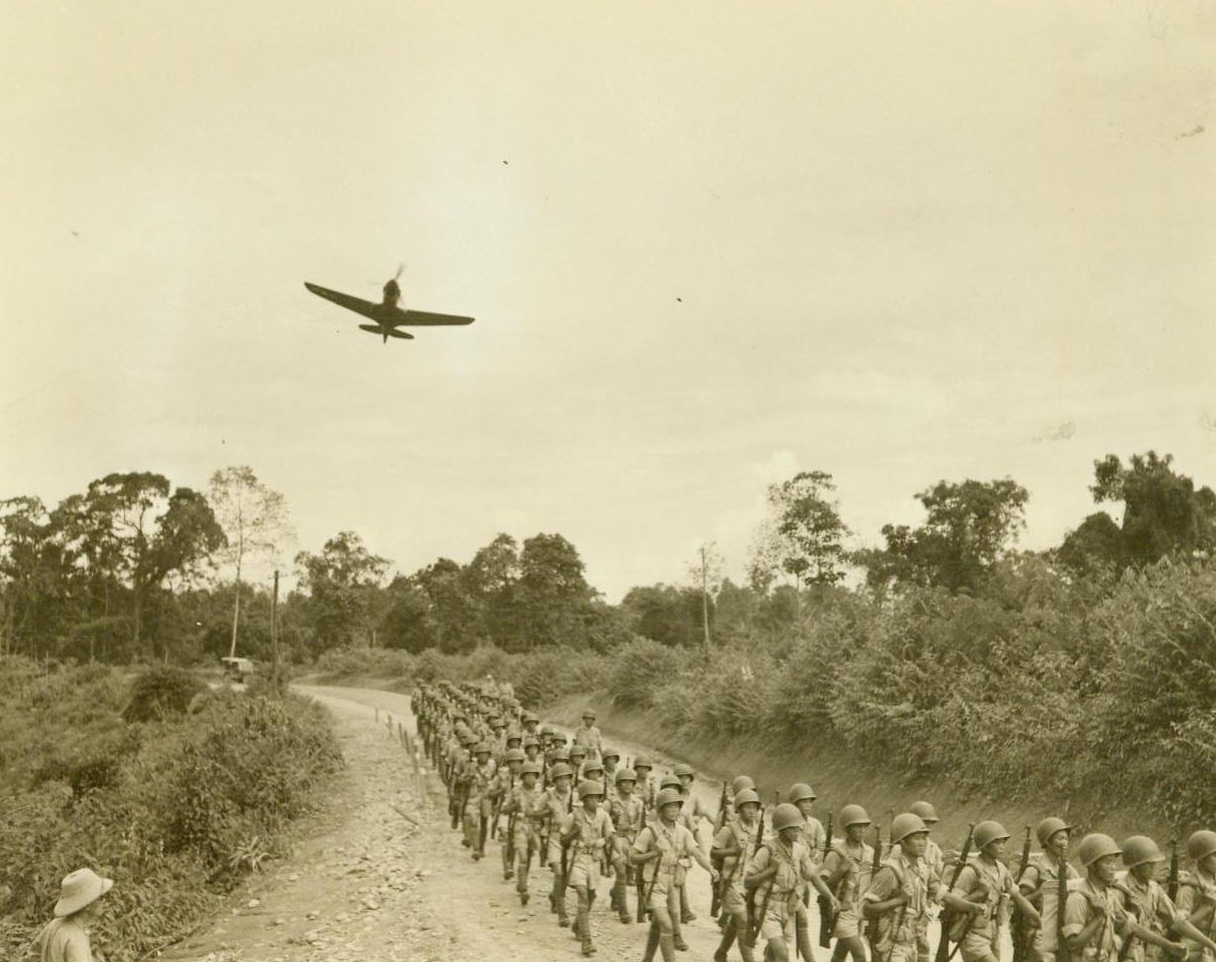
Along The Tokio Road, 10/14/1943. CBI Theater – With American P-40s giving them top cover, U.S. Army-trained Chinese troops march down the “Tokio Road.” The new highway, leading from India to China, was given the nickname by the Americans who built it. For the first time in history, American and Chinese soldiers are battling side by side against the common enemy. Each unit of the front-line Chinese force is accompanied by American officers and observers. 10/14/43 (ACME photo by Frank Cancellare, War Pool Correspondent);
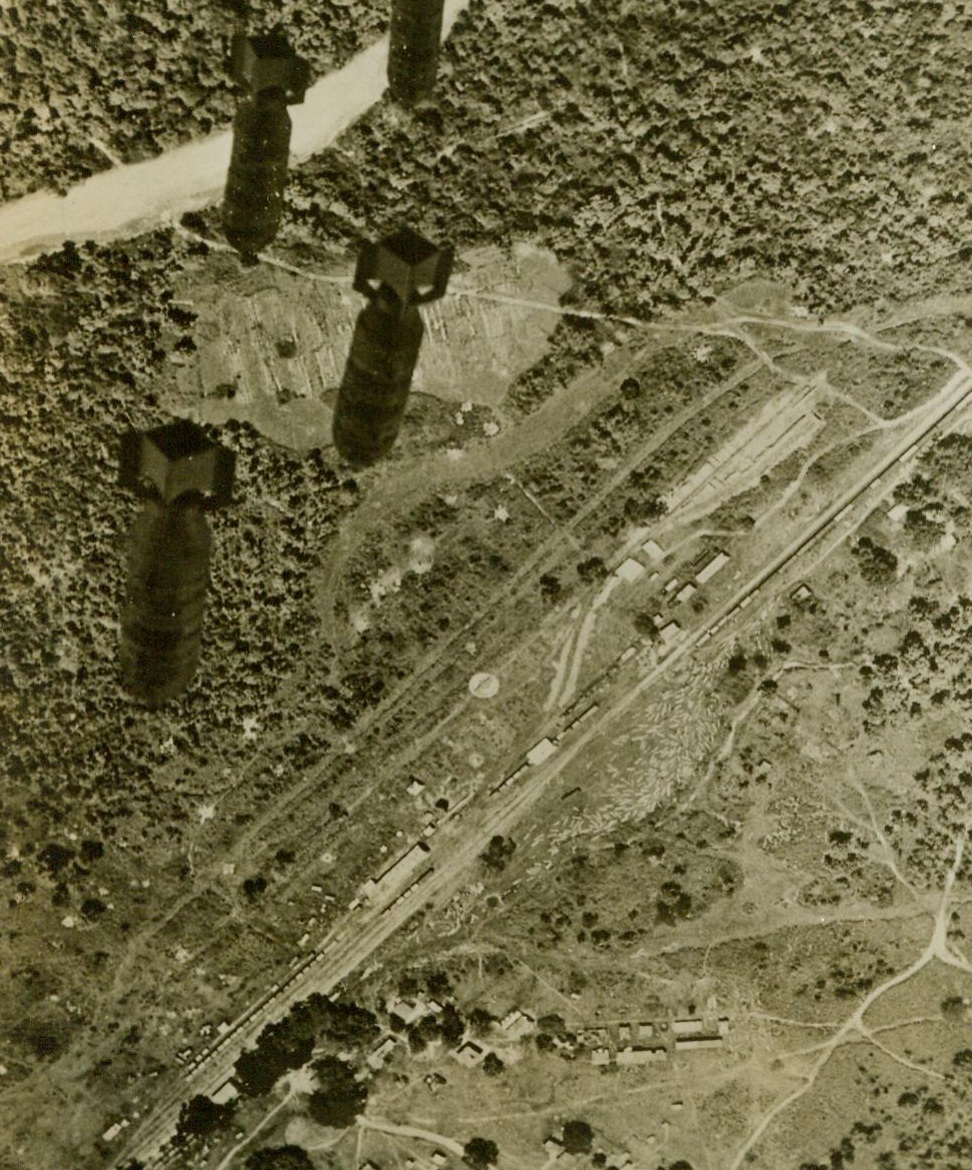
Blasting Japs' Burma Supply Line, 10/28/1943. This photo, just released in the United States, shows bombs (left), from U.S. 10th Air Force medium bombers dropping toward the important railroad junction at Naba, Burma, through which passes much of the oil from the rich Burma fields to supply Japanese invasion forces. This recent raid is part of the growing air offensive against Jap supply lines and installations in Burma 10/28/43 (U.S. Army Air Forces Photo From ACME);
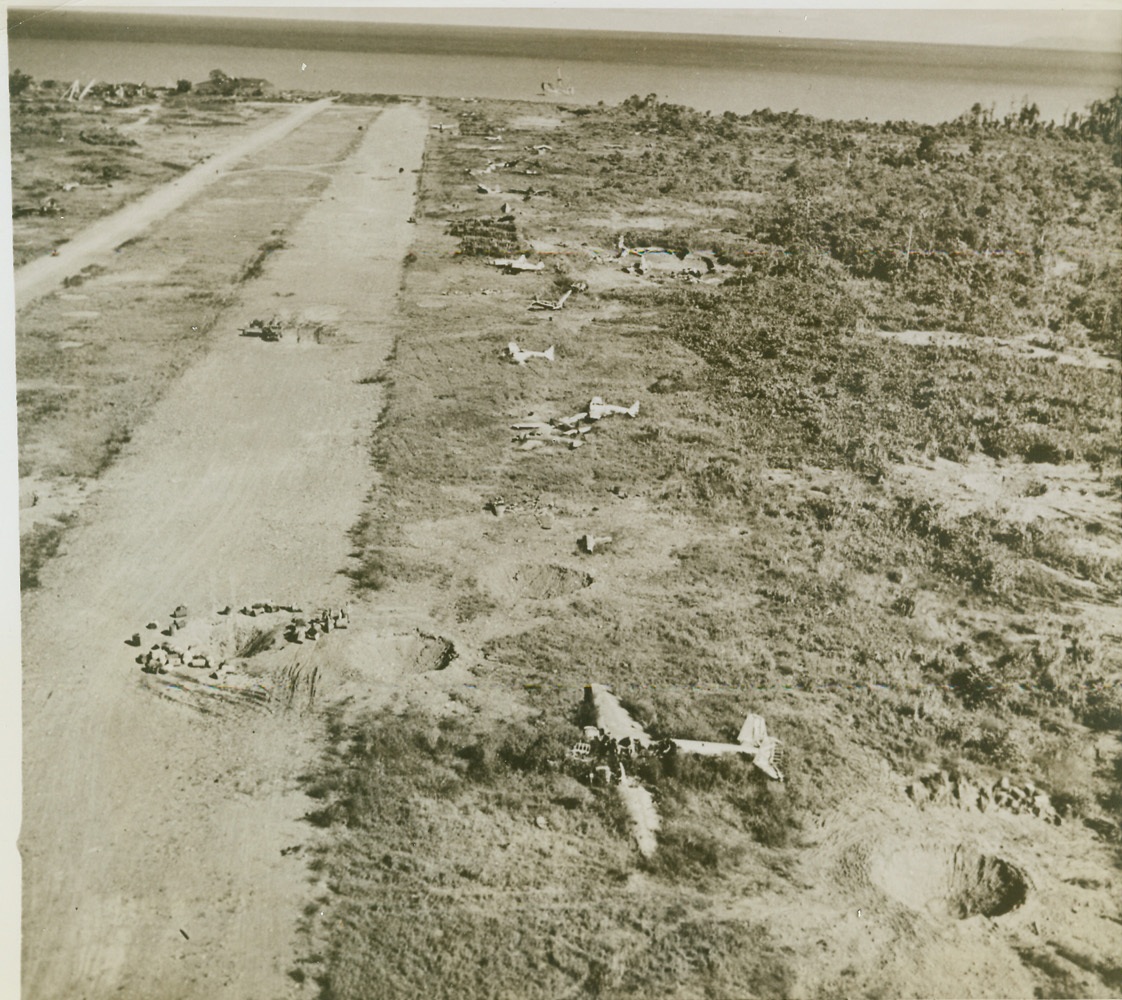
Graveyard for Jap Aircraft, 10/29/1943. NEW GUINEA - Bits of wrecked enemy planes litter the beach at Lae, New Guinea, where they were bombed by American aircraft. Huge bomb craters are visable in the area now held by American and Australian forces. The damage to Jap installations and war equipment was done by Yank planes and Aussie artillery.;
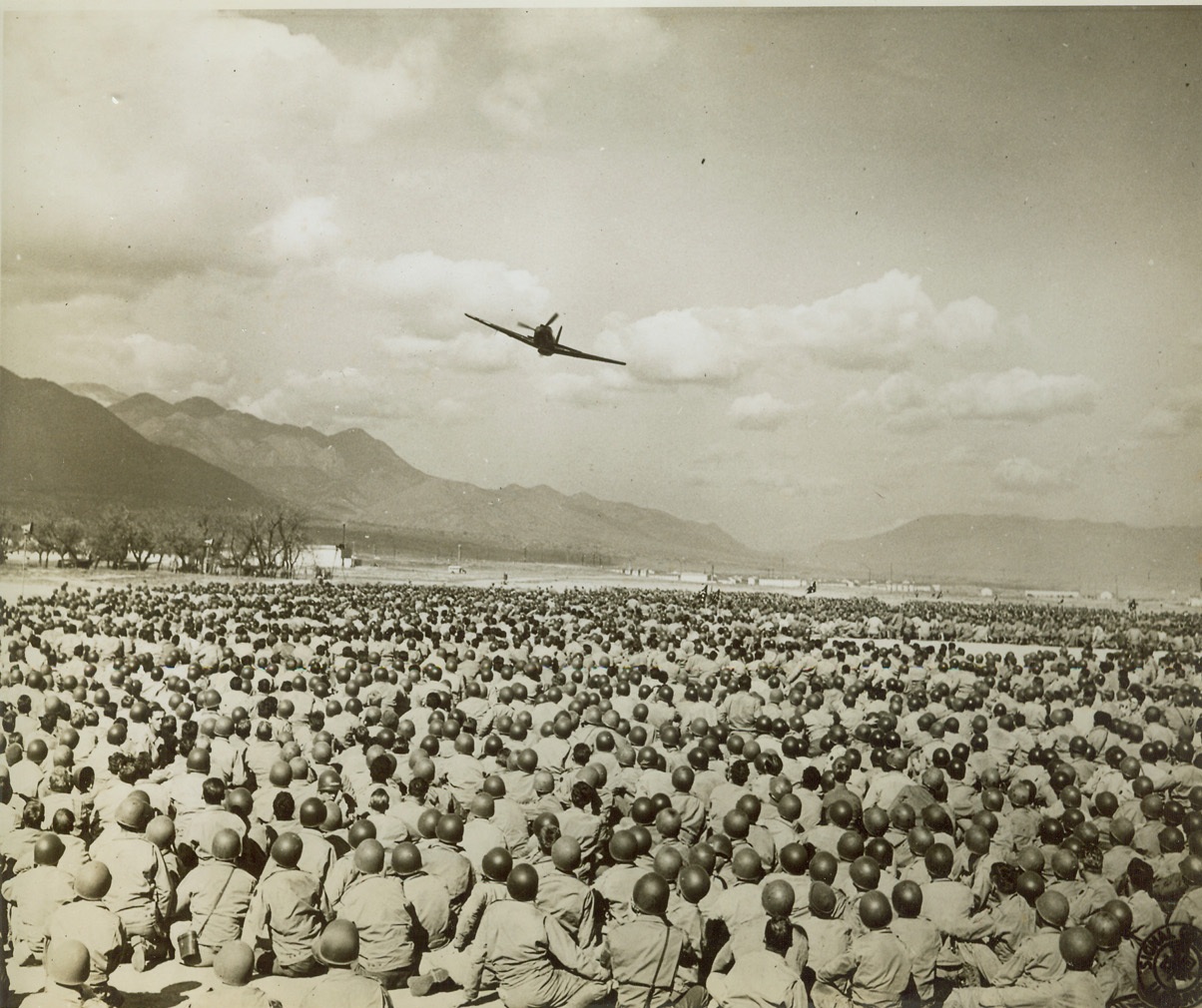
Helmets, Not Mushrooms, 10/28/1943. Camp Carson, Colorado—These thousands of soldiers at Camp Carson, Colo., let “chow time” come and go unnoticed during a 3-hour plane identification experiment staged by fighter and bomber planes of the 3rd Air Force. Lieut. Ted Timberlake, who planned the demonstration, told the soldiers, “All you have to do is recognize all friendly aircraft and shoot down anything else that flies.” Credit: Official U.S. Army Signal Corp photo;
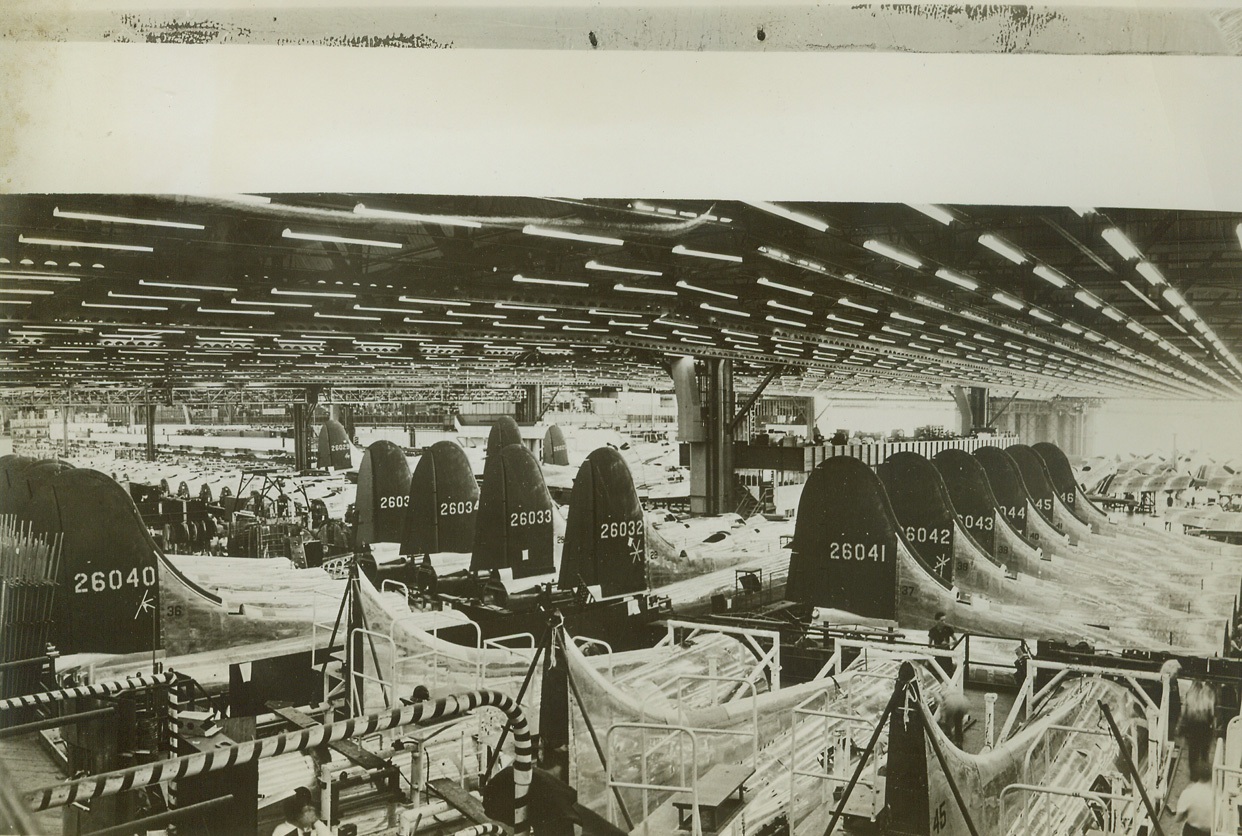
Future Air Power, 10/11/1943. Burbank, Calif.—The full impact of mass production is seen in this view at Vega Aircraft Corporation’s main plant at Burbank, where four times as many B-17 bombers are now being turned out than were built last January. Every one of these planes represents a single future headache for the Axis. Credit: ACME;
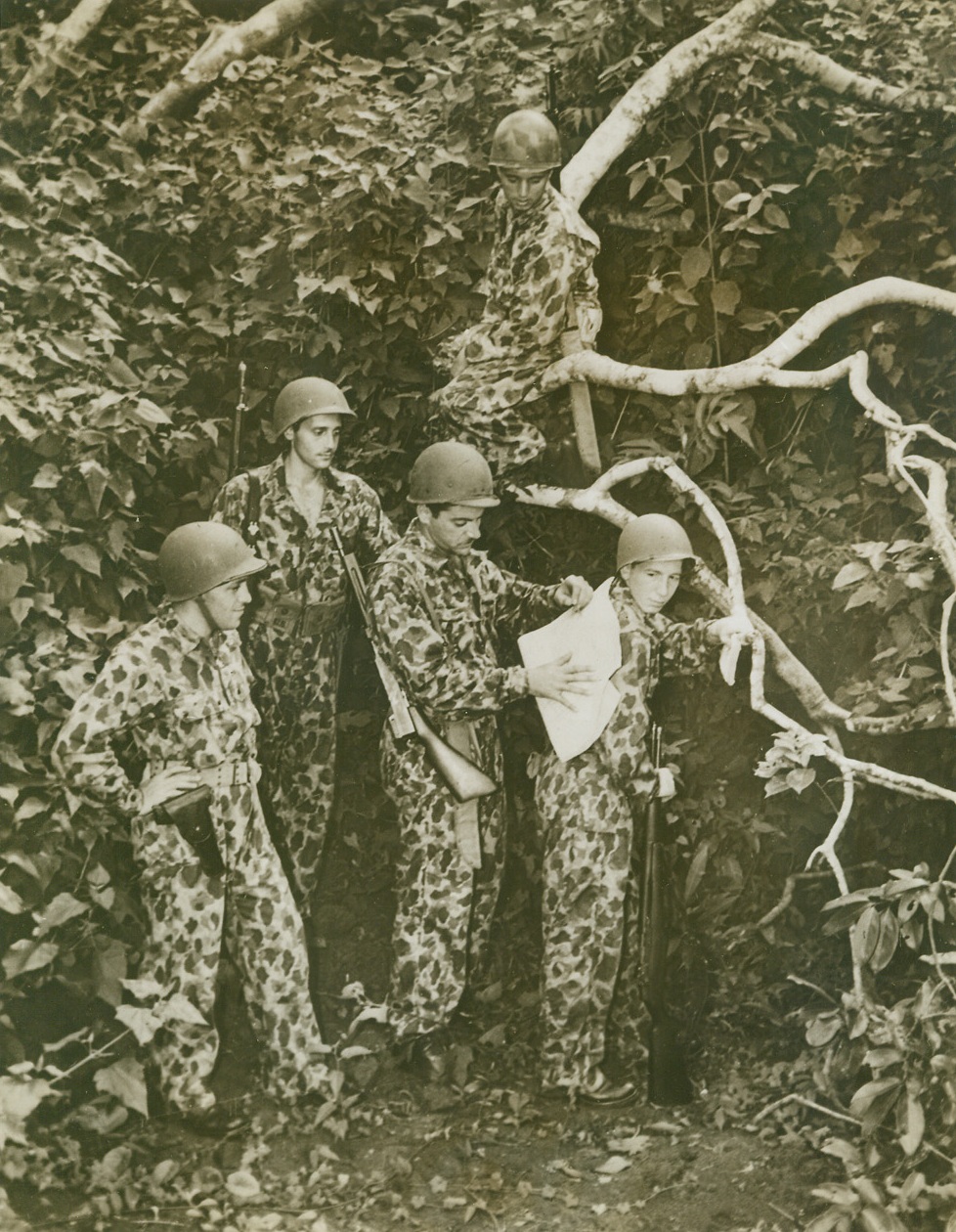
Jungle Voting, 10/24/1943. Panama Canal Zone—The spirit of democracy reaches far out into tiny, isolated spots all over the world as American fighting men take time out from their jobs to vote. Going to the polls during jungle maneuvers in the Canal Zone, these New York boys mark ballots that will be returned in time for the count when the polls close on November 2nd. Left to right: PFC Lewis Tunkel, Bronx; Cpl. Leo Kirshenbaum, Brooklyn; Pvt. Thomas Mitelli, Manhattan; Cpl. Francis J. Hurley, Brooklyn; and (in tree) Pvt. John D. Alesandro, Manhattan. Credit: ACME.;





 Trash & Recycling
Trash & Recycling
 Online Payments
Online Payments
 City Documents
City Documents
 Parks
Parks
 Traffic Court
Traffic Court
 CITY PARKS
CITY PARKS
 Outdoor Recreation
Outdoor Recreation
 Volunteer
Volunteer
 Home
Home TRANSLATE
TRANSLATE
